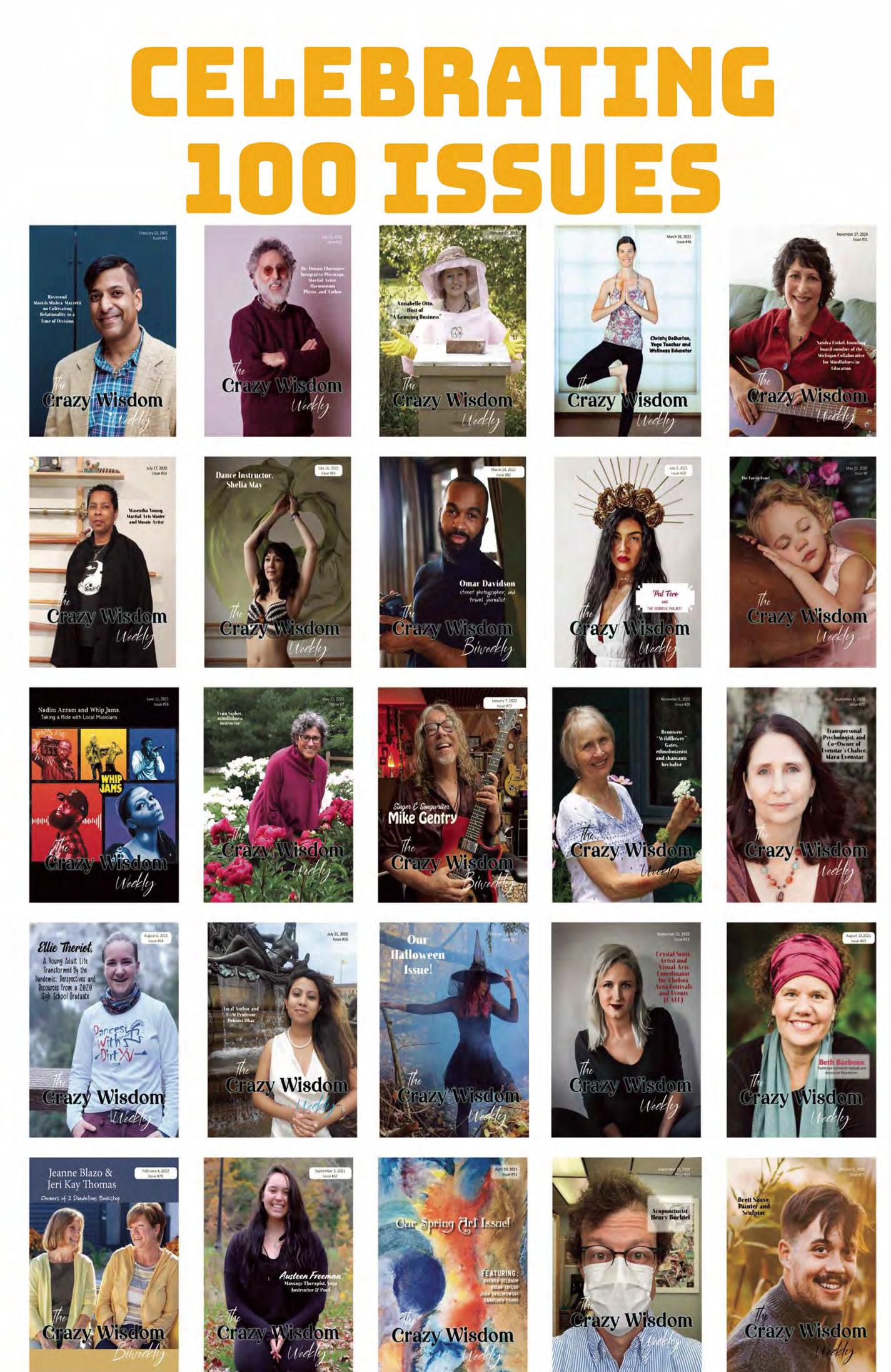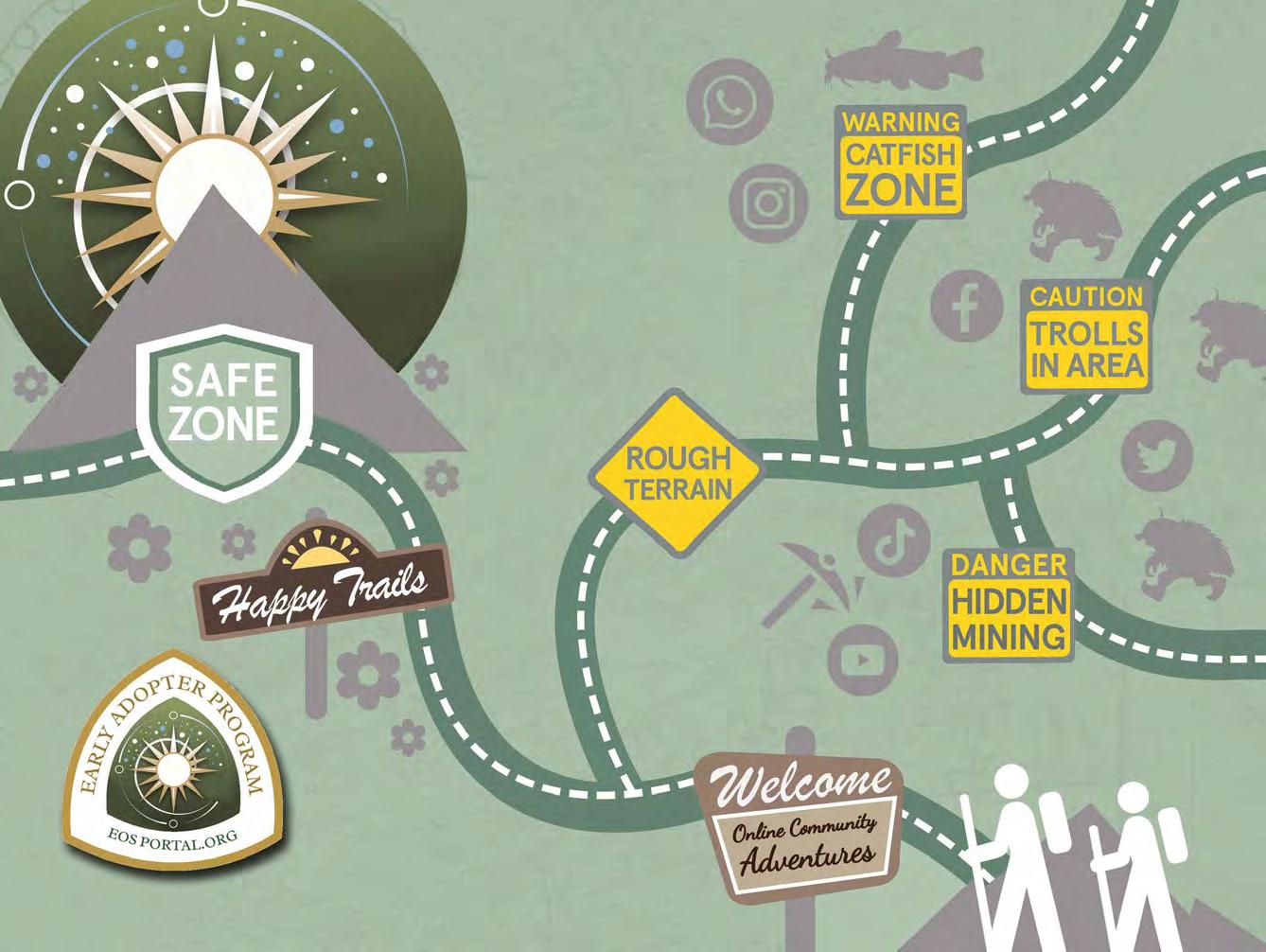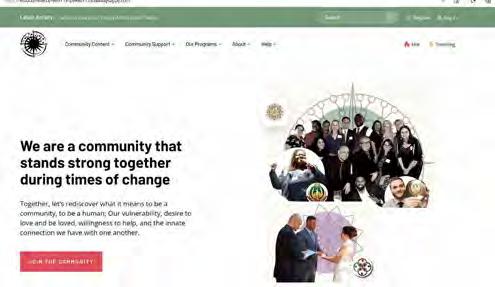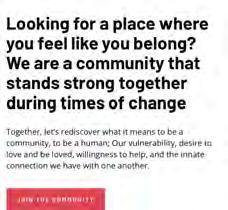























































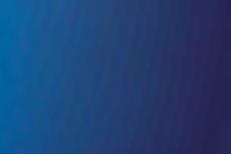


















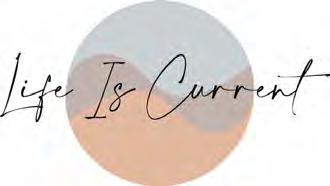



































































































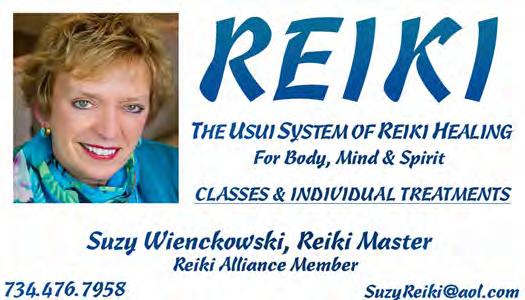




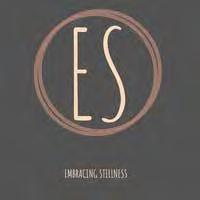


Fran Cowen Adler,
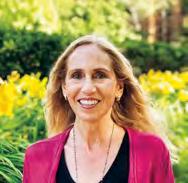

An experienced therapist’s novel approach to counseling, for teens and adults Let’s walk and talk! For information and to make an appointment: 734-429-2076 a2walktalk@gmail.com
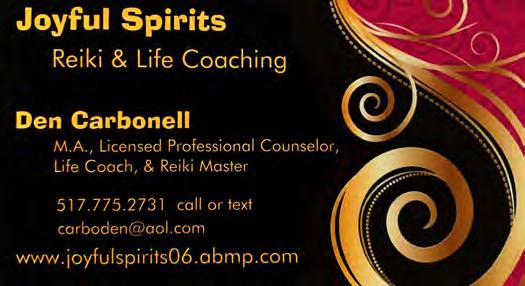






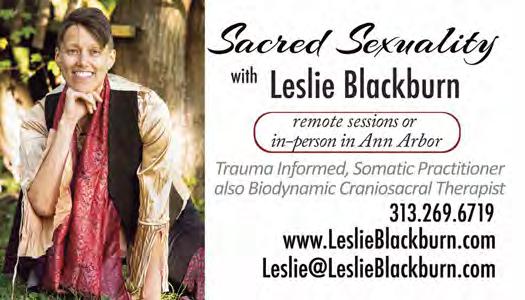


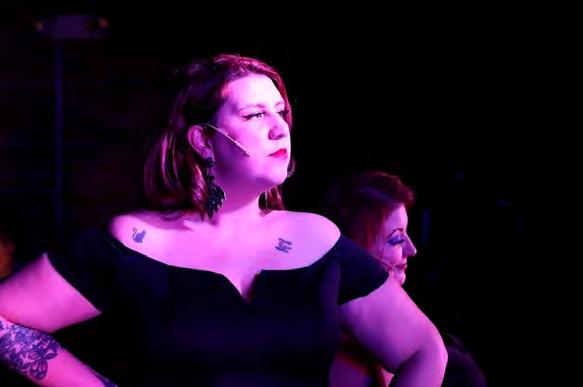




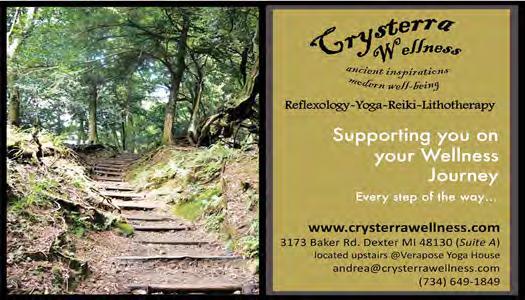
 By Lisa V. Gotte
By Lisa V. Gotte
Hygge, pronounced “hoo-gah,” is a Danish word that can most readily be described as a sort of coziness, although it’s more than that. It also comes from the word hugga, which is related to the word hug and means to comfort and console. So, it’s little surprise that it’s what keeps the Danes the happiest people on the planet even though they endure frigid winters with little daylight. Sunrise in a Copenhagen winter can be as late as 9:00 am while sunset can arrive not long after by 3:30 p.m. The average temperature in January is 32°F, hovering right around freezing for months. All that adds up to some long, dark, and cold days. Most Michiganders can relate to this kind of winter climate, but just because it’s cold and dark outside doesn’t mean you can’t enjoy yourself. Take a page from the Scandinavians and invite the warmth and conviviality of hygge into your home and life.

While hygge can come across as bourgeois it’s not as consumer driven as it can appear to be on the surface. Generous doses of both gratitude and moderation are vital to the spirit of real hygge.
Candles, nubby socks, a warm fireplace, sparkly lights, foamy lattes, and hot chocolate with friends and family, these are the things that hygge is made of. This comforting and relaxed way of life can be created in any home in any country with just a few items that most of us already have.
What you may need:
Candles and Fairy or Christmas Lights

Fuzzy Blankets and Warm Socks
Sturdy Mugs and Cups for Hot Drinks
Good Books and a Comfortable Spot in Which to Read Them

Long, dark, and dreary days can be brightened with the right lighting. Strings of sparkly lights on mantles or over doorways don’t have to be put away right after Christmas. Leave them up to brighten some of the coldest months of the year. Low watt, warm white bulbs in lamps can also add a cozy and subdued atmosphere. Candles, of course, add their warm flicker.
The word conviviality is often included in any description of hygge. It’s most certainly possible to enjoy the warmth of hygge alone with some nubby socks and a cup of hot cocoa but friends make it even better. Sharing good food and conversation in a relaxed atmosphere is a perfect expression of hygge.
Scandinavians, in general, have a standard of living which allows most citizens a level of prosperity and the leisure time to enjoy it. While hygge can come across as bourgeois it’s not as consumer driven as it can appear to be on the surface. Generous doses of both gratitude and moderation are vital to the spirit of real hygge. It’s not about buying a dozen candles or having mountains of warm socks you may never wear. It’s enjoying a few well-made things that are mindfully enjoyed, provide genuine comfort, and may last for years.
The Swedish word, lagom, describes a sense of equality and moderation and is an important part of hygge. Lagom is sharing with those around you and getting along. This quality of lagom, which is sometimes criticized as being too bland and not making waves, can also help people get along and keep tensions and conflicts at bay.
Things to do:
Visit Restaurants and Coffee Shops with Friends Arrange Group Hikes and Outdoor Activities Find Local Places that have Game Nights Get Outside
Hygge doesn’t only happen inside. Getting outside for hikes, ice skating, and skiing are also part of the philosophy of hygge. Star gazing on crisp and clear evenings is also a great way to get outside. Outdoor activities tend to promote a healthy body and happy mindset and any weather can be enjoyed when wearing suitable clothing. The contrast when coming in from the cold to a warm and inviting meal with friends can make each extreme even more enjoyable. It’s not just the warmth and comfort that is hygge, but the juxtaposition between that and the harsh and dreary climate.
Warm Clothes for the Outdoors Boots, Scarves, and Gloves A Place to Walk, Hike, Ski, or Star Gaze
When you come in from that winter hike, take off your hats and gloves and settle in to make a batch of hot cocoa to share with companions.
This recipe takes only minutes to make and is as easy as purchased hot cocoa mix. It’s creamy, chocolatey, and delicious. Just whisk together all the ingredients in a heavy bottomed pan and heat to just below boiling. The cocoa powder will mix in easily as the milk heats up. Once heated through, stir well, share with a couple of friends, and enjoy!
Did you know? Hot chocolate and hot cocoa are not the same?
• 3 cups plant-based milk (almond, soy, cashew, or rice)
• 1/3 cup cocoa powder
• 1/3 cup brown sugar (or white)
• 1 tablespoon vanilla
• Pinch of salt
• Optional small sprinkle of cayenne pepper

Hot chocolate is made with melted chocolate thinned with milk. Hot cocoa is made with cocoa powder and other flavorings added in.

Page 5
Page 24
Page 72
Hygge — Create a Cozy Winter by Lisa V. Gotte ....................................................................................... Page 5

Fifty Years Since We Last Went to the Moon by Sandor Slomovits Page 12
Beautiful Ways by Laurel Decker Page 14
The Crazy Wisdom Interview with Dr. Amy Saunders on Integrative Medicine and Her Life’s Journey Interview by Bill Zirinsky Page 24
The Healer Within — The Crazy Wisdom Interview with Advanced Energy Medicine Practitioner, Barb Scholz Interview by Grace Pernecky Page 34
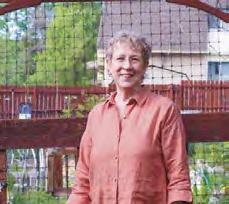
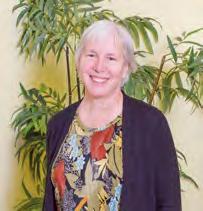
Wreck It to Repair It — How Rage Rooms Are Helping People De-Stress by Cashmere Morley Page 42
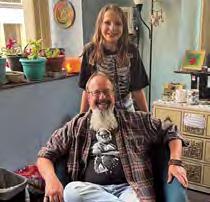
Pickleball Is Life — Fun, Friends, and Finesse at Wolverine Pickleball by Joshua Kay Page 44
A Sprinkle of Laughter, A Smattering of Grace –Applying Laughter in Challenging Situations by Angela Verges Page 50
From Nature To You — Remedies for PMS and PMDD by Ash Merryman
Page 51
Argus Farm Stop — Mission Driven by Hilary Nichols Page 52
Student Mosaics at the Steiner School — A Culmination of an Inspired Education by Sandor Slomovits Page 72
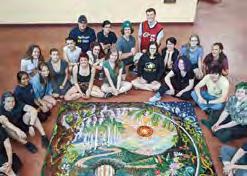
Kindred Conversations ~ by Hilary Nichols Social Worker Will Sherry Page 10 Artist Juliet Seignious Page 11
What’s New in the Community ~ by Lynda Gronlund
Page 16
Our Yoga Column ~ by Katie Hoener Page 23
Out of My Comfort Zone ~ Dare to Be by Lauren Crane Page 38 Discomfort Zone by Kath Weider Roos Page 40
Healers of Ann Arbor ~ Staunch Stress, Seal Serenity by Marie Noelle Duquette Page 46
Green Living ~ Now is a Great Time to Plan Your Rain Garden by Serena Dobson Page 48
Random Acts of Kindness ~ The Things Women Still Can’t Talk About and Why We Sometimes Have to Invite Ourselves In by Madeline Strong Diehl Page 49
Leaps of Faith ~ Carosello Pasta Page 58 by Laurel Decker
Weekend Getaways ~ Holland Highlights by Petula Brown

60
Sustainable Health ~ The Seven Steps Blueprint for Optimal Health by Dr. Darren Schmidt, D.C Page 69
Handcrafting ~ Puckly Penguin — A Midwinter Playmate by Jennifer Carson Page 70

Astrologically Speaking ~ Welcome Generation Aquarius! by Catherine Carlson

The Crazy Wisdom Community Journal has been published three times a year since 1995. Copyright © Crazy Wisdom, Inc. — December 2022
No parts of this publication may be reproduced for any reason without the express written approval of the publisher. There is a token fee charged if you would like to use an article in this publication on your website, so make sure to contact us first. Articles from back issues are available on our website’s archive.
Crazy Wisdom was founded in 1982. Since 1989, it has been owned by Crazy Wisdom, Inc., which consists of Bill Zirinsky and Ruth Schekter.

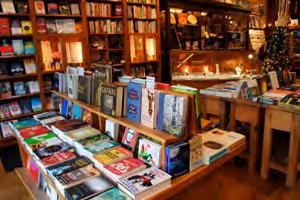


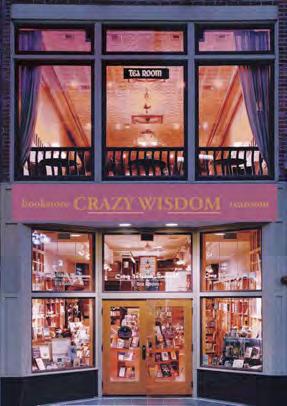
Senior Design/Production Editor Carol Karr Design/Production Editor Jennifer Carson
Managing Editor/Staff Coordinator Jennifer Carson
Editing
Jennifer Carson, Victoria Huffman, Michelle McLemore, Lexi Mohney Calendar Editor Jennifer Carson
Writers
Peggy Alaniz, Petula Brown, Catherine Carlson, Crysta Coburn, Madeline Strong Diehl, Marie Noelle Duquette, Lisa V. Gotte, Lynda Gronlund, Katie Hoener, Laurel Decker, Joshua Kay, Christine MacIntyre, Angela Madaras, Michelle McLemore, Ash Merryman, Carin Michaels, Cashmere Morley, Kirsten Mowrey, Hilary Nichols, Grace Pernecky, Sandor Slomovits
Artwork Jennifer Carson, Lindsay Dahl, Logynn Hailley, Mary Murphy Photography
for Free Calendar submissions for the May thru August 2023 issue is Wednesday, March 15, 2023 Contact calendarforms@ crazywisdom.net The deadline for reservations for Paid Advertising is Monday, March 29th, 2023 Contact tana@crazywisdom.net








We sincerely appreciate all the talent that gets put to work to bring you the best Crazy Wisdom Community Journal three times a year, and wanted to highlight different contributors from each issue in this space. Look for us to highlight some of our contributors in every issue.
Sandor Slomovits is one of the twin brothers who comprise Gemini, the nationally acclaimed children’s music duo. Since 1973, Sandor, with his brother Laszlo, has toured the US and Canada and they have released over a dozen award-winning recordings and a concert video. Sandor also plays music with his daughter, Emily and is a freelance writer for a number of local and national papers and magazines. Learn more at sandorslomovits.com.
Angela Madaras is passionate about all things food and has been growing and cooking for herself and others for around 40 years. As a freelance writer, both locally and nationally, her topics range from culinary arts to medicine to philosophy with a focus on health and wellness for humans and the planet. She enjoys a quiet life with her husband and partner in Ann Arbor where they share a large garden and art-design studio.
Grace Pernecky is a freelance writer, photographer, poet, and perpetual student of life. She’s very interested in the intersections between health, food, and spirituality, and loves the process and power of storytelling. She’s lived in Ann Arbor her whole life and finds every excuse to experience the incredible natural areas that Michigan has to offer. When she is not writing, you can find her reading, listening to music, walking through the woods, or petting her cat, Phynn.
Carol Karr was a Senior Manager at Crazy Wisdom Bookstore, where she had worked since 1996, when the store was still on Fourth Avenue. She is self-taught in



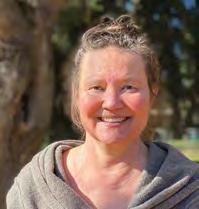
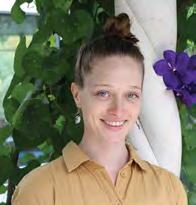

and magazine design and has been the Design and Production Editor of The Crazy Wisdom Community Journal for the past thirteen years. She has played a key role in enhancing the look of the publication, and in its overall evolution. Carol also runs shopcrazywisdom.com and is Crazy Wisdom’s webmistress.

The University of Michigan is lucky to have Will Sherry in the LGBTQ+ conversation. Without a doubt Sherry has both influenced and been influenced by this decade’s LGBTQ cultural shifts. Now, as the new Director of Strategic Initiatives for Student Life, and while directing the Spectrum Center for 14 years, Sherry has been at the table. The center has been a foundational part of U-M’s campus culture, with a strong hand in earning a five out of five-star reception on the Campus Pride Index.
It was in 2007 as a graduate student in the School of Social Work that Sherry first volunteered there. “The rainbow network in the School of Social Work introduced me to the Spectrum Center and other places to gather with kindred people.” In 1971, when Jim Toy pioneered the Center, the achievement was monumental, as the first office for queer students in an institution of higher learning in the United States. Both Sherry and the center have changed a lot since this early introduction. “The Spectrum Center has really grown. I was the fourth of a four person staff when I was hired. Two directors and two program directors, along with a few students. It was rough in terms of budget. Our programing and operations budget was $5,000 to $10,000 a year, for all speakers and programs. Now there are six full time staff with program specialists and 10-15 student staff each year.”
While Sherry carefully crafted programs to offer the most nuanced and strategic support, he was taking his own journey of self-reflection.
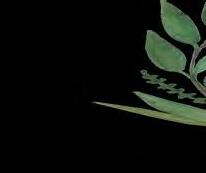



The Center now has education, advocacy, and community building programs all over campus and all around the calendar to enhance the campus climate for LGBTQ+ students, staff, and faculty. In his new position Sherry has advanced that effort to develop programs that provide diversity, equity, and inclusion for all the underrepresented populations on campus. While Sherry carefully crafted programs to offer the most nuanced and strategic support, he was taking his own journey of self-reflection. Will Sherry uses “he, him, and his” pronouns, but that wasn’t always the case. “I identify my sexuality as queer. That’s a word that I feel like really represents the way I see gender. I identify as a man, and I also identify as transgender.” As part of the Bentley Historical Library Oral History project Sherry continued, “I identify as a parent, and as a partner, as a social worker. I identify as white, and lots of other things.”
Will Sherry is clear and careful with his language, and that is something that I really took note of. When I ask him about how he feels personally about pronouns and how the culture has advanced this conversation, he counters with “Offering our care isn’t really a vocabulary contest.” The language has changed and will continue to live and evolve with the population, but the important piece, it seems, is to be present for the care, rather than concerned about a slip up.
Will Sherry is the director of Strategic Initiatives for Student Life at the University of Michigan and the former Director of the Spectrum Center.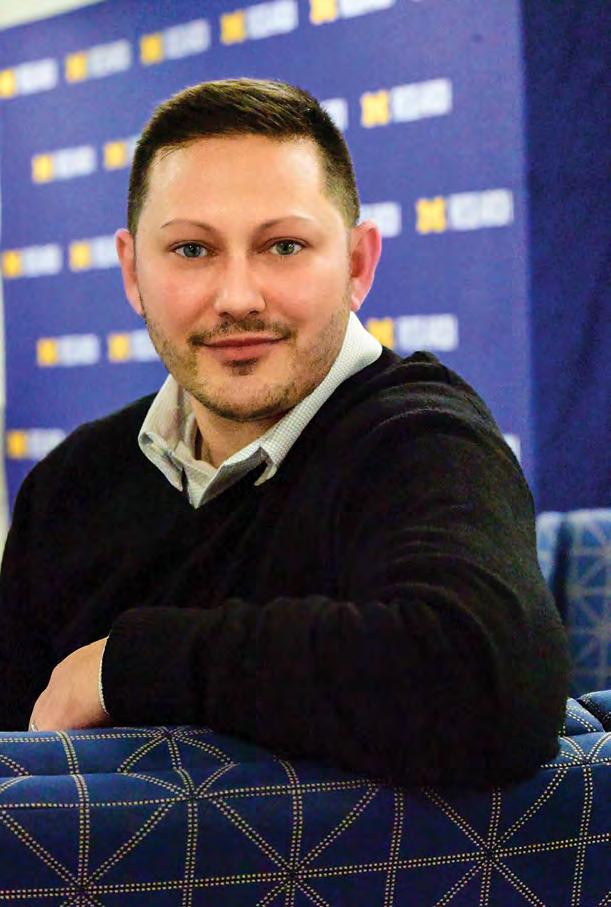
“Lots of people didn’t know much, about queer identity, but they weren’t queer.” When Sherry first arrived in Michigan for grad school, he wasn’t tapped into the community. In his upbringing, and undergraduate experience, he did not encounter a support system to celebrate his identity. In fact, when his housing search kept referring to LGBT, “I had never seen the term, like I didn’t know what it meant and didn’t know what it stood for.”
Graduate school offered Sherry a great shift in his awareness. It is on campus that many LGBTQ people are afforded the kind of life affirming and identity defining experiences that can be crucial for their long-term health and happiness.
Maybe that is why he is so great at crafting the programs that safeguards the wellbeing of students—because he is listening. He knows how formative this environment can be. “It was a real gift to come into the space. I really valued what people offered,” Sherry realized. It was those offerings that informed his options when a friend mused, “Not everyone is comfortable in their gender.”
As a social worker, devoted to doing justice work, Sherry had to realize that some of that work could be personal. It was while working at the Spectrum Center that Sherry transitioned. In 2011, he married his wife, and they now raise their four children in Dexter, MI. He might not have always predicted this happy family story, but he always knew he would be a social worker. “I always knew that the job for me would have to be meaningful and impactful. I knew that if it didn’t align, it wouldn’t be of interest for me.”
Sherry spends his time in his new office at the renovated Ruthven center advocating for many clubs and activities. He offers campus wide DEI trainings, and campaigns for updated zoning that allows for more unisex bathrooms. All to keep pace with and progress the conversation, and ultimately to help all students on campus to find their fit, from Monday morning to Saturday night and all the rest of their days. Just as he has.
Will Sherry is clear and careful with his language, and that is something that I really took note of. When I ask him about how he feels personally about pronouns and how the culture has advanced this conversation, he counters with “Offering our care isn’t really a vocabulary contest.”
Juliet Seignious


local artist, painter, and dancer.
With a shared sigh, the two of us silently reach out to hold hands across the dinner table. We sit like this for a long moment, eyes closed with our hands clasped over the salad bowl and bread board, lost in the gentle impact of such a heartfelt expression. Conversations with Juliet Seignious often invoke that exalted experience that I can only describe as a soul connection.
Seignious is a fine art painter, sculptor, collage artist, and a dancer. She has been serious about her art ever since she was a young child in Harlem, keeping busy with her paintings on rainy days. But it was her dancing that she devoted much of her professional life, since attending the High School for Performing Arts, well known for its depiction in the movie Fame. In 1961, while she was still apprenticing at the American School of Ballet, as the first African American to be offered the coveted spot, she joined Alvin Ailey’s Dance theater of Harlem as a founding member. In 1978 she opened a dance studio in the Hudson Valley, in upstate New York, and it was there that her painting career took on more prominence, crafting a body of work that she sold at art fairs throughout the United States. In 2016 she moved to Ann Arbor to join her son, a professor of Political Science at the University of Michigan.
Into her attached basement apartment in the Barton Hills area, she transported her paints, canvases, and rolls and rolls of her works, on her signature heavy duty tar paper. The surface is durable and rich in metaphor, for a poignant piece aptly titled Family Tree. The three feet by six feet pieces stretch along the wall, layered with bright paints, layers of cheesecloth, shells, and stories. When the splashes of red, blue, purple, violet, and orange paint dry, she transfers an appliqued image of the March on Selma, and then in opaque white, layered over the imagery, she letters the word “overcome.” Her piece on Olympian Jesse Owens was exhibited at the Charles Wright African American Museum just weeks after her arrival in Michigan. Seignious is not afraid to make a statement.
It was in 1973 that Seignious read a book that she credits as the catalyst to her spiritual journey. The book The Infinite Way by Joel Goldsmith opened her up to a perspective that has remained central to her being. “The road to having no judgment is a long and difficult one. It means sacrificing things, giving up a sense of separation, opening your heart again to feel that oneness. It is a practice, pretty much every day.”
And it is a practice that Seignious applies every day. “The empty surface provokes me, and then I hear the voice, ‘Just put some darn paint on the canvas!’ From there I let the colors and brushes take over, without judgment.”

At the beginning of the pandemic, she committed to making a piece a day. This series of smaller paintings, titled Abstract Journey is reaching over 283 images collected. It was by accident that became unified when her abstractions were interpreted by a friend who commented, “The darker shapes look like coffins.” With surprise, Juliet agreed, and the theme took on deeper resonance, as it correlated with the history that was heavy on her heart. “Within the abstract work, the meaning was made clear. The coffins represent the slaves buried beneath Wall Street in New York City, and the simple figures on the horizon are the spirits that carry us forward.” Art and activism are aligned for Seignious. The act is one in the same, but it is the spirit that inspires.
In 1961, while she was still apprenticing at the American School of Ballet, as the first African American to be offered the coveted spot, she joined Alvin Ailey’s Dance theater of Harlem as a founding member.

She continues to exhibit her works to inspire others to create, to keep close to spirit. “This comes under the heading of love, self-love, opening up, for that love to come through.” Whether viewing her showings at WSG in Ann Arbor, at the Charles Wright Museum, Riverside Art Center, or in her home studio, it is undeniable, you can feel her passion palpably. When I ask her my signature question, how is she living her convictions, she muses, “It is the same with my dancing. I seek to be in the zone, and the audience feels that. That is what matters most.” And it becomes clear that there is not much of a distinction for her between her styles of art making. For Juliet Seignious, painting is a kind of dance.
Currently Seignious is collaborating with her grandson as her co-author on a children’s book titled, Tut, The Giant. You can learn more about Juliet Seignious and her artwork on her instagram account @julietseignious.
“The road to having no judgment is a long and difficult one. It means sacrificing things, giving up a sense of separation, opening your heart again to feel that oneness. It is a practice, pretty much every day.”


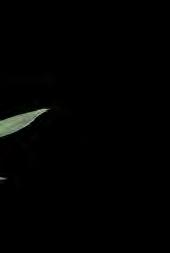
is a
Conversations with Juliet Seignious often invoke that exalted experience that I can only describe as a soul connection.
Fifty years ago, December 1972, was the last time men walked on the moon. (Yes, it’s only been men. I’ll get back to that later.) Eugene Cernan, Commander of that Apollo 17 mission said then as he prepared to step off the moon for the last time, “… as I take man’s last step from the surface, back home for some time to come—but we believe not too long into the future …”
In fact, it has been fifty years, quite a long time by human standards. It wasn’t until November of 2022 that NASA launched Artemis 1, an un-crewed flight to orbit the moon. Artemis, in Greek mythology, is the twin sister of Apollo, which was the name of the first NASA program that sent Americans to the moon. NASA’s plan is to follow Artemis 1 with a crewed mission in 2024 to also orbit the moon, and by the following year to again begin landing astronauts on the lunar surface.

Our nation’s reasons for returning to the moon now are very similar to the ones that animated our decision to go there when President Kennedy said, “We choose to go to the moon,” over sixty years ago. The primary impetus for those first Apollo flights was to get to the moon before the Soviet Union did. Now it seems that the US once again wants to demonstrate that our country is the world leader in space, this time competing against joint Chinese/Russian space ambitions.
In fact, it has been fifty years, quite a long time by human standards. It wasn’t until November of 2022 that NASA launched Artemis 1, an un-crewed flight to orbit the moon.
But it’s not accurate to cynically attribute everything about the space program to geopolitical rivalry. (I’m choosing here to focus only on the moon missions. Of course, NASA and the space programs of a number of other countries have launched many other spacecrafts into, and even beyond our solar system, including landing probes on Venus and Mars.) There were, undeniably, many other reasons why we entered the space race, why we stopped focusing on lunar missions after 1972, and why we are once again planning on returning to the moon. It’s beyond the scope of this essay—or perhaps more truthfully, of this essayist—to list and fully explore all those reasons. Instead, I’ve been looking back along history’s space-time continuum and thinking about the echoes and resonances—encouraging ones as well as disheartening ones—between where our country was in 1972 and where we are today.
Barely more than a month after the crew of Apollo 17 returned from the moon in 1972, the Vietnam war effectively ended in January of 1973, though the last American troops did not come home for a couple more months, and the fall of Saigon, in April of 1975, was still two years in the future.
The Afghanistan war, America’s longest, (Vietnam was our second longest) ended in August of 2021 a little more than a year before the first scheduled Artemis launch. Both the Vietnam and Afghanistan wars ended with massive and dramatic evacuations of troops and civilians, from Saigon in 1975, and from Kabul in 2021.
And although the US is not now fighting in Ukraine, we are very involved in the conflict, which still has the potential of flaring into a much wider conflagration.
And the war is having a deleterious effect on our economy, and those of many other countries, as well as on food and energy supplies around the globe.
Fifty years ago:
Watergate began in June 1972 with the discovery of the break-in at the Democratic National Committee headquarters and ended when Nixon resigned in August of 1974—though one could convincingly argue that the scandal’s damaging ripples and shock waves have not subsided even yet.
Today:
Well… suffice it to say that many events in the last six years have made Nixon and his gang of crooks appear as virtuous as the holiest of saints and made the Watergate break-in look like a grade school April Fool prank.
The long overdue Civil Rights Act was barely eight years old in 1972, Martin Luther King had been murdered four years earlier, the Supreme Court had recently affirmed busing as a means of achieving integration in public schools, and the shameful Tuskegee Study was finally stopped, forty years after it began.
Today:
George Floyd’s murder in May of 2020, along with many other injustices, has prompted a renewed attention to racial disparities and social justice issues perhaps not seen since the Sixties.
The Equal Rights Amendment to the Constitution was passed by Congress in March of 1972 but was not ratified by a sufficient number of states to be included in the Constitution. On the other hand, Title IX was signed into law in June of 1972, and in January of 1973 the Supreme Court’s Roe v. Wade ruling recognized the right to abortion.
In June of 2022 the Supreme Court overturned Roe v. Wade, but the results of the November 2022 midterm elections clearly signaled that the majority of the country supports women’s reproductive rights. And NASA recently publicly committed to include a woman and a person of color in the first Artemis crew that will land on the moon. At present, half of the 18 astronauts training in the Artemis program are women and, while people of color are still underrepresented among astronauts, they are there.
Which brings us back to the future, the prediction of which, unfortunately, is also beyond the scope of this essayist. But here are a few thoughts on, and hopes for, the future of humanity’s space programs.
One of the main objections many people, politicians and the public alike, have had about the US space program is its expense. Landing the first Apollo mission on the moon is estimated to have cost about 20 billion dollars. I agree that


I’ve been looking back along history’s space-time continuum and thinking about the echoes and resonances—encouraging ones as well as disheartening ones—between where our country was in 1972 and where we are today.
there were and are many other needs here on earth that were and are not being addressed with adequate funding. However, compared to the unfathomable waste of resources, not to mention the horrific loss of American and other lives in the Vietnam, Iraq, and Afghanistan wars, or the cost of our political campaigns, about 17 billion dollars in just the recent 2022 election, even taking into account the comparative worth of 1972 and 2022 dollars, I know we can find funding for NASA, and many other things, by limiting some of those expenses.

Even though it’s been fifty years since we last went to the moon, Americans and all of humanity, face many of the same concerns—war, political upheaval, racism, and misogyny—that bedeviled us in 1972, but we’ve also added a couple—climate change and worldwide extinctions—that dwarf them all. It’s worth noting that it was partly the remarkable technological advances, especially orbiting satellites, that were developed by the space programs of the US, Russia, and a number of other nations, that enabled scientists to gather the data to comprehend the threat of climate change. It was James Hansen, longtime director of NASA’s Goddard Institute for Space Studies, who testified before the US Senate in 1988, and delivered perhaps the first warning of the dangers of climate change.
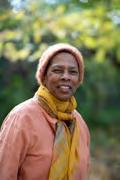

I am willing to go way out on Earth’s gravitational limb to suggest that this hypothetical cosmic rapture plan seems profoundly Icarian, utterly untethered from reality, and unfathomably dystopian to boot.
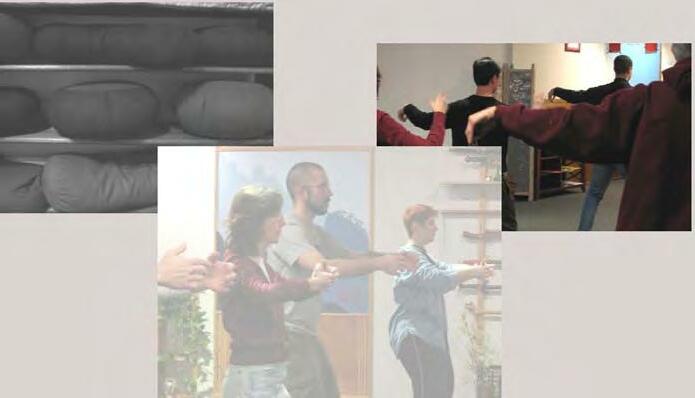
For a number of years now, some people have suggested that we should be going to the moon, Mars, and beyond, to colonize “spares” if or when our Earth becomes uninhabitable due to climate change or some other disaster, man-made or otherwise. I am willing to go way out on Earth’s gravitational limb to suggest that this hypothetical cosmic rapture plan seems profoundly Icarian, utterly untethered from reality, and unfathomably dystopian to boot. Creating small sustainable outposts on the moon and Mars will certainly become possible, perhaps even in the lifetime of some people already born. However, the idea of moving humanity (eight billion as of November 15, 2022) off the planet… I don’t think so. (If you thought the evacuations of Saigon and Kabul were desperate and chaotic! If we all don’t get to go—with our pets…)


Instead, I think that the best possible outcome of our space explorations might be the development of universal awe and gratitude for our home here on earth, and united and unanimous efforts to heal the planet’s ills. I also think that we need to fiercely strive not to repeat in space the innumerable and immense mistakes of our past earthbound colonizations.
In the 1950s and 60s the US and the Soviet Union each flew solo in their space programs, but even by 1967, with the signing of the Outer Space Treaty by the US, Soviet Union, and Great Britain, there was consensus that space was to be explored only for peaceful purposes, even if we hadn’t managed that on Earth. Since then, the vast majority of countries on Earth have signed that agreement, and in the past half century there have been many, many examples of cooperative ventures in space, including by countries like the US and Russia, that have had difficulty cooperating on much else. The Artemis program, for example, while headed by the US, is a partnership with the Canadian Space Agency, the European Space Agency, the Japan Aerospace Exploration Agency, and nearly two dozen other countries.



As Eugene Cernan, the last man on the moon in 1972 said when he stepped off the lunar surface for the last time, “We leave as we came and, God willing, as we shall return, with peace and hope for all mankind.”
We can hope that this tradition continues and grows. We should hope that the current heightened tensions between the US and Russia over Ukraine, and between the US and China over Taiwan, will not for long curtail cooperation in space, even if only in that one area. We can also hope that human beings will continue to “slip the surly bonds of earth” in space and, perhaps find a way to remove more surly bonds on humanity here on earth.

As Eugene Cernan, the last man on the moon in 1972 said when he stepped off the lunar surface for the last time, “We leave as we came and, God willing, as we shall return, with peace and hope for all mankind.”




I was raised in rural Colorado and on the Navajo Nation reservation in Arizona, in what is known as The Four Corners region. On a map, this area appears as a cross where four right angles meet to join Colorado, Arizona, Utah, and New Mexico. This is the original home of several Native American groups, including the Navajo people, also known by their preferred name of Dine’ (dih-neh), meaning “The People.” I feel fortunate to have been immersed in such a unique culture, and I often reflect on the experiences that taught me some valuable life lessons.
One memory that sticks with me is when I attended a church service in the small reservation town of Teec Nos Pos (pronounced “teese nahs pahs”). You can find it on the map at the northeastern corner of Arizona. After the service, I went to the restroom and encountered an elderly Navajo woman, dressed in the traditional long skirt and colorful long sleeved button-down shirt. Her gray hair was pulled back neatly into a bun that was bound and wrapped by spun sheep’s wool. This bun is called a tsiiyeel (tsee-yel) and it is said to hold the thoughts and prayers of the person wearing it. The woman’s earlobes, fingers, wrists, and neck were decorated with turquoise and silver that is found abundantly in the region and is symbolic of good fortune as well as protection from evil.
I noticed that the woman was hunched over and walked with a cane. So, I was surprised when she slowly bent down to pick up a used paper towel that had not made it to the trash can. I thought she must have missed the basket, but then she continued picking up a few others, and clearly, they were not all hers. She picked up every loose piece of trash and then left quietly.
One morning, he stopped us at the entrance of the bus and shared that he sometimes feels really tired in the morning. Especially when he had to get up extra early to pick us up and get us to school on time. He said when he was in the military, he had to learn to be alert no matter what time of day it was. Then he explained that he had a trick that helped him when he was extra sleepy. He would splash cold water on his face. I remember thinking that I could never do that, but I do remember receiving his message loud and clear. The three of us needed to get to the bus on time.
What I appreciate most about that conversation was the kind and positive way Ed spoke to us. He didn’t make us feel like we were in trouble or that we had inconvenienced him—even though we surely had. It simply made us aware that he needed us to try harder, and to respect other people’s time and schedules.
The word is loosely translated to mean “beauty.” But the English translation falls short of encompassing the word’s full meaning
Another memorable experience from when I was going to school in Tsaile, Arizona, was when a new friend, named Sheri, invited me to have a sleepover. After school on Friday, our bus driver dropped us off at the entrance of a long dirt road. As we walked, Sheri explained that we would be sleeping at her grandmother’s house, because the medicine man said their family’s trailer home was placed on a burial ground. They had to abandon the home while arrangements were made to move it.
I feel fortunate to have been immersed in such a unique culture, and I often reflect on the experiences that taught me some valuable life lessons.

I know now that I should have helped her out instead of watching, but I think it took me a while to figure out what she was doing. In those moments, I felt the purpose of that gesture, and why it was important to her to keep the room clean. The building itself was new and quite ornate compared to most of the buildings in the area. It was fully modern, whereas many homes in the area were still without running water. I believe her appreciation for the building was one reason she quietly tidied up even though it was someone’s else’s mess. I was so impressed by her simple gesture that to this day, when I throw away a paper towel in a bathroom, I look around and pick up any stray paper towels that missed the basket.
When I was in seventh grade, my family lived in Round Rock, AZ. To get to school, my two younger sisters and I rode the school bus to and from Tsaile, AZ—about an hour each way. It was usually dark when we were picked up in the morning. Young as we were, and early as it was, we sometimes had a hard time getting to the door when we were supposed to be there waiting for the bus to arrive. A lot of mornings we didn’t make it, so fortunately we had an extra patient bus driver named Ed. He always sat waiting in his WWII Veteran hat, welcoming us onboard. One time he shared with us that he was among the few men employed as a Navajo code talker—soldiers who significantly helped American troops by transferring information covertly and effectively using their language to create codes too difficult for the enemy to crack.
Ed sometimes waited for the three of us longer than he probably should have. I think the reason he never drove off without us is that we were the first to get on the bus, and the next stop was pretty far away. He must have figured he drove all the way out to get us, he might as well wait. There was a certain point when we were taking extra-long to drag ourselves out the door, and he could see it was becoming a habit.
As we approached Sheri’s grandmother’s home, I was really surprised to see that she lived in a traditional Navajo dwelling, called a hogan. I had never been inside a hogan before, and I was excited by the thought of spending the night in one. Even though hogans are found throughout the reservation, most people live in more modern buildings. A hogan layout is simple. It is one large room with a stove in the center. Living essentials, such as beds and tables are arranged against the eight walls that make up the octagonal footprint of the home. The one and only doorway of a hogan always faces east to greet the rising sun.
Sheri’s grandmother made her living by caring for a herd of sheep, which were corralled near the dwelling. She didn’t speak English, so as she was showing me around, she communicated mostly by nodding in the direction of what she wanted me to see. Now and then she would tell Sheri to translate something from Navajo for me to understand her more clearly.
When it was time for dinner, Sheri and I sat at the table with her grandma. On the table was a pot of mutton stew and a plate stacked with hot fried bread. There were no bowls or plates, and the only personal utensils we used were cups filled with herbal tea. We used torn pieces of fried bread to scoop stew out of one large pot. When it was bedtime, everyone slept on one bed that was against the wall. It felt cozy with the wood stove in the center of the home and knowing there was an adult with us made me feel extra safe.
I think of how wonderfully simple and intimate that evening was in comparison with the lifestyle I experienced growing up in a more typical American home. Even though we often ate at the dinner table together, we had a more complicated spread of food and utensils. And, especially as the kids grew older, there was usually a scattering off to separate parts of the large house after clearing the dinner table.
As I reflect on all of these moments—an elderly woman taking the time to improve her surroundings, a bus driver teaching and correcting children
with kindness, and a friend and her grandmother humbly sharing their home and food with me—I think of the word “hozhoni” (hu-zhjo-ni). The word is loosely translated to mean “beauty.” But the English translation falls short of encompassing the word’s full meaning. To the Dine’, hozhoni implies a profound sense of harmony and balance that is more spiritual than physical. The Beauty Way prayer, which is sung in Dine’ ceremonies, invites us to surround ourselves with happiness, confidence, joy, and peace. These simple lessons taught me to do my best to walk in beauty in my actions, my surroundings, and most importantly inside myself.
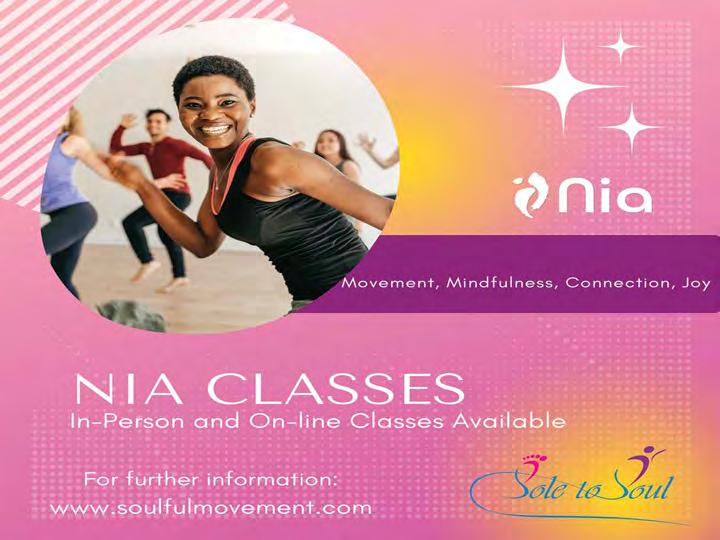
In beauty I walk
With beauty before me I walk
With beauty behind me I walk
With beauty above me I walk
With beauty around me I walk
It has become beauty again Hózhóogo naasháa doo Shitsijí’ hózhóogo naasháa doo Shikéédéé hózhóogo naasháa doo Shideigi hózhóogo naasháa doo T’áá altso shinaagóó hózhóogo naasháa doo Hózhó náhásdlíí’ Hózhó náhásdlíí’ Hózhó náhásdlíí’ Hózhó náhásdlíí’
Today I will walk out, today everything negative will leave me I will be as I was before, I will have a cool breeze over my body. I will have a light body, I will be happy forever, nothing will hinder me.
I walk with beauty before me. I walk with beauty behind me. I walk with beauty below me. I walk with beauty above me. I walk with beauty around me. My words will be beautiful.
In beauty all day long may I walk. Through the returning seasons, may I walk. On the trail marked with pollen may I walk. With dew about my feet, may I walk. With beauty before me may I walk. With beauty behind me may I walk. With beauty below me may I walk. With beauty above me may I walk. With beauty all around me may I walk.
In old age wandering on a trail of beauty, lively, may I walk. In old age wandering on a trail of beauty, living again, may I walk.
My words will be beautiful…

Listen to the closing prayer in it’s original language at https://talkingfeather.com/home/walk-in-beautyprayer-from-navajo-blessing/


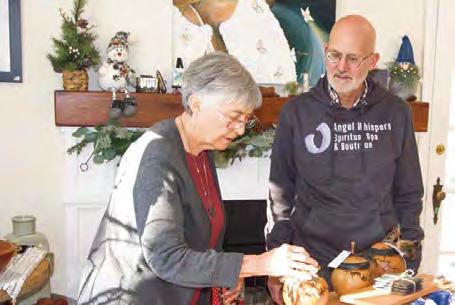


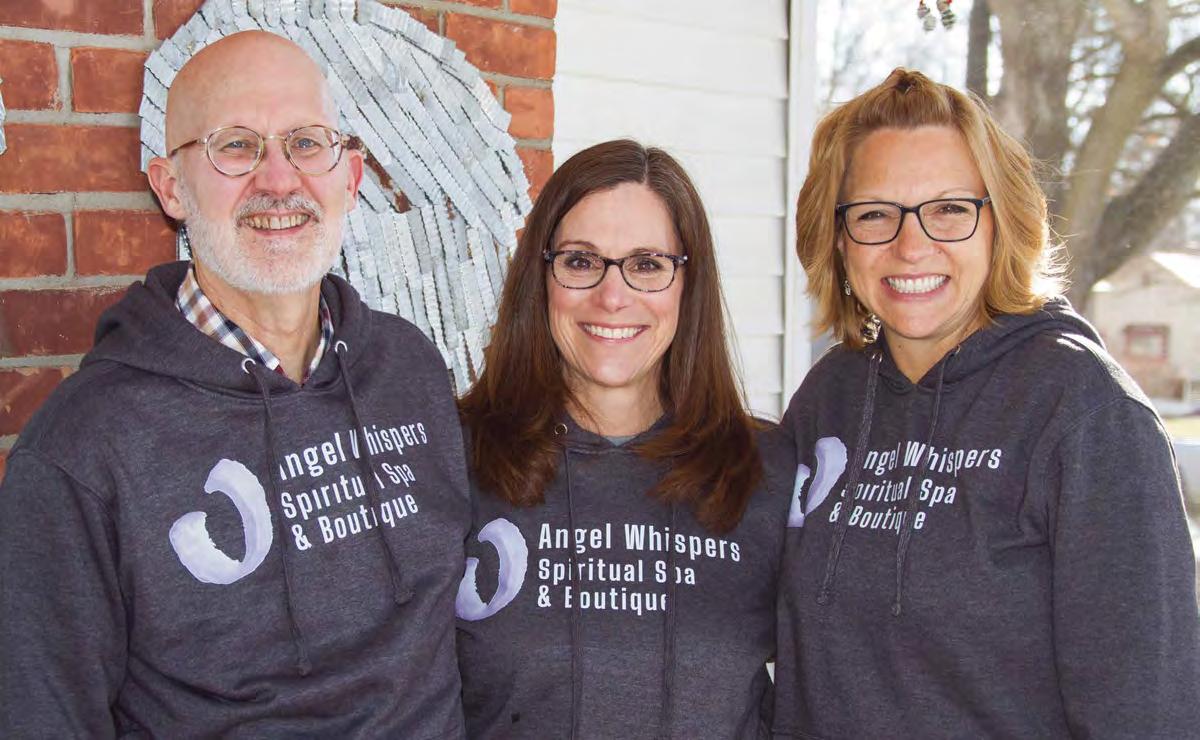
 By Lynda Gronlund
By Lynda Gronlund
Kokopelli’s Korner, a spiritual supply shop in Howell, moved in September from its previous location at 111 East Grand River to its new home at 120 West Grand River.
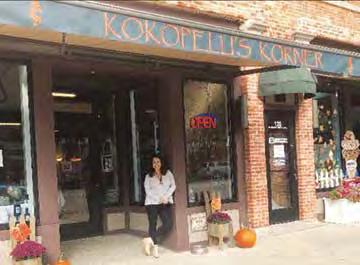
The shop carries a variety of teas, essential oils, crystals, candles, tarot cards, books, jewelry, journals, spiritual décor, and more. Owner Cathy Boaz regularly hosts psychic readers and takes part in downtown Howell’s many seasonal events. Store hours are noon to 4:00 p.m. Monday, and noon to 7:00 p.m. Tuesday through Saturday.
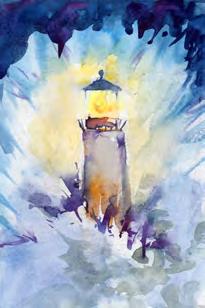
More information is online at kokopelliskorner.com and on the Facebook page at facebook.com/KokopellisKornerHowell. Cathy Boaz can be reached by email at kokopelliskorner@gmail.com.
Susan McGraw started her new business, Divine Inspiration at Work, in 2022.

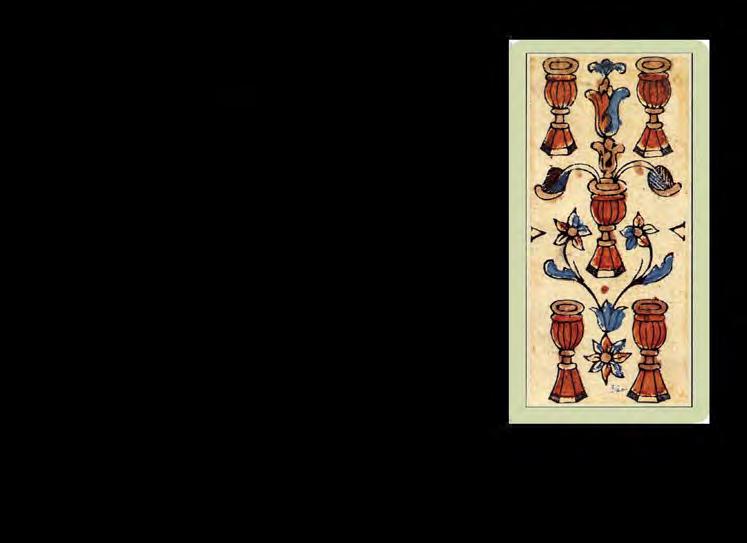

She describes herself as an “intuitive strategist,” offering readings and career and business strategy sessions that blend her psychic and mediumship skills with her expertise from over twenty-five years as a career coach, trainer, professional speaker, and business consultant. Her main aim is to help people combine divine inspiration with concrete action to achieve greater success in their personal and professional endeavors.
In addition to readings and strategy sessions, in November she began offering Master Classes, designed to help participants “design their next chapter.” Each of the three Master Classes consists of two, two-hour sessions over Zoom, in which students learn techniques to access and strengthen their own connection to divine inspiration so that they can “take inspired action.” The three class topics are: Transform Your Personal Life, Transition to a Job You Love, and Become a Spiritual Entrepreneur. McGraw said that a “spiritual entrepreneur” can be someone with a spiritual service such as psychic readings or reiki, or someone with a more mainstream product or service who wants to “bring more of their own spiritual perspective or divine inspiration” to their business.
McGraw said she can also offer resume writing and other support services, with packages available “so that cost is not a barrier.” Most people start with a reading, which usually includes some concrete action steps, and can decide from there with McGraw’s advice what other services they may benefit from. She is the only person she is aware of who is offering a combining of psychic mediumship with business and personal strategy to cultivate a “smooth transition from where you are to where you want to be,” with “support through the entire change process.” She explained that the power of inspiration paired with concrete action is more effective than “trying to force something with intellect and mind and getting frustrated when you don’t get what you had hoped for.” Many people, she said, are “blocked by emotional issues or things from their past. She explained that her readings can help them “unblock and get a higher level of understanding of the wisdom they’ve gained from those experiences, and a better handle on their spiritual evolution.”
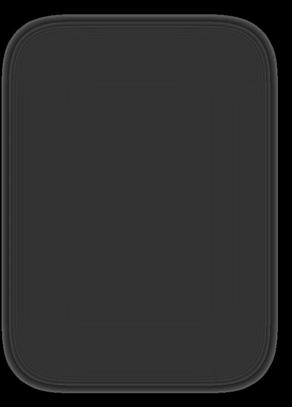
McGraw said she has helped over three thousand people with their careers over the years, helping them find opportunities that match with their unique gifts and what works for them as individuals. One dramatic experience was that she read for a woman who had been living in California her entire life with no intention to relocate. Through McGraw’s reading and examining her own intuition, she ended up moving across the country to North Carolina where she had never been before, transformed her entire personal and professional life, and within nine months was happier and more successful than ever. Of course, not everyone wants or needs to make huge life changes, and sometimes what is needed is a small change in direction. McGraw helps people to tune into their own divine inspiration and intuition so they can take action from there.
More information is online at DivineInspirationAtWork.com. Susan McGraw can be reached via email at Susan@DivineInspirationAtWork.com.
Unity Vibration Kombucha is not new—they opened about fifteen years ago, but they have evolved a lot during that time and continue to keep things fresh with new flavors and collaborations, and new classes and events at their Ypsilanti tasting room.
Founders Rachel and Terek Kanaan started out in 2008 in California, selling homemade kombucha tea out of the back of a van once a week to parents in a school parking lot. They had recently fallen in love with kombucha, a fermented tea that
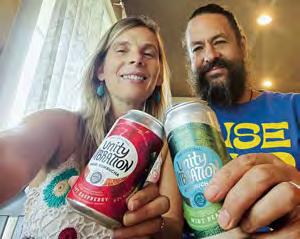




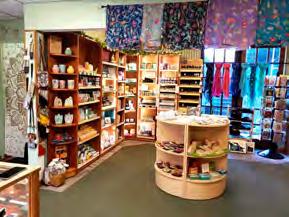




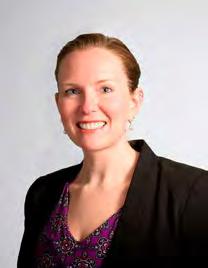
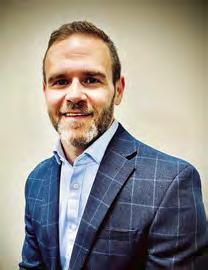
is touted to have several health benefits and making their own was a cost-saving measure since it was expensive for a family with three children. People really liked it, and demand began to grow, until in 2009 the couple moved their family back home to Michigan with their newest, fourth child in tow.
Rachel was a certified massage therapist and Tarek was a mechanical engineer and social worker, but the recession was making it difficult for both to find stable work. They decided it was a great time to go all in on their kombucha business, so they pooled everything they had, a little over ten thousand dollars, to buy tanks and brewing equipment, initially converting a room in their historic Ypsilanti farmhouse into a base of operations. On their own, they were able to get their kombucha tea into Whole Foods and Plum Market, then they hired a distributor and things were progressing well. In the summer of 2010, Rachel said, a nationwide “kombucha crackdown” occurred. As a fermented product, kombucha naturally contains some alcohol, but as a relatively new product the government had not regulated it yet. As it had become very popular, it was decided that kombucha needed to be pulled from shelves to be tested for alcohol content. Like most kombuchas, the Kanaans’ product tested over the legal limit. They had to make the choice to alter the product to make the alcohol limit lower, or to keep it authentic and distribute it as a “beer,” for age twentyone and up. The Kanaans decided on authenticity, shut down for four months to revamp, and released their 1% ABV kombucha tea line. In 2011 they released a new line of higher ABV kombucha beer or hard kombucha, the first company in the country to do so. They moved into their first production facility in an empty warehouse in 2012, and now they are distributed in 23 states.
Something even more unique about their kombucha products, said Rachel, is that they have always used Solfeggio frequencies and Hado, a form of positive written messaging, on the tanks as they are being fermented. She explained that Solfeggio frequencies are sounds that are believed to have positive energetic and healing effects. Hado is the idea that writing or speaking positive words to water alters its properties. So, the idea is that Unity Kombucha products are infused with positive healing energy.
Unity’s Triple Goddess Tasting room on Ecorse in Ypsilanti serves Unity’s kombucha teas, beers, and hosts many events. They have cribbage games on Wednesday evenings, karaoke on the first Friday of each month, frequent tarot reading sessions, open mic nights, and art openings every two to three months. Most nights they are open they host local musicians. In January, they have booked Barker & Broski on the 7th, Cameron & Friends on the 12th, Singer Songwriters in the Round on the 21st, and Robin & Jeremy on the 28th. The Mighty Rhythm Bandits will perform on February 11, and Spark will play on February 25.
A recent addition is a new monthly class on how to make Jun, a particular kind of kombucha made with maple syrup or honey. Rachel said it is likely the only such class in Michigan.
In the spring, they will host an outdoor regional kombucha festival. “We’re kind of quirky people and we do quirky things,” said Rachel of the huge variety of activities.
Unity Kombucha and the Triple Goddess Tasting Room is located at 93 Ecorse Road, Ypsilanti, MI 48198. More information is online at unityvibrationkombucha. com, and any questions can be sent to info@unityvibrationkombucha.com.
The Mix Studios, formerly located in Ann Arbor, moved to Ypsilanti in 2021 and added a second Ypsilanti location in 2022.
Owner and trainer Sarah Kreiner explained that at the start of the Covid-19 pandemic, The Mix was gaining traction in its Ann Arbor location on State Street, where it had been since 2016, with personal training, fitness classes, and nutrition coaching. The building was older and had some issues, so she had been considering a move, but was not able to find the right location, which she is thankful for now. With the pandemic raging, she did not renew the State Street lease, and her team shifted to online offerings, working from “basements and spare bedrooms” until 2021.
When she felt it was time to get back into a physical location, Kreiner had to be very conscious of cost. She had operated in a couple of spaces in Ann Arbor prior to the State Street location, but the affordable spaces were very tucked away with little visibility. She started looking in Ypsilanti, where commercial rents were much lower, and found a place downtown on Cross Street. She hesitated, unsure if her existing clients would be willing to travel to Ypsilanti, and whether there was enough demand in Ypsilanti for personal training and
fitness classes. But she made the leap, and fortunately she has been very successful. The Cross Street location is small, which made sense because she thought she would mostly be serving clients one on one since many people were still very wary about groups. There is an outdoor area at the Cross Street location as well, which was great for groups and low risk for Covid transmission, but that only worked when the weather was cooperative. It turned out there was a big demand for group fitness classes, especially for one of Kreiner’s signature offerings: trampoline fitness classes.
Kreiner started looking for a location with more open space that could be used for group fitness. For a while she used an Ypsilanti church space, but having to haul personal trampolines, sound equipment, and dumbbells in and out every time she held class was taxing.
In June of 2022 she opened The Mix’s River Street location in Ypsilanti’s Depot Town area. This is where most of the group classes are held: trampoline classes Gentle Bounce, Bounce 1, and Bounce 2 for different fitness levels; strength classes Mix Total Body; a variety of Yoga classes including Yin, Iyengar, and Yoga for Larger Bodies; and their newest offering: Cardio Drumming. There are currently nineteen trainers and instructors working between the two locations.
Kreiner became a personal trainer in 2009 and said she has always striven to “meet people where they are at.” She said that many trainers focus on pushing clients as hard as possible, while she focuses on working smart and safe, not going all out to the point of injury and burnout. “We want you to feel good for life and for whatever you want to do with your life.” About her trampoline classes, she said that many people are nervous to try it, but that “it’s honestly the most fun you’ll have working out.” She explained that it’s low impact, great for people who can’t or don’t want to run and helps with cardiovascular fitness and flexibility. She is very focused on helping people feel comfortable with it.

The Mix Studios’ River Street location is at 306 North River Street, Ypsilanti, MI 48198. The Cross Street location is at 511 West Cross Street, Ypsilanti, MI 48197. Schedules and information are online at the-mix-studios.com, and Sarah Kreiner can be reached at sarah@the-mix-studios.com or at (734) 845-9105.
The Tea Haus, located in Ann Arbor’s Kerrytown district, has undergone remodeling and some exciting changes since the Covid-19 pandemic changed everything, and is reopening in late November 2022

“We haven’t really been open in the same way we were since March 2022,” said owner Lisa McDonald. The original space opened at 204 North 4th Street 15 years ago, she said, and over time expanded into a neighboring space. This new renovation actually rebuilt the wall between 204 and the adjoining space, where a chocolate shop now resides, and knocked down a wall to the adjoining corner space on the other side, where McDonald said the ceilings are higher, there are more windows, and while not much bigger in terms of square feet, is “one big space rather than a long skinny space.”

“Winter’s

Continued from page 19
One exciting new feature is a liquor license, which will allow the Tea Haus to begin serving tea cocktails and tea-infused beers. There will no longer be a full kitchen, but food will still be served. McDonald described it as more of a lounge café style instead of the previous restaurant style. She is keeping the event space around the corner, where she can host events, and where there is a main kitchen that will supply the cafe. There will be new extended hours since they will be serving alcohol, but she wanted to make sure to be respectful of the neighbors upstairs and nearby. To that end, they plan to be open Tuesday through Saturday 10:00 am to 10:00 pm, Sunday 10:00 am to 4:00 pm, and will be closed on Mondays.
Early in the pandemic, McDonald started a free meal program out of the Tea Haus to help families impacted by the school closures. As someone who benefitted from free school meals when her child was growing up, she said it was very important to her to help make sure children were fed. She said that even in relatively affluent Ann Arbor, some families really counted on meals provided by the schools to help feed their children. She raised the wages of her employees so they would no longer be dependent on tips, and they in turn agreed to donate tips toward the free meals program. They were providing five hundred sack lunches per week at the peak. Now, the cost of the program is simply factored into the business costs; as they transitioned back into more customer facing work employees are still paid at the higher rate and participate in tip pooling, and McDonald says she simply buys supplies for the meals program along with other supplies for the business. They now make about three hundred free meals per week, which are now hot meals delivered to the Food Gatherers Community Kitchen and a few other drop off points.
Another change to the Tea Haus, said McDonald, is that it will be wifi and electronic-free. There will be a lounge space with puzzles, games, magazines, and newspapers. She feels that with the pandemic forcing everyone to be online so much, it’s important to “reconnect by disconnecting.” She said it’s fine with her if someone comes in and reads a book for six hours, as it’s not about monetizing the space. She is passionate about the “third space”— a communal place that is separate from home and work, being closer to “home” than “work,” and one way we are more tied to work at all times is by always being connected electronically.
A final piece of news is that McDonald has co-authored a new book in the popular “For Dummies” series: Tea for Dummies, which will be released in March 2023. She said she was approached by the publisher via email and originally thought it was a scam, but that they eventually called her and she agreed. She is one of very few European trained tea sommeliers in the country and said she and her coauthor Jill Rheinheimer, who has written the Tea Haus blog with her for the last eight years and is a research writer at the University of Michigan, had a hard time keeping it to the required three hundred sixty five pages. “Tea is the second most consumed beverage in the world after water,” she said, so there is a lot to know.
The Tea Haus is located at 200-204 North 4th Avenue, Ann Arbor, MI 4804. More information is online at TeaHaus.com, and Lisa McDonald can be reached via email at Lisa@TeaHaus.com.
Peggy Alaniz, who writes the tea column for The Crazy Wisdom Community Journal, recently published her short memoir “Stuck” in the newest installment of the long running Chicken Soup for the Soul series: My Wacky Wonderful Family, released on November 1.
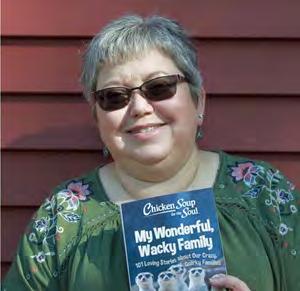
It recalls a trip she took with her family as a child to Arches National Park in South Dakota. She was in a large motorhome with her family, her uncle who was a professional truck driver at the wheel. They entered one of the park’s rock formations, which people drive through all the time, but the motorhome was too big for the tight turn inside and got stuck. The road through was one way and there were cars backed up behind them, so her uncle had to remove a side mirror and some trim, and still scraped one side of the motorhome badly getting out. The whole ordeal took about forty-five minutes, said Alaniz, and her aunt was intently reading a book the entire time and never noticed anything was wrong.
Peggy Alaniz has a website at teatravelsandspirits.com and can be reached by email at paalaniz.email.me@gmail.com.

Sifu Joseph Wang has been teaching Tai-Chi for seventeen years at Ann Arbor’s Sun Shen Tai Chi under its founder Master Daniel Kim and offers life coaching based
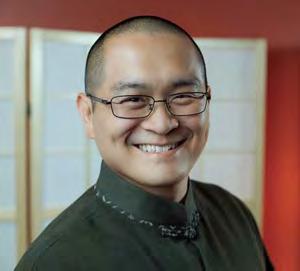
Starting in January he will be offering a new weekly group session on a practice called “Basking in the Bubble.” This practice, he explained, helps people to navigate through negative emotions like anxiety, dread, and overwhelm, and can even help to reduce panic attacks. Negative emotions, he said are “driven by our needs,” even though we often resist them and don’t want to experience them. Basking in the Bubble is a way for people to experience these negative emotions, feeling them in the mind and body, so that they can be released. When negative emotions are resisted, he said, they get stuck and can eventually fester into diseases. If we take the time to feel through and release the emotions, which he said takes the same amount of time as it does to resist them, we can get to the positive emotion behind them. For example, he said that when he feels overwhelmed, behind that emotion is the desire to feel accomplished. He said that people often get stuck in a pattern of chasing the next high of achievement or the next exciting thing in life and have a hard time enjoying themselves in the present moment. “When you feel good you get the whole spectrum including the positive,” he said. Using the bubble practice can help people find satisfaction in the moment, instead of always having to chase the moment. He likened using the practice to emotional hygiene, akin to brushing one’s teeth or taking a shower. The consequences of poor hygiene are apparent, but he said that without taking care of our emotions on a regular basis, those negative emotions build up and can cause problems, both mentally and physically.
The bubble, he explained, is the aura. Basking in the bubble means that instead of trying to make a change or push emotions away, one sits and relaxes the body, experiences the negative emotion flowing through until it flows out, so that positive energy can flow in. He said the experience is like being wrapped in a warm blanket or cocoon, noticing where the emotions are experienced in the body, then relaxing the tensions in order to release the emotions. Meditation, he explained, is usually very focused on the mind and somewhat on the body, whereas this practice integrates mind, body, heart, and emotions. People who have tried meditation and not found it helpful in dealing with stress, anxiety, and other negative emotions might find this to be what they are looking for.
Wang uses this practice with his private life coaching clients but starting on January 16 he will be offering a weekly group Zoom session on Mondays at noon for up to twenty people. The cost will be on a sliding scale to make it as accessible as possible.
For more information or to register for the group, see group.taocoach.org. Sifu Joseph Wang can be reached by email at sifuwang@taocoach.org or by phone at (734) 531-8796.
on Taoist principles.Alaniz has taught writing at Jackson College and Baker College. She is working on a longer memoir about a trip she took to Colorado during to the pandemic, along with some other projects.
Let it snow, let it snow, let it snow!




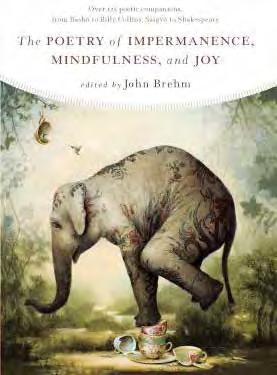




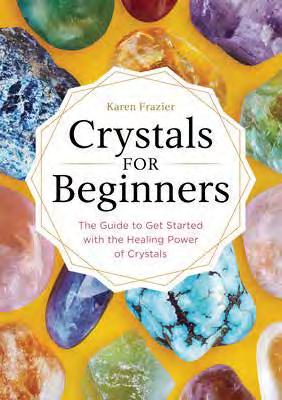
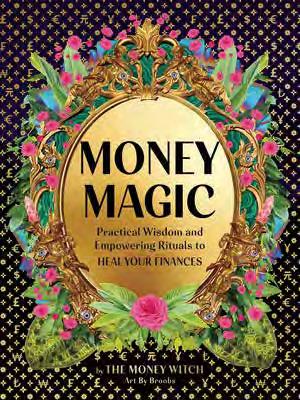



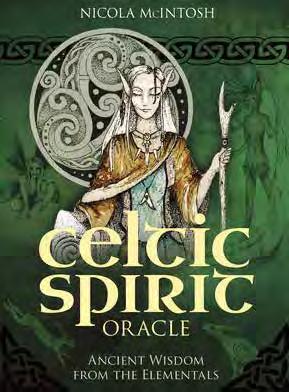
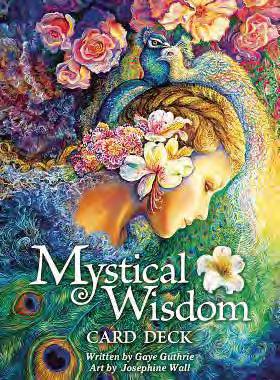




She also started working with photography, offering mini sessions for neighborhood families outdoors. This was very popular, and again served her need to socialize in safe ways.
Eventually, she was able to go back to medical school, which she said, “really takes all of you.” She said it was difficult being a mother in medical school. In January, she decided to take a leave of absence and monetize the side hustles she had started while staying at home.
Angel Whispers is a 501c3 federal nonprofit organization dedicated to “help people learn the importance of self-love and to find wholeness in mind, body, and spirit through the blending of faith and energy medicine.” The space contains a boutique of gifts, crafts, and artwork by local artists. Every guest is offered a free cup of tea. The spa portion of the space contains a massage chair, a physiotherapy table, and a Breathscape Vibro-Acoustic Sound Therapy Table, which Lovell described as “turning your breath into music.” The table is one of three that currently exist, and the only one being used in a spa. Groth offers reiki sessions by appointment, and together Lovell and Groth offer their signature “Wondertwinning” sessions, combining reiki, sound healing, and prayer, to help clients with issues like stress, anxiety, trauma, and grief. McConnell is a certified Spiritual Director and can help people explore their spiritual journeys. Lovell offers pastoral care, pre-marital counseling, wedding and funeral services, and general spiritual counseling.
All three lead Living RED, the worshipping component of Angel Whispers Ministries. Lovell explained: “The goal is for people to R – recharge their souls, E – engage with others, and D – discover something new.”
Angel Whispers hosts a monthly meditation and sound bath at Verapose Yoga House in Dexter on the third Wednesday of each month at 7:30pm. Each Monday at 12:30pm they hold a spiritual discussion at the spa with all faiths welcome. They also host regular drum circles, book studies, meditations, retreats, and special events. The Grand Opening took place on November 11, 2022 at 11:11am with a ribbon cutting and a variety of activities including a drum circle, painting rocks with positive messages to leave around Dexter, and writing Christmas cards for prisoners through a prison ministry.
Lovell said that their desire is for the “whole place to feel like a hug for your soul.”
“We’re most excited about the people we’re meeting who would never go to a church but want to belong to something… who don’t want to be constrained by a lot of rules to worship together or do life together,” she said.
One of the most distinctive features of the space is the angel wings mural out front that was created from metal by local artist Amy Crowly, who Lovell said didn’t measure anything, but simply let herself be led by spirit to create the piece which turned out to fit perfectly. People have “come out of the woodwork,” she said, to contribute in many ways to making the space beautiful and functional. Their current project is painting and remodeling the attic space from a dark storage area to a useable and cheerful part of the building.
Angel Whispers Spiritual Spa & Boutique is located at 7940 Ann Arbor Street, Dexter, MI 48130. More information is available at angelwhispersspiritualspa. com. Danielle Groth and Vicky Lovell can be reached by phone at (734) 2762682 or by email at info@angelwhispers.org.

When the Covid-19 Pandemic interrupted Grace Han’s medical school journey at the University of Michigan, she passed the time caring for her young daughter, and also by developing two passions: photography and baking.
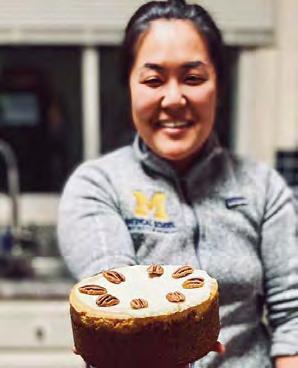
Living in a tight-knit Ann Arbor neighborhood and craving community (I’m a total extrovert,” she said), Han began teaching herself baking. She would bake some treats, put out a notice to the neighborhood listserv, and place them on her porch free for neighbors to enjoy. After a while of doing this, she was thrilled to see that neighbors would be lined up, masked and at a six-foot distance, but still chatting, reconnecting, and enjoying one another. She loved the simplicity of baking, she said. “It’s simple in the sense that you measure things out, and put things together, and create a product. And somehow that product brings people tremendous joy, even something as simple as a cookie.”
The Little Porch Bakery is Han’s baking business. Hers is considered a cottage kitchen operation under Michigan law, which allows certain foods made in home kitchens to be sold directly to consumers. Once a week, she decides what to make, does a test batch, takes some photos, posts the pictures on her Instagram and listserv, and the items usually sell out very quickly. She does offer some special orders, and she especially likes working with Asian inspired desserts. Han is Korean herself and enjoys working with Japanese and Korean inspired flavors. Before moving to Ann Arbor for medical school, she lived in Los Angeles, which she described as “a mecca of amazing Asian Food,” and she is glad to see there is a lot of appreciation for these types of foods in Ann Arbor. Her neighbors named her business, and a talented friend designed a logo she says looks like her porch, where it all started.
Her photography offerings took off again after she went on leave, and she said she has photographed a lot of graduating seniors, medical school head shots, family portraits, and even some influencers. She said there seems to be a shortage of BIPOC photographers in the area, and that a lot of photographer’s websites don’t feature many people of color or even seem to whitewash people’s faces. She also said it’s hard to find affordable photography, and she wants to make it accessible especially for people of color and people who might not otherwise invest in professional photos. She said she loves and is great with kids, which parents appreciate in a family photographer.
Han says she will return to medical school to become an OBGYN at some point, but for the moment she is treasuring time with her daughter, being in her midthirties and having agency over her time again.
Grace Han’s Little Porch Bakery Instagram is at instagram.com/porchbakery. Her photography business is at madebygracehan.com and anyone interested in working with her can reach out through the contact page.
Submit your listing for the May through August 2023 issue. Please note that the “What’s New in the Community” column is part of the editorial (not paid-for-advertising) part of the CW Journal, and the editors may or may not include what you submit. Whether the editors include material or not will depend on space considerations, as well as other editorial issues, such as the need for high resolution jpgs and the overall mix of stories included in the “What’s New in the Community” column in a given issue.
If you would like to submit information to be considered for this column, please email communitynews@crazywisdom.net, or drop off or mail information to the store: What’s New in the Community, 114 South Main, Ann Arbor, MI, 48104. The firm deadline for submissions for the next issue (May thru Aug. 2023) is March 1, 2023.

I’ve heard you talk about a “Word of the Year” before in classes and was curious if this is the same as a New Year’s Resolution, and how you use this in your yoga practice. I am hoping to incorporate something similar in 2023 for a little inspiration!
Dear Toni,
I am so glad that you noticed the “Word of the Year!” This is certainly not something exclusive to Verapose, though it is a practice we have incorporated for the majority of our seven years in business. We view our word of the year as more aligned with the word Sankalpa, or intention, then with a resolution.

Whether you're a seasoned yogi or getting ready to roll out your mat for the first time, here you'll find a variety of useful tips from local yoga instructor, Katie Hoener.


I am sitting more than usual, and my legs are tight. I feel like I need something that I can do for a few minutes between meetings. I would love to take props, but I am moving around a bit much between offices to have props everywhere. Any recommendations?
Yes, the nature of our occupations and our day to day lives has changed the ways in which we engage with our bodies. Many of us have been working more hours in challenging spaces, and many converting spaces that we used for rest into work areas. This has caused cumulative stress on that movement, and release can be really beneficial. There are all sorts of seated releases for the body to engage in during virtual meetings. I highly recommend a few seated cat-cows each day to move the spine and keep us thinking about alignment.
For in-between spaces, take a moment to lie down! I know, some of us are looking at the ground/floor with a healthy dose of skepticism. Let’s give it a go. Releasing the back body into the floor is powerful. Take a few breaths here. Either with your feet planted near the glutes, or legs extended, draw one knee in toward the body. In this Apanasana, there are many choices. We’ve already checked in on the variations of the lower leg. We can also vary the degree to which the leg moves in toward the body. In the photo I have shared,my arms have some bend and are guiding my leg in the direction of the torso rather than pulling. We should strive for that Aparigraha, or non-clenching, in our postures. Take a few breaths in the space and explore where there are points of release, places to surrender. Perhaps there are spaces in the hips, in the shoulders, in the low back. When you are ready, switch sides. Allow yourself to return to a side that needs the attention or to stay longer in one space if needed. Enjoy the time to soften and relax.
Namaste Katie,
I have, over the last few years, developed a regular meditation practice. Of late, my mind has been very active and harder and harder to wrangle in my morning sessions. I continue to sit, yet I am becoming more and more frustrated. I know that moving into the space with a sense of frustration is likely not helping, so I am reaching out for some support!
Dear Prithi,
Yes, moving from a place of frustration can cause us additional frustration, and lead us down that vicious cycle. Michael Singer, in The Untethered Soul talks about our Inner Roommate as the voice in our heads that is constantly narrating our experiences and provides us with a sense of control. The first step for any of us is noticing the movement and motions of our Inner Roommate, as you have begun to do. This awareness assists us with noticing patterns, and those likely distraction points for the active mind. Finding solace in our active minds, and that awareness, can be part of the process, and as you have been beautifully aware, a challenging one!
The Yoga Sutras recommend that we stick with the form of meditation that is working for us, noting that consistency is a big part of developing those quiet spaces. We also allow ourselves the space to notice when something isn’t clicking. When our Inner Roommate is taking over and dominating the time that we have set aside for our practice, we may ask ourselves if it is time to switch things up. This may be a time to try out some mantra meditation (which can be external or internal). You may need a guided meditation to draw your focus: this may also be the space for a walking meditation to engage the body and the mind together. Doing so, in a kind and caring way, can help to soften your frustrations--and if one of these clicks with you, stick with it for a while. Have this be your consistent and kind space for as long as you need.
Rod Stryker in his book The Four Desires, dives deep into this ancient concept of Sankalpa, tracing it back to the Rig Veda, one of the first yogic texts. He draws the distinction of a resolution often being more tied to our desires, and a Salkapa being connected to purpose. For example, I may have a resolution to meditate every day, something I struggle with, and when I chase this desire and fail (I am intentionally using strong language here), I am hard on myself. In 2022, I chose Reflection as my word of the year. This allowed and encouraged me to think of all the ways I am able to slow down, quiet down, and engage in more contemplative practices. Through my Sankalpa, I was able to expand my definition: some days this reflection was meditation, some days it was journaling, a walk in the woods, or other reflective practices.
Sankalpas move us closer to that intention through our resolve, and through our willingness to be creative and purposeful. Word of the Year is a broad Sankalpa, and there are times when we are going to want to sharpen our focus and our resolve; this may or may not be one of those times, depending on your vision for 2023. Much like all Sankalpas, yours isn’t set in stone. My amazing yoga partner Courtney loves a hyphenated word of the year, something like Reflective-Rest-Resolve, or something else fun. Try something out! You’ll know it when you have the right word choice.
Many of us have been working more hours in challenging spaces, and many converting spaces that we used for rest into work areas...take a moment to lie down!
I feel in a way that my whole raison d’etre in medicine has been to try to help people by listening to their stories and honoring their own path in seeking to achieve the best health possible for them.

Dr. Amy Saunders is one of the leading integrative medicine doctors in the area. We had profiled her ten years ago, and we wanted to check back in with her, and see how she had viewed Covid, and hear her current points of view on her medical practice and providing integrative care. We also were hoping to talk with her about the influences which shaped her becoming the attuned, committed and deeply caring physician that she is known to be.
Dr. Saunders was born and raised in Findlay, Ohio, and lived there through high school. She went to Kenyon College for 2 years, and completed her BS and MD at Ohio State, and she also completed her Internal Medicine residency there. Additionally, she has a master’s degree in Public Health from the University of North Carolina.
Dr. Saunders focused on patient care and teaching during her 20 years on the medical staff at University of Michigan Hospital. She then went into her own private practice, Integrative Healthcare Providers (IHCP) which is located on South State Street near Briarwood Mall. As she explains in the interview, the practice is a collaborative one, and there are a variety of other integrative health care practitioners sharing the same office.
Dr. Saunders has been married for 43 years to David Rooney, whom she met in high school. They live in the Lansdowne neighborhood of Ann Arbor. They have two daughters. Their oldest, Kate (33), lives in Ann Arbor with her husband, Cade Sperlich, and their young son, Ellis. Their younger daughter, Liz (28), lives in Ypsilanti.
In person, Dr. Saunders is soft-spoken, attentive, reflective, and easy to enjoy talking with. She smiles readily and has an elfin twinkle in her eyes. She loves getting together with her family, cooking together, and playing games. Her “guilty pleasure is watching college football in the fall and rooting for the Ohio State Buckeyes (though our Kate does not understand this).”
Bill Zirinsky: What is incorporated into your sense of integrative medicine and integrative health care?

Dr. Amy Saunders: There are so many modalities and approaches to care that can be beneficial! It is simplest to outline some of the modalities I incorporate by the kinds of health problems they can benefit.
Musculoskeletal pain: My first experience with realizing how effective nonallopathic modalities can be in treating health problems was through my work with physical therapists taking care of mutual patients with chest pain, back pain, and headaches. Many PTs in Ann Arbor do a great deal of manual therapy – realigning vertebrae, ribs and pelvis and other musculoskeletal regions that can cause extreme discomfort when out of balance. I think malalignment is a cause of a great deal of pain and disability that is underrecognized by most allopathic providers. Unlike many physicians, for me it was a logical step to go from appreciating what PT’s can do to appreciating chiropractic skills and massage therapists’ skills. I have also observed that craniosacral massage is helpful for many patients who have suffered even minor trauma and who have persistent unexplained neurologic or musculoskeletal symptoms.
I also use light therapy, also known as cold laser or LED treatments for both musculoskeletal problems and for wound/fracture healing. It can also be highly effective in helping to relieve muscle spasm. I first learned about that modality from a local veterinarian, as vets use it far more than allopathic providers, even though there are lots of well-designed research trials documenting its efficacy. The fact that the FDA has still considered it experimental therapy and insurance does not cover it is a testament to how biased toward the pharmaceutical industry they are, unfortunately.
Metabolic imbalances: I use herbal therapies or biologic supplements in situations where there seems to be either metabolic imbalance or high levels of inflammation. Philosophically, I have come to appreciate that trying to figure out how someone’s body is out of balance is generally much more useful than trying to find a disease diagnosis label. And each of us can get out of balance in our own unique ways based on genetic, environmental and lifestyle factors. Diagnostically I utilize some functional medicine testing to try to determine
what is out of balance in the individual patient. For example, stool tests that are unavailable in the allopathic medical setting -- tests that look at markers of inflammation and the health of the microbiome -- can be invaluable in helping a person get back in balance. In addition, nutritional assessments, including nutritional markers and sometimes food sensitivities, can be very valuable in directing healthcare and advising diet/lifestyle adjustments. A healthy diet is probably the most important factor in maintaining health, and a much more important source of balanced nutrients than a boatload of supplements.
Inflammation: There are many clinicians and researchers of all stripes who believe that inflammation lies at the center of most chronic health problems, either as a trigger for illness or as secondary effect: diabetes, coronary heart disease, cancer, dementia, peripheral vascular disease. As a global theory of inflammation as cause of illness the idea is that the body responds to chronic inflammation – whether it is low grade gum inflammation or the lining of the gut for example – the body responds with a cellular response that increases production of inflammatory molecules – that can lead to membrane and intracellular injury in other parts of the body. Therapeutic approaches to reduce inflammation primarily involves avoiding toxins and maintaining an anti-inflammatory diet. In addition, advising use of supplements that have antiinflammatory effects such as turmeric, quercetin, boswellia, and others when appropriate can be very helpful.
In terms of diagnostic methodologies, the kind of testing we utilize in addition to allopathic pathology lab testing often aims to measure active cellular or organ processes – hence the name “Functional Medicine” testing.
For instance, GI function tests measure presence of inflammation, assesses digestive markers, and the health of the microbiome, the bacteria in the gut. This test provides way more information than available allopathic lab tests.
Adrenal functioning can also be measured in a much more useful way than what was available to me at U of M, looking at cortisol changes through the day as well as the ratio between cortisol and other adrenal hormones that address the issue of whether chronic stress has been taking a toll on the adrenal gland.
Methylation Panel and genetic testing is at a more advanced state through independent labs like Genova Diagnostics and others than it is at U of M and other academic labs. While we have to be careful to make sure we are not placing too much certainty or getting too specific about our test conclusions, I am confident that these functional medicine tests provide valid information that allopathic medicine will adopt some time in the future, just as they have adopted tests for small intestinal bacterial overgrowth and leaky gut. I feel fortunate to be able to make the choice to use these tests now.
But to be honest, in this process of trying to help someone, I often try to use my sense of intuition, which I believe is one of the most important tools that any person in a healing profession has. Our tests are not perfect and our understanding of them is even farther from perfect. I describe myself as the “queen of empiricism” because, in most cases, the approach that we take (the patient and I, as a team) is one of “let us try this and see how you do. If that does not solve the problem fully then we can talk about what other steps we can take.” That is the strength of both integrative medicine and primary care –time can be an ally in finding solutions. My intuition and sense of what may be out of balance may also lead me to recommend different things – like walking in nature, meditation, singing, journaling, or even encouraging addressing grief or conflicts within one’s family, for example. That is another strength of practicing integrative medicine as a primary care provider: when you have a longstanding relationship with a patient you can better understand how their life affects their health.
I also refer to my colleagues who practice Traditional Chinese Medicine, acupuncture, ayurvedic medicine, massage and many forms of energy medicine such as Reiki, polarity, Healing Touch, trauma touch, reflexology and others. I cannot begin to express my respect for them and the ways that they help people heal. As I get older, I have an ever-growing appreciation of the fact that there are ways of knowing and healing that I only have a superficial understanding of.



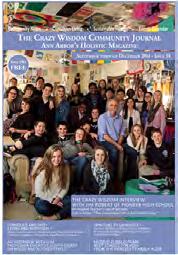

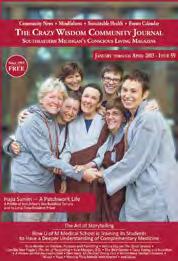

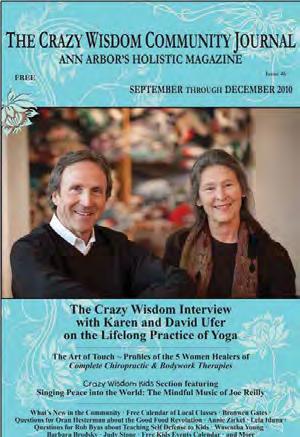
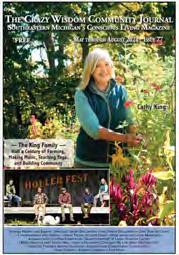
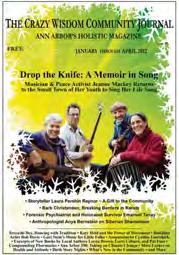
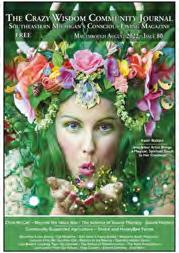
I also refer to my colleagues who practice Traditional Chinese Medicine, acupuncture, ayurvedic medicine, massage, and many forms of energy medicine such as Reiki, polarity, Healing Touch, trauma touch, reflexology, and others. I cannot begin to express my respect for them and the ways that they help people heal. As I get older, I have an ever-growing appreciation of the fact that there are ways of knowing and healing that I only have a superficial understanding of.
Bill Zirinsky: Can you tell us about the other practitioners in your clinic?
Dr. Amy Saunders: At Integrative Health Care Providers (IHCP), each of the practitioners has her/his own panel of patients and integrative care approach and that is one of the greatest strengths of our clinic, I think. I am an internist and see only people older than 15. Drs. Amanda Dakroub and Sean Zager are Family practitioners and are both Board-Certified in Integrative Medicine. Dr. Dakroub has a large primary care practice with a very broad range of knowledge about integrative modalities. She also has a substantial number of transgender patients. She is one of a fairly small number of primary care practitioners in the community who is very experienced in pharmacologic and psychosocial care for that population and works in collaboration with the Comprehensive Gender Services program at U of Michigan.
Dr. Zager is the only male physician in our clinic and has a special interest in providing integrative care for men. He also has extensive experience in evaluating and managing functional GI abnormalities. He has conducted some educational programs for patient groups, where information and patient experiences can be shared to enhance understanding
Dr. Wendy Luo is a Physical Medicine and Rehab physician who is also trained in integrative medicine and has expertise in acupuncture for pain relief and uses integrative approaches for management of headaches, chronic pain, insomnia and for weight loss.
We also have two excellent nurse practitioners, both of whom have certification in adult general primary care. Brenna Reichman has additional training in transgender care and women’s health, and Paula Esteva Slack is certified in gerontology as well as experienced in cardiology and care of patients with complex medical histories. They both also have great enthusiasm for, and growing experience with, a broad range of integrative approaches to primary care.
We are extremely fortunate to also have an acupuncturist, a massage therapist, and a psychotherapist on our team who have many years of experience and longstanding success in their individual practices. We are so lucky to have Abby Humphrey in our clinic. She was a cofounder of the Center for Sacred Healing. She really enjoys collaborating with our physicians in patient care. She provides Traditional Chinese medicine diagnostics and therapeutics, utilizing acupuncture, cupping and TCM herbal blends in her therapy. She provides general care but also has specific expertise in treatment of women’s hormonal issues, long Covid symptoms, aesthetic acupuncture, and anxiety. Prema Smith is a massage therapist well known in the IM community who has expertise in many different modalities including Thai, Swedish, shiatsu, Lomi Lomi as well as neuromuscular massage. Robert Piper is a clinical social worker who uses an integrative approach in his counseling practice, including mindfulness techniques, and hypnosis as indicated.
We are looking for another practitioner to join us. It would be great if we could have a like-minded DO or MD join us who is interested in providing integrative primary care to the general community because there is a shortage of primary care providers, especially independent ones, and we want to provide a supportive place for others who share that goal. But we are definitely open to welcoming other kinds of providers especially nutritionists, manual therapists, and naturopaths.
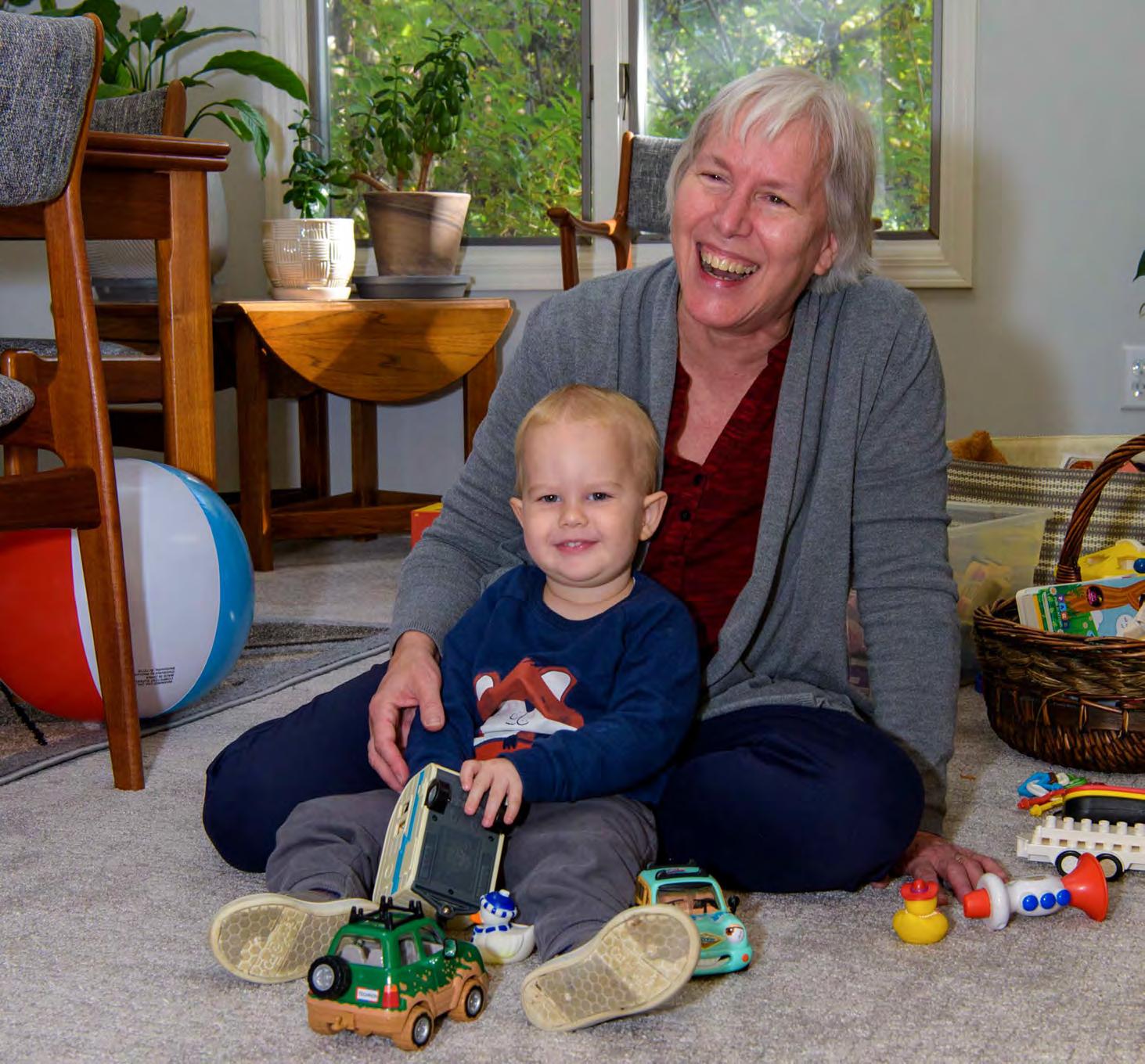
I would be remiss if I didn’t mention our staff of dedicated administrative assistants, Jessica, Valerie, Suzanne and Kate. They all go above and beyond what is typically expected in their dedication to helping all of our practitioners provide the best and most timely care possible for our patients. They know and care about the patients, they understand the unique aspects of combining high quality allopathic care with other modes of care that may require out of pocket expenses. They work diligently to get patients the information, referrals and clinic visits they need. We could not do what we do without each one of them.
Once my mind was opened, I chose to apply for the Faculty Scholars Program in Integrative Medicine at University of Michigan. It was co-created by Dr. Sara Warber and Dr. Rita Benn. The program was designed to bring faculty members from vastly different fields together for a monthly seminar where we learned about different integrative modalities. We met and observed local practitioners.
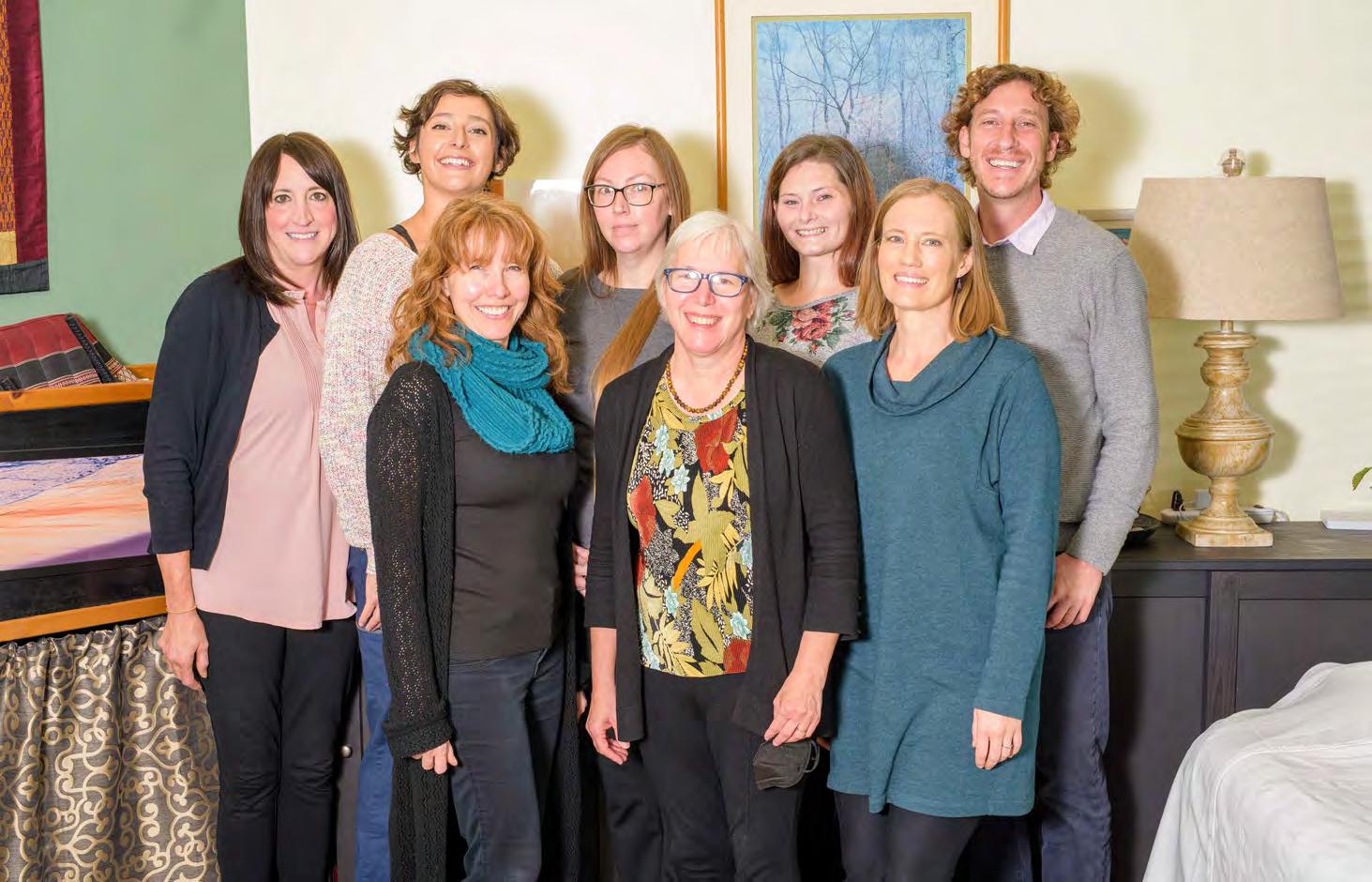
Bill Zirinsky: Dr. Saunders, please tell us how your clinic has fared with Covid over this time? It will soon be three years since the pandemic began?
Dr. Amy Saunders: When the pandemic first started, and schools and businesses shut down we had no idea how long this would last. It seemed like emergency management decisions were needed for what we thought would be a short-term problem. It was an easy business choice to convert our clinic into a remote telemedicine design. My staff and colleagues were very dedicated, and care from home was surprisingly manageable. But then… Covid dragged on and on, with new variants occurring and neither vaccines nor prior illness providing persistent immunity from getting Covid in the future. We have had only a modest number of patients who have rebelled against the CDC guidelines for mask wearing but many people have become frustrated that the measures taken have not successfully ended the pandemic.
We have continued to employ a hybrid patient-care design where each practitioner has some telemedicine days and some in-clinic patient days, and I think that will be an ongoing workable model. In our clinic, it has been required to wear masks ever since the beginning of the pandemic and will continue to be until the prevalence of Covid substantially drops, as it has begun to do. Masks have been quite effective – most people who get Covid have had exposure among family or at indoor events or restaurants where they are unmasked There have been no cases of Covid among our patients or staff that were caused by exposure at our clinic. That being said, 3-4 of our staff have gotten Covid through exposure in the community or in their homes, and I estimate that 1 of every 4-5 of my patients has had it. The majority of my patients were vaccinated, but among the vaccinated folks who got Covid, most got sick several months after their vaccination. Most have had mild illnesses but a few developed long Covid. We are lucky that Abby Humphrey, the acupuncturist in our clinic, has had good success treating patient with long covid symptoms especially fatigue and brain fog. B vitamins, Vitamin D and C, quercetin, as well as N-acetyl cysteine appear to be helpful in mitigating the effects of Covid.
The incidence of Covid in our clinic is lower than the incidence in Washtenaw County. In Washtenaw County, there have been over 99,700 cases of Covid, and that is likely a substantial underestimation given the home tests that never get reported. The population of the county is 372,000. That does not mean that 1 in 3 or 4 people have gotten Covid, as there are people who have gotten Covid multiple times, but it is probably close.
I don’t think I would have had the courage to do it on my own and truly it was the best thing that could have happened for my career and my life in general. It helped me become the kind of doctor I wanted to be, gave me the courage to embrace more fully a holistic approach to medicine, and has allowed me to work with the amazing colleagues I work with today.



I am hopeful that the combination of three factors will help us finally turn the corner on this pandemic: the first is the increasing percentage of the population that has either recently been vaccinated or recently been infected. who will be protected from infection for at least 3 months, on average. The second is the new vaccine that is now available for everyone that has improved activity (though not perfect) for the omicron variant. The third is the fact that there have not been new variants galloping across the globe recently, that would lead to a whole new cycle of infection and contagiousness. These factors give us the best chance yet of achieving “herd immunity” – a state where the risk of getting sick – either for the first time or repeated is low -- that it will continue to become less virulent over time. I am looking forward to being able to dine inside at a restaurant sometime this year.
Covid has revealed so much about how our society works. It has helped uncover deep differences we have in opinion about our individual responsibility for helping to maintain the health of the community. While I think the vast majority of people who rebelled against wearing masks and getting vaccinated would be very willing to help a neighbor in distress, many were not willing to acknowledge our role in potentially making others sick. This was especially disheartening early in the pandemic when the hospitalization and death rate were high. Even now, when long Covid can have long term physical, economic and emotional impacts on people, I am discouraged when I hear people dismiss the significance of this illness and the importance for all of us to deal with the consequences of this pandemic.
I am told frequently by my academic colleagues that it is impossible to have a private practice these days and that all individual practices will soon be bought out by healthcare corporations. But I disagree. I also think that the potential for happiness in practicing medicine is greatest in private practice where we have the autonomy to shape our practices the way we want.


Dr. Amy Saunders: I feel in a way that my whole raison d’etre in medicine has been to try to help people by listening to their stories and honoring their own path in seeking to achieve the best health possible for them. My childhood and family trauma history paved the way for that, no doubt. I was left with an early recognition that terrible things happen sometimes and often nobody can say why, and nobody can fix them. But we still must find the best most healthy path through that. In that sense I feel that facing health problems or social problems is our best practice for facing the ultimate “unfixable” issue of our mortality –how do we find our best path when we know that we cannot change that?
My Public Health education gave me a perspective that kept me from getting the myopia that so many doctors have, that the physician is the central character in a person’s healthcare My interest in integrative medicine truly was initially fueled by my recognition that there were so many medical problems that my patients had that we in allopathic medicine were not doing a good enough job providing care for. Chronic musculoskeletal pain, digestive problems, anxiety, insomnia, fatigue, headaches. I thought surely there must be other ways to address these problems beyond the fairly limited number of treatment choices we were taught! When I began to see that musculoskeletal pain was frequently managed much better by PT’s, massage therapists, chiropractors, posture specialists and herbal therapies than by any tools that I had in my doctor bag, that was the thing that began to open my eyes to whole new realms of healthcare.


healthcare is going. I rebel against that with every fiber of my being.


Once my mind was opened, I chose to apply for the Faculty Scholars Program in Integrative Medicine at University of Michigan. Dr. Sara Warber and Dr. Rita Benn co-created it. The program was designed to bring faculty members from vastly different fields together for a monthly seminar where we learned about different integrative modalities. We met and observed local practitioners. We discussed how the different healthcare paradigms challenged our belief systems, and how what we learned would change how we teach and how we practice in our respective professional fields and our personal lives. I loved the program and working with Rita as well as meeting and collaborating with many integrative providers. I stayed on as co-facilitator for many years. It was life changing for me, and from that point on I have tried to think more broadly about what KINDS of healthcare would be helpful for my patients.
I am not a skilled practitioner of many kinds of integrative treatment modalities, but I have come to appreciate their importance by having an open mind and a modest degree of understanding how various diagnostic and therapeutic processes work. I can feel different kinds of pulses though I am not trained in ayurvedic or Traditional Chinese Medicine. I can sense myofascial restriction and do some simple techniques to relieve that with simple energy work with my hands though I only have a preliminary training in healing touch. I can often
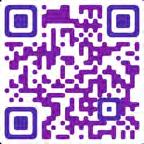
BZ: Would you share with us about your own journey to Integrative Medicine and how your life experiences brought you there?
detect when patients have somatic dysfunction with malalignment of their pelvis or spine. Though I have only modest training in muscle energy techniques I can often help with the few manual therapies that I have learned. Mostly what I do is act as a “jack of all trades, master of none” who can knowledgeably refer to others who have excellent skills in their field, and also be a bridge for patients, explaining why integrative therapies may be indicated for them.
The idea that patients should be restricted in their healthcare options or personal decision-making is absurd. The lack of open-mindedness in allopathic medicine regarding other treatment paradigms and modalities often, paradoxically, drives patients away from seeking the allopathic medical care they may need.

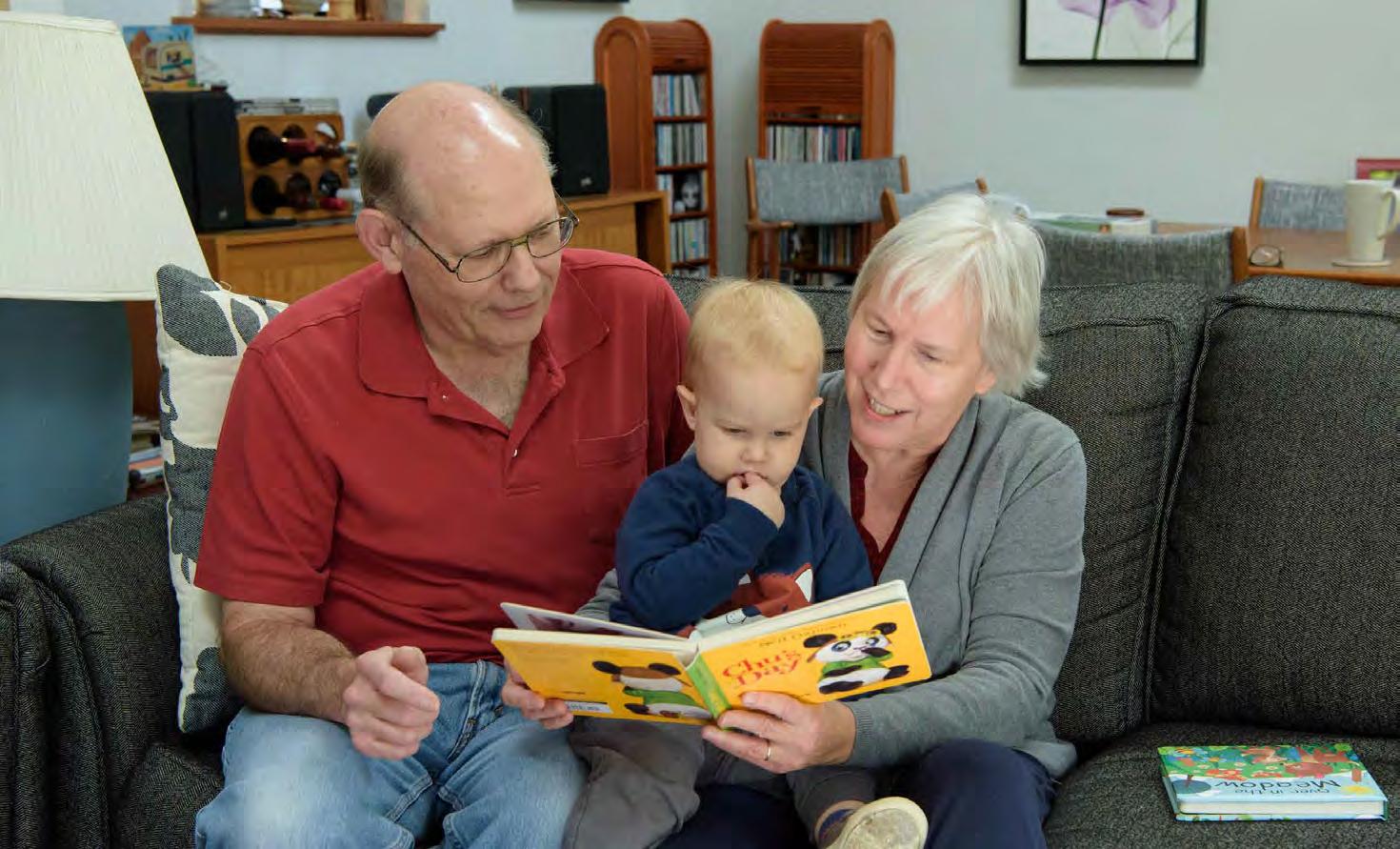
BZ: At a certain point, you left University of Michigan, and started up your own practice. Please tell us about that?

Dr. Amy Saunders: During my years working at University of Michigan, I learned a tremendous amount working in collaboration with specialists across many disciplines as well as my General Medicine colleagues. The steady salary and the support I got when I had my own health problems were tremendously helpful. But my practice style did not match theirs and I was regularly delinquent in my charting, so I was often in the doghouse. They took away my teaching assignments, which I loved, and did not really help me find solutions for my “dictation block.” I was told I had to leave after working there for 20 years because of my charting problems. I was given retirement, for which I was grateful. And in reality, I was immensely grateful that they pushed me out of that nest, because I don’t think I would have had the courage to do it on my own and truly it was the best thing that could have happened for my career and my life in general. It helped me become the kind of doctor I wanted to be, gave me the courage to embrace more fully a holistic approach to medicine and has allowed me to work with the amazing colleagues I work with today. I have a very good collaborative relationship with my U of M and IHA colleagues – but if I were still
working there, I would be unhappy. I worry that the current model of outpatient medical practice – profit-motivated, business-owned, practice algorithm driven, multi-physician employees – is taking us farther and farther away from quality primary care medicine. I think “corporate medicine” is a very apt and sad term for the direction healthcare is going. I rebel against that with every fiber of my being.
Integrative Healthcare providers was established in 2013. I am very happy with our practice philosophy and structure. Our practice provides for personal autonomy for our practitioners in decision-making about how we want our schedule to be – we are all part time – and how much time we feel is best to spend in patient visits. And, of course, we can make nontraditional treatment recommendations that are often just as important as providing the excellent allopathic model of primary care that we do. It also emphasizes the personal autonomy of our patients. In reality, medical care is just one component of each person’s self-care and our role as physicians is to be a consultant, making recommendations and joining the patient as a team to try to achieve the best health possible for them. The idea that patients should be restricted in their healthcare options or personal decision-making is absurd. The lack of openmindedness in allopathic medicine regarding other treatment paradigms and modalities often, paradoxically, drives patients away from seeking the allopathic medical care they may need.
The struggles I have had running a clinic are in large part what you might expect of any small business. My income is directly related to the number of people we see. The pandemic and the loss of two providers have been financial challenges. But my goal has not been to make as much money as possible and the financial hits have not had destructive effects on our clinic practice. I am lucky that I did not have to be the sole financial provider for my household during the leanest months. I am also lucky that my staff has been committed to staying with our clinic, and flexible throughout the pandemic. Training new staff takes a toll on small businesses, but turnover is lower when all members of a clinic know they are an important member of a team. As a primary care practice there are many ways that “corporate medicine” and government requirements for documentation make things difficult, as well. I am told frequently by my
academic colleagues that it is impossible to have a private practice these days and that all individual practices will soon be bought out by healthcare corporations. But I disagree. I also think that the potential for happiness in practicing medicine is greatest in private practice where we have the autonomy to shape our practices the way we want. The research bears this out, as burnout is lowest among physicians in private practice.
I went from feeling like one of the luckiest kids on the planet – I was the youngest of 6 kids in a family that felt secure, with siblings and two parents whom I adored - to having the rug pulled out from under me as family struggles occurred.
BZ: Earlier, you mentioned ‘family trauma history,’ and in the article that Rachel Urist wrote about you for Crazy Wisdom Journal in 2012, you shared some stories. As you look now, how has it impacted your life, and your life’s work? Please do share what you are comfortable with, and what you sense would be illuminating?
Dr. Saunders: I did have many traumatic events happen in my childhood and early adulthood. I went from feeling like one of the luckiest kids on the planet – I was the youngest of six kids in a family that felt secure, with siblings and two parents whom I adored - to having the rug pulled out from under me as family struggles occurred. My mother became mentally ill and then, refusing to take prescribed drugs for it, started drinking, I think to try to self-medicate her demons away. So, she became an alcoholic as well. Conflicts around her illness and poor choices started, and my father left. Then one by one my older siblings went off to college and rarely returned because it was too sad and unfixable. My siblings were my lifeline, and I felt their love, but I was very lonely and felt shame and grief that it has taken me years to acknowledge. I developed a pretty solid veneer, presenting myself in school and with friends as doing just fine.
As we grew into adulthood, my siblings and I lived far apart but remained close. My sister who was 5 years older was especially important in my life. We shared a double bed in a small bedroom until she left for college, and she was more a mother to me than our own for most of my childhood. She was loving, supportive, smart and an inspiration to me. She had polio at age 2 and had residual left arm weakness. She never mentioned it. She excelled in academics and playing the oboe. She became a lawyer and worked for the underserved. When she was diagnosed with advanced breast cancer late in her only pregnancy at age 38 it was devastating. I was in my General Medicine fellowship at the time. I wanted to fix it, brought her to Duke Medical Center for evaluation when I felt the treatment plan, she had was questionable. When metastatic disease was found, she underwent mastectomy and then bone marrow transplant immediately after her daughter was born. I was furious when one of my oncology colleagues said to me, “You know this is just a temporary solution, not a cure.” Hope is a powerful tool for healing, and I did not believe him.
She went through that, and through the depression and fear of having a young baby while unsure whether she would die soon. Then she recovered from the initial treatment and went about living, working, playing, and raising her daughter. She was in remission for 9 years before metastatic disease returned. Nine years when she had a beautiful relationship with her daughter and believed she was cured. She loved people, she appreciated the little miracles of life, rainbows, stories, nature. Then she faced the bad news of her cancer recurrence and further treatments with strength and grace. Then she dealt with the fact that the treatments were not working with the same attitude. She died at age 49.
That sense of needing to silence my own story led to my strong conviction that listening to each other’s stories is one of the most powerful healing tools that all of us have.
My brother was just under 2 years older than me, more a playmate than my other siblings. When we reached sixteen, we each started working at Bill Knapp’s restaurant. Part way through college he decided to stop schooling and moved to Palo Alto and became a chef/manager at a restaurant. He was an excellent cook. He decided to go back to school to become a physician after I went to medical school. I think my making it into med school helped him realize that he could do it, too, and that it was his calling. Initially he planned to work in some setting providing care for an underserved population. While in medical school, however, he started to have weakness in his legs. He was diagnosed with chronic progressive multiple sclerosis. He did his residency in Family Medicine, but before the second year was over, he needed a wheelchair. He was not able to do the clinical work of patient care, but he became a leader in the statewide Residents’ Union negotiations in California. Then he went to get a Master’s in Public Health Degree, thinking he could do work that focused on improving access to care. He was not able to work in a job, however, because his health just inexorably worsened. He NEVER complained but stayed involved with friends and the Quaker community. He accepted with grace the ever-increasing need for help from caregivers. He died of MS, also at age 49.
My sister’s capacity to not identify with her illness, and to not dwell on the possibility of a bad outcome, allowed her to focus on and enjoy the beauty in life even with a terminal illness. To the extent I can do that myself and encourage others to do the same, it helps to deal with the frustration of
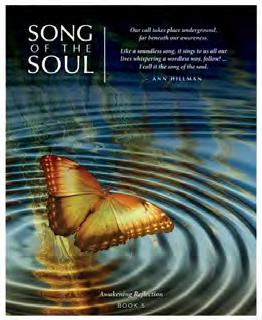


The Awakening Reflection Booklet Series was created by and for the Adrian Dominican Sisters to awaken themselves to the signs of our times and from a response to the needs of today’s world.

Who are We? Where are We Going? Who and Where is God in all of this? The material in this series draws from various writers in the fields of cosmology, science, theology, spirituality, ecology and poetry.

$15 plus shipping and handling for the entire collection
More information at webercenter.org/awakening-series
having a chronic illness. Similarly, my brother’s amazing capacity to accept his progressive disability and to “not feel cheated” by what life dealt him is an ongoing source of inspiration to me. I also learned the cliché lesson that bad things happen to good people and that illness is so often unrelated to ‘bad lifestyle choices.’ I have a hard time with people who assume their good health is due to their healthy life choices and they will be guaranteed to stay healthy for as long as they continue with those choices – I especially bristle at the commonly assumed corollary that people who are ill have somehow made lifestyle choices that led to their illness. I will admit to a reflexive anger at that attitude -- that I try to acknowledge in myself -- so it does not negatively impact my caregiving.
The things I learned from my siblings I often share with my patients. Sometimes I recognize it is not fair, as my siblings’ seemingly endless capacity to deal with hardship with grace is unrealistic to expect in people. But I so often see the same strength, resilience, faith, grace, and appreciation of life in my patients who face similarly dreadful diagnoses. In fact, I believe that having to face unwelcome news often strips away some of the simplistic assumptions we have about what our lives “should” be and leads us to reach down inside ourselves to find those reserves of strength and grace that we generally don’t know are there when life is coasting along fine. Two sayings I am apt to quote are “Old age is not for sissies” (because the older my patients get the more likely they are to have had to face these issues due to chronic pain or illness) and the Eleanor Roosevelt quote “women are like tea bags – you never know how strong they are until they get in hot water” -- of course that applies to men as well. I feel truly privileged to have an occupation where I am moved and inspired daily as I am able to witness my patients’ strength and grace, and to partner with them as they navigate the difficult waters of aging and illness.
BZ: And you, yourself, have faced illness and a chronic condition?

Dr. Amy Saunders: Yes. When I got cancer, I was twelve. It was the 60’s when my parents divorced and when I got cancer. Things were vastly different then, in my small hometown. Divorce was not discussed, mental illness was not discussed, cancer was not discussed. There was a strong unspoken message that it was inappropriate to talk about things like that. I remember my eighth grade English teacher called my dad after I chose to speak to the class about my hospital experience for an assignment. She felt it made the kids uncomfortable and asked him to tell me to not talk about it again – and I did not. So, I developed a thicker veneer and more loneliness. And, also, unfortunately, a bit of a martyr complex that it also took me decades to acknowledge. That sense of needing to silence my own story led to my strong conviction that listening to each other’s stories is one of the most powerful healing tools that all of us have.

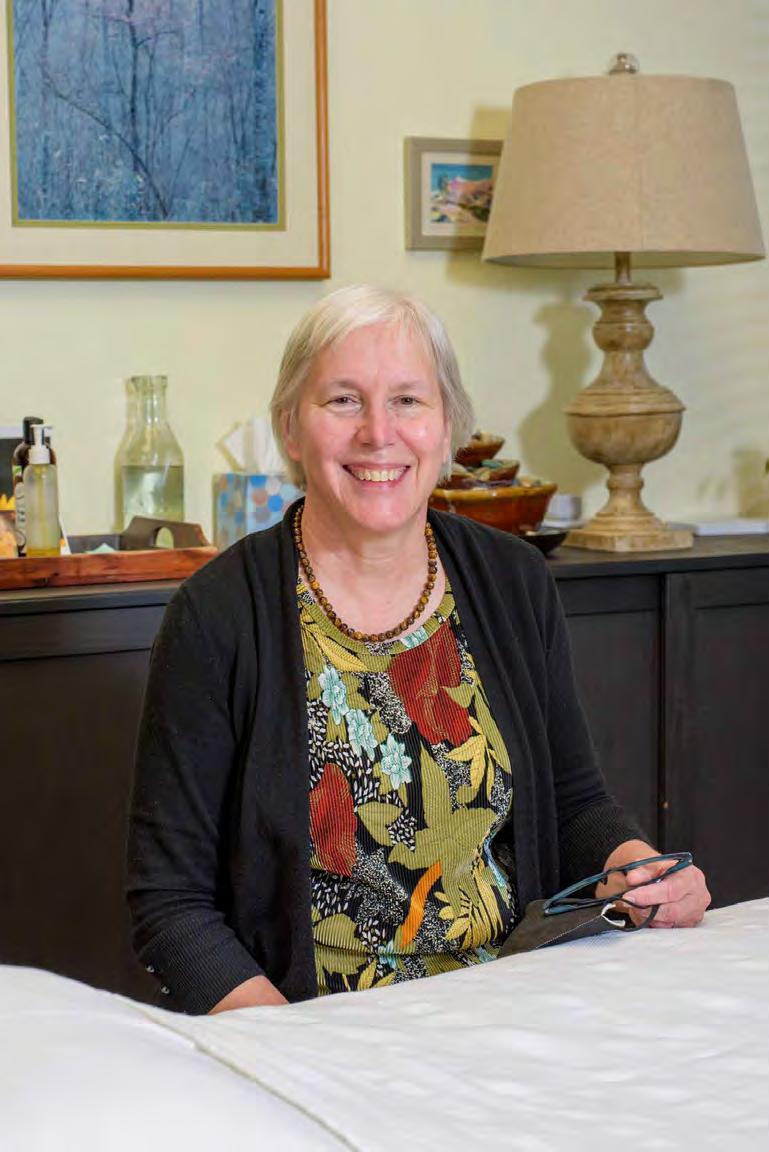
Dr. Amy Saunders: I admired my father immensely. He was gentle, smart, and seemed to really enjoy practicing medicine. I would sometimes go with him on rounds at the nursing home or at the clinic. I saw the kindness, warmth, and respect he showed to the staff and to the patients and I saw how they felt the same toward him. Though I never was in an exam room during one of his patient visits, I could tell when they spoke with him in the hallway or when we met them on the street that they felt well cared for. One of the few things that irritated him was when he felt someone was not being treated with respect. A friend and classmate of mine who is Black (an uncommon thing in my hometown, especially in the 60’s) said my dad was the only doctor in town who would make house calls to their house, and that her mother thought highly of him. It is important to me to show the same kind of warmth and respect to patients, staff, and colleagues as he did. He also exuded a sense of calmness as well as a caring demeanor and I aspire to have that calming effect, too, with my patients, though I don’t always achieve it.
When I got cancer, I was 12. It was the 60’s when my parents divorced and when I got cancer. Things were vastly different then, in my small hometown. Divorce was not discussed, mental illness was not discussed, cancer was not discussed.



When I was in the hospital for my cancer surgery, it was the first time I witnessed that strength and the change in perspective that I mentioned that happens when one faces serious illness. I saw it in other kids with cancer in the process of dealing with their illness – and I saw it in me, too. That finding a depth of meaning in life and a recognition of one’s inner resources. I saw it in the doctors and nurses in the hospital, too – they were dealing with grave issues on a daily basis. Both they and the patients were inspiring to me. I think that, as much as my experiences with my dad and his work, were the reasons I decided I wanted to be a caregiver when I grew up.
When I got M.S. at age 38 it was another devastating blow. Having witnessed my brother’s rapid decline and understanding the medical facts of the disease, I was afraid – much more so than when I found I had cancer. (I was too naive at that time to know to be scared.) The journey of trying to find a sense of peace of mind when facing a potentially debilitating disease has been the most important work of my life. I have had a mild course of the disease so different from my brother’s. And, honestly, I cannot credit anything other than good luck as the reason for my mild disease. That has taught me that not just dreadful things happen for no reason, but good things do, too. The importance of recognizing that luck is a major factor in our health is something that I try to convey to patients and students, alike: we do not control as much as we think we do.
Dr. Amy Saunders: My medical training was very Old School in that there was an expectation that once we got on the wards we were basically fully employed as caregivers. By that, I mean feeling a sense of responsibility to our patients – we did not feel like “just learners” at that stage. The teaching was that you never leave the hospital until your patients are stable. That commitment became even more explicit in internship and residency. In a very real sense, it was brutal because the hours were ridiculous. The culture of extreme hard work in clinical medicine was deeply imbedded at Ohio State, where many of our attending physicians would talk about how things were even harder back in their day –‘the days of the giants’, they would say. While I don’t support that expectation of that kind of overwork at all, I do think there is a benefit to be gained from the immersive experience of intense clinical training. The transition from learner to a physician who feels prepared to make life or death decisions for other people involves not just knowledge but a change in self-image. As a resident we would see the transition happening among the interns often more clearly than we saw it in ourselves. Fortunately, the house staff culture was incredibly supportive, and we all felt like we were in it together. I notice that I am using a lot of expressions that could apply to military or team sports training and there are parallels. I hope with current med school and residency training programs with more reasonable, defined hours and utilization of hospitalists, that there is still an intensive, immersive clinical experience that allows for that internal transition. In this way, it is like any other profession – people we depend on to have deep knowledge about their specialties and a deep commitment to provide top quality work in their careers, as well.
When I got M.S. at age 38 it was another devastating blow… The journey of trying to find a sense of peace of mind when facing a potentially debilitating disease has been the most important work of my life. I have had a mild course of the disease so different from my brother’s. And, honestly, I cannot credit anything other than good luck as the reason for my mild disease. That has taught me that not just bad things happen for no reason, but good things do, too.
BZ: I know you also wanted to express your thoughts about the Affordable Care Act?
Dr. Amy Saunders: Lastly, about the Affordable Care Act. I have always been a supporter of a single payer, not for profit healthcare system. But a wellregulated private insurance structure as they have in the Netherlands, where everyone is covered and per person costs are controlled and subsidized as
BZ: I know that your father was a physician. What influence did he have on you?
needed is also a good design. The ACA intended to have that structure, and I am still a staunch supporter, as millions of people in the US have health insurance that they did not have before. The structure in the US, sadly, is extremely flawed, but I put the blame for that squarely on the Republican Congress who sabotaged it by stripping away the financing as well as the quality assurance components that were in the original bill. Without a modest penalty for those who do not opt in, and without restrictions on health insurance companies on how high they could raise their premiums and deductibles, then it was certainly bound to hit the “already insured” the hardest. Insurance companies are making higher profits than ever - because they are ripping off us consumers and falsely saying the blame is on the ACA. They also should not be allowed to charge high premiums while their cheaper plans have pitiful coverage, and their deductibles are so high that many people never see any benefit. If Congress can continue to rein in insurance and pharmaceutical companies with appropriate regulations on their costs, then the benefit of the ACA may become more appreciated. People who ONLY look at their own pocketbook are ignoring the fact that this has been a lifesaver for so many.
BZ: I understand you became a grandparent not so long ago. How is that going, what are you relishing, what are you noticing?
Dr. Amy Saunders: It sounds so cliche but getting to be a grandparent is one of the greatest joys of my life. I cannot believe I am lucky enough to have my daughter and her family living in Ann Arbor and get to spend time regularly with Ellis. I love the bond we have built. As a grandma, the experience of hanging out together is just less weighty than I often felt as a parent. The silly things are sillier. The worries are less worrisome, the watching him change and learn every day is more delightful. And the other thing that has been an extraordinary joy is to get to see my daughter being a loving mom and my son-in-law be a loving dad. The gift of getting to be an extended family -with my husband, my other daughter, my siblings, my son-in-law’s family all connected- is somehow clearer and more meaningful since my grandchild, a new generation, has arrived.
BZ: What do you love to do in your spare time in the winter, in Ann Arbor and southeastern Michigan?
Dr. Amy Saunders: I enjoy wintertime and the crispness of the air, the smell of the cold. I even find the evening darkness enjoyable especially when there is snow for the lights to reflect off of. During the pandemic we learned how much we enjoy winter walks in the woods. With small woods near us like Scio Woods, Greenview Woods, and meadow, Eberwhite, etc., we have become fairly regular walkers and I love watching and photographing the change of seasons- and winding up at a coffee shop afterwards for a latte. I don’t very often see wildlife during the summer, so it is kind of a kick to see SO many different animal prints in the snow at Scio Woods.
My family and I are great game lover, too, so we often enjoy getting together for dinner, wine, and games.
BZ: Anything else you would like to add?
Dr. Saunders: I would also like to say that I have always felt like I have the best job in the world as a primary care physician. Every day I get to be inspired and learn from and laugh with my patients - at the same time as we deal with a wide variety of health issues that have deep meaning and relevance to each person’s quality of life.

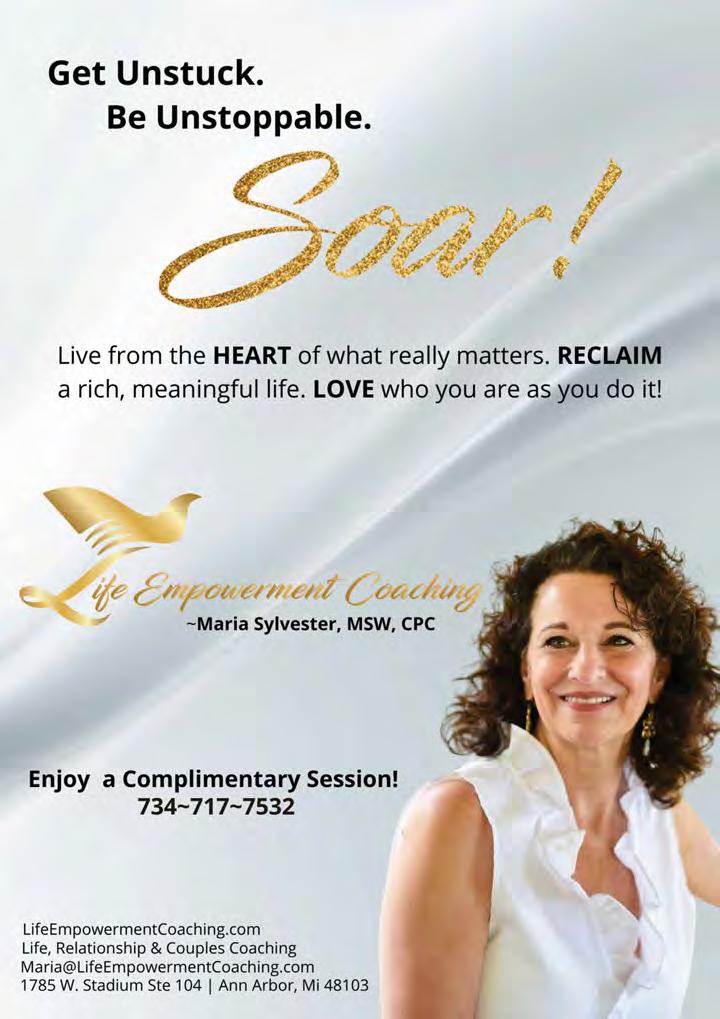
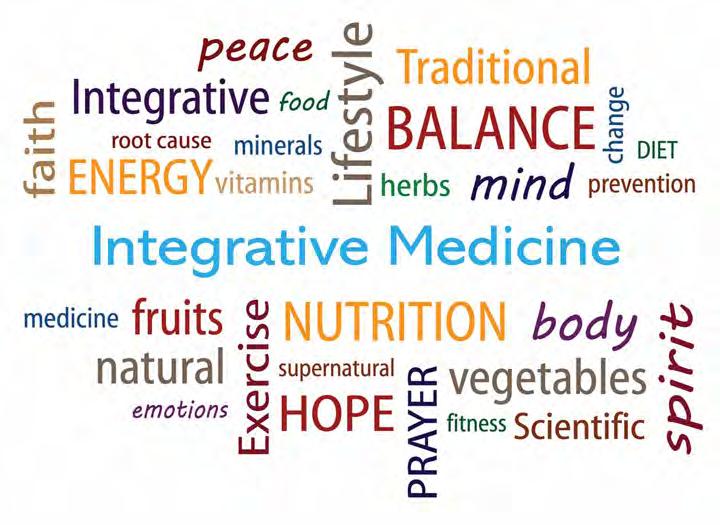

BZ: Thank you!


 and Photos by Grace Pernecky
and Photos by Grace Pernecky
Barb Scholz is a leading energy medicine practitioner in this region, highly respected by other energy medicine practitioners, and deeply valued by her clients. Born in Lansing, she moved to Ann Arbor when she was 14 years old and has stayed here ever since. She refers to herself as a Modality Museum, and rightly so. Over the course of her life, she has practiced and become immersed in yoga, aromatherapy, essential oils, homeopathy, craniosacral therapy, massage therapy, acupuncture, energy medicine using Donna Eden’s method, and more.
For over 20 years, she’s been an Energy Medicine practitioner. She studied with Donna Eden herself back in the late 90s and early 2000s, before a certification program existed. (Energy Medicine is a modality of healing developed by Donna Eden that incorporates techniques from yoga, acupuncture, kinesiology, qi gong, and those developed by Donna herself.)
Scholz says, “It’s kind of like acupuncture, but you use your hands instead of needles to work with the energy.”
As one of the first teachers of the Eden Energy Method (EEM) program, Scholz has acted as student, teacher, and practitioner. Since the initiation of the EEM program, she has been involved in its evolution into a rigorous and instructive four-year course in which students learn fundamental skills about working with energy and can eventually become certified, skilled practitioners themselves. Scholz has served as a guide to help others heal, and her practice is full and thriving. She serves as a practitioner at her cozy home near Argo Canoe Livery and the Huron River. She spends much of her free time tending to her biodynamic garden which she has cultivated for over 45 years.
Grace Pernecky: Let’s start at the beginning. Where were you born and raised? What sorts of occupations did your parents have? Where do you live now?
Barb Scholz: I was born in Lansing, Michigan. I lived there for the first 14 years of my life, and at age 14, we moved to Ann Arbor. It's been my home ever since. I went to Slauson, Pioneer, and then to the University of Michigan.
My dad is a mechanical engineer and self-taught electrical engineer. He still plays with his computers at age 99! When I was growing up my mom didn’t work, but she did bookkeeping before she had kids. Then, she did the bookkeeping for my dad’s business when my siblings and I had grown up.
I’ve lived in this house for 46 years. I love this place. My sister owned it before I did and sold it to me when she went away to college.
Grace Pernecky: What is your earliest memory of having thoughts of pursuing a career in healing?
Barb Scholz: It was kind of an odd journey. I was really interested in going into science and math. So, I got my degree in mathematics from U of M. But in high school, I began reading about alternative healing. In my early 20s, I started taking every workshop I could on various forms of bodywork. During my 20s and 30s, I was always studying something or taking workshops: yoga, homeopathy, Chinese medicine, herbal medicine, ayurvedic medicine, craniosacral therapy, massage therapy, polarity therapy, aromatherapy and more.
When I was 47, in 1997, I was diagnosed with optic neuritis, which involved inexplicably losing sight in both of my eyes for six weeks. The doctors told me within two years, 50% of people with this condition get MS, which shocked the heck out of me. That started me on a journey of searching far and wide for alternative health treatments because I already knew what standard medical care was going to advise.
Through a series of serendipitous events, and after months of searching for alternative treatments, I found out about Donna Eden and Energy Medicine and immediately felt drawn to it.

GP: Why did you feel drawn to this particular modality? And how did you go from student to practitioner?
BS: Donna’s story is that she had MS and cured herself. When I learned this, I knew that she would be my teacher. I signed up for every workshop she taught. Her methodology and her techniques are so focused on self-care, which was very different from the model I’d been working within where people would work on me, and I would have to wait till the next session. During that wait period, I would start to fall apart. To have someone teach me things that I could do for myself was a game changer.
Going back to my childhood, I was always a sensitive kid. I felt and sensed things that were not what other people were sensing and feeling… vibrations, tingling, etc. We all have a perceptual system, and we think that we are alike—we are so not alike!”
I became a very devoted practitioner of self-care, and I started to improve. It was this slow rebuilding of my immune system’s response by way of correcting imbalances in my energy field that brought me back to wellness. It was transformational.
Over the course of a few years, entirely by word-of-mouth, I started teaching and then working on people myself. I loved to teach and share, but I was not really going to “work” on people. I was quite resistant to the idea of becoming a practitioner and having a business. I already had a full-time job as a medical
“Donna’s story is that she had MS and cured herself. When I learned this, I knew that she would be my teacher.”
— Barb Scholz
software developer and project manager. Starting a practice of seeing people did not seem realistic.
I was practicing meditation daily at that point. I kept getting messages that I was to start an energy medicine practice. I would argue with this guidance. Then, during one meditation, I saw an image of a donkey stubbornly sitting down, resisting the pull of a rope by one of my guides. I was like, “okay, I get it, I get it!” Before I knew it, I had quit my job in the software engineering world and had started my own practice. At that point, there was no Eden Energy Medicine certification program, so I was learning from the book, from the workshops, and from experience. And people were coming for sessions.
GP: What are some examples of conditions/ailments you’ve worked with as an energy medicine practitioner? What have you learned about energy through them? What becomes possible when you work with energy that’s different from other modalities?
BS: Even towards the beginning, my clients started having these healings that were absolutely amazing. For example, one of my clients had an autoimmune illness. Her liver numbers were in trouble, and she was told to come off her medication. She was told that the next thing to try was chemotherapy—she didn’t want to do that. She contacted me. I did not claim that I could correct her liver numbers, but we agreed to try the experiment to see if working with her energies might help. So, we just started using energy testing and doing the techniques that were indicated to rebalance her energies.
Every now and then I’d email Donna and say, “Donna, what do I do?” We didn’t have an energy medicine program at that point, and I was just working from her book. She sent me a little protocol, which is now called Advanced Substance Testing, to find out which of my client’s medications was throwing her off balance, and we’d rebalance her so that her medications could work for her, and not bother her liver.
My client had been given six weeks to try and make a difference before they put her on chemotherapy. Within those six weeks, her liver numbers had stabilized, and her doctor just said, “Keep on doing whatever you’re doing.” About three weeks later, her doctor canceled the order for chemotherapy because her liver numbers were improving.
This work isn’t a panacea. It isn’t always a miracle. But it has brought this client a baseline of health, wellbeing, and longevity that is beyond what she thought possible. Yes, she still has ups and downs, there’s no question about that, but her continued work with energy medicine has given her a different baseline of health. That made it clear to me that this work is kind of a huge deal. Beyond stress relief and general wellbeing, it allows something in you to find a balance around which healing emerges. We still have the genetics we have; we still have the biochemistry we have. We still have to look at our food. We still have to look at our sleep—you know, the basic lifestyle issues. But we often forget that our energy field is one of these issues—something that needs daily grooming, a part of our daily hygiene.
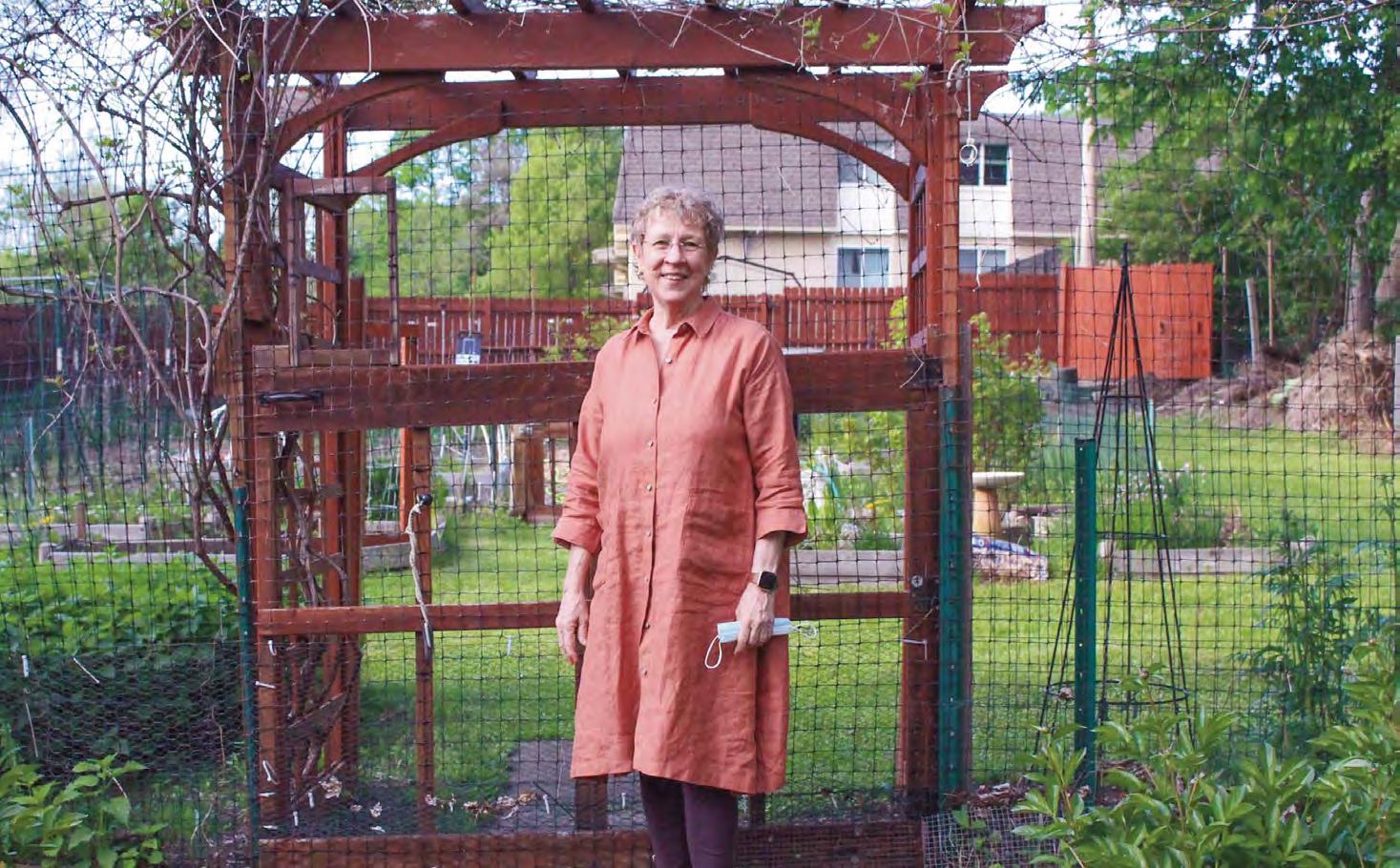
a series of serendipitous events, and after months of searching for alternative treatments, I found out about Donna Eden and Energy Medicine and immediately felt drawn to it.”
Cathleen Guldan— Eden Energy Medicine Clinical Practitioner (860) 417-9833, St. Joseph, MI, USA
Payge Hodapp— Eden Energy Medicine Clinical Practitioner (517) 263-3789, Adrian, MI, USA


Chris Modrack— Eden Energy Medicine Certified Practitioner (248) 514-6165, Farmington, MI, USA
Caryn Shapiro
Eden Energy Medicine Clinical Practitioner (734) 645-2209, Ann Arbor, MI, USA
Gretchen Van Loozen Eden Energy Medicine Advanced Practitioner (231) 537-2811, Levering, MI, USA
Amy Wellein— Eden Energy Medicine Clinical Practitioner (248) 203-7744, Bloomfield Hills, MI, USA
Barb Scholz can be reached at: bscholz@comcast.net. She is not taking any new clients, so please reach out to the Eden Energy Practitioners noted above.
“We still have the genetics we have; we still have the biochemistry we have. We still have to look at our food. We still have to look at our sleep—you know, the basic lifestyle issues. But we often forget that our energy field is one of these issues— something that needs daily grooming, a part of our daily hygiene.”
— Barb Scholz
“Through
— Barb Scholz

GP: How does the model of working with energies differ from other modalities of healing?

BS: Everybody is incredibly unique, and yet, we’re all made of the same energies. Those energies are undulating and dancing in ways that are unique to us and responsive to our lived life. A lot of times, when I’m teaching practitioners how to work on people, they think of the energies in terms of cause and effect and static.
We have to get out of that mode—it serves us well in physics, chemistry, and a lot of other science training that we might have had, but for energy work, we must move into a model that is highly responsive and adaptive. This means that you can interact with an energy on one person and get a totally different response than the last person you worked on. You have to really feel your way through not only what you are doing, but how the person is responding and follow those responses.
“My client had been given six weeks to try and make a difference before they put her on chemotherapy.
Within those six weeks, her liver numbers had stabilized, and her doctor just said, ‘Keep on doing whatever you’re doing.’”
GP: There’s this tendency within our society to think that Eastern medicine and Western medicine don’t go together. But very early on, you seemed to have this understanding/intuition that these things can be very valuable, depending on context. How did you come to understand this?
BS: Going back to my childhood, I was always a sensitive kid. I felt and sensed things that were not what other people were sensing and feeling… vibrations, tingling, etc. We all have a perceptual system, and we think that we are alike— we are so not alike!
Early in my twenties, I started doing yoga, and I had more sensations that I didn’t understand. So, I started reading more literature on yoga, and then went to a yoga class. I began to understand what was happening to me was just a natural expansion of my perceptions. That set me off in the direction of working with stuff I was perceiving.
These things aren’t explained in the scientific model. But if you’re a good empirical scientist, you don’t throw away data. You go, “Even though I can’t explain it that doesn’t mean it doesn’t exist. Even though I don’t understand it, that doesn’t mean that it isn’t worth exploring, to see if I can begin to understand it differently.”
A really open, curious mind is the foundation for science, for working with subtle energies, and for a fulfilling life. It is the bridge that joins western and nonwestern medicine, in my humble opinion.
GP: We talked a lot about energy medicine as being this foundational thing for you that has solved a lot of problems and has provided a lot of insights, but I’m wondering about some of the other modalities that you practice. Do you feel, as a whole, there’s one modality you tend to use more than others, or do you tend to see them as tools in the toolbox?
BS: I have several other modalities that we haven’t discussed. I tend to be a bit of a Modality Museum. But I think the one that is absolutely significant is lifestyle. Basic lifestyle choices is where traditional Chinese medicine focuses first, and I think that’s wise. I find that the energy medicine world of Donna Eden is a great tool here, because there are so many self-care techniques in it. Most of these techniques take between 30 seconds and a minute. And while seemingly simple, they are surprisingly beneficial.
For me, energy medicine is foundational for self-care. Most people think that they have to wait to get back to balance. Some people think, “I can hardly wait to go home and have a drink.” Or, “I can hardly wait to go to bed tonight.” All these things can certainly shift the balance. But it’s so much easier and quicker to do 15 seconds of energy work and have the balance come in at that moment. The gift of Donna Eden’s energy medicine is that you don’t have to wait for a practitioner: you don’t have to wait for sleep. you don’t have to wait for a hot bath at night. You don’t have to wait till you get out of a situation,.You can be in a situation and start finding a better balance by doing some simple energy exercises, which most often go unnoticed by others.
When you are not feeling well, when you are going through an illness especially one that doesn’t have a solution yet, anything you can do that makes you feel better is a point of empowerment because an illness makes us feel very disempowered. We do not know what’s going on with us. We feel like we need someone to help us, and we need someone to fix it. And these are very disempowered places to have to stay for any length of time. These feelings and thoughts may have some truth in them, but as much empowerment as you can
— Barb Scholz
“Beyond stress relief and general wellbeing, it allows something in you to find a balance around which healing emerges.”
— Barb Scholz
“Surprisingly simple corrections, done daily, make a big difference over time.”
— Barb Scholzgive to someone, especially when they aren’t feeling well, makes them internally more resilient. Surprisingly simple corrections, done daily, make a big difference over time.
That whole view of our health being just our physical body is an incomplete model. Our health is also our sense of who we are in the world, and that includes, do we have agency?; Do we have the ability to change our life? And the answer isn’t “no” all the time. The answer isn’t “yes” all the time. But the more we can add self-care, self-improvement, and self-guidance, the more health we can bring to that moment.
GP: What do your sessions look like? What can people expect?
BS: My practice is currently full. I don’t want to stimulate a lot of desire without giving people pathways to experience Eden Energy Medicine. There are several practitioners in the Ann Arbor area, but regionally, there are even more I have trained, mentored, and supported.



Check out Donna Eden’s website—you can find contact certified practitioners there (practitioner.edenmethod.com). Some of the people listed there, whom I have taught, mentored, and worked with directly are Payge Hodapp, Amy Wellein, Denise Wanty, Caryn Shapiro, Gretchen Van Loozen, Betsy Lehman, Chris Modrack, Cathleen Guldan, and Mary Ann Wilkens. I can highly recommend these practitioners and many more. There are several excellent practitioners in the Lansing area, but I have not gotten their permission to list their names in this interview.

Every session has a shape. You learn to follow the shape of a session. This allows the person to gradually open up, make a transformation, and then be able to integrate and ground that transformation.
“The gift of Donna Eden’s energy medicine is that you don’t have to wait for a practitioner, you don’t have to wait for sleep, you don’t have to wait for a hot bath at night, you don’t have to wait till you get out of a situation, you can be in a situation and start finding a better balance by doing some simple energy exercises, which most often go unnoticed by others.”
— Barb ScholzIt can be hard to describe energy medicine because it’s not like a lot of things people have experienced. My quick thumbnail sketch of it is that “it’s a little bit like acupuncture, but I don’t use needles, I use my hands to move the energy.” It works with the body’s energy field, but you can feel the physical effects of that change, that shift. There is a really tight connection to how our body feels as a physical experience and the state of our energies.
A client has pain, discomfort, a sensation that is entirely physical, and I work on an energy that is related to it. When the energies go to balance, the pain or discomfort often goes away. You have to shift from thinking, “How do I make this symptom go away?” to “What energy pathways are involved here and how might they be influencing this person’s physical, mental, and emotional condition?”
GP: Could you talk about some of the challenges you’ve experienced as a practitioner?
BS: One of the great things about this work is that you really can’t plan what to do. You have to be responsive to what’s going on for your client. You start by energy testing and seeing what’s out of balance—you can look on Donna Eden’s website or go to YouTube to see what this looks like—and that process starts to form a picture for you.
The other thing that helps is the words a client uses to describe their symptoms. I like to have people actually tell me their history and what’s going on so that I can hear the words they choose, the tone of their voice, the emphasis they make—how they describe it has energy signatures on it. How we talk is a manifestation of our energies. If I were to shout at you, or be very quiet, you would have a different sense of where my energy is at. And if I were to start to cry when I described something versus giggling or laughing, you would have a different sense of the energies involved in that issue. I like to get that descriptive part, that energy picture part, and start to put together what feels like the doorway to the session, and then start to move through it.
GP: Miracles: have there been any?
BS: I once had a client who had adopted kids, given up all the baby equipment, was in her 40s, and came in because she was having allergies and stomach troubles. I was following the energies and making corrections accordingly.
After several sessions, she called me and told me she was pregnant. She hadn’t been doing anything new except for the energy medicine. They ended up with this lovely baby. And I had the privilege of doing energy work on the mom while she was delivering. It was incredible.
Energy work is powerful stuff. Yet it is gentle. Is there a guarantee that it’s going to help with fertility? The answer is no. But does it set up the possibility that something could happen? The answer is definitely yes. We all have lots and lots of potential. Sometimes, what blocks us from reaching that potential is that there are imbalances in our system. They can be mental, emotional, physical, and energetic. But if you fix the energy piece and allow for more flow and balance, you never know what becomes possible.
“These things aren’t explained in the scientific model. But if you’re a good empirical scientist, you don’t throw away data. You go, “Even though I can’t explain it that doesn’t mean it doesn’t exist. Even though I don’t understand it, that doesn’t mean that it isn’t worth exploring, to see if I can begin to understand it differently.”
— Barb ScholzWhen people come in and tell me, “Doctors have told me that this is impossible,” all I can say is, “We’ll see.”
From their understanding, that’s accurate. But from my understanding and experience, I don’t believe in “never” and “always” and limitations that are so absolute. As long as you’ve got all your parts, we can do energy work and see how we respond. The wisdom of your system will take that imbalance and do what’s right for you.
GP: Thank you so much for chatting with me, Barb, what an amazing conversation. Any final thoughts or wisdoms?
BS: I want to say something about the word “healer” to me. I am a practitioner, not a healer. There is something wrong with the idea of “being a healer” to me. As I’ve practiced and worked on people, I’ve had this profound realization that I am not the healer. It is them that is doing the healing. I’m the one who’s assisting balances--sort of like a midwife. I am not the baby, and I am not the mother. A midwife just supports their process. I am assisting my client’s process. I am a practitioner, and I have experience: I can assist. But the actual healing process is always inside that person. I love energy testing because it lets me have a “conversation” with that inner process.
I have such profound awe and respect for the healer that lives in every single one of us. And that’s who I am interacting with through my hands, but I am not the healer. I am the healer of my own body, I am the healer of my own kingdom, as they say in Chinese medicine. You also have a kingdom that you’re the healer of. Every person has to ignite the truth that they are a healer. That’s why I love self-care techniques because they start to train and empower and encourage the awareness that you are your own healer.
The whole question of, “Why do we show up on the planet?” which is a huge topic, is to get to know this self. And if we’re always looking to the outside, we’re staying in this mode that says, “I don’t know myself.” I really believe that energy work starts to ignite the fire and the understanding that “there’s something within me that knows so much more than what I’m aware of—maybe I’d better listen to it.”
The Crazy Wisdom Community Journal asked a number of leaders in southeastern Michigan’s conscious living community to reflect upon times in their lives that they’ve left their comfot zones to venture out in new ways. In the distant past or much more recently, we asked, what did you do, what inspired you, did it change you, inside or outside, big or little? Did you attend a new class, take an adventurous trip, go skydiving, stretch beyond a long entrenched boundary, start a new relationsip or end an old one, take a leap, retire, join the Peace Corps, go on a night trek in the wilderness, or just do something way out of the ordinary?
Lauren Crane is a retired advertising creative director, author, and singer/songwriter who offers often preposterous, sporadically serious, ever curious entertainment (and writing). You can learn more about her and her work on her website, laurencrane.com.
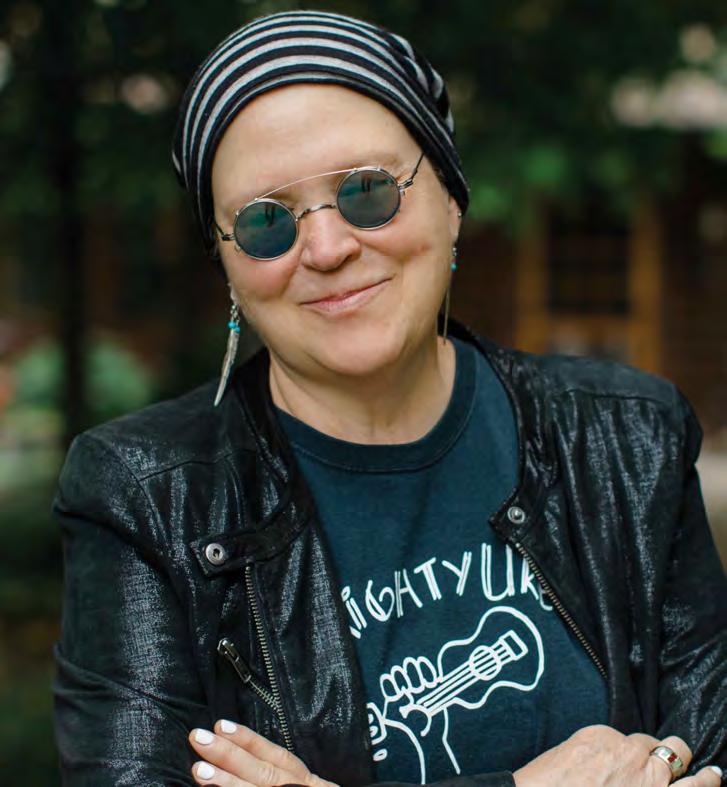
I look at a comfort zone like a backyard garden. Plant seeds—let’s say tomato— in rich soil and they’ll grow in fat and juicy abundance. Really cool, you say, this will be my tomato patch forevermore. Not so fast. If you keep planting the same crop in the same plot season after season, you’ll deplete the soil and, sadly, your bushel basket will be bare. But throw in parsnips the next year, plug in peas the year after that, and you’ll keep the soil balanced and fertile, ready for the next good thing. I’ll stop pretending that I have a green thumb and get to the point of this metaphor.
We all have seeds inside of us that want to grow—it’s part of being human— and if we expect to grow, we’ve got to keep changing things up. Trying new things. Taking chances.
That’s where my motto, Dare to be Stupid! comes in.
When I say, I dare to be stupid, I am not talking about walking around with a death wish, which for me, would be something like running with the bulls, volcano boarding, or wearing spike heels. Those things would not only be ridiculous for me, but also, I’d likely break my neck.
We all have seeds inside of us that want to grow—it’s part of being human—and if we expect to grow, we’ve got to keep changing things up. Trying new things. Taking chances.
No, I created that motto long ago to allay one of my childhood fears: being made fun of (I’m embarrassed to even admit that). I’m betting I’m not alone in carrying that angst though—it tends to sit in the back of many a psychic fridge long past its proper expiration date. I still catch a good whiff of it more often than I’d like, but still, I charge blindly into the abyss, daring to be stupid. On purpose. By which I mean, I am willing to look like a fool or an amateur. To wear a post-it note on my forehead that reads, I have no idea what I’m doing. Make mistakes in public. Or worse, be LOUD!
I took one of my biggest forays into the spotlight, literally, some time in my midfifties. I decided to pick up an instrument, write and sing my own songs, join a songwriter’s group, and perform in front of people. My fingers bumbled against strings, I shook, I had no idea if I could carry a tune. Surrounded by creative, experienced, astoundingly gifted guitar-playing singer-songwriters, I felt like a loser. I used to leave the stage and find a place to cry. Yet, I persisted.

In great part because those very people acted the opposite of what I feared— they encouraged me. When I took my music out into the world, some people may have been rolling their eyes—actually, a couple made it clear that I had no business doing this at all. Oh, look, my greatest fear has been realized and here I am, still standing in front of a mic, mouth open, instrument in hand.
Truthfully, the singer/songwriter thing was something I had to do. It wasn’t a lifelong dream or anything, but rather intel I stumbled upon inside myself. I had a head full of lyrics that wouldn’t sit still. They kept acting up until I said, okay, okay, enough already. Now, a decade later, I have no trouble picking up my ukulele and playing for people anywhere. I put out a cd of my music in 2020. I’m no musical genius, but I bring all I’ve got, and I have something in my life that I love to do.
Surrounded by creative, experienced, astoundingly gifted guitar-playing singer-songwriters, I felt like a loser.
I used to leave the stage and find a


to cry. Yet, I persisted.

I’m betting I’m not alone in carrying that angst though—it tends to sit in the back of many a psychic fridge long past its proper expiration date.
place
There’s nothing worse for a comfort zone than those pesky ideas that we all have. Dang it! Leave me alone, you unfulfilled desires! Can’t you see I’m fine here with my blankie and binky?

I had this book I wanted to write. I spent 20 years writing, rewriting, shoving it into a drawer for years at a time, rediscovering it, laughing because I did not remember what I wrote the previous time, rewriting it again, putting it aside again, picking it up again, doubting it and stalling. Like those lyrics though, it would not let me leave it alone. So, in 2017 I finally pushed forward and self-published The Square Donut Self-published? Won’t people assume that it’s no good if it’s self-published? Hello fear. I had to remain steady and confident. It was the route I wanted to go. I had a friend design the cover, and another create a little donut graphics. It had the right look and feel. I published the book that I wanted to publish. There’s no…and then it spent 24 weeks on the New York Times best-selling list story that follows. Simply a, I made that thing I had in my head real, did the work I wanted to do, the way I wanted it done, and I’m proud of it, story. A I conquered fear of judgement and unleashed my art into the world story—a step out of my comfort zone and into joy, story. I am happy with my book—and readers tell me that they are, too.
Making hard choices. Embracing the struggle. Stretching our awesome suit. Not hiding or ignoring our gifts, but fiercely fighting to find them, make them real, and share those gifts with each other.
Becoming a singer/songwriter and an author are stories about tossing a monkey wrench into the Why Do Anything When I Can Just Sit Here machine. Quitting the crappy, low paying job I had in my early twenties, selling my rusty Ford Pinto, taking my side-job earnings as a Tupperware lady, and showing up at Michigan State with just enough money to get me through one semester, was sliding my last nickel into the slot marked Take a Chance for a Better Life. A recent decision that has me treading water in a deep lake of discomfort as I figure out which direction to swim has become a saga entitled, “Okay, Now What?”
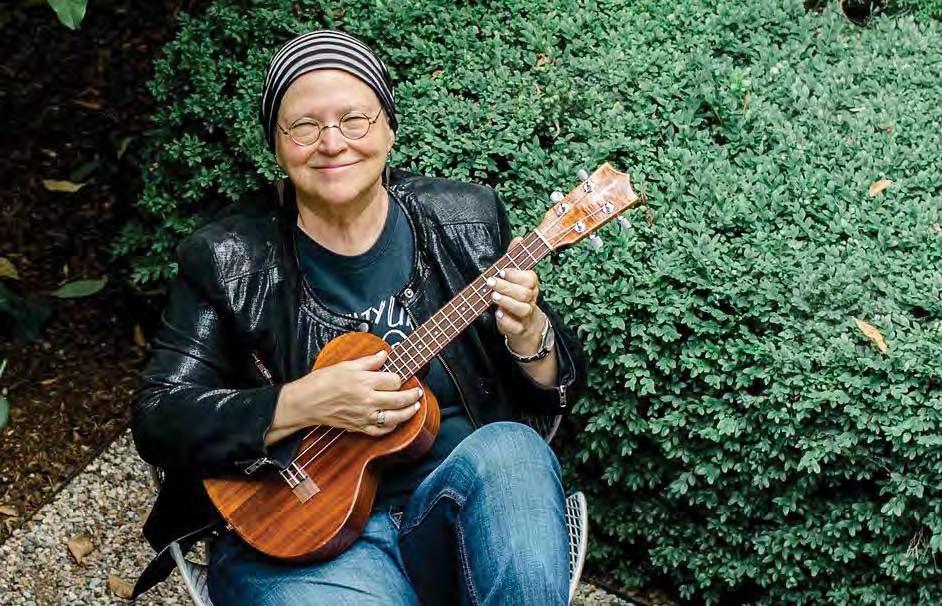


It’s been a persistent battle—this stepping out of the comfort zone thing. This rotating the crops to realize abundance thing. This growing thing. I’ve edited my motto from Dare to be Stupid to the kinder, more accurate, more likable to me, Dare to Be.

Isn’t that what it’s all about? For you, for me, for everyone who wants the richest, fullest life that we are capable of living? Making hard choices. Embracing the struggle. Stretching our awesome suit. Not hiding or ignoring our gifts, but fiercely fighting to find them, make them real, and share those gifts with each other. There’s a prereq for that: it requires leaving comfort zones in the dust while making a beeline for grow zones, daring ourselves to be, to bud, to sprout, to burst forth, so that we may enjoy the full harvest of our tomato, parsnip, and pea selves.
Until it’s time to plow and plant again.
This assignment stumped me at first. To begin with, dear Crazy Wisdom, which self are you hoping to hear from? Me as singer, music facilitator, filmmaker, spiritual practitioner, business owner, or merely human being?
And…hm, am I ever really in my comfort zone? Truth be told, I feel like I’m slightly outside of it, always placing myself into modestly uncomfortable situations, often and seemingly on purpose. Like David Whyte writes:
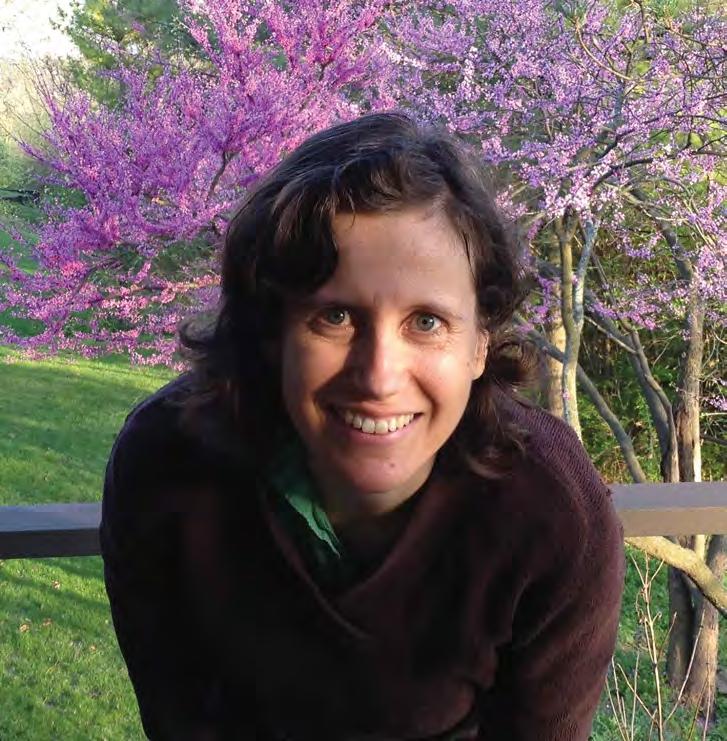
“Just beyond yourself.
It’s where you need to be.
Half a step into self-forgetting and the rest restored by what you’ll meet.”
Frankly, this does not seem like a recipe for inner peace. My new thing, for the record, is learning how to embrace my comfort zone and to grow from inner joy rather than displacement.
Am I ever really in my comfort zone? Truth be told, I feel like I’m slightly outside of it, always placing myself into modestly uncomfortable situations, often and seemingly on purpose.
So, what to write about here? Perhaps it’s not the small discomforts I have chosen willingly, but the life-altering ones that chose me.
Let’s talk about owning a small business and what was to become the hardest thing I’ve ever done in my life and probably ever will.
Yes, my husband and I own RoosRoast, Ann Arbor’s deep local, art-business project, involving coffee and all the beautiful people who drink coffee. (Turns out, this is a lot of people.)
RoosRoast is John’s baby, really. I have birthed Jozo, our son, as well as numerous songs, music, and film projects, but he birthed RoosRoast from the sheer tenacity,boldness, and joyful hunger that burns inside him. I got on board the project in 2008, as an adoptive parent by marriage, but still holding down my first “real” job at the U of M’s School of Art & Design as a Creative Arts Producer— a vague title for a position that morphed over the years.
By 2015, though, this RoosRoast baby had gotten rather big and uncomfortably unwieldy. We figured that my marketable skills—as a writer, filmmaker, communicator— could be better spent on “the family business.”
Secretly, my hope was to return to the personal autonomy and freedom that being your own boss offers and eventually to get back into my music.
Let’s be clear, riding shotgun to John Roos is to be led out of your comfort zone continuously. Being around him will lead you to places you never intended to go. I suppose, this is and always was, part of the appeal.
You do things and in so doing, you know them. So, let’s just do it! Yes, we’re in!
Accordingly, the RoosRoast project I signed up for promptly became more than I bargained for. So, 2016, when Ed Renoullet had a dream, (literally, he had a dream), on Valentine’s night, that he should hand over his downtown coffee shop location, Elixer Vitae, to RoosRoast, the two of us said, “okay,” without much thought or planning.

True, I had never opened a coffee shop or managed a restaurant before, (though I had worked at many back in the day), but, hey, I’m safely riding on John Roos’ coattails, a man undaunted by the fear of failure or the need to “know things before you do them.”
You do things and in so doing, you know them. So, let’s just do it! Yes, we’re in! And so, we did.
I can count the creation of and opening of the Liberty shop as one of the most thrilling things I’ve ever done. It was insanely fun. At first. But then… it turned hard. Majorly, majorly, OUT OF MY COMFORT ZONE hard.
Like a flash, RoosRoast suddenly went from an eight to ten person staff to a staff of 30. We needed SOPs (standard operating procedures), a proper training program, we needed managers, a personnel handbook, and risk and liability insurance.
People. People are hard to manage! Things go wrong. All the time.
And we’re so….busy. We’re doing, so well! People love RoosRoast and us! This is fun, but also, not fun.
Who is the leader of this fast-moving mayhem? I look around the sea of young faces we have attracted and realize, with dread, oh, it’s me. I am the elder here. I’m in charge and I will have to learn things and apply myself in utterly new ways—to spreadsheets and health codes and managing people.
I start receiving executive coaching. We get better at hiring. And firing. And setting up systems that work. We hire a general manager. Things start to slowly stabilize. Our vision is that RoosRoast become “less stressful and more fun.” (We literally put that in our vision statement, because, yes, we have started doing vision statements. Thank you, Zingerman’s.)
Things are getting better, except, a polarizing and disturbing figure has stepped into the White house and our whole town is turned upside down. Suddenly, in Ann Arbor, it’s important to put a “no Nazis” sign on our door. What is happening?!
Honestly, this is not a fun time to be an employer of mostly young people in a liberal town. Things are getting better at RoosRoast, but also there is an extra layer of tension and stress and panic over everything we do.
And then, comes 2020.
Not-so-normal times become, well, paranormal times.
The sci-fi movie begins and, shoot, I’m Sigourney Weaver. This is about to get real.
Seemingly overnight, I am navigating uncertainty and leadership on a whole new level. Our staff is scared out of their minds. We’re getting our information from Twitter, meanwhile, the CDC and Ann Arbor Health Department has nothing for us—no one really knows anything at all. We have to make decisions on our own, holding hands with other businesses, reading the fast-changing tea leaves.
We will get infected by holding a ceramic cup that a customer has touched? Should we let people in the shop? Should we shut down?
All eyes point to me. Ack, shouldn’t these important decisions be made by much smarter, wiser, more experienced people than me?
Switch to all paper cups. Okay now, rewrite the menu. Simplify, the menu. Put the whole cafe online. Forget that, just close. Close the Liberty shop. Send people home. Whoever wants to work, can work.
Are we essential? No one knows.
Yes, coffee is essential! We keep roasting. Essential crew stays working and wants to work.
Curiously, we become a work family joined together by distress, but strangely happy to have some kind of purpose. In this uncertainty, we are offering some small bit of normalcy, through a brown hot liquid that is the most important ritual of most people’s day.
I have to learn the word “furlough” and make hard calls about who stays and who goes.
Oh, please God, please, may no one get Covid for we know not what to do.
(And no one does. For two years we operate without a single case.)
Now, flung together as a covid “pod,” hunkered down at Rosewood HQ, we keep showing up. But what we do changes, seemingly, daily.
Stay in your car, we will run your order out to you and place it in your car, wearing gloves and masks. Okay now—no drinks—send everyone home. Beans only.
People are hoarding toilet paper, but also coffee. Our grocery sales go out the roof. The web business explodes 300% and we turn our overflow seating room into a triage center for no-contact coffee.
Time passes and we bring staff back, turning the Rosewood location into a take-out stand—glass windows and a small opening for handing out coffees. Our little cafe is now like a Dairy Queen, but for coffee. John Roos can build anything. My general manager is a godsend—we co-parent together, navigating each and every exhausting pivot.
Ann Arbor floods us with love and support. People hand-sew us masks using our coffee ties as nose clips. They send us love notes, they tip wildly and generously and buy coffee for healthcare workers, supporting our small business and nurses at the same time. “We want you to stay in business,” they say. And we do. We invite displaced farmers to come sell vegetables on the lawn. Is this safe? We don’t know. We are supporting each other. We are holding each other up.
Curiously, we become a work family joined together by distress, but strangely happy to have some kind of purpose. In this uncertainty, we are offering some small bit of normalcy, through a brown hot liquid that is the most important ritual of most people’s day.
Meanwhile, in the midst of this constantly moving mess, our work family is hit with a real tragedy, not merely a looming, potential one. Our Kitchen Manager, a 29-year-old, brilliant and beautiful young woman, who is single-handedly making all the food for RoosRoast, is killed instantly one night in June of 2020. John and I say goodbye to her on Friday night, as she heads out to an evening bike ride with her girlfriend. The next day, we get a call from her mother. The
two young women were killed instantly, murdered really, by a hit and run driver, while riding their bikes along the road into Saline that night.
It’s like you were running a marathon and you find out you were going to the moon. I am the mother of this work family, and we just lost one of our own. We close momentarily. We figure out how to operate with our grief intact, not pushed away but also not destroying us. Again, Ann Arbor pours out its love, sending cards and flowers. I talk with her mother almost every day. We come closer to ourselves and to the love and the real contact we are capable of as human beings, only when we know for certain it can be taken from us.
I am out of my comfort zone, yet strangely in it. I move toward that which scares me—actually, this love—feeling it, receiving it, recognizing it, as we mourn and as we carry on. It’s not just coffee. We always say it, and it’s true.



A friend once said to me when I complained about the relentless stress of small business, “Well, when you decide to start dancing with a bear, you don’t get to decide when you stop.”
In 2020 the bear dropped us. Things did stop, in a way. We were down to the bone—what is essential, who are we really, and what are we made of?
Now it’s 2022, and we have emerged as a team and as a business, more lean, intact, better, wiser than we ever have been. Our vision, that RoosRoast become “less stressful and more fun,” ironically, seems to have played out. In no small part, thanks to the faith and tenacity of the Roos Crew and the deep-localloving community we are lucky enough to be a part of.
This is one of those stories where the things you thought were a “bad turn of events,” in fact, grinds you, mauls you, forces you to step into your own hero’s journey. Clearly, I wouldn’t have gone there willingly.
Out of my comfort zone and into the love zone. And now, I hope, more singing.
A friend once said to me when I complained about the relentless stress of small business, “Well, when you decide to start dancing with a bear, you don’t get to decide when you stop.”
“There are all sorts of people out there,” said Rachel Crawford, co-owner of Destruction Depot, “...some people do yoga, some people meditate, and sometimes people just need to break things.”
The scene is set. The weapon chosen.
But before any glass flies, a question unfurls: how does a business that makes money off of destruction find itself so successful?
For years, Crawford’s husband, Matt Crawford, had a dream to build a space where he could allow his destructive impulses to fly. A retired army veteran, Matt essentially “blew things up for a living” and wanted a place where he could destress after he exited the military. The army life was behind him, but the itch to destroy was very much inlaid.
In 2018, the couple decided to turn that dream into a reality, opening their first location in Brighton, where it would eventually move to Whitmore Lake once they outgrew the space. Rachel was dubious about the concept of a rage room at first; she was not sold on the idea that people would pay to break things.
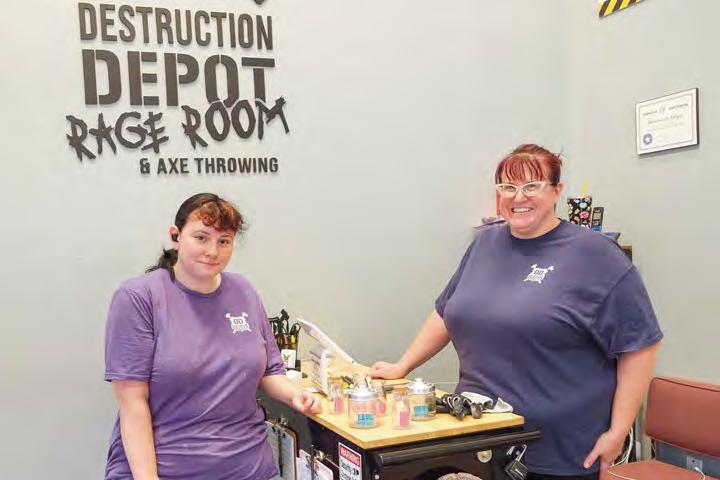


Destruction Depot appears unassuming from the outside. Located in a strip of warehouse space in Whitmore Lake, one may presume it is akin to the myriad of other blue-collar masonry or fabrication spaces that pepper the lot. A quick peek inside reveals a different story: a weapons wall filled with baseball bats, wrenches, hammers, and the like sprawls one area of the depot, plastic milk crates full of glass trinkets, old DVDs, alcohol bottles, and more spans another.
The impending wreckage comes with a uniform. Visitors first enter a dressing room where they are prepped with a coverall, a hardhat, safety glasses, and ear plugs if desired.
A lot of people coming into the depot were fighting their own internal war. Sometimes a family member had passed. A marriage had dissolved. A job had ceased. The common denominator was that a stress, whatever it was, needed to be released.


However, Rachel, a retired civil counselor, quickly noticed that a lot of people coming into the depot were fighting their own internal war. Sometimes a family member had passed. A marriage had dissolved. A job had ceased. The common denominator was that a stress, whatever it was, needed to be released.


“We are a rage room, but with a more therapeutic setting,” Crawford explains. “Most of the rage rooms only offer 20-minute sessions. The room is set up when you come in. You feel rushed for time. Here, we have found that people can be very invested in what they want to destroy.”
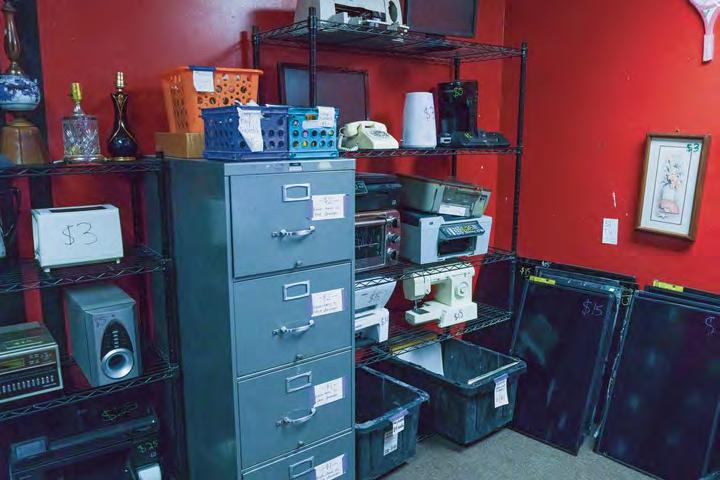
She recalled a man entering the depot who had just quit a job he loathed. He requested the room be set to look like an office, complete with a printer and office desk. Crawford said the scenes of destruction people request can sometimes be very specific as those people come in to deal with particular moments of darkness in their lives. “If I could describe Destruction Depot in one word, it would be cathartic,” said Crawford. “You really get to lay out all your frustrations, in here.”
The impending wreckage comes with a uniform. Visitors first enter a dressing room where they are prepped with a coverall, a hardhat, safety glasses, and ear plugs if desired.
Another woman requested distinct liquor bottles to smash, the same kind that her alcoholic father had drunk himself to death with. Loss and loathing can sometimes be healed with glass and a baseball bat, so long as it is in the right setting. Destruction Depot hopes to help those people who need that setting find a home, if only for an hour.
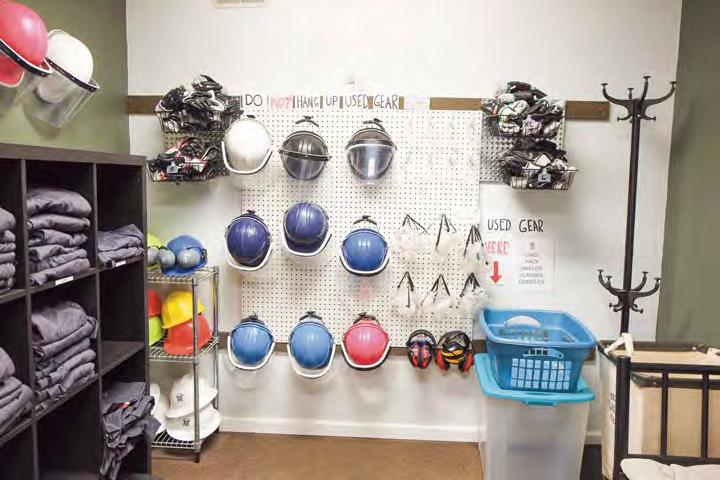
“We get a lot of people coming in for grief and loss sessions,” said Crawford. “We’ve had women come in after fertility troubles. A group of ladies in their 60’s came in and wrote on the walls after a cancer diagnosis. We see a lot of LGBTQ people here, as well. And of course, we did see an uptick of guests during the start of the pandemic, after we were allowed to reopen. We try to offer an outlet for whatever people are facing.”

Crawford said their audience is about sixty percent women, noting that “as the gender stereotype goes, a lot of men have super physical jobs where they can often get out their frustrations during work. Women have to hold a lot of things in.”
A $20 fee covers the cost of one person, and the rage room. From there, breakables cost between $4 and $50. The average guest spends about $30 to $50 dollars per person, including the room fee. This experience is for ages 13 and up. Flammables, explosives, and liquids are prohibited, but bringing outside breakables is permitted. For 45 minutes, guests can close themselves into one of the depot’s two plywood and chicken wire rage rooms and unleash their emotions on whatever inanimate objects they have chosen to destroy.
What happens after that is anyone’s guess. Crawford said it is not uncommon to hear yelling and smashing from where she is in the reception room, as people really allow themselves to let go in the destruction rooms. The depot also rents out bluetooth speakers, if one would enjoy a backdrop of music amongst the demolition.
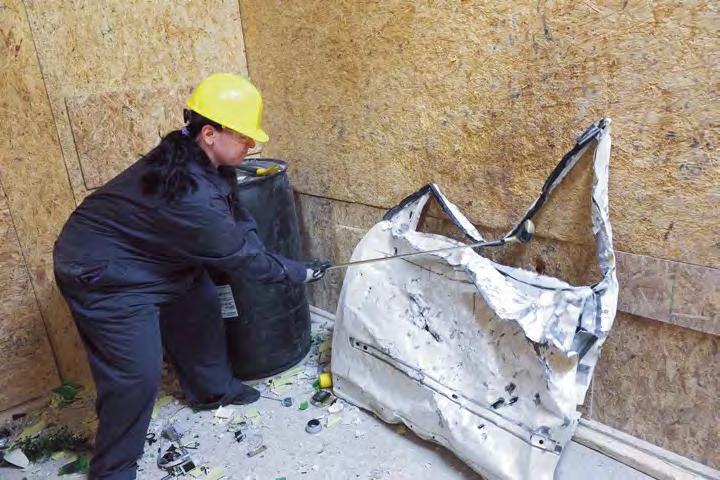
Xandra Hampton, an employee at Destruction Depot, recalled a particular guest that stuck out in her mind. “One time, a guy came in here after a divorce. He asked to destroy a car door. By the end of his session, he was covered in sweat, from head to toe. The car door was bent in half and thrown to the other side of the room. We see all kinds of people in here.”
In fact, there is a particular section of the weapons wall dedicated to just those kinds of people: the guests who have gone so far into destruction mode that they have broken a weapon during their time in the rage room.

said Crawford, “and
It can be jarring the first time a weapon eats through a stack of glassware. The snap of the materials together is sharp and startling. The way the objects of choice, stacked on large rubber buckets, explode and ricochet like glass confetti off the walls, is often a visual one may think of but never actually conjure in real life. “I’m sure almost everyone at one point has wanted to throw a coffee mug across the room. Here, they get to do it,” said Crawford.
At the beginning, the breakables were all sourced from donations or thrift stores. Facebook Marketplace was an easy way to pick up free items; now, Destruction Depot is so busy, they purchase bulk out-of-season furniture from thrift stores. Objects are recycled when they can be after they are destroyed.
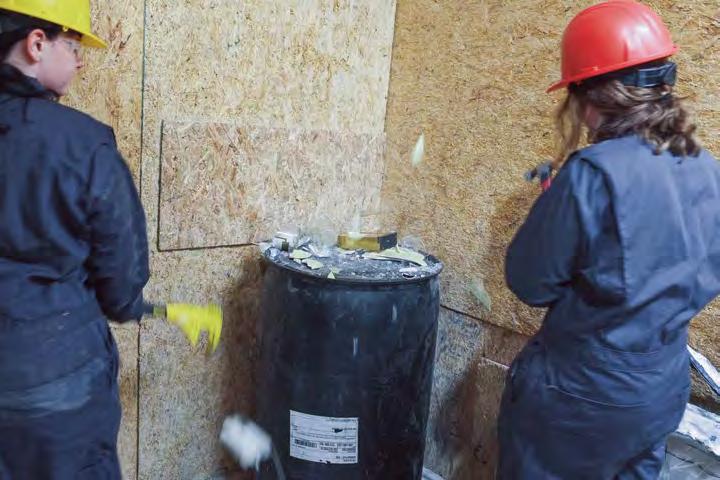
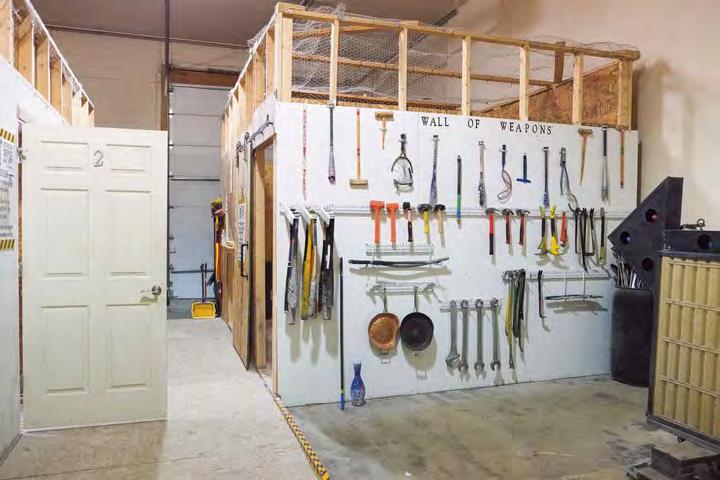
“My favorite part of my job is just experiencing the highs and lows with the people that come through the door,” said Crawford. “I love seeing people leave our rooms and just appear lighter, like they have one less trouble than when they came in.”
If you would like to experience a rage room, check out the Destruction Depot at 11048 Hi Tech Drive in Whitmore Lake or @destructiondepot on Instagram. They are open seven days a week. Go to destructiondepot.com for hours of operation.
The way the objects of choice, stacked on large rubber buckets, explode and ricochet like glass confetti off the walls, is often a visual one may think of but never actually conjure in real life.
“If you break a weapon, you get to sign it,”
then it goes up on our weapons wall.”
feels so good
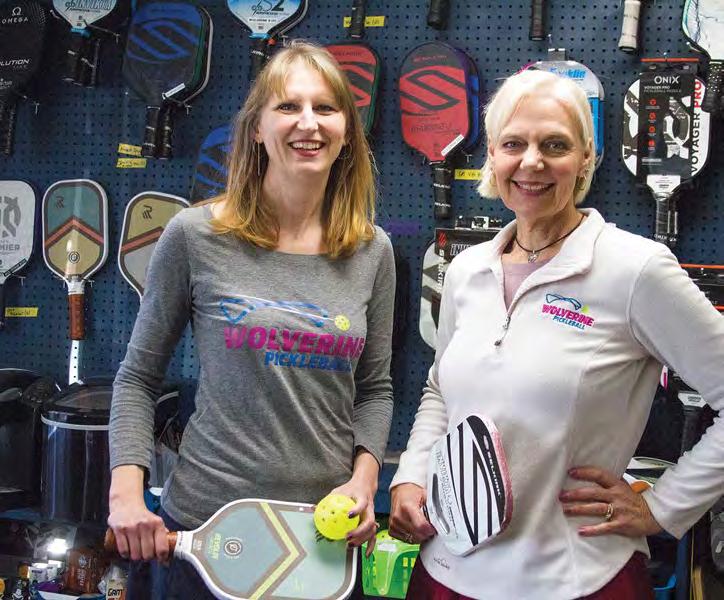 By Joshua Kay • Photos by Susan Ayer
By Joshua Kay • Photos by Susan Ayer
Pickleball, said to be the fastest-growing sport in America, has a signature sound: the hollow pop of a hard paddle striking a plastic, Wiffle-like ball. You can’t miss it as you approach a game in progress. You’ll also hear the squeak of sneakers, whoops of delight and amazement, laughter, the occasional groan of defeat, and a light clack as players head to center court at the end of a game to tap each other’s paddles and say, “Thank you.” Christy Howden and Leslie White, co-owners of Wolverine Pickleball, never tire of this soundscape. To them, it signals pure joy and is a siren call to come and play.
Pickleball looks at first like a mashup of tennis, ping-pong, and badminton. Perhaps it is, but soon one discovers it’s very much its own thing. It’s a game that rewards ball placement and patience over power. A game that is easy to learn but difficult to master. A game that brings people together across ages, genders, and backgrounds in defiance of the national division that marks and mars our time. Pickleball is rapidly entering the big time, with three professional leagues, increasing coverage of tournaments—a major network has started airing tournament finals—and players all over the country clamoring for more facilities. And it just so happens that in Wolverine Pickleball, Ann Arbor has one of the premier pickleball centers in the Great Lakes region.
Pickleball, said to be the fastest-growing sport in America, has a signature sound: the hollow pop of a hard paddle striking a plastic, Wiffle-like ball.


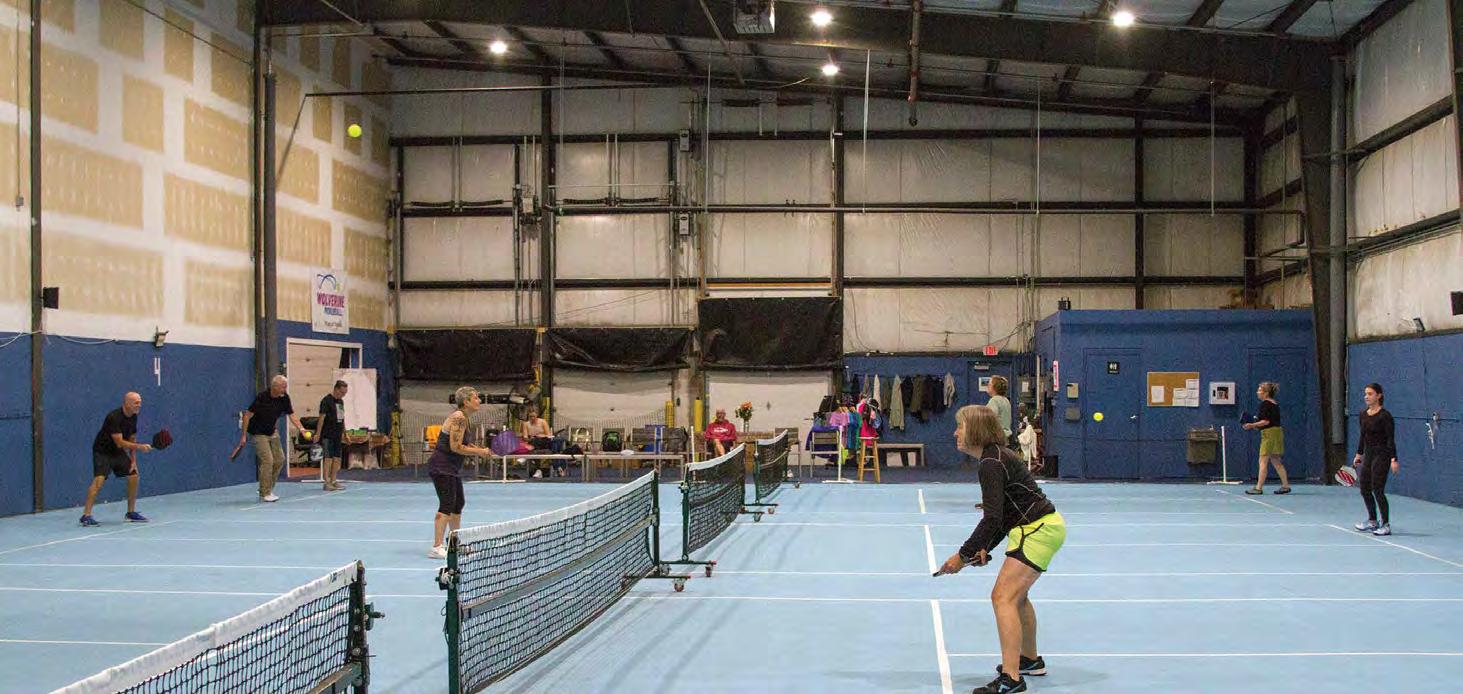
Wolverine occupies two cavernous, converted warehouses at 119 Jackson Industrial Drive. It features eight professional-grade hard courts and a pro shop stocked with dozens of paddles, accessories, and shoes. White, Howden, and their staff are happy to let you try out any number of paddles and provide expert advice on which might fit your game and your hand—in fact, a player stopped in to switch demonstration paddles as I interviewed Howden, who asked what she liked about the first one, gave her another to try, and quickly worked with her on her grip.
The daily schedule at Wolverine offers game-play sessions divided by player skill level as well as an array of group and individual lessons provided by certified coaches. These lessons include Learn to Play sessions, where a coach can get a gaggle of total newbies up and playing within 30 minutes. This ease of entry is one of the reasons for pickleball’s rocketing growth. Another is that players are quickly hooked as they discover that what seems to be a simple game on the surface is surprisingly and engagingly complex. Add in pickleball’s affordability—a workable paddle doesn’t have to be expensive—and it’s a recipe for success.
Pickleball is played on what looks somewhat like a small tennis court, but it’s not mini-tennis. The first seven feet on either side of the net are marked off as the “non-volley zone” (aka, “the kitchen”), meaning players can’t camp at the net and hit the ball on the fly. This rule reduces close-range overhead smashes. The hollow, ventilated ball loses speed as it travels and doesn’t bounce high, so even
powerful shots can travel only so fast. The serving team must allow the return of a serve to bounce before they hit it, so there’s no serve-and-volley game. This puts the serving team at a disadvantage, unlike other paddle and racquet sports, because the receiving team has a much easier time getting to the kitchen line, where they can cut down available angles and command the court. Couple the receiving team’s advantage with the fact that a team can only score when they serve, and one begins to understand why pickleball strategy is complex and, for many, counterintuitive but fun to learn. Rather than just whacking away at the ball, which tends not to work against a decent player, a deft touch is needed to work your way forward and gain an advantage. All of this means that finesse and touch are key to playing good pickleball, largely neutralizing strength and speed disparities and allowing people of different ages and overall athletic abilities to have fun competing with each other.
Doubles is the norm at Wolverine. The short games, small courts, and mixing of playing partners after each game make pickleball a highly social sport. This social aspect is what co-owners White and Howden enjoy most about running their business. White said, “[I] love when I see people make friends that they met here.” As much as she enjoys seeing players get better at the sport, she said, “I really love the friendships. That’s my favorite part.”
Howden takes pride in “the community we’ve built. People are looking for connection,” she said, “and this is a great way to do it.” She added, “I just want people to give pickleball a try. Come out and try it.” She loves “the testimonials from people about how much it’s changed their lives.” Both Howden and White noted that many Wolverine players picked up pickleball at transition points in their lives to try something new and meet people, whether that was when they were new to town, had experienced a loss or divorce, or were freshly emptynested or retired. Many have rekindled their inner spark through pickleball. For some, the game allows them to discover athleticism they never knew they had.
Howden and White met through their daughters, who played together on a travel volleyball team. White was the first to find her way to pickleball, when she accepted a friend’s invitation to play in 2016. “When I first saw [pickleball],” she said, “I thought it looked so simple.” A multi-sport athlete, she found that pickleball is actually “one of the most complex [sports], strategically,” and she was hooked. In 2017, she invited Howden to play. In time, the pair started running round-robin tournaments, which grew to involve approximately 200 players. Seeing this demand, and noticing how they and other players had to drive to different venues each day to find games, Howden and White decided to open a facility where people could gather and play every day. They initially considered renting space in a sports complex that was being planned. That project fell through, but Howden and White continued their search. In mid-fall of 2020, they found a warehouse just west of Ann Arbor that had been occupied by a food distributor.
In addition to daily games and lessons, Wolverine holds pickleball mixers every Friday evening where players can bring their own beverages, enjoy potluck food, socialize, and get a few games in. But Howden and White aren’t stopping there. They are building a new facility at 235 Metty Drive that will feature twelve courts, an expanded pro shop, party rooms, lounge areas, beer, wine, cocktails, food trucks, and outdoor activities like sand volleyball, bocce, and cornhole.
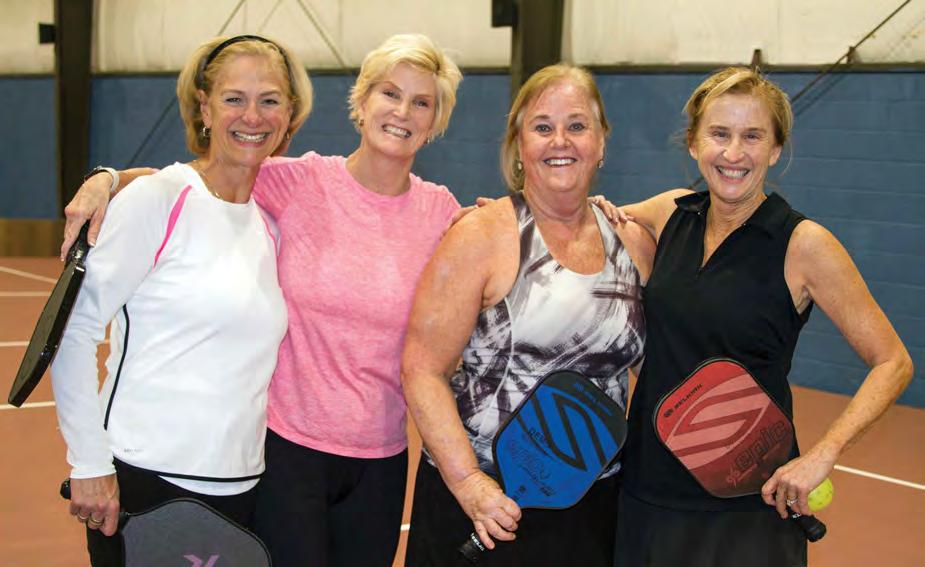
“We just want to keep building our community,” White said. “We want everybody to come and play and have a good time. That’s what it’s all about.” She noted that by growing in stages, from running tournaments to opening Wolverine with four courts, then adding four more, she and Howden have been able to learn and adjust over time, so building the new facility feels like a manageable next step rather than a huge leap.
In addition to daily games and lessons, Wolverine holds pickleball mixers every Friday evening where players can bring their own beverages, enjoy potluck food, socialize, and get a few games in.
Now, with Wolverine thriving and new players continuing to come in, the biggest challenge for White and Howden is ensuring that everyone competes at the right level so they can be successful, challenged, and keep growing in their abilities. “It’s a delicate balance,” White said. “It’s hard to recognize your true level.” Howden agreed. “We try to find everyone the spot where they belong, where they’ll have a great time. We pride ourselves on trying to link people up.” Wolverine offers sessions at every skill level, from novice to expert. White and Howden advise that players be patient and embrace the process of learning the game. Doing so opens the door to personal growth and a satisfying sense of accomplishment.
In two short years, Howden and White have built a warm, welcoming community. White recalled a player who had experienced a painful loss telling her, “This is my sanctuary.” Another, who had also picked up pickleball to help him find a path forward after loss, smiled at White after playing for two hours and said, “Pickleball is life.”
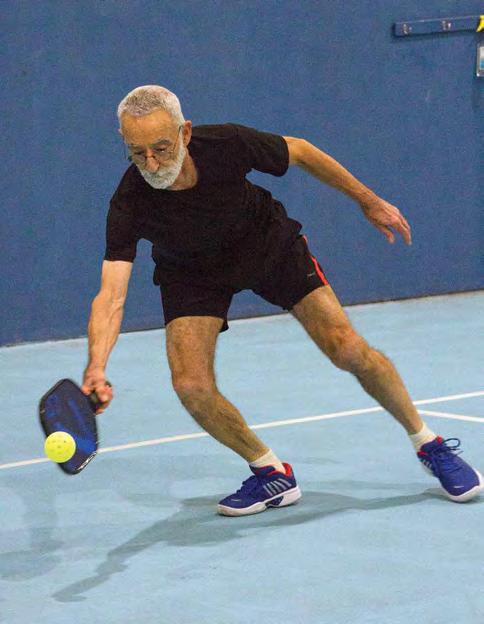
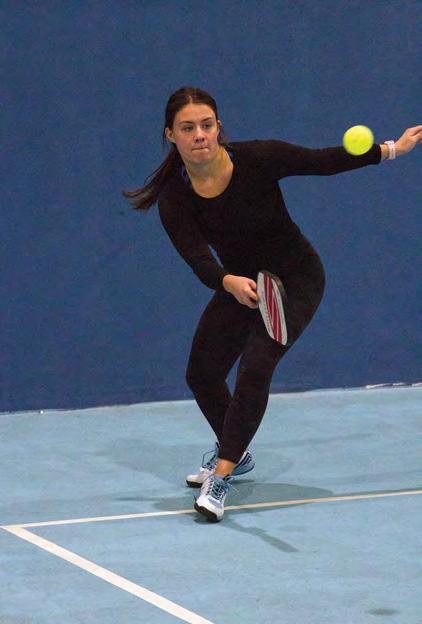
Howden and White are all smiles, too. “It still blows me away,” White said, reflecting on how Wolverine has grown. Or, as Howden said about their work, “We created the best jobs ever!”
Learn to play at Wolverine Pickleball located at 119 Jackson Industrial Drive in Ann Arbor. Visit them online at wolverinepickleball.com, or give them a call at (734) 489-1723. You can also email them with questions at hello@ wolverinepickleball.com.





“We had been looking for a long time,” Howden said. “It’s hard to find the right warehouse, especially in Ann Arbor.” She recalled that when they first saw the interior, the floor was filthy and gummy, but pickleballers came together to clean the place, lay down the court surface, and paint. With this help from the community, they had people on their four courts within ten days of getting the keys. “It was wonderful magic,” Howden said. More and more players continued to show up, necessitating expansion. When Howden and White heard the connecting warehouse would be vacated in late winter, 2022, they pounced on it, bringing the facility to eight courts in 17,500 square feet. “Again, we had community help,” Howden said. “Everyone just loves pickleball.”

The daily schedule at Wolverine offers game-play sessions divided by player skill level as well as an array of group and individual lessons provided by certified coaches.
Many have rekindled their inner spark through pickleball. For some, the game allows them to discover athleticism they never knew they had.Pictured from left to right: Mary-Shea Rozsypal, Lisa Stelter, Pam Anderson, and Cindy Masini. Victoria Rowe AJ Ceravolo
I hurt my leg in mid-September while running with my dog, Nala. The air was cool, autumn-fresh, and Nala and I were enjoying our evening walk. I felt so strong that I broke into a light jog, without stretching. I am 61 and not a runner.
About 50 yards into the run, I felt a pull behind my left knee. I slowed to a walk, thinking to myself, “There is no way that itty bitty burst of energy caused anything as serious as a sprain or heaven-forbid tear.” Still, my skin behind my knee was hot, the pain was real, and I quasi-limped home.
After wearing a brace on my knee for weeks, icing it daily, stretching it carefully, and getting an ultra-sound to rule out more serious causes, the pain behind my knee persisted.
After wearing a brace on my knee for weeks, icing it daily, stretching it carefully, and getting an ultra-sound to rule out more serious causes, the pain behind my knee persisted. While researching therapies for leg injuries near Ann Arbor, I stumbled upon the Neurofitness Center website. Their website was convincing. I made an appointment to try everything they offered: Neurofeedback, the Salt Room, the Float Tank, and Cryotherapy.
My partner and I first went to Neurofitness to experience a Neurofeedback session and the Salt Room. Jack Lark greeted us upon arrival. Knowledgeable and engaging, he would help us navigate the different therapeutic experiences. Neurofeedback, he explained, was a therapy in which he would attach a couple of electrodes to my ear lobes and one at my temple. Next, I would put on a comfortable pair of headphones—the kind with soft padding that cover one’s entire ears. Then I would sit in a comfy chair and listen to a recording of meditative music infused with nature sounds such as birdsong, steady rain, and wind rustling through trees. The recording was enchanting. It was easy to close my eyes and give my mind over to what I was hearing. Periodically, the music would skip, like a less-annoying skip of a record that self-corrects and lasts only a second. The ambient recording draws one’s auditory focus—the skips are triggered anytime one’s mind wanders beyond the music and birdsong. At first, the skips happened frequently. Soon, my focus on the audio became steadier and the skips were less frequent. The Neurofeedback session was like yearning to hear a beloved, melodic voice that is almost beyond one’s hearing. I stilled my body and leaned into the strings, rain sticks, flute, waterfall, and windchimes. By the time the session ended, I was ready to book a weekly session, my relaxation was so complete. Lark told me that Neurofeedback was a form of practicing mindfulness in a way that required less effort and more receptivity. As one who struggles with keeping my attention in the here and now, it succeeded beyond my hopes.
If the Neurofeedback session was like yearning to hear a beloved, melodic voice the Salt Room was akin to sitting on a beach, inhaling fresh air. The Salt Room at Neurofitness is lit by infrared lights and is big enough for two people to sit in comfortably. The Himalayan salt is so deep on the floor that it looks like a remote beach of fine sand you can dig your toes into. Salt bricks are laid into the walls and a PVC pipe in the corner emits a burst of fine salt spray into the room every eleven seconds. Upon entering, I removed my shoes, pushed back in one of the zero-gravity chairs, and closed my eyes to focus on my breathing. I quickly fell into a meditative state and the half-hour session slipped away unnoticed.
By the time the session ended, I was ready to book a weekly session, my relaxation was so complete. Lark told me that Neurofeedback was a form of practicing mindfulness in a way that required less effort and more receptivity.
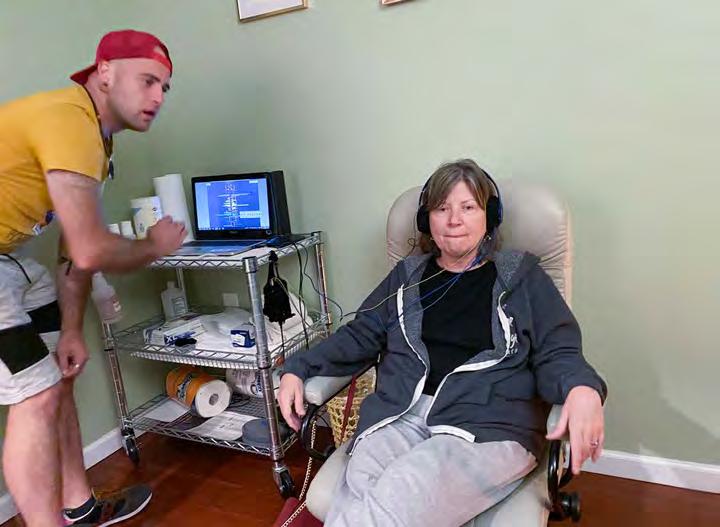
The next day we returned to float. We had both enjoyed float tanks in the past and were familiar with the drill: enter the room, shower, enter the float tank, and either close the lid, if you are in the egg or turn out the lights if you are in the non-covered tank. Music plays if you



are in the open tank, or you can float in absolute silence in the egg. In both tanks, you float in darkness that envelops you so completely that you cannot see the walls, the water, or your own wrist in front of your face.
The complete lack of visual stimulation enhances one’s sense of touch so that the salt water, which holds you up without effort, feels like a cradle, the warm water giving a sense of being in a womb—a protected space created for your own nourishment and rest. A gentle recorded voice interrupts your reverie when the hour is drawing to an end. After floating, the colors and lights and sounds outside are more vivid and distinct. There is a newness to the world as if your very eyes have been cleansed—your senses reset.
On Monday, I returned to Neurofitness for the scariest offering: Cryotherapy: standing, with minimal protective outerwear, in a sub-zero chamber for three minutes. Cryotherapy has been used for decades in Europe and Asia to promote athletic recovery. From the Neurofitness website, I read, “The use of liquid nitrogen in a safe and controlled environment provides a gentle but significant
amount of cold exposure. The extreme cold stimulates the skin’s temperature receptors to activate the nervous, immune, and endocrine systems, leading to a reduction in inflammation and pain (hey athletes—this means quicker recovery!), elevating mood, and increasing energy. Clients often tell us they feel relief of symptoms including muscle soreness, arthritis, chronic pain, and inflammation.”

Lark, our guide at Neurofitness, was particularly helpful for my Cryotherapy session. He explained that the sub-zero temperatures would not feel quite as cold as I might expect, because it was a dry cold, not the wet cold that we know from Michigan winters. The Cryotherapy chamber looks a bit like a blue hexagon-shaped phone booth. The floor of the chamber is adjustable by adding soft, uniform pads that fit perfectly in the chamber’s footprint, so that no matter your height, your head is not enclosed in the chamber. Lark gave me special socks, shoes, gloves, and a robe and excused himself until I was ready.
If the Neurofeedback session was like yearning to hear a beloved and melodic voice, the Salt Room was akin to sitting on a beach, inhaling fresh air.
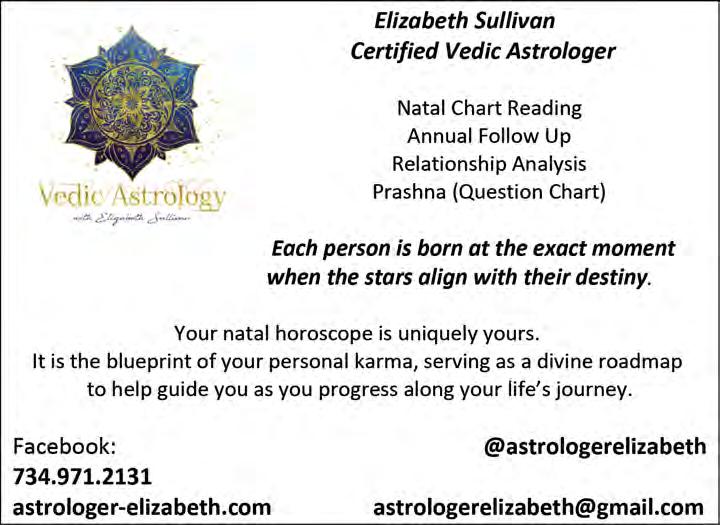

Once inside the chamber, I was not brave enough to drop my robe. The cold was not as sharp as I expected, but neither was it as comfortable as the other therapies had been.

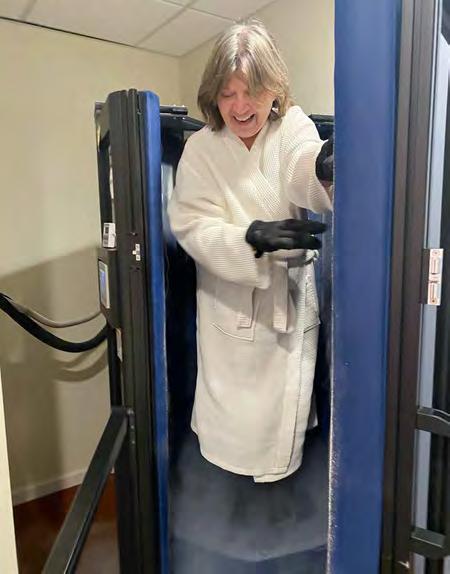
When he returned, he assured me that I was in control. Once in the chamber I could opt to remove the robe and at any time, or I could ask him to let me out. Still, he urged me to embrace the experience and try not to focus on how cold I felt. “That way, you’ll get the most out of doing it,” he said.
Once inside the chamber, I was not brave enough to drop my robe. The cold was not as sharp as I expected, but neither was it as comfortable as the other therapies had been. I endured the entire three minutes, trying to focus on the benefits. I emerged feeling like a victor. Immediately after Cryotherapy, I felt hungry, and then tired. As the evening wore on, and the new day dawned, I noticed that the pain in my leg was considerably subdued. I could still feel a dull ache where the sharp pain had been, but that continued to lessen in the days ahead. It has been two weeks since I braved the sub-zero Cryochamber and my leg has yet to hurt at the level of pain I endured before the experience. In fact, I’ve not worn my knee brace once since the big freeze. I’m going back for another session today, to continue the full healing of my leg, and to see if Cryotherapy will help heal two toes that I bruised badly yesterday when I wrapped them around a square, wooden chair leg.
Neurofitness is an extremely clean facility. Lark is a helpful guide whose sense of optimism and wonder is infectious. The entire environment underscores that restorative healing and stress-relief is more than a nice occasional treat. It is something we need as much as medications, fresh food, and deep sleep. The therapies offered at Neurofitness act like boosters that enhance other healing practices. They helped me find a place beyond the trauma of life in which restoration of my body, mind, and spirit, is both inviting and efficient.
In my first visit, I commented to Lark that I was pleased that Health Savings Account and Flexible Savings Account dollars offered by many insurance companies could be used for all their therapies. He said, “Of course! We are a health care center.” Indeed.
Neurofitness is located at 6360 Jackson Road Suite A in Ann Arbor. To learn more or make an appointment, call (734) 206-2012 or visit them online at https://neurofitcenter.com.
Rain is probably far from your mind this winter. It’s more likely you’re stressing over snow—the mornings you’ll spend plowing your driveway and the salt you’ll inevitably be tracking into the house. But even though drizzly spring days seem a world away, the winter months are the perfect time to start thinking about planting a rain garden.
Stormwater runoff is a major issue facing the health of waterways all over the world. On impervious surfaces like paved roads, sidewalks, and roofs, rainfall flows unimpeded, collecting pollutants like pesticides and animal waste as well as litter like cigarette butts and plastic. This contaminated water makes its way into storm drains, where it enters our sewer system, or might even flow directly into rivers and stream, where it threatens flora and fauna.
Even though drizzly spring days seem a world away, the winter months are the perfect time to start thinking about planting a rain garden.

Rain gardens were developed as a way to mitigate this problem. Consisting of vegetation planted within a shallow depression in the ground, they collect, absorb, and filter water that would otherwise run freely through urban areas. Washtenaw County residents are lucky to have a robust rain garden program, run through Washtenaw County Water Resources. The County offers a Master Rain Gardener Course that gives participants the opportunity to gain all the knowledge needed to construct and plant their own rain garden. The prerecorded course and necessary materials are available on their website, along with other helpful resources.
By studying up over the winter and making important decisions about your garden ahead of time—such as location, design, and what plants to use—you’ll feel much more prepared when it comes time to plant. Most sources recommend planting your rain garden at least 15 feet away from any buildings to keep water from pooling around and damaging structural foundations. Utilities like wells and septic tanks will need to be considered, too. As far as location goes, one option is to stake out an area near roof gutters or downspouts but still distant enough from your home that there’s no risk of damage while another is to position the garden further down your yard so that it collects runoff from the lawn as well as from the downspouts. Wherever you place it, your rain garden will need to be downhill from the channel that will be directing the water and situated on flat or slightly sloped ground.
Consisting of vegetation planted within a shallow depression in the ground, rain gardens collect, absorb, and filter water that would otherwise run freely through urban areas.
The Master Rain Gardener Handbook suggests making your rain garden be “four to six inches deep and 20–30% the size of the impervious surfaces.” Though you won’t need to start digging until the spring, it’s good to figure out and troubleshoot these measurements ahead of time. Once you know how big your garden should be, you can experiment with different shapes—like a crescent, teardrop, or other organic form—settling on one that complements the existing features of your yard. Don’t be afraid to sketch it out! Putting your ideas on paper is the best way to visualize your garden-to-be.
What native Michigan plants you choose should be dependent on how much sun your garden will be getting. Purple coneflower is perfect for full sun, while wild geranium prefers things to be partly sunny. Plants like fox sedge and blackeyed Susan can thrive in either situation. You might also keep in mind the kinds of pollinators you most want to attract. A garden filled with bee balm and rose mallow would be hummingbird heaven!
Leslie Science & Nature Center (LSNC) will be incorporating a rain garden into the design of their our developing Nature Playscape with their upcoming water play installation in 2023. Using pumps along the perimeter of the water play area, visitors will be able to manipulate a flow of water that will run downhill, feeding a rain garden populated with native flowers, grasses, and shrubs. They will design pumps for ease of use, ensuring that visitors of varying physical abilities can enjoy the feature equally. The rain garden will be staggered down the hill and fed underground by runoff from the water play area. Our water feature will provide an opportunity to educate visitors about informed water usage and the role that rain gardens can play in a healthy urban ecosystem.
By studying up over the winter and making important decisions about your garden ahead of time—such as location, design, and what plants to use—you’ll feel much more prepared when it comes time to plant.
By using mindful landscaping techniques like rain gardens, the centr can positively contribute to the health and beauty of the local watershed. Rachel Carson wrote in Silent Spring that water must be thought of “in terms of the chains of life it supports.” As you begin to plan your rain garden, consider how this choice will impact all the life around you—your family and neighbors, your pets, the songbirds nesting in your backyard, and the trees in your favorite park. From the smallest insect to the tallest sycamore, we all depend on clean water to thrive, and we as humans have the power to make a beneficial and lasting contribution to our environment. List of resources:
Build a Rain Garden by Sally Wenczel (children’s book)
• Water Resources Washtenaw County: Rain Gardens: washtenaw.org/647/ Rain-Gardens
• Water Resources Washtenaw County: Master Rain Gardener Class washtenaw.org/675/Master-Rain-Gardener-Class
• Huron River Watershed Council: Rain Gardens in Our Watershed: hrwc. org/rain-gardens-in-our-watershed/
Serena Dobson is the Development & Administrative Assistant at the Leslie Science & Nature Center and Ann Arbor Hands-On Museum and holds an MFA in creative writing from the University of Michigan. She loves to hike and birdwatch all over Washtenaw County.
I am fortunate to live on a street that’s close to downtown, where I can sit on my front porch and, for three seasons of the year, anyway, I can hail all my neighbors as they pass by. I can get to know their names and their dogs’ names, too. I see the same pairs of women walking or running together and talking.
Paying close attention to these things helps me in my work as a writer. I learn a lot about different kinds of people and how they live. But there is one thing that I witness every spring that inspires and amazes me the most, and that is when a neighbor woman emerges from her house with a new baby in a stroller after I haven’t seen her for several months during the long, cold winter. Sometimes there are even years when five new babies come out of five houses all in the same two blocks. Okay, so I have to admit that only happened once during the past ten years, but that is the year that I befriended Marilyn.
About ten years ago, she suffered from post-partem depression (though it was never diagnosed or treated) shortly after the birth of her only child. She said that even now, despite all the years that have gone by, she sometimes still has lingering feelings that she is a terrible person who doesn’t deserve to be a mother.
Marilyn doesn’t want me to use her real name because she’s still not ready to go public with her story, even though it’s about something that many, many women go through. About ten years ago, she suffered from post-partem depression (though it was never diagnosed or treated) shortly after the birth of her only child. She said that even now, despite all the years that have gone by, she sometimes still has lingering feelings that she is a terrible person who doesn’t deserve to be a mother. She’s only now beginning to understand that this false narrative is the result of the difficulty she had while trying to physically and emotionally bond with her newborn. Her baby was whisked away from her immediately after he was born and put in the Neonatal ICU for observation because he had fluid in his lungs. She didn’t get to hold him for two days, and after that, she began to feel like the nurses and doctors judged her; they didn’t think she knew anything about being a mother and they didn’t give her input in any of the very important decisions they were making about her baby and his health.
These feelings of being judged, and not having a clue about what she was doing, hung over her after the baby came home. In fact, during a recent interview on my back deck in early October, Marilyn honored me by saying that, when she was going through the worst part of her crisis, I was the first person to really support her—and we barely even knew each other’s names at the time.
“You have to understand, my baby almost died,” she said. “That’s why I needed an emergency C-section. But afterward, whenever I told people who were close to me that I was having a hard time being a mother, they just said: ‘You’re so lucky he’s alive! He’s a beautiful baby. What’s your problem?’ They just shut me down. So, I couldn’t talk to anyone—not until you came along. You just seemed to understand everything, even though I didn’t really know you at all.”
And how was I able to give her this support, you might ask? Well, almost exactly twenty-eight years ago, I thought I was the worst mother on earth, too. So, when I saw my neighbor outside her house ten years ago, trying to console a baby that was inconsolable, I knew exactly what to do. I knew I had to essentially invite myself inside her house, and not take “no” for an answer. And that is exactly what I did. And once I got Marilyn inside her home, I essentially gave her permission to tell me that she was inconsolable too. I gave her permission to fall apart right in front of me and tell me what she was thinking and feeling. And that was exactly what she needed.
The other thing she needed was someone to tell her that she didn’t have to quit breastfeeding her newborn. Once I got her inside her living room on that long-ago spring day, Marilyn said she had just returned home from the pediatrician, who had told her that her two-week-old baby had lost weight. Her baby had been given formula while he was in the ICU, and Marilyn had also been breastfeeding—there, and then at home. By the time of the visit to the
pediatrician, the baby had become confused and was refusing both the bottle and the breast, and the pediatrician had just told Marilyn that she would have to stop breastfeeding and move all the way to just using formula. Because of M’s history in the hospital with male doctors, whom she felt had made too many important decisions for her, and because she also believed that breastfeeding could provide her with her last, best hope for emotionally bonding with her child, this was devastating news.
When Marilyn and I compared notes on our encounter recently, she explained how important it had been to her. “I had been telling everyone that I was having problems, and they all just told me, ‘Don’t worry. It will get better!’ And no one stopped to listen to what was wrong. But you just came inside my house and sat next to me and told me you would stay there until my baby latched on. You explained it wasn’t just about the baby—it was about me, too—it was about both of us together. You told me that the baby could sense my anxiety, so I needed to drink lots of water, relax, and just trust myself, my body, and nature. And that was the day it all turned around, and I was able to breastfeed my child for a whole year.”
During our recent visit, Marilyn asked me to tell her why and how I had seemed so calm and self-assured that day. And I told her the story of our daughter Amelia, who also almost died when she was born, twenty-eight years ago. I told Marilyn that Amelia was kept on life support in the NeoNatal ICU for her first ten days of life, and I never saw her awake in all that time because she was on a powerful barbiturate to prevent seizures. Luckily, I had successfully breastfed my son, so I knew if I could breastfeed Amelia, and that it would provide me with my best chance at bonding with her. At the time, Amelia was receiving nutrients through an IV, but I pumped my breasts in the ICU every two hours whenever I was there and stored the milk in the refrigerator. And one night while I was visiting Amelia, a nurse said to me: “Why are you bothering to do that? She’ll never take your breast.”
I was trying to visit Amelia every chance I could, and during one visit, in the wee hours of the morning, she finally took my breast, and I felt the hormones of pleasure and joy pass between us, even though Amelia’s eyes were shut, as usual. I made sure that nurse knew not to ever discourage another mother from trying to breastfeed her baby in the ICU again.
We women will never find a way to become perfect mothers, and it’s very dangerous when motherhood becomes a competition. Sometimes women compare notes on their labor and delivery: was it a “natural” birth, or did they have pain medicine, an epidural? Did you breastfeed, and for how long? But all we can do is the very best we can—and we owe it to each other and ourselves to affirm that that is enough—and so much more.
All we can do is the very best we can—and we owe it to each other and ourselves to affirm that that is enough—and so much more.
According to the Mayo Clinic, “Most new moms experience postpartum “baby blues” after childbirth, which commonly include mood swings, crying spells, anxiety and difficulty sleeping. Baby blues typically begin within the first two to three days after delivery and may last for up to two weeks.” But when systems are more severe, women can “experience a more severe, long-lasting form of depression known as postpartum depression.” There are numerous places to turn for support, including Postpartum Support International, which can set women up with local support providers and support groups. Postpartum Support International can be reached at 1-800-944-4773 or postpartum.net/ get-help/locations/.
There are many local resources that offer support to mothers who wish to breastfeed their babies. La Leche League International (LLLI) is probably the most well-known. Founded in Illinois in 1956, its mission is “to help mothers worldwide to breastfeed through mother-to-mother support, encouragement, information, and education, and to promote a better understanding of breastfeeding as an important element in the healthy development of the baby and mother.” While it is an international organization, it has many active local chapters including Ann Arbor. Contact them by phone at (442) 229-0327 or find the local chapter online at lllaa.weebly.com.

There’s an old school pop song where the lyrics say, “The men all pause when I walk into a room.” After a certain age, those lyrics take on a whole new meaning. What I hear now is MEN-O-PAUSE. I’ve gotten Men-o-pause when I walk into a room. And that’s when I began to take a non-traditional approach to trudging through the trenches of menopause—by sprinkling it with humor.
There’s nothing funny about menopause, but laughter can help you move through it with a smattering of grace. Humorist, Erma Bombeck had the right idea when she said, “If you can’t make it better, you can laugh at it.” She was referring to life in general, but it is certainly a statement you can apply as needed.
There’s nothing funny about menopause, but laughter can help you move through it with a smattering of grace.
Just as fast-food restaurants offer a combo meal. I have a combo for working through challenging situations—humor and journaling. In fact, journaling was one of the tools in the process of birthing my book, Menopause Ain’t No Joke The book is a non-traditional devotional. It’s a collection of my personal essays on parenting, fitness, dental visits, and other life situations with a dollop of humor.
You’ve probably heard the saying laughter is the best medicine. If your doctor told you that you needed a dose of laughter three times a day, what would that look like for you? Ponder that for a moment…okay, times up. Here are a few ideas:
• Share a laugh with a friend
• Read something funny
• Watch a funny movie
Laughter is therapeutic. It can be soothing and is a great tool for stress relief. Humor has always been a sidekick to my writing. I have always loved writing and consider myself a collector of words. If I see a word, phrase, or quote that I like, I scribble it down for later potential use. My scribbles developed into paragraphs, stories and eventually a book. Some of the episodes in the book were developed into stand-up comedy material.
You’ve probably heard the saying laughter is the best medicine. If your doctor told you that you needed a dose of laughter three times a day, what would that look like for you? Ponder that for a moment…okay, times up.
When my sons were toddlers, I began keeping notes on funny things they would say. I wasn’t sure at the time how I would use them, but none the less, I jotted things down. I still remember when one of my sons was five years old and we were seated at the breakfast table. He had his head bowed and eyes closed to say his blessing.
After several seconds, my son opened his eyes and I asked, “What did you say in your blessing?”
“Nothing,” he answered. “I just closed my eyes like you do.”
It wasn’t until years later when I began a blog, that I included that statement in a humorous parenting article. Then another several years passed before comedy rolled onto the scene. This reminds me of the Bible parables about seeds being planted and waiting for a harvest.
As I stopped to think about how I had the courage to perform comedy, I believe the seed was planted the day I prayed for boldness. Obviously, I was not specific in my prayer, because never in million years did I imagine myself performing comedy.
My first experience with stand-up comedy in front of an audience was in 2015 when a fellow parishioner was planning a Women’s Day event called—A Night
of Elegance. She wanted to include comedy and I boldly said, “I’ll do it,” and accepted the challenge. I arrived…nervous, but wearing my evening gown, long white gloves, and carrying note cards to help me remember my jokes. I reminded myself that I was among friends, and all was well.
In 2017 I inched out of my comfort zone a little more and participated in a pageant for African American women 50 and older. As contestants, we had to perform a talent. What do you think I did? Comedy…in front of about 500 people—and they laughed! A month after that event I signed up for a talent show sponsored by a local church, and I won second place.
I began to be invited to provide humor at prayer breakfasts, luncheons, retreats, and other gatherings. Things were happening in God’s divine order. During the beginning of the pandemic, while we were in quarantine, other opportunities for comedy developed.
As I stopped to think about how I had the courage to perform comedy, I believe the seed was planted the day I prayed for boldness.
As a member of Toastmasters (public speaking and leadership organization), a fellow member asked me to join her in hosting a series we titled Humor in the Workplace. This led to another door opening. One of our guests told me about a friend who was coaching and teaching comedy workshops through Zoom. Yes! I signed up.
Over the past two years I continued to sign up for the workshop sessions. There were performances at the end of the sessions for us to test our material. I began to embrace the title comedian and I found joy in giving people a reason to laugh. This past summer I completed a six-week comedy workshop and continue to take advantage of opportunities for stage time.
Each step in my journey is paved with praises and glory as I lean on my spirituality during challenging times. One on my reasons for writing Menopause Ain’t No Joke was to show how humor and faith can be combined to ease some of life’s struggles.
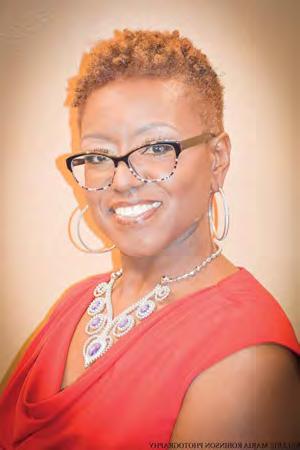

Some nights consist of fighting and kicking the bed covers because it’s hot one minute and cold the next. Leg in the cover, leg out of the cover. Suddenly, a game of the Hokey Pokey begins. It is times like these where we can choose our response. When it feels as though a situation is coming apart at the seams, find a thread of humor to weave it back together.
You don’t have to be a comedian to find joy through laughter. Think about the things that make you smile, chuckle, or burst out laughing. It could be a day out with friends, something funny that Uncle Joe did at the last family gathering, or a funny pet. Whatever causes a smile to bubble from your belly, and up to your lips, do more of it.
Be encouraged, walk in faith, and know that there is a plan for you.
Angela Verges is a native Detroiter who writes books for children and blogs about parenting experiences as she practices being a grown up. You can also find her on stage bringing laughter to others. Check out her collection of essays in her book Menopause Ain’t No Joke, or her eBook Laughter H.E.L.P.S. Follow her on Instagram at writermama223, on Facebook@angela.verges, or visit her website, angelaverges.net.
Every month, I know when it's that time in my menstrual cycle: the time to cue up sad movies and bust out the dark chocolate. There are signs my luteal phase has arrived, and it used to make a grand entrance, but I learned ways to dampen its arrival.
Many of us may be familiar with Premenstrual Syndrome (PMS), which is estimated to affect 85% of menstruating bodies. Less discussed, however, is Premenstrual Dysphoric Disorder (PMDD), which is a condition estimated to affect up to 8% of the menstruating population, and ought to be talked about more. While PMS might impact a person during the luteal phase of their menstrual cycle, PMDD can impact a person for an average of two-three weeks out of the month.
While PMS might impact a person during the luteal phase of their menstrual cycle, PMDD can impact a person for an average of two-three weeks out of the month.
Symptoms could be mental, emotional, and physical in any combination. Some menstruating people are painfully aware of a whole host of PMS symptoms: fatigue, powerful cravings, uncomfortable bloating, cramps, irritability, and emotional sensitivity, etc. For people experiencing PMDD, the severity of these potential symptoms worsens, a handful of supplemental symptoms arise, and the duration of the symptoms increases—wreaking havoc on a person’s sense of well-being and capacity to “keep up” in life.
Some of the supplemental symptoms associated with PMDD are insomnia, extreme mood swings, difficulty concentrating, decreased interest in activities, bouts of rage and/or extreme sadness, hot flashes, muscle pain, depression, and suicidal thoughts. While PMS can feel extremely disruptive, PMDD interferes with a person’s work, school, and relationships. Both PMS and PMDD are validly impactful experiences; though, you can trust you are experienceing PMDD when you are impacted more severely, more frequently, and for a longer duration of the month.
For those looking to ease their monthly troubles, there are immense benefits in maca root powder, vitex chasteberry, and magnesium malate for naturally subduing symptoms of PMS and PMDD.
For people experiencing PMDD, the severity of these potential symptoms worsens, a handful of supplemental symptoms arise, and the duration of the symptoms increases—wreaking havoc on a person’s sense of wellbeing and capacity to “keep up” in life.”
I experienced PMDD for two years before I found a gynecologist who would work with me. In those two years, I had discussed PMDD with a general practitioner, a gynecologist, and a psychiatrist, all of whom told me antidepressants and the hormonal contraceptive pill were my only options. For personal reasons, these options did not feel right for me. I was coping with untreated PMDD, which negatively impacted my life at work, home, in relationships, and feeling at peace within myself.
Frustrated and incredulous how these could be the only treatments, I began looking for a gynecologist with more natural and holistic methods, and I found one who created a supplement plan for me, changing my day-to-day experiences for the better. After a few months on the supplement regimen recommended by my new gynecologist, I gained a renewed sense of vitality and felt like myself again. The debilitating effects of PMDD in my life have since subsided. While I do experience some symptoms, they are no longer as extreme and, every now and then, I don’t experience symptoms at all!
These are the supplements that healed my experience with PMDD and are equally helpful for PMS. Before starting any supplement routine, please talk with your doctor to make sure it is safe and right for you. Experiencing PMS and PMDD can feel overwhelming and lonely, and we’re often told to just “deal with it.” Let me affirm you are not alone, and you do have options for relief. Here’s what was right for me: maca root powder, vitex chasteberry, and magnesium malate. While I combined these with other helpful supplements, such as vitamin B6 for energy and vitamin E for estrogen balance, these three made the biggest difference for my body.
Maca root powder or maca root, specifically, is an adaptogenic herb that has long been in use to increase energy and libido. Additionally, maca root might help improve your mood. For me, incorporating an adaptogen into my supplement routine was an essential step in recovering a sense of well-being, presence, and energy in the day. Maca root can help regulate cortisol in your

body, which is helpful for PMS and PMDD because cortisol, commonly referred to as the stress hormone, can contribute to throwing other hormone systems out of balance. By supporting the adrenal system with maca root, the body’s stress response is better regulated. This, in turn, gives the body more energy to balance out other hormones, increasing the health of multiple hormone systems. I like to add a teaspoon of maca root powder to a smoothie during my luteal phase for extra support.
I was coping with untreated PMDD, which negatively impacted my life at work, home, in relationships, and feeling at peace within myself.
Vitex chasteberry is an herb which has been used to address menstrual symptoms for thousands of years. Vitex interacts with various bodily systems to produce a hormone balancing effect and has been shown to increase progesterone and balance testosterone. These benefits might help with frequent periods, mood swings, anxiety, depression, irritability, breast tenderness, menstrual cramps, food cravings, headaches, hot flashes and night sweats. By raising progesterone levels, vitex can be taken to naturally balance out an estrogen dominance. A clinical study by Loch, Selle, and Boblitz on vitex and PMS has shown how over three menstrual cycles, vitex reduced symptoms of depression and cravings in 93% of subjects. I take this game changing pill daily.

Magnesium malate helps facilitate a healthy mood, balanced hormones, higher energy, and calm feelings depending on the kind of magnesium taken. My gynecologist recommended magnesium malate because it helps boost energy levels, and extreme fatigue was one of my major concerns. What I love about magnesium malate is how it helped me feel more energetic during the day without feeling wired. And, taken in the morning, it did not impact my sleep. Magnesium may also work to lessen stress, menstrual cramps, bloating, breast tenderness, and inflammation making it a powerful supplement in relieving PMS and PMDD symptoms.
Experiencing PMS and PMDD can feel overwhelming and lonely, and we’re often told to just “deal with it.”
For more information on PMS and PMDD as well as articles on the science backing hormone balancing supplements, I would recommend exploring Dr. Jolene Brighton’s website (https://drbrighten.com). I am in no way affiliated with her nor have I purchased anything from her brand. I have, however, found some of her articles helpful for learning more about the hormones at work during a menstrual cycle. I hope learning about these helpful supplements benefits those who experience PMS or PMDD as well as anyone who knows someone who might benefit. The more we share, the more clarity is shared, and the better we feel!


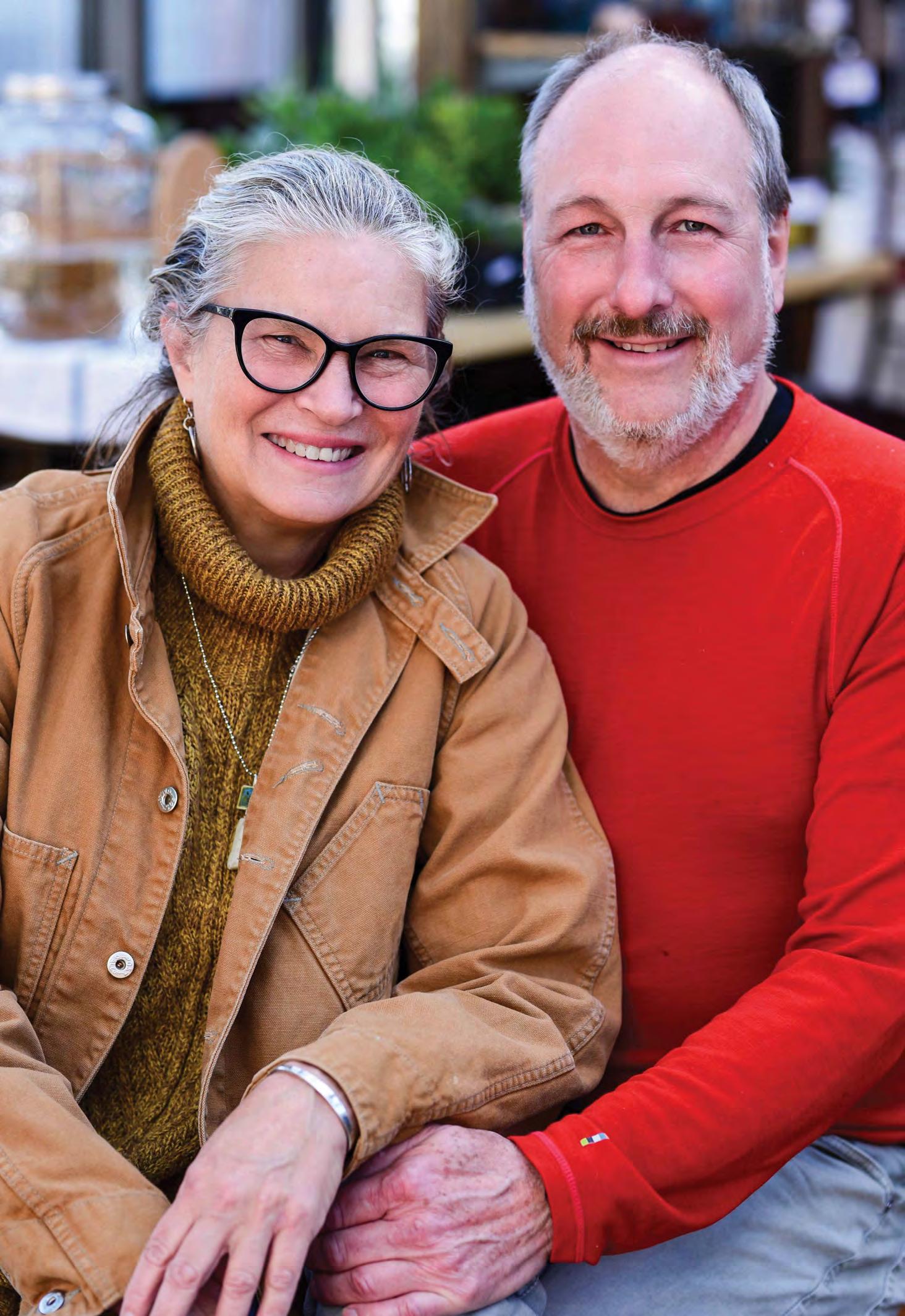



Mission driven in all its disparate pieces, this grocery store, that is so much more, is determined to serve many sectors of our local culture. It could seem confusing, if it wasn’t all so smooth. Argus is a daily farmers’ market, and a local grocery and sundries store. It is a coffee shop and cafe, a tavern, and an entertainment venue. It is an education center offering weekly webinars, classroom curriculum, and full trainings. And Argus Farm Stop is a crucial component that was missing for the growth of our local food system. In every aspect, wife and husband owners, Kathy Sample and Bill Brinkerhoff are hands on and happy to be so. You will find them behind the counter making the coffees, or in the back receiving the produce, or around town driving the CSA deliveries on any normal day. They are fully devoted to this segment of our local economy with the soil under their fingernails to prove it. Running this multifaceted operation can’t be simple, but it is clear. Every aspect returns to the central mission, as stated on the website: “To grow our local agricultural economy by supporting the success of local farms. Argus provides a place where local farms can sell locally-grown produce and other goods conveniently to consumers, year-round!”
Argus is a daily farmers’ market, and a local grocery and sundries store. It is a coffee shop and cafe, a tavern, and an entertainment venue. It is an education center offering weekly webinars, classroom curriculum, and full trainings. And Argus Farm Stop is a crucial component that was missing for the growth of our local food system.
Their effort is effective. Since opening their original 1800 square foot converted gas station on August 16, 2014, to running three bustling outposts today, Sample and Brinkerhoff continue to expand sales and offerings in all directions. But they won’t take the credit. When I request an interview with Kathy for these pages, she defers “you mean you want to cover Argus?” And when I congratulate her for the success of this bustling business, she quickly points to the employees instead, giving full credit to their incredible staff. So, I sit with their general manager Laura Matney and the Packard location manager, Meg Goldwyn. They both wax poetic about Kathy and Bill’s mission, nearly coming to tears about how much they appreciate the core principals at the center of the whole Argus undertaking. The enthusiasm is infectious. “We wouldn’t survive without our produce managers Trice Kmiechiak and Dani Cavagnaro ordering the right amount to balance a beautiful display that is robust enough to make it exciting to shop from,” says Matney, amplifying Kathy Sample’s example. Every employee seems to agree, with glee, how happy they are to add their good work to the central tenant: growing the local food economy, for the betterment of us all. Finally, I had to ask the obvious question. Why? What is it about locally grown that drives this complex machine with so much zeal?
There are obvious reasons of course. The colorful flow chart posted at each location with the breakdown of the social, environmental, and economic benefits of buying local outlines, “Each dollar spent at your local business returns three times more money to your community than a dollar spent at a chain or non-local store. Local and regional food distribution uses at least 4x less fuel than conventional food. And local food production protects the health of our environment, our economy and our bodies.” But how does this workforce unify around these abstract platitudes? Obviously, most of us haven’t abandoned our standard workplace to devote all of our waking hours to the local food movement. These people must be in it for another reason.
When you witness the way these offerings flow from the farms to the shelves to the families who walk in to shop each day, it becomes clear. After spending time at both the Liberty Street and the two Packard-street locations, I can see, these concepts are not abstract. They are evident and infectious. It is wonderful to witness the web being built. “When egg producer Lukas Dickerson of Webfoot Pines delivers twice a week, he always comes through for an iced hot chocolate, and invariably when he’s near the counter he sees someone buying a dozen of his eggs. Without fail, he leans over and says, ‘Those are my eggs.’ And then they have a real conversation. And all of a sudden, they have a human being that they can put to those eggs they are eating. And it is so powerful!” gushes Matney.
And it strikes me. This is all an act of love. It is the love that propels such loyalty to the concept and the cause. With little or no parking, with limited supplies, with odd-shaped veggies that can cost more than a traditional store, the draw here is not convenience. Shopping at Argus is a feel-good activity. And that feeling is very real.

General manager Laura Matney makes the mission clear. “Our goal is to get the most money back into the hands of the farmers while paying employees fairly. We spend a little more of our effort and budget, and for the investment we get triple the value. Buying your coffee here helps build the funds that helps us to pay our farmers as much as possible.” We really are serving the health of our community, the health of our planet and our own health when we budget a bit more for better meats and vibrant micro greens. Even tipping your friendly barista when you come in for coffee and a pastry supports this elegant equation.
Letting your dollar speak for what you stand for is a revolutionary act. Why not be part of the solution every time you buy bread that was crafted that morning in the kitchens at the local bakeries Crust or White Lotus farms? Sample and Brinkerhoff believed in the premise. Though initially the idea wasn’t seen as a sure thing. Far from it. They weren’t even eager to bank on it themselves. But finally, it seemed like they had no other choice.
Since opening their original 1800 square foot converted gas station on August 16, 2014, to running three bustling outposts today, Sample and Brinkerhoff continue to expand sales and offerings in all directions.
While they were raising their three kids, Sample and Brinkerhoff kept busy traveling and toiling in traditional fields of biotech and corporate strategy. Their interest in local food was eating it. They joined a CSA (Community Supported Agriculture), but couldn’t always collect their produce box on time so they were kicked out. The farm box deserved more respect. They began to talk about ditching their jobs to do something together. It was while they were visiting their son’s college town in Wooster, Ohio that they were wowed by a farmer’s co-op market called Local Roots and realized Ann Arbor might really benefit from such a shop. The couple had over 200 conversations with entrepreneurs, business
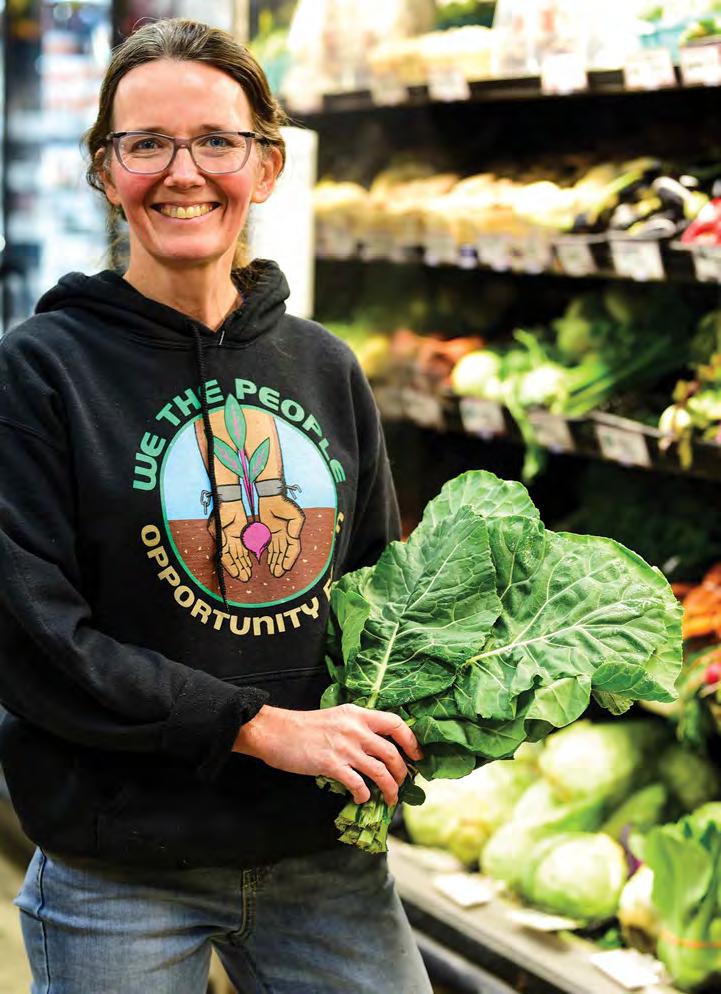

Fun ways to be visible in the community, and connected.

We're looking for a new columnist for our ongoing CW Kids Column. Each issue, the columnist writes a feature article which includes 3 or 4 profiles of interest to parents and their kids. We focus on people, organizations and businesses offering cool, fun, meaningful and sometimes therapeutic activities, programs, events and classes for kids. Great opportunity for a writer who is also a parent.

We are always looking for good articles about the holistic scene… reportage, personal journaling and essays, profiles, interviews, journalistic explorations, and other feature writing.


Modest but respectable pay. If you might be interested, please write to crazywisdomjournal@crazywisdom.net.
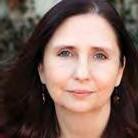

developers, and farmers at the Local Food Summit hoping someone else would advance the idea. But when no one stepped up to spearhead the effort, Sample and Brinkerhoff realized that they were the ones to do it.

“We are business people. We did the research,” Sample said. “The Ag Census reported a loss of over 57% of Michigan farmland since the 1950’s.” (Subsequent surveys now show the opposite.) “We are growing. Now Washtenaw County boasts the highest direct to consumer farm sales in Michigan, and the 10th highest in the country.” Argus can have a real impact here. “Can we be part of this return to the land? It is a problem we are willing to fix. It was kind of a test that we were ready to take.”
Sample and Brinkerhoff are certainly visionaries, but along with a dream, it was their keen business sense that laid the groundwork. Their market research affirmed that Ann Arbor is ideally suited. An active farmers market, a good pedestrian district, situated near farming communities, and an educated and progressive populace were all crucial business indicators.
General manager Laura Matney makes the mission clear. “Our goal is to get the most money back into the hands of the farmers while paying employees fairly.
But more than just being smart businesspeople, what makes Sample and Brinkerhoff so outstanding in their field is their convictions. It is clear they didn’t pick a business simply for success. Their query was much deeper, and that points to an aspect of these two that is truly at the heart of Argus. They care. Their business plan was crafted to amplify their care for their environment, their town, and their community. It overflows, so that every employee has enough extra to extend that feeling forward. They only needed to convince the farmers.
The young experimental farmers were the earliest to sign on. But it wasn’t until the first established farm came aboard that the project could really progress. It was when Tantre first joined their affiliates that the whole experiment finally found its form. “Kathy and Bill approached me to be a supplier of vegetables for the Liberty Argus. I worried that I didn’t have the time to display vegetables, but Kathy said don’t worry, you can just bring them to us and we will display your produce for you. That made it very easy,” Richard Andres at Tantré Farm remembered. “It quickly became one of our strongest markets overall. They were very positive and complimentary, encouraging us to bring our crop twice weekly, and they gave us free hot chocolate or coffee every time. Kathy and Bill built such a good neighborly affection,” he mused. “There’s a great orientation toward service to customers and vendors.”
Traditionally, farmers have received 14 percent of the sales of their products, according to USDA economists who have tracked the farmer-marketer relationship for 25 years. At a farmer’s market it takes up a whole day to run a booth. At Argus the farmer owns their inventory, they set their own prices, and maintain 70% of the sale. All they have to do is drop off their boxes. Argus takes just 30% for their efforts. The growers know how important that is. “There are no other organizations or stores that offer such generosity to the growers, no other stores that offer such a service. Nobody even comes close,” raved Richard Andres. “Everything is extraordinarily well organized, and people seem to truly enjoy themselves whether they’re employees, customers, vendors, or farmers. At this point it seems to be a very simple narrative, however this is truly extraordinary.”
While getting to know Argus I spoke with their general manager Laura Matney. As a business major with a link to local farms she was fascinated with the low-profit limited liability corporation LC3 model of a mission driven for profit business. Matney explained, “The formula has the agility of a business with the heart of a non-profit. The articles of incorporation are designed for the profit to be given back to our mission, which in this case is the farms. The consignment model was the ideal platform, because it just naturally funnels the lion’s share of our proceeds back to farmers and meets the mission.”
Jae Gerhart was perfectly positioned to see the impact that Argus has had on the food system and all the hands that till the soil of that system. As the County Local Foods Coordinator for MSU Washtenaw county, her job was to know every farm and farmer, and to work with them to actively increase local food sales. “For local farmers there are a lot of ways to sell direct to the consumer— farmers’ markets, roadside stands, CSA, and farm membership programs. Selling to grocery stores often requires large volumes, expensive food safety certifications, and a devoted sales team. Argus offers a way different mode of operation than what our local farmers are used to. That is why this shop is so important,” Gerhart affirmed. “It allows farmers to sell in a grocery store setting without changing the down home / local truth of their business.” Which is a big part of the appeal. Argus shoppers want to see the soil on their root veggies.
We spend a little more of our effort and budget, and for the investment we get triple the value.”
“The model has provided our farmers a crucial marketplace and a real recovery of their time. And the local food system here is thriving thanks to Argus,” Gerhart raves.

Now that 250 plus suppliers are affiliated, providing everything from frozen and fresh goods, cookies to cucumbers, bath and body products throughout the year, that 30% of sales is sufficient. Argus has been able to grow from the initial 14 to now 60 employees, at three locations and expanding. Now their expansion is focused on outreach. Their education sector is what will really amplify this movement and this mission. A free hour-long webinar offered every month reaches upward of 200 new advocates annually who will go on to amplify the local food movement by teaching, farming, or feeding their own neighbors. Their three-day intensive course that lays out all the nitty gritty details of how to open a farm stop has been attended by new operators from far and wide. Agricole in Chelsea, MI is an example. Increasing local food sales is the goal. “And we are just happy that we serve the same mission,” Sample assured. “It is not about competition. That is why we made our offerings open source.”
Increasing local production can be approached from many different directions. And Argus seems active in them all. Online sales and pick-up and delivery happen every day. The ‘Double-Up Food Bucks’ program allows them to offer double the value for every EBT dollar spent. Their weekly flower subscription lasts the season, and a weekly produce box aggregated from different farms goes out year-round. Will Moyer and Rosie Estes run the program carefully to provide a taste from all the producers. Argus’s General Manager Laura Matney makes sure to note, “We do not intend to compete with each farm’s CSA’s. They are awesome at what they do. We do something different. Our boxes are smaller for an average family consumption.” Now about 190 boxes go out each week.
Sample and Brinkerhoff are now even landowners themselves. The Brinkerhoff family invested in farmland in the Dexter area. Now John Cox, who is farming the land, has turned the corn and soybean fields back into pasture lands. Baseline Farms started in late 2016 with acres of sandy soil and 30 head of cattle. Today there are 170 cows, calves, steers and bulls on 190 acres of pastures. The heritage breed cattle are grass fed and frolicking for happy beef you can be confident in. Cuts are offered in the frozen meats department at both Argus outlets, of course. It is just another piece in this perfect puzzle that Sample and Brinkerhoff are stewarding.
son Will
U-M
Molecular Biology and Sustainable


“Here in Michigan,
we can figure out the land management issues, there is a real option to make a great impact. I think the future is really bright in this region.” He credits Argus and his family for this focus. From the dinner table to the lecture halls and back to the field, it just seemed natural to him. “Our food was from friends—our community fed us. And land is what they were concerned with. Soil science was part of the meal, it seemed.” His ambitions are great yet measured. “The ‘many little hammer solutions’ allows us all to play our part. Building back our fertile land and carbon sequestration doesn’t happen overnight. But if we recognize a whole system the change is approachable.”
The knowledge that the Argus team has gained through trial and error, mayhem and mistakes over the last eight years is worth sharing. “It has been a joy and a journey. So. we have made it open source. We were so glad to see Argicole in Chelsea get going with some good guidance. It just gives more outlets for our local farmers to thrive here. And that is ultimately what it is all about,” Kathy Sample reflected generously. The equation lacks any element of competition. “We are lucky, we don’t worry about that. We don’t negotiate for lower prices, or exclusive arrangements. We work with our suppliers on their behalf. Our vendors are also customers and we do this to serve them.”
The solutions Sample and Brinkerhoff have cultivated seem to work seamlessly these days, but their systems were not always so smooth. Producers throughout the region have to entrust their treasures to be properly accounted for, no matter who is at the counter, even as the inventory doubles in many directions. Every new success has meant a new method had to be invented in step. They wouldn’t have had such success without their amazing team. Sample calls them “A freak show of talent” shaking her head in disbelief. “The intake system was developed by one of our ‘local foodavores” (what they call their starting staff.)
“Brian Barch was receiving and displaying the produce and chatting with the growers like we all do, when he realized we needed better accountability. He’s a genius.”
But more than just being smart businesspeople, what makes Sample and Brinkerhoff so outstanding in their field is their convictions. It is clear they didn’t pick a business simply for success. Their query was much deeper, and that points to an aspect of these two that is truly at the heart of Argus. They care.
Brian Barch tells the story from those first few weeks, when a grower thanked them for his first itemized pay-out for apples and spinach. “But,” he indicated, “I haven’t grown spinach in years.” The box had been mislabeled. “Now Argus has a protocol to have stickers and barcodes put on each box and item we receive immediately.” There have been obvious improvements and more subtle changes. “We were able to take what we learned at Liberty and apply a lot of fixes when we opened the Packard location,” Barch continued. “We knew we needed more room behind the coffee bar, and the sales counter at the newest market is scalloped so there’s space for customers to arrange their groceries.” The builder, Nicholas Durrie of Oak Leaf Design and Build has had a hand in the design of the store from the beginning.
Matthew Keating can comment on the improvements from every angle. Keating came to Argus as a farmer first. He worked at Black Locust Gardens, which sells their dried herbs with Argus. And then he took a job behind the counter at Argus before joining the Oak Leaf design team. “It is kind of luxurious to have so much space behind the counter.” As a previous employee, he knows. “Argus cares a lot about the employees. Part of their mission is shaping a journey of food for young people coming in at an entry level. They may say they are localvorian to get the job and then with the nature of the work, they find out that there is so much more behind it.” Keating continued, “What Bill and Kathy are doing is very bold. They are putting their money where their mouth is. They are absolutely pouring their hearts out into this undertaking. And the generosity has had a massive impact on the local food movement here.” Converting college kids to the scene might be another of their efforts. But their take on it is much more humble. “We just want our workers to be happy and respected. So, we listen to them and are happy to take their advice,” Kathy Sample said modestly.

Recently with the addition of local wine and beer, Argus has ushered in a whole new bar scene with the Tavern at the Packard location which now stays open until 9:00 p.m. As café manager, Meg Goldwyn books a calendar full of activities, food pop ups, trivia nights, and live music to fill the evening social hours
Now the bagging area has levels for shorter and taller cashiers. Fine-tuning the rustic style and comforts for the customers is what Oak Leaf Design and Build is famous for as well as more nuanced ways that every vendor and employee can appreciate, even if they can’t see the correlation. While dividing into two storefronts on Packard seemed risky, both spaces have had surprising success. “Our customers are seriously amazing. They are super loyal to unimaginable lengths. All through the pandemic they just held on through whatever new schemes we had to implement. They are willing to work with us,” GM Laura Matney reports. “The bigger grocery space now has room for shopping carts which lead to a jump in sales. These neighbors have embraced every new advancement.”
Their Packard location cafe manager, Meg Goldwyn, was one of those neighbors. Before she worked here, they moved from the North side of town to the Burns Park neighborhood. Goldwyn said, “We were sad to let go of our nightly stroll to Liberty Argus to get each night’s ingredients before we made dinner. It was the perfect after-work outing to get out together to stretch our legs and see some friendly faces while we got some salad fixings or local lamb chops for supper.” When the new Packard Street location opened, she was thrilled. “It came to us!” They made it their tradition again whenever possible. Her appreciation for the destination took on another level when she picked up the weekend hours helping in the back. “When the business separated into grocery and cafe locations, they asked if I would take on the role as the cafe manager.” She got to quit her commute and walk to work at her favorite spot in the neighborhood.


Recently with the addition of local wine and beer, Argus has ushered in a whole new bar scene with the Tavern at the Packard location which now stays open until 9:00 p.m. As café manager, Meg Goldwyn books a calendar full of activities, food pop ups, trivia nights, and live music to fill the evening social hours.
“The management is really fun to work with,” assured singer songwriter Anne Erlewine. “Meg makes it easy.” Erlewine has played the new venue a few times so far. “The first time I played out after the pandemic was at the Liberty location, and it felt so right to share my new songs for this scene. When the new tavern opened, it was the first place I wanted to play, since they did so much for the community during the shutdown. They have a heartbeat, a pulse, bringing the community together that feels rare to me.”
They rearrange the tavern space to make room for an audience of 20 or 30. “Like a house concert, it feels so warm and supportive here,” shared Erlewine. Her audience of friends and fans seem to agree. The reception is palpable. This is a special place to sit for a beer and see live music together. “Part of creativity is doing it with others. I got to oxygenate my songs by bringing them out into
the community and see their strength through the reception of others. It is important to music and to art to have a conversation about it,” mused Erlewine.
This all completes the ultimate goal, “to grow and uplift our community by crafting the kind of place that people want to wander in,” said Sample. This little grocery store cafe is designed to play a big role in our town. Not only local but local, local. With so little parking, they had to believe their customer base would be within walking distance.
Argus is one mile down Packard from my house. I walk it for the exercise and for the ice cream. The local dessert is my motivating force. My 14-year-old can be bribed by the fresh blueberries and just picked mint that is blended into Calder Dairy ice cream right before our eyes. The machine looks like a hardware drill that they lower into the concoction and out comes the most amazing and healthy treat. Brinkerfoff sourced the Little Gem machine on the sly. Sample and Brinkerhoff had become fans of the process in New Zealand on their vacation. “That’s how we vacation. From farms to dairies, to gardens anywhere we go. In New Zealand each farm would each have this contraption to mix that days’ pick into soft serve. We were crazy for it, and then I overheard Bill on the phone to someone with a Kiwi accent and then this funny stainless-steel contraption arrived.” Now the community can all be crazy for it too.
Ann Arbor has Argus to thank for safeguarding a piece of our soul. We might not really have noticed, but with a longer vision, it is clear, this family of businesses is the beating heart of our hometown
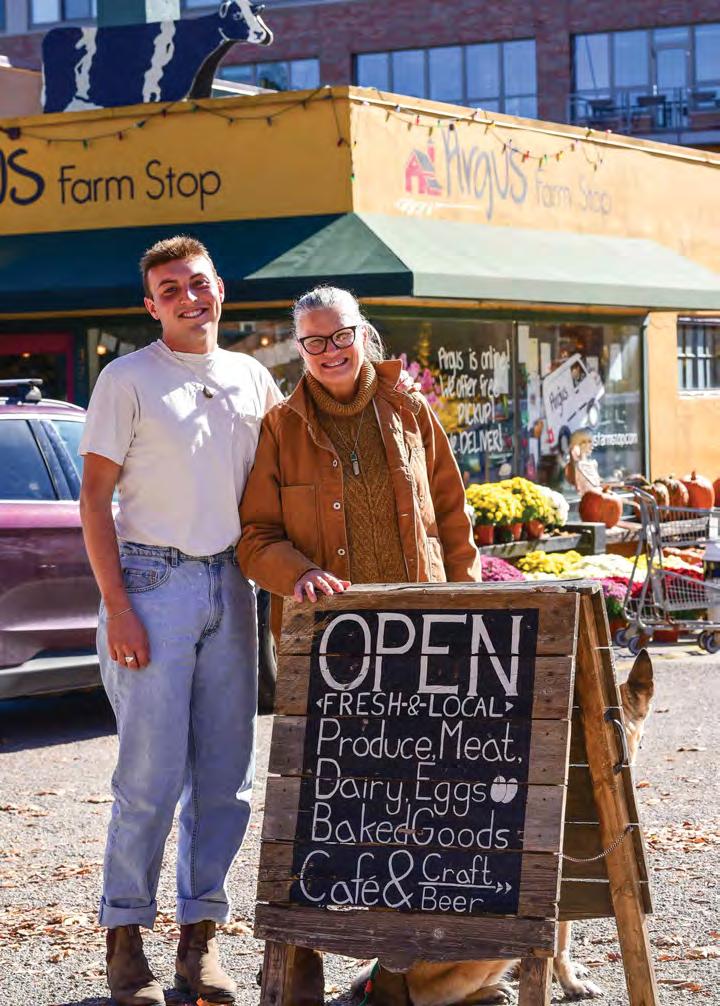
Along with with our dessert, my son and I pick from a big selection of prepared meals from Juicy Kitchen, Zilke farms, Uncle Peter’s Pasties for some nutrition. My son picks a quiche and only shares one bite. I get it, it is that good. Meg is proud to receive and sell the hand-made concoctions. Twice a week Aaron Ziola from Juicy Kitchen delivers sandwiches, wraps, sauces, salads and the quiche made with veggies from Tantre farms. “I know all the hands that went into making this wholesome dish,” raved Meg. “It gives such meaning to the term holistic when I can sell this delicious treat to a customer friend. It is a complete circle of our Argus community coming together on a forkful.” Ziola is thrilled with the arrangement as well. “We wouldn’t have made it through the pandemic if it weren’t for Argus,” he tells Kathy. She returns the glow, “The athletes eat up your breakfast oats and parfaits like it’s the only nutrition in town.”
As I spent the weeks witnessing Argus for this article it became clear, Ann Arbor has Argus to thank for safeguarding a piece of our soul. With a long vision, a brave mission and a generous disposition this family of businesses is the beating heart of this hometown. With this focus on feeding us all, the farmers, staff and customers feel received, known, and nourished here in all the ways. Our minds, bodies and the larger civic body all benefit. The values that matter are on display right along with the root vegetables and baked goods.
Argus Farm Stop - Packard Market
1226 Packard Street, Ann Arbor, MI 48104. (734) 997-5448. Produce, meats, dairy, and grocery. Open 8 a.m. to 8 p.m. daily.
Argus Farm Stop - Packard Cafe
1200 Packard Road, Ann Arbor, MI 48104. (734) 585-5441. Open for café and tavern service. Open 8 a.m. to 9 p.m. daily.




Argus Farm Stop - Liberty Cafe & Market
325 West Liberty Street, Ann Arbor, MI 48103. (734) 213-2200. Open for in-store shopping and café service. Open 8 a.m. to 8 p.m. daily.
This column is a look at two brave souls who took a leap of faith to open their own business. What follows is a personal profile of Chelsea and Mike Carosello who are following their dreams and thriving despite the odds—and Covid.
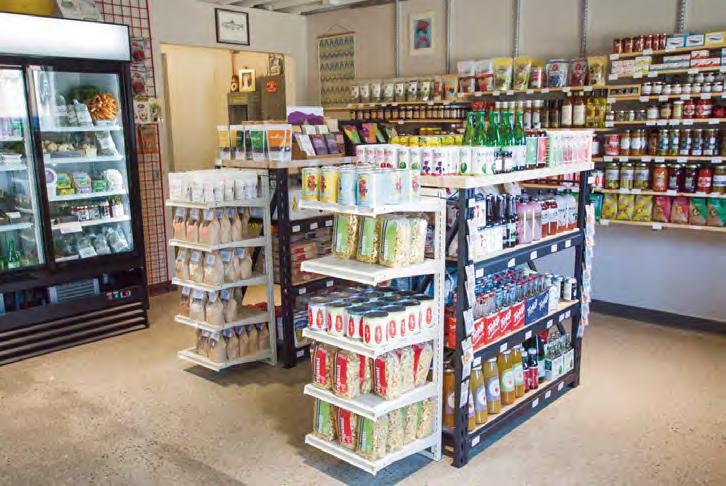

3126 Broad St. #101
Dexter, MI 48130 (734) 253-2315
info@carosellopasta.com
Open Thursday & Friday from 11 a.m. – 7 p.m., and Saturday & Sunday 10 a.m. - 7 p.m.
“A pound of rigatelli, please.” I heard the gentleman behind me make his request at the fresh pasta and cheese cooler while I took in my surroundings. Lining the shelves of Carosello Pasta: Pastaficio and Market in Dexter, were colorful ingredients imported from Italy, such as anchovies, porcini mushrooms, and extra virgin olive oil—just to name a few. I also recognized some of our Michigan favorites like McClure’s pickles and cocktail mixers, as well as locally sourced fresh ingredients. I continued looking around the market and listened as two other shoppers next to me contemplated their tomato sauce options. It made me smile to hear them discussing which ingredients they might need for the dinner they would cook together for date night. What could be more perfect? Italian cuisine is as well known for being romantic as it is for being simple.
When the customers had all cleared out, I approached the counter and introduced myself to the cheerful brunette behind it. Chelsea Carosello introduced herself as the wife in the husband-wife team behind Carosello Pasta and said that her husband, Mike Carosello, had just stepped out moments before I arrived. That worked out well, because he wouldn’t be around to refute the adoring remarks his wife offered about him, and Chelsea did not hold back as she told me about Mike’s seven years in Italy, including his culinary training in Florence. She described her husband’s dedication to his family, and how the loss of his father inspired them to grow their small business even when the Coronavirus pandemic complicated their plans.
The Carosello’s happened to meet in Seattle. Though Mike is from St. Louis and Chelsea grew up in southeast Michigan, they shared the common background of being raised in predominantly Italian families. Chelsea explained that this meant they both knew what it was like to have Thanksgiving dinner with all the traditional American dishes along with spaghetti and meatballs. Their appreciation for their cultural roots—
“We were really intentional about the products we decided to carry, and while we do partner with a few distributors where we’re able to order from catalogs, many of our items are sourced directly from small businesses and local farms, which requires building those connections.”
She described her husband’s dedication to his family, and how the loss of his father inspired them to grow their small business even when the Coronavirus pandemic complicated their plans.
especially the food—was reinforced each time they traveled to Italy.
Chelsea explained their business’ focus and how their journey to bring homemade, authentic Italian pasta in Michigan was challenged by the pandemic. She shared why they are dedicated to continuing that journey no matter what.



I use my ability to see clearly and shift energy to help you access your magic. Develop your awareness. Bring forth solutions and decisions which are authentic to you.
Laurel Decker: Is there a memorable moment, good or bad, associated with having a business during such an uncertain time that you could share?
Chelsea Carosello: We decided to take the plunge from cottage food business to retail in early 2020. This was just after Mike’s dad, Louie Carosello, passed away from esophageal cancer. He and Mike’s mom, Madeline, were living in Florence, Italy at the time. Mike and his siblings were able to make it to Italy in time to be with their dad in his final days, amidst all of the chaos, flight cancellations, and trepidation surrounding international travel (especially to/from Italy at that time). Losing him has made us all too aware of how fragile life really is, and Louie is ultimately responsible for us running full steam ahead to chase this dream. So, we owe a lot to him and try to channel his creative spirit and kind heart into everything we do.
Discover the possibilities. Book a consult on me.
https://go.oncehub.com/Ruth-Wilson
Visit www.ruth-wilson.com and learn about four ways you miss the magic of manifesting. Start using your magic today. email • ruthwilson@gmail.com
Laurel Decker: Were there any unexpected benefits that came from opening during the pandemic? If so, what were they and why do you think it’s unique to the pandemic?
Chelsea Carosello: At the time, all of the building delays felt catastrophic to our small business. In hindsight, having a year for us to continue thinking about how we could best serve our community was ultimately to our benefit. We had always been a dried pasta company and planned to continue on that trajectory, with wholesale our main focus. But as the pandemic dragged on and we continued to see larger public support of localized food retailers, we started making moves to bulk up our retail selection—including our deli case full of fresh pasta, which has become the cornerstone of our business.
We wanted to provide more of a one-stop shop, allowing our customers to avoid large, crowded grocery stores, while being able to grab everything they need to make a standout, restaurant quality dish at home. We were really intentional about the products we decided to carry, and while we do partner with a few distributors where we’re able to order from catalogs, many of our items are sourced directly from small businesses and local farms, which requires building those connections. Forging such relationships has been one of the most rewarding aspects of this work, where there is a real solidarity among small businesses here, especially fellow food producers.

Laurel Decker: What is the most useful personal skill or trait that you, and/or your staff, have implemented to keep the business going?
Chelsea Carosello: First and foremost, it’s all about the pasta. It really is something we’re passionate about, and the difference that our customers discern between our pasta and much of what is available in grocery stores keeps them coming back. But I think our success also comes from building relationships with our community. Both of us love spending time getting to know the people in our shop; I think it’s just in our nature. We weren’t sure how quickly (or if at all) we would have regulars, but we already have so many folks that come in every week. We know them by name, we bring in new products with particular customers in mind, and we’re excited to share what’s on the horizon with them. In return, they are so kind to us, and they keep supporting our small business.
Laurel Decker: What keeps you motivated to persist through the challenges of business ownership?
Chelsea Carosello: We love this work, and Mike is deeply committed to the craft of making pasta. The days are extremely long, but the weeks are just as short. We don’t really know how to operate any other way than at maximum capacity, for better or worse. Between our small farm and the pasta business, our plates are very full. But we persist out of a love for connecting our community through food—a tale as old as time.
Laurel Decker: When did you first start planning to open the business, and when did you actually open the doors?
Chelsea Carosello: We had been operating as a cottage food business out of our home since early 2019, selling at various farmers markets. We decided to pursue the business in a much larger capacity in early 2020 and began looking for properties while Mike was still making pasta in our home. We signed the lease on our commercial space in early 2021, but it took a full year to complete the required buildout due to pandemic related delays (permit backlogs, labor shortage, etc.). We finally opened the doors to our pastificio and market in April 2022.
As I purchased a few items for my own attempt at Italian cuisine, I understood why Carosello Pasta was a thriving business even amidst the uncertain times in which it was built. Carosello Pasta was founded on Italian love and simplicity and supported by a special community that welcomes those qualities. And just like her appreciative words about her husband, Carosello can’t say enough about the people who shop at their market. She adds, “Heck, some of them have even brought us tupperware with pasta dishes they’ve made for us to try! I know everyone says this, but we really have the best customers here in Dexter.” That says it all.
“Losing him has made us all too aware of how fragile life really is, and Louie is ultimately responsible for us running full steam ahead to chase this dream. So, we owe a lot to him and try to channel his creative spirit and kind heart into everything we do.” It
The vibrant red and warm golden foliage of autumn heading west on I-96 was a calming backdrop for a three-hour drive to Holland. Known for its annual tulip festival, the city provides visitors a chance to experience a slower pace year-round. While the greater Holland area offers a variety of activities, central Holland has its share of historical, recreational, and cosmopolitan offerings. Within walking distance of these experiences is Bonnie’s Parsonage 1908 Bed and Breakfast, an accommodation alternative with ties to the area’s Dutch heritage.
A crafty storyteller, Verwiys’ willingness to share her experiences and family history is a key element that distinguishes the Parsonage from more standard accommodations.

Nestled in a residential neighborhood, the Parsonage is immediately recognizable by its white arch in the courtyard entrance and lush gardens. Both are an early indication of the attention to detail that exemplifies the property. Interior features such as dark oak woodwork and leaded glass windows are credited to the Prospect Park Christian Reform Church. With roots in the Dutch Reformed Church of the Netherlands, the Prospect Park Church built the home in 1908 to provide a residence for its minister and the site served in that capacity for several decades.
While the greater Holland area offers a variety of activities, central Holland has its share of historical, recreational, and cosmopolitan offerings.

Purchased by Bonnie Verwiys in 1974, she spent ten years preparing the property for its opening as a bed and breakfast. Given its history, the Parsonage’s early 20th century tone has a sophisticated flair. Verwiys’ fondness for antiques (many acquired from Western Michigan shops) evident throughout the home. Guests can expect every room to have distinctive touches. In a sitting room adjacent to the formal dining room (where guests are welcomed to enjoy Verwiys’ signature-baked pancakes for breakfast), prominently displayed photos
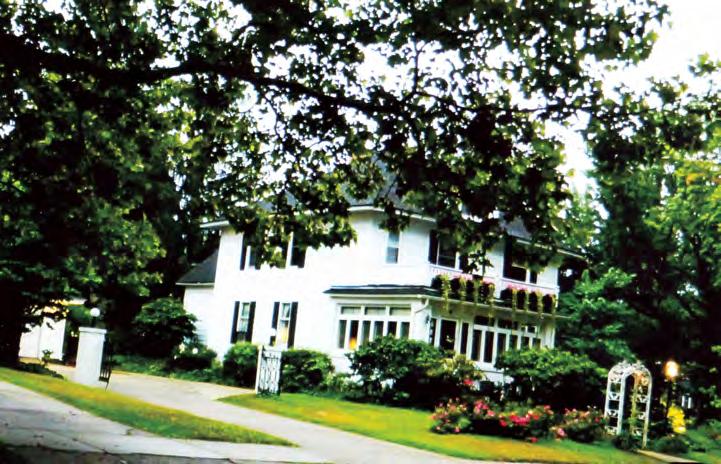
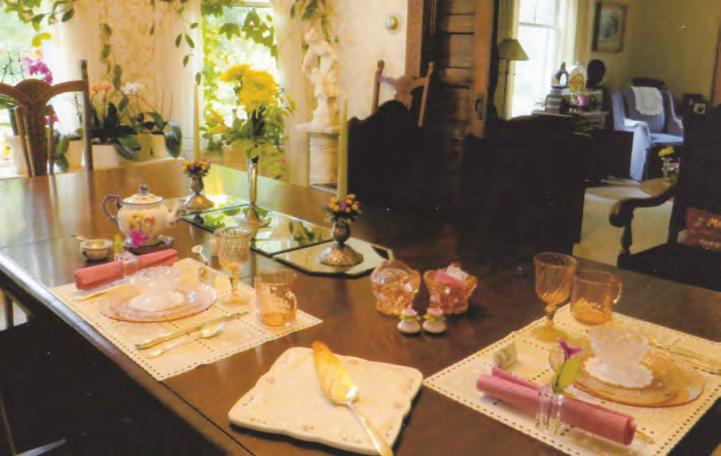
and artwork serve as a homage to Verwiys’ family . A crafty storyteller, Verwiys’ willingness to share her experiences and family history is a key element that distinguishes the Parsonage from more standard accommodations. The B&B’s stylistic yet homey vibe has been recognized nationally by Fodor’s and Midwest Living, while its gardens have received awards from local organizations.
The Parsonage’s tranquil garden nicely compliments the historical settings of the accommodations, transporting guests to a different era. During warmer seasons, guests can relax in an outdoor garden patio. A large foyer provides covered seating and a distinctive conversation piece—a dollhouse-sized version of the B&B. Two indoor sitting rooms provide a cozy space to watch television, enjoy music, or have quiet time before retiring to upstairs bedrooms. The elegant character of the Parson’s Room is defined by a dark walnut bed frame with a textured headboard that nearly touches the ceiling. Kimberly’s Room has floral accents and patterned wallpaper that radiates a whimsical spirit. Brian’s Room, formerly a study that shares a bath with Kimberly’s Room, has been dubbed the “Patriotic Room” with Americana-themed decor. Every room has unique and delicate features that would appeal to guests with an interest in history as a backdrop to their visit.
While the Holland area boasts several nature trails and beach areas, nearby green spaces provide walkable outdoor excursions from the Parsonage. Two blocks east of the B&B is Prospect Park. The nearly eight-acre plot was purchased by Holland citizens in 1901 to save native forest and sold to the City of Holland in 1907 for $1. Now mature trees dot a landscape that includes walking paths and picnic tables. A five-block walk northeast of the B&B leads to Rosa Parks Green. Home to a baseball field in the 1940s, the ADA accessible park now provides basketball courts, soccer fields, walking spaces, as well as picnic amenities. Walking through residential neighborhoods, visitors can feel a sense of connection with present-day Holland that contrasts with the historical focus of the B&B.
For guests interested in more cosmopolitan settings, a casual 30-minute walk north of the property ends in the heart of downtown Holland. Downtown Holland is ground zero for the annual tulip festival, but a range of dining and retail selections on 8th Street are available throughout the year . Can’t decide where to eat? Food lovers can sample a variety of culinary choices during walking excursions hosted by Holland Tasting Tours (hollandtastingtours.com). 8th Street is also home to the farmers market (check out their winter hours at hollandfarmersmarket.com), a favorite place to discover local vendors and performers while supporting local businesses.
Visitors to Holland may see shades of Ann Arbor. Both communities are home to academic institutions, have vibrant downtowns, host well known annual events, and offer green spaces for recreational activities. But Holland’s Dutch heritage provides a distinctive cultural experience unique to Western Michigan that’s close enough to Ann Arbor to provide an accessible weekend escape.
Bonnie's Parsonage 1908 Bed & Breakfast is located at 6 East 24th Street, Holland, Michigan 49423. The Innkeeper can be contacted at (616) 396-1316 or learn more about the Parsonage Bed and Breakfast at bbonline.com/unitedstates/michigan/holland/parsonage.html.



Almost everyone has eaten in an American style diner where burgers, fries, and homemade pies are the best sellers. A place where everyone knows one another, coffee breakfasts for groups of friends start many people’s mornings, and dinner take-outs end the workday. In Ann Arbor there is a diner that mixes classic diner fare with a bit of Korean flair. Around 1990 Bell’s Diner started serving Korean food as an addition to the already traditional all-American favorites. One can drink unlimited coffee with scrambled eggs and a side of kimchi. It is quite a wonderful mix of cultures that owners Ben and Anna Kwon, and their family of staff, serve Ann Arborites every day.
The indoor space is bright after a recent interior re-do. They offer free parking that is shared with Stadium Hardware. Many local trade’s workers know this well as Bell’s has become a place to meet and eat after picking up supplies. My father and his buddies ate at Bell’s together at least once a week when they were younger. The Kwons know all the regulars quite well. Ben Kwon said, “Our guests mean the world to our family. They are the reason we open our diner every morning. Nothing better than catching up with the community over a cup of coffee.”
My personal favorite dish is their Bi-Bim-Bop with a side of cucumber kimchi. Most Korean restaurants serve cabbage kimchi, but Bell’s kimchi was so tasty and popular that they had to find a vegetable that could be more easily prepared. I also like buying a pint of their Korean BBQ sauce that flavors the cucumbers. It is excellent on eggs, grains, meats, and vegetables. Another menu favorite is their Tuna Sensation. It is a tuna melt with zip in addition to all the attributes that a perfect “melt” should have: soft melted cheese, creamy mayo tuna salad, crunch from lettuce, and a perfectly grilled bread holding it all together.
But what really holds it all together at Bell’s Diner is the feeling that you are like family when you walk through the door. At one time they had a wall of fame filled with photos of their longtime customers and sometimes their customers’ kids and grandkids. Some of those folks have moved on or passed away. Even though the photos are no longer adorning the walls, the Bell’s website still has a section of customer photos—like a family photograph book. This is how they feel about each person served at their tables. It is one big happy family for twelve hours a day. Before they serve the public, the Kwons allow their employee-family to cook their own food, which is usually South Korean, and the whole crew eats together.
This daily ritual is how the Korean menu came about. Customers smelled the family-staff meals coming from the kitchen and started asking if they could try this unique smelling fare. The Kwons started a weekly Korean Special then
a daily special until they finally added a Korean section on the regular menu. Bi-Bim-Bop with Bulgogi (spicy marinated beef) and a spicy chicken meal called Dok Bokeum are the best Korean menu sellers. No matter what you try on their menu, you will not be disappointed. The Kwons take great pride in their kitchen and care deeply about each plate that is served. You can tell from the following interview that Bell’s will be around for a long time to come for all to enjoy and future generations to share.
Angela Madaras: Where did the name Bell’s Diner come from?
Ben Kwon: Bell’s Diner actually came from the original owner. We purchased the restaurant in 1987, so it has only had two owners. We have joked about calling it Ben’s Diner, but Bell’s has a better ring to it.
Angela Madaras: Why did you decide to open the diner, and how long after you moved to the United States did this occur?
Ben Kwon: It [the restaurant] was our ticket to the American Dream. I moved here in 1980 from our hometown in the southwestern part of South Korea and started working as a janitor. Eventually, I got into the automobile industry working in factories. My father was a great technician and knew how to build and repair just about anything, so it was easy for me to get into that field. However, in 1987 we were presented with an opportunity to take over—to become an owner was a goal for me and many other immigrants.
Angela Madaras: Did you have cooking experience or culinary education? Or was your cooking more homegrown?
Ben Kwon: I grew up watching my elders prepare meals and I would help my mother cook for our whole family (I have seven brothers and two sisters). She would have me taste all her meals as she prepared them, and I quickly picked up on all the different seasonings of the dishes and how to tell them apart. I always enjoyed cooking meals that brought our family together. I think I have an intuitive sense of seasoning and preparing tasty dishes. My mom still cooks with us.
Then, I joined the army in 1977 for a few years, and I volunteered to help run the kitchen that served the rest of our soldiers. I would determine what was on our menu, and I managed the line of cooks. There were many times we were very limited on our resources and ingredients, but I think that is where I learned to get very creative.
AM: What are the best sellers on your menu?
BK: Bi-Bim-Bop which is a classic Korean dish with seasoned vegetables on a bed of rice topped with your choice of protein (chicken, beef, or tofu) and an egg. The most popular protein is our Korean marinated beef. Spicy Chicken (aka

Dok Bokeum) is also a very popular dish for those that like a bit of spice!
AM: Why did you decide to make cucumber kimchi instead of cabbage?
BK: There are many variations to Kimchi. The traditional form is cabbage, but cucumber was a good option for us since it is a simpler process. Kimchi got so popular that at times we had to make it on the fly, and it would be much more difficult if we used cabbage. Our customers love our kimchi.
AM: How long did it take you to realize your South Korean dishes were a hit?
BK: When we first took over Bell’s, we kept its original menu as a “Classic American Diner.” We had a lot of family working for us to help jumpstart our business, so our staff meals consisted mostly of Korean food. It did not take long for our customers to smell the good food and ask about it, so we started to introduce one Korean dish each day as our lunch special. Eventfully the response got so great, we had to bring all of the dishes onto the menu full time! Now we are known to be a place where you can enjoy traditional Korean dishes but also get a side of pancakes to get in your breakfast cravings at any time of the day!
AM: We are all immigrants to this country and we each have our own story. Would you share yours with our readers?
BK: When I think about immigrants, I think about how strong they are to have left their whole lives behind to start a new chapter in a completely unfamiliar place. I think about how brave they had to be to move to a place where they didn’t speak the language fluently but ultimately had the courage to take a leap of faith. That was our family’s case, and the unknown was of course terrifying, but it also brought us a lot of hope for a brighter future.
After I got a chance to settle down here in Ann Arbor and take over Bell’s Diner, we invited the rest of our family to join us and start a life here. We offer to be their steppingstone into the states, so they first start living with us and working at the diner to get their feet off the ground until they get enough savings to pursue other opportunities. It is so wonderful to take a look back now and see how far all of our family members have come. Our daughter works in the Tech industry in Chicago while our son is a golf instructor in Dallas.
AM: What was the hardest aspect of moving to America?
BK: The hardest part was getting our whole family out here and there were many years we had to be apart. There is still a good amount of family back in Korea, especially on Anna’s side where we haven’t been able to see them for extended periods of time, but it makes the reunions that much more special.
I first started out in Saline and worked in various other cities in Michigan until we decided to settle down in Ann Arbor.
AM: I find that food brings people together and naturally creates empathy and understanding. Have you experienced this at Bell’s?
BK: Yes! That is why the restaurant industry can be so rewarding even though it is a tough one to be in. It is gratifying to know that we serve as a meeting spot for others to gather and enjoy a meal together.

It was especially hard when Covid hit and we were all forced to be apart.But somehow, we saw the community come together and support small businesses in their own ways. Whether it was ordering carry out through us or even mailing in thoughtful cards with donations, we really felt the love and support of our customers, and it got us through some hard times.
AM: Will you pass the diner along to family or employees when it’s time?
BK: For now, we would like to keep it within our family since it has become such a big part of our lives. When our customers come in, they are greeted by our team, like Anna and Nami, and are excited to join us for another meal. We feel the same when we see familiar faces come through as well as new faces!

Before they serve the public, the Kwons allow their employee-family to cook their own food, which is usually South Korean, and the whole crew eats together.
Ben and Anna Kwon, owners of Bell’s Diner.
AM: What is the greatest gift you have received from owning Bell’s since 1987?
BK: The greatest gift is our customers. We have so many regulars that have stayed loyal from the beginning and they have brought in their children and now their grandchildren in to enjoy. We love to see how all the families have grown, and it brings us joy to see them come back through our doors.
AM: What advice would you give immigrants who want to own their own restaurant?
BK: Work hard and always be true to yourself. There will be troubling times, but don’t give up on achieving your dreams.
AM: Do you cook when you are at home and what are your favorite home dishes to prepare?
BK: I do most of the cooking at Bell’s, so my wife takes over the cooking at home. But when we’re together working the dinner shift, we will just cook a meal for ourselves and eat there before heading home so we don’t have to worry about creating a mess in our kitchen!
When I think about immigrants, I think about how strong they are to have left their whole lives behind to start a new chapter in a completely unfamiliar place. I think about how brave they had to be to move to a place where they didn’t speak the language fluently but ultimately had the courage to take a leap of faith.
–Ben KwonAM: Would you share a recipe from your hometown?
Ben Kwon: Budaejigae: this is also called the “army soup.” During my time in the army, we would always get a large pot of spicy soup and fill it with leftover ingredients we had available to us at that time. It is similar to the concept of a “kitchen sink” meal, but now this army soup is found on nearly every Korean menu if they have a stew section. It usually consists of spicy broth with ramen noodles, spam, rice cakes, and veggies. (You can find a recipe here: cooking. nytimes.com/recipes/1023236-budae-jjigae.)

AM: Has all this been worth the hard work and sacrifices?
BK: Yes, hard work always pays off. We have been fortunate enough to have run a successful business and create a home for our family. Our son Chris, and daughter Lydia, were born and raised here and it is rewarding to see how they have grown up and been given the opportunities that I didn’t have. [Even so,] they are just as grateful and caring of others.
AM: You are so very calm and nice. How did you learn to be kind to fellow humans?
BK: I have learned that everyone has their own struggles but instead of judging them, being kind to others can truly help them get through those times—or at least make it more bearable. I had to grow up at a very young age and my family certainly struggled to make ends meet, but helping others always seemed to be the most gratifying to me.
AM: What is your philosophy of life?
BK: Life is short. Always be humble and give back to others when you can.
The time I spent talking with Ben, his wife Anna, and his daughter Lydia, was special. I came away feeling appreciation for the time I’ve spent eating at their long and diverse table with my extended family. We have learned much and gained much from sharing food and cultures over meals and miles. They taught me that moving well over 6,000 miles to America and starting a business where your family can work and learn, is a gift many will never know. Ben could not share enough of his gratitude for his family’s ability to make their “American Dream” come true. They are thankful for the customers and community that support their business.
You can get a taste of American diner meets Korean flair at Bell’s Diner every day of the week from 8 a.m. to 8 p.m. Bells Diner is located at 2167 West Stadium Boulevard, in Ann Arbor. To take a peek at their menu, go to their website at bellsdinerannarbor.com.
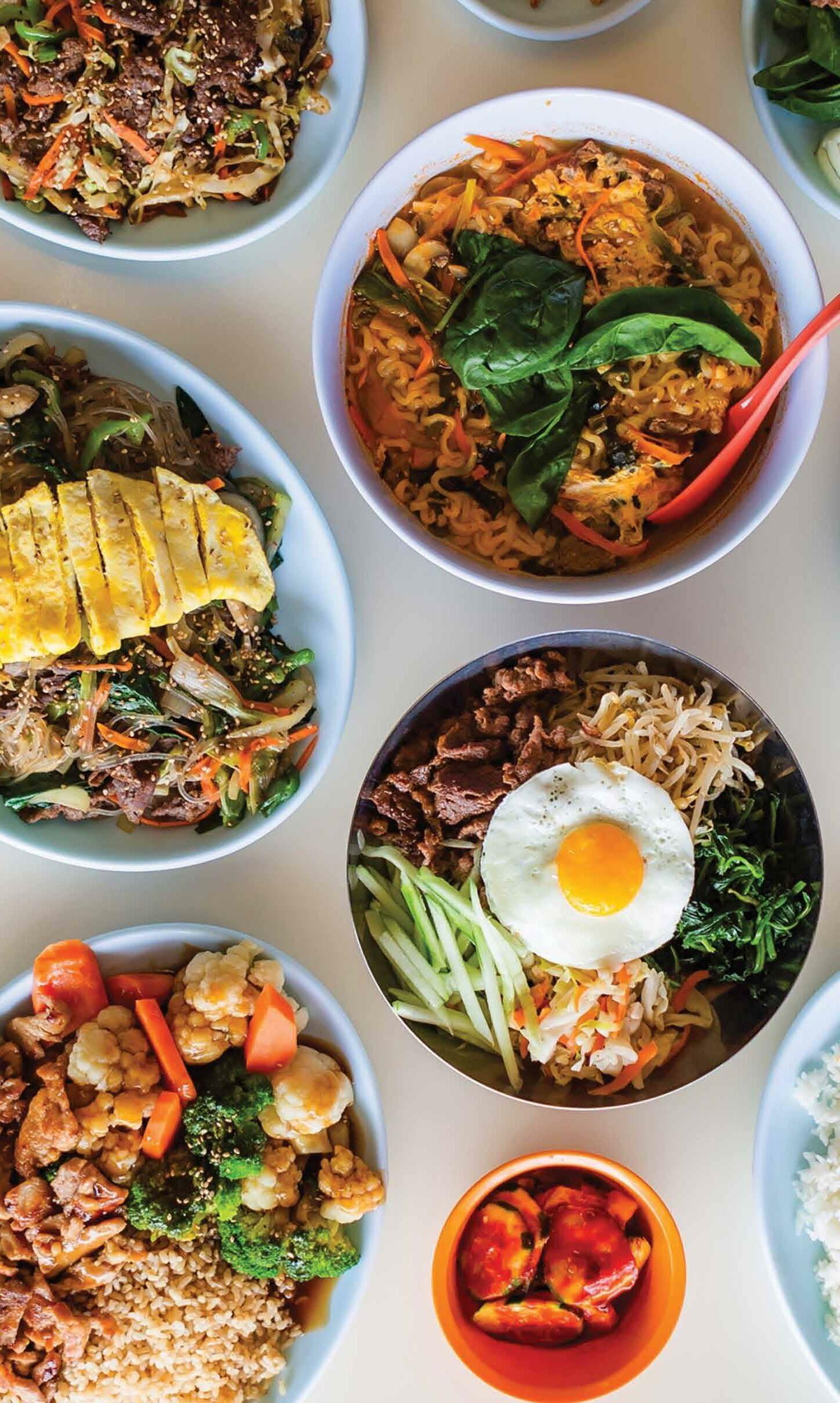
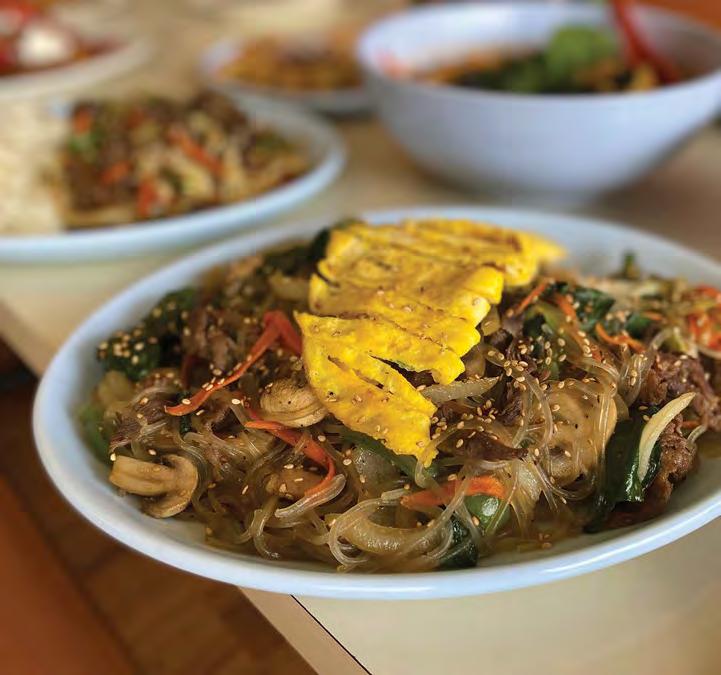
With the colder weather and snow, many of us prefer to stay inside. We might lack the motivation to go for that daily walk that we enjoyed in the warmer months. With the holiday’s many of us ate way too much good food, and your pants are, well… a little tighter. It happens to all of us, especially as we age. If your New Year’s resolution is to drop those few extra pounds, why not try a cup of tea?
I’m sure you’ve heard the rumor that certain kinds of tea aid in weight loss. Some teas help more than others. Let’s start with the obvious facts about tea. Warmer liquids tend to help you feel fuller. Many teas contain caffeine; therefore, they are a natural diuretic to help take off some of that water weight when you consume too much salt. Tea is also not soda or as many Michiganders refer to it “pop,” which let’s face it, aids in weight gain—either from too much sugar or chemicals that cause bloating. There are herbal teas that help with stress and digestion. In general tea can help you live a healthier lifestyle.

The teas that are considered most beneficial to help shed those extra pounds are matcha, green tea, Pu-erh, chai, dandelion, alfalfa, chamomile, and marigold. Some teas, because of their taste, I would suggest adding additional ingredients to—such as spearmint, peppermint, or ginger if you are making your own loose-leaf teas. There are name brand teas that already combine some of these ingredients and market them to aid digestion or weight loss.
Matcha and green tea are loaded with antioxidants and contain caffeine. One tea, known as epigallocatechin gallate, helps boost metabolism. In combination with caffeine, epigallocatechin gallate helps the body break down and burn fats more efficiently.
Pu-erh tea is fermented brown or black tea. Since it is fermented it contains probiotics which naturally aid digestion. It has also been attributed to help control the amount of fat absorbed into the bloodstream and lower cholesterol. It is best to drink it with, or after, a meal.
Chai tea usually contains ginger which improves digestion. It also has the added benefit of lowering blood sugar and can help controlling hunger. I personally like to drink it to help calm my sweet tooth.
Dandelion and alfalfa tea are both cleansing, so they help with constipation as well as keeping your digestive track in tip top shape to better absorb nutrients. Dandelion is also a natural diuretic, so it can help to manage water weight without stripping the body of potassium. Since these teas aid in your body’s cleansing function, it is best to drink them in the morning and evening.
Chamomile and marigold both destress the body as well as the digestive tract. Chamomile can help to keep you calm by lowering cortisol levels. Marigold helps to destress an irritated stomach and bowels, thus allowing them to function more efficiently.
Since this column was about trying to lose weight, I suggest making a Matcha tea banana smoothie.
Combine the following in a blender:
1 frozen banana, peeled
1/2 cup of your favorite milk or milk alternative (I suggest coconut milk.)
1/2 teaspoon of matcha powder
1/2 teaspoon of vanilla
1 packet of monk fruit sweetener (It’s lower in carbohydrates.)
Begin by combining the banana and matcha in the blender. Once this has been completed add the remaining ingredients and blend well. Drink and enjoy!

Downtown Ann Arbor is home to a diverse landscape of breakfast, brunch, and lunch restaurants. Stray Hen Cafe, located at the corner of Washington and Division, has been a wonderful addition. The prices are moderate, and the portions are large!

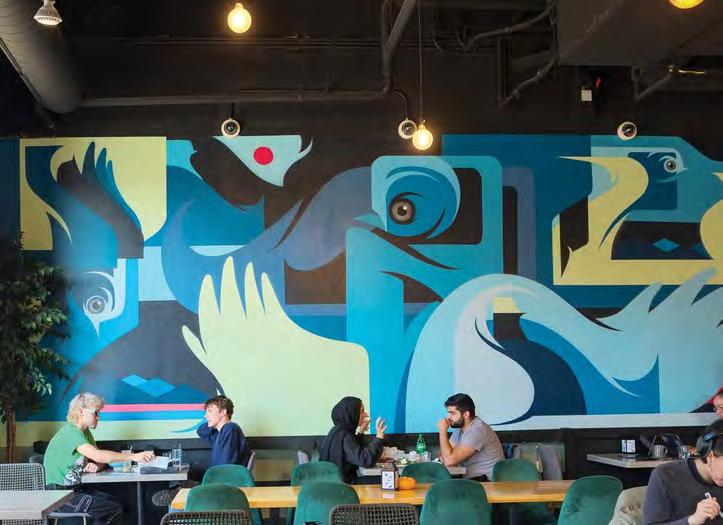
Being so close to the heart of downtown as well as steps from U-M’s campus, it’s a bustling place. At least it was on the early Sunday afternoon that my husband and I arrived. But the staff have the whole process down pat and move patrons through ordering and seating like a well-oiled machine.
When you walk in, a cooler filled with bottled drinks is on the left. Menus are located inside a bit and on the right, and you may peruse one as you wait in line to order. When you near the register, you can also eye all of the delicious plates that come out of the kitchen before they are delivered to their respective tables. This may sway your decisions.
it was carried to another table. I ordered the North Side scrambler, which was made up of egg whites, chicken sausage, avocado, spinach, tomato, and gouda cheese. I chose a cup of fruit over potatoes as a side. There was so much food that I almost had trouble finishing the plate.
Once you place your order and pay at the register, you are escorted to a table with a playing card in a stand. Your food will be brought out to you, but any cafe beverages you ordered, you pick up from the separate coffee counter when they call out your drink. While you wait, enjoy the ambience. Though I was there on an unseasonably warm day, it was still nice to soak up the unseasonably floral green decor. There is a bright, outdoorsy garden feel even sitting indoors.
When our food arrived, my jaw dropped at how thick the slices of bread were in my husband’s apple churros French toast. It was difficult for him to choose between those and the cinnamon roll French toast, which we saw on a plate as

The breakfast menu also contains a selection of savory toasts, including pesto, filet, and salmon toasts; breakfast bowls of various grains as well as grain-free; breakfast sandwiches; sweet pancakes; French toasts; waffles, including a waffle flight; and a dairy-free oatmeal bar. As for the lunch menu, choose between 15 different sandwiches, seven salads, and a protein plate as well as a small selection of sides.
Stray Hen is only open until three, so keep that in mind when planning your day. Stray Hen Cafe is located at 403 East Washington Street in Ann Arbor. They are open daily from 8 a.m. to 3 p.m. For more information call (734) 929-2590, email strayhenannarbor@gmail.com, or visit strayhencafe.com/ann-arbor.

Family-owned K&D Bistro is not only a counter-service restaurant that serves super authentic Vietnamese food, everything is made from scratch with fresh ingredients, and there are gluten-free dishes on the menu. Conveniently located right off the highway, K&D Bistro is worth the trip.
The two main parts of the menu are divided into pho and banh mi. You have nine choices for pho, a naturally gluten free (if you don’t add the packet of hoisin sauce) noodle soup of beef broth, scallions, onion, bean sprouts, and optional cilantro. There are six types of banh mi, six-inch French bread submarine sandwiches with meat (often pork, but not exclusively), pate (yes, in addition to the meat of choice), pickled carrots, daikon, cucumber, mayo, and optional cilantro. The banh mi can be added to a combo with a drink and egg rolls.
I have always wanted to try a banh mi, but my wheat allergy steered me toward the pho. And I am glad it did! I ordered dinner to go. While my husband’s banh mi combo came packaged all together, my pho came in parts. When ordering ahead, you are asked to make sure you have a large bowl. If you don’t, then one is packed with the meal. I had my own, so no large plastic bowl for me. And when they say large, they mean like a ramen bowl or serving bowl. A cereal bowl is way too small to contain everything. You can also request uncooked noodles that you cook yourself at home. I ordered cooked noodles, but they were a bit hard until I let them soak in the hot beef broth. Many of the vegetables were also raw and cooked slightly when added to the broth.

This was some of the most savory and delicious broth I have ever tried, let alone pho, which I ate regularly when I lived in California. This felt much fresher than the pho I had then as well. I literally stood there and watched as the pair in the kitchen made it for me. Serving the different parts of the pho in separate containers was the extra step that sets K&D Bistro apart.
In addition to the pho and banh mi, there is a kids menu and a vegetarian menu. There is only one option for dessert. I couldn’t resist ordering the mysterious honeycomb cake, which neither I nor my husband had ever heard of before. Made with tapioca flour, honeycomb cake is gluten free. It has an almost mochilike texture, but fluffier. (Mochi is gummy and made with rice flour.) The flavor is on the lighter side of sweet but satisfying. I think it would go wonderfully with a cup of tea. Also, the color is green. It comes from the addition of pandan extract, which is similar to vanilla extract.
K&D Bistro is located at 1290 Anna J Stepp Drive in Ypsilanti Township. They are open Monday through Friday from 11:30 a.m. to 8 p.m. and Saturday and Sunday from 12 p.m. to 8 p.m. For more information call (734) 961-8908, email info@kdbistro.com, or visit kdbistro.com.

If you like Indian food, are you ever in for a treat! Aroma Indian Cuisine, located in downtown Ann Arbor, has the largest menu of any restaurant I’ve ever seen, let alone Indian restaurants. I have no doubt this will keep me coming back again and again to try old favorites as well as something new. There is a reason they made Restaurant Guru’s recommended list in 2021.
I would call this a pan-Indian menu with dishes from the north and the south, including a list of Indo Chinese dishes. Both spring rolls and samosas are on the appetizer menu. For breads, you can choose between naan, chapati, and paratha (which originated in Peshawar, Pakistan). Each one pairs perfectly with the plethora of biryani, curries, tikka masalas, and lentil dishes—just to name a few! Meats include fish, shrimp, lamb, and chicken. For vegetarians, there is no shortage of plates made with chickpeas, lentils, and/or paneer.
I was delighted with my choice of Shahi (Royal) Paneer, which hails originally from Punjab, India. This would be beautifully paired with garlic naan. I chose basmati rice instead, though, which was equally satisfying, soaking up the gravy. I’ve heard good things about Aroma’s masala chai, but I chose a mango lassi for my beverage.
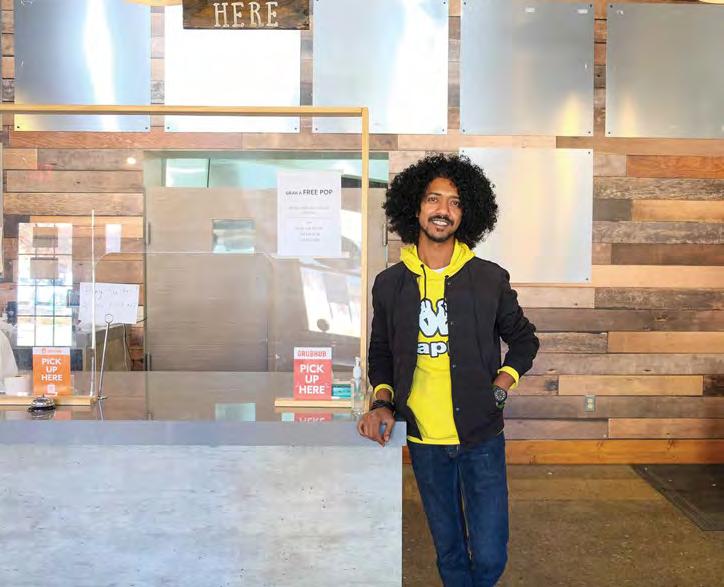
The mango lassi was sweet enough that it could have served as dessert, however, I wanted to give the rasmalai a try. The menu describes this as “a creamy and milky syrup [with] Chenna (cottage cheese) balls.” This turned out to be even sweeter than the lassi. The cheese balls were soft, almost spongy, and really soaked up the sugary liquid. Another traditional Indian dessert on the menu is gulab jamun, or “fried dough balls that are soaked in a sweet, sticky sugar syrup.”
If you are worried about Indian food being too spicy, or not spicy enough, you can choose the spice level. I picked mild because I don’t like a lot of heat. A side of bread or rice also helps soak up some of the spices.
Interestingly, Aroma also has a small breakfast menu. You will find Indian favorites like vadas (fried savory snacks), idlis (steamed rice cakes), irani (onion) samosas, and pongal (a sweet rice dish from southern India). I had never considered Indian food for breakfast, but now my curiosity has been piqued. I’d love to try any of these with a cup of hot masala chai.
Aroma Indian Cuisine is located at 221 West Liberty Street in Ann Arbor. They are open Monday through Wednesday 11:30 a.m. to 10 p.m., Thursday through Saturday 11:30 a.m. to 12 a.m., and Sunday 11:30 a.m. to 9 p.m. For more information call (734) 800-4198 or visit aromaic.com.
delicious, healthy, and joyful it can be.
and she’s seen it do the same in others! She is
200
You can learn more
Hoppin’ John is a simple and inexpensive mix of black eye peas, collards, and rice that’s traditionally enjoyed on New Year’s Day. According to legend, eating this dish can ensure a year of happiness and prosperity. This version is deliciously plant-based and easy to make.

Ingredients:
1/2 lb collard greens cleaned and chopped
1 lb dried and soaked black eye peas pre-soaked, either overnight or quick soak method
1 cup coarsely chopped onion
1 cup coarsely chopped carrot
1 cup chopped celery, including leaves
4 cups water
2 Tbsp garlic powder
2 Tbsp onion powder
1 Tbsp Better Than Bouillon paste
2 tsp liquid smoke
1 tsp pepper
1/2 tsp crushed red pepper
salt to taste
Instructions:
Add all ingredients except rice to a slow cooker and cook on high for 4-8 hours. During the last hour of cooking time, add the wild rice to the pot and continue to simmer until done. Add more water as needed.
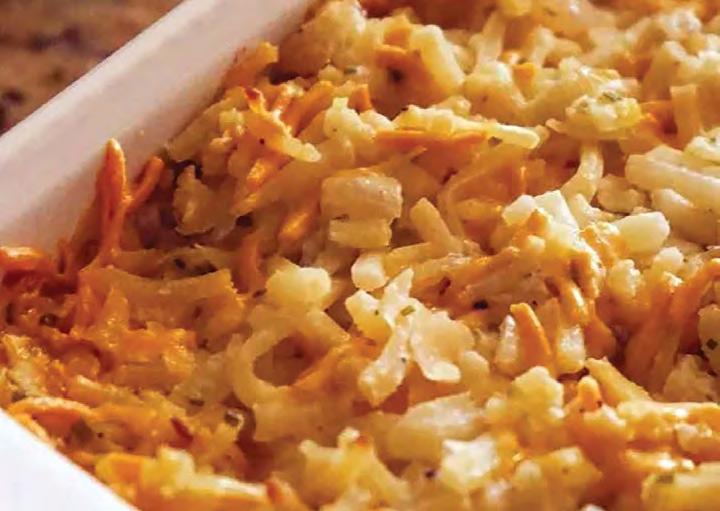
This casserole is full of flavor and is perfect for a holiday or any day. It’s easy to make and uses commonly found plant-based ingredients. You won’t believe the cheese sauce is made from potatoes and carrots! By itself, this cheese sauce can be added to pasta for mac and cheese or used as a nacho cheese dip for chips.
Ingredients for Cheese Sauce:
2 cups peeled potato cubes
1 cup peeled and sliced carrot
¼ cup nutritional yeast
3 Tbsp tapioca flour
1 Tbsp onion powder
1 Tbsp garlic powder
2 Tablespoons lemon juice
1/3 cup oil (mild tasting)
1/4-1/2 tsp red pepper flakes to taste
1/2-1 tsp salt to taste
1/2-1 tsp pepper to taste
1 1/2 cups water
Other Ingredients
8 oz vegan cheddar cheese shreds, Daiya brand or your favorite brand
24 oz frozen hash browns, bag vegan
Instructions:
Place all the cheese sauce ingredients in a high-speed blender and puree until very smooth and creamy. Add more water if necessary for blending. The result should have the consistency of nacho cheese sauce. Taste test and add more salt or pepper if desired.
Once the cheese sauce is blended, place the slightly thawed shredded hash browns in a large bowl. Mix in the vegan cheese shreds and stir to combine. Then pour in the cheese sauce. Stir again until all the ingredients are evenly distributed. Pour into an 8”x8” baking dish and bake at 350°for 25 minutes, until the top just begins to brown.

Over the 29 years of studying and practicing nutrition, I have developed a seven-step blueprint for optimal health. My expectation is that patients will start to experience positive physical changes within a few weeks when following this regimen. As an example, I just helped a patient reverse her terrible heartburn 100% and get off the prescription drugs in four months.
My expectation is that patients will start to experience positive physical changes within a few weeks when following this regimen.
The first step is making sure your diet, and therefore your body, is not loaded with sugar and carbs. If you have too much sugar in your blood from a high carbohydrate diet, organisms throughout your body will eat that sugar, flourish, and cause harm to your tissues. You have to starve these bad bugs by keeping their food supply, sugar, very low. Not feeding pathogenic bacteria which destroys your tissue is something everyone needs to do.
I have also found that many people suffer from anti-nutrients found in plants. They get symptoms such as heartburn, sore muscles, mucus production in the sinuses or throat, and other symptoms. Oxalates, Salicylates, Phytates, and Gluten are examples. If you have trouble with certain plants, search the name of the plant and the word “anti-nutrient” to see what comes up. Avoid these plants if they cause you trouble.
My third, and last point on the diet, is that meat is not a cause of cancer or heart disease. 95% of nutrition research is survey, which provides opinion, hypothesis, and claims that meat is “associated” with these diseases. The 5% of research that is actual science shows that meat is protective or has no effect on these diseases. Don’t be afraid of eating meat.
The second step of the seven-step blueprint is about enhancing energy production in your cells. Have you heard of ATP? That’s the energy your body makes in the cells. There are ways to enhance this so you can have a great immune system, remove toxins from cells, and be able to walk around all day without fatigue. Ketosis is one way to increase ATP production. Also, there are supplements that work to enhance ATP. Removing toxins and pathogenic organisms that create chemicals that harm the cells is important to restore maximum ATP production. You might ask, what symptoms do you get when your cells and body lack energy (ATP)? My answer is all of them. Any and all symptoms can occur when your cells don’t have the energy they need
If you have trouble with certain plants, search the name of the plant and the word “anti-nutrient” to see what comes up.
The third step is making sure the “organs of excretion” that clean your body naturally are working well. These include the liver, kidneys, lymphatic system, colon, sinuses, skin, and lungs. Herbs and nutritional supplements that support and enhance these organs are helpful here
Now you are ready for step four: cleaning the intestines of parasites, mucoid plaques, biofilm, and other garbage. It was only five years ago when a particular product called Para 1 came onto the market that does this really well . You see the results in the toilet. It is the best product for this I’ve ever seen in my 29 years of studying and practicing hardcore holistic nutrition. Most people need this cleaning. Why? Because you live on planet earth.
Step five is cleaning your whole body from head to toe of a variety of organisms including parasites . There is one particular herbal supplement called Para 3 that is really effective at getting parasites out of the whole body. Myself, and
many of my patients, have been through this step and have blown parasites and other super gross things out of the nose. About 60% of our patients actually see parasites come out of their body. Some of the parasites are microscopic and they cannot be seen.
Step six is called “Powerful Detoxification.” Now you can detoxify your body of metals, plastics, chemicals, and radiation. When people take this step with the right supplements, their body, stool, and breath start smelling like plastic, burnt rubber, and other chemicals . These supplements are called “binders” because they bind to toxins and pull them out of the body.
You know it is working when these smells from your body occur. Sounds gross? Toughen up! It’s how you get better. The other option is to take chemical medications to cover up your symptoms—but that is not healing.
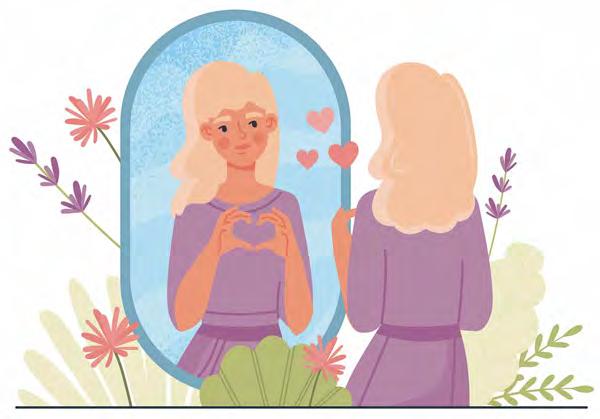
It is important to do these steps in the correct order because parasites (steps 4 and 5) harbor toxins so decreasing parasites has to come before powerful detoxification (step 6). The first three steps prepare your body for a deeper cleansing.
When people take this step with the right supplements, their body, stool, and breath start smelling like plastic, burnt rubber, and other chemicals . You know it is working when these smells from your body occur. Sounds gross? Toughen up! It’s how you get better.
Step seven is when we finally get to the cells… all the cells in the body. There are about 80 organisms and toxins that live inside your cells—this is called “Lyme disease .” These organisms include microscopic parasites, fungi, bacteria, prions, viruses, and even some toxins. These pathogenic organisms come from any biting insect and is thought to also be spread in our food supply. They can cause tremendous harm. Not everyone needs this step because not everyone is really sick. A lot of people go through the earlier steps and get so much benefit that the cells can heal themselves from the inside. If you do need to complete step seven, all previous six steps need to be done first to have long-term beneficial results.
Doing these steps incompletely, or in the incorrect order, is the main reason why complete healing does not occur—even if someone applies all the therapies available in the natural healthcare realm.
Everyone is used to taking in nourishment from supplements and diet, but if you have a four-foot tapeworm in your gut, what’s the point? You have to get that out first. If your body is saturated with plastic or other chemicals, why bother with a simple multi-vitamin? Spend your time and effort at getting the toxins and bad organisms out. Good organisms are not harmed throughout this sevenstep program because no broad-spectrum antimicrobials are used.
I have run a lot of urine tests and found everyone is overloaded with chemical toxins such as herbicides, pesticides, plastic, and exhaust. Your focus needs to be on returning your cells, tissues, and organs to their natural state. After you have detoxed all toxins and pathogens, add in nutrients on an ongoing basis to optimize organ and cell function . The Nutritional Healing Center of Ann Arbor is ready to help you use all seven steps to help you achieve optimal health.
Dr. Darren Schmidt, D.C. is a chiropractor who has focused on nutrition since 1993 and owns and practices at The Nutritional Healing Center of Ann Arbor. Read about his journey toward health on his website, thenhcaa.com, or give him a call to set up an appointment at 734-302-7575.
•
By Jennifer Carson
Need a fun project to beat the midwinter blues? Make this cute penguin in a few hours sitting by the hearth. You can add a hanging loop to make an ornament, have fun embroidering his body, use him to brighten your winter table, or just place him in an unexpected spot to give visitors a quick smile.




Materials needed:
• 2” square of white wool felt
• 5” square of gray or black wool felt
• Two 10” long cotton chenille stems
• Embroider y floss to match body felt and in yellow/orange for beak
• Two seed beads for eyes
Trace the pattern pieces for the body, body gusset and arms onto the paper side of freezer paper. Cut your pieces out close to the line but not on the line.
With a warm iron, press these pieces onto your dark gray or black felt. Cut out on the line. Repeat so that you have two of each piece, except the arms—you’ll need four arm pieces.
Trace the white face pattern onto the paper side of heat and bond. Flip the white face pattern piece and trace again. Cut these pieces out close to the line, but not on the line.
With a hot iron, press the heat and bond pieces onto white felt. Now cut out the two pieces on the line.
Peel the paper from the face pieces and place them on top of your body pieces, matching the curve under the chin. Press in place. Set aside.
Pin the body gusset pieces together. With two strands of matching floss and using a tiny blanket stitch, sew the curve of the gusset.
Match the body gusset to the body pieces and pin in place. Stitch gusset to body, leaving the flat edges unstitched.
Stitch the body from the body gusset, up the belly and under the chin. Knot thread and bury end.

Using an awl, punch a hole in two of the arms, then match each arm with a hole in it to an arm without a hole in it. Stitch each arm together, leaving the top curve open. Set aside.

To make his beak: Fold a 10” cotton chenille stem in half. Unfold and wrap the chenille stem with three strands of floss. Begin by laying your thread end toward the fold, then wrap the chenille stem toward the fold. Once you wrap the chenille stem past the fold, push the two sides of the chenille stem together and wrap them both at the same time. When you have about an inch of the chenille stem wrapped, cut the thread, leaving a 6” tail. Thread a needle with the tail and anchor the thread so that it won’t unravel.
With the awl, punch the holes as marked on the pattern in the body pieces. Lay the beak and the remaining chenille stem into the penguin’s body. Only about ½’ of the beak should stick out. Starting at the top of the beak, stitch the head and down the neck and body. Knot your thread at the “shoulder.” Knot your thread and bury the thread end. Clip thread.
Push the end of the chenille stem through each side of the body where you punched the hole with your awl. Cut your chenille stem so that it is just a little too long to fit into the arm of your penguin. You’ll want to fold over the end just a bit so the sharp wire doesn’t poke through the fabric.
Now stitch the tops of the arms closed, catching some of the body fabric as well to keep the arms in place.
Set your penguin aside while you make his legs.
Cut a chenille stem in half. Fold each piece in half, then fold two toes. Wrap one chenille stem, starting about 1 inch from the toe fold, and through both bends.
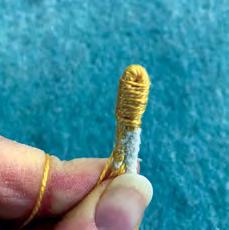
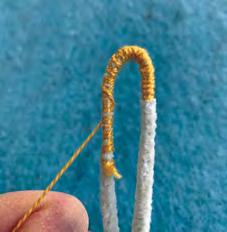
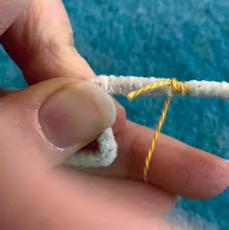
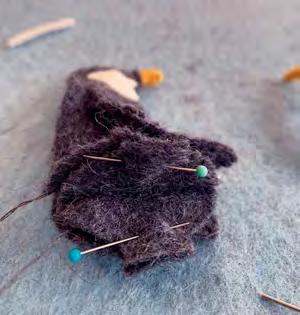
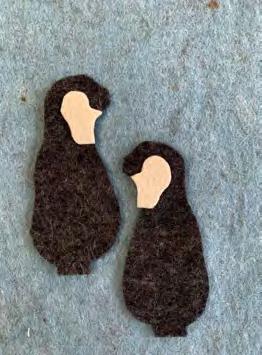
Pinch one toe together and loosely wrap toward the toe end, then wrap tighter, moving back toward the bend. Repeat for the second toe. When the wrapping of the toes is finished, pinch the remaining chenille stem together and wrap to create the leg. When you have about an inch of the chenille stem wrapped, cut the thread, leaving a 6” tail. Thread a needle with the tail and anchor the thread so that it won’t unravel. Repeat to make the second foot. Bend feet so that your penguin can stand.
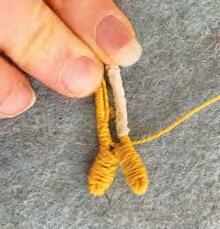

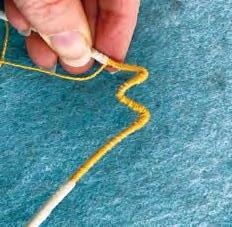
Insert the foot/leg into the legs of the penguin body. Stitch the wool felt tight around the wrapped leg.
Stuff the penguin’s head and neck. Before you finish stuffing, sew the eyes in.
Now finish stuffing. When happy with the shape of your penguin’s body, stitch the remaining body closed.
Embellish your penguin as you desire!

Use these full size patterns to make your own Puckley Penguin!

Penguin face-- cut two from white felt--sew eye at dot.
Penguin Body-cut two from gray felt.

Penguin Body Arms--cut four from gray felt.
Penguin Body Gusset--cut two from gray felt.

 By Sandor Slomovits
By Sandor Slomovits
It is a custom at many high schools for each graduating class to give a gift to the school. Seniors typically raise money to buy a bench, a tree, or perhaps to create a scholarship fund. The class gift tradition at the Rudolf Steiner School of Ann Arbor High School is different—it is built right into the curriculum. Almost every year since the school graduated its first class in 2000, the seniors, under the direction of the school’s art teachers, Elena Efimova, Riccardo Capraro, and Nataliya Pryzant, create a large mosaic that is then permanently mounted at the school’s Pontiac Trail campus building. The resulting mosaics are remarkable in a number of ways and fulfill several functions. First, there’s their size. Last year’s piece, for example, is eight feet by eight feet, which in square footage doesn’t even qualify it into the top three of the fourteen mosaics that students have created over the years. The largest is twelve feet by thirty. But the mosaics are more notable for the quality of their craftsmanship, the wide variety of their subject matter, and for the broad range of artistic styles they employ: from representational art, such as very realistic portraits of Martin Luther King, Frida Kahlo, and Beethoven, to one inspired by an abstract Kandinsky painting; from a periodic table of elements, now hung in the chemistry lab, to panels designed around a Fibonacci spiral. Some, like the class of 2022’s landscape nature scene, a path winding past water and woods to a sunlit valley, use primarily earth tones, others, like the Fibonacci, employ a limited palette, mostly blues and gold, while still others display a varied assortment of vivid hues.
The mosaic class gift tradition began in 2000 with RSSAA’s first high school graduating class and was initiated by Efimova who has taught at the school since 1996. In her confident, direct, sure way of speaking, she conveys a great deal of enthusiasm when
talking about these projects and her students’ art. “By training I am an architect and I have a good feeling for a space. My passion is interior design. I have a feeling for how to beautify a space. The beauty of the students’ work creates an absolutely different mood. People even move through the hallways differently. They constantly stay by the walls when they see that there’s a new art project displayed. And we always display all the students’ art.”
It is a custom at many high schools for each graduating class to give a gift to the school.
Seniors typically raise money to buy a bench, a tree, or perhaps to create a scholarship fund. The class gift tradition at the Rudolf Steiner School of Ann Arbor High School is different—it is built right into the curriculum.
The five graduating seniors in that first year made individual mosaic panels that they eventually decided were too large to take home, so they gifted them to the school. Those now hang in the RSSAA‘s Lower School on Newport Road. In 2002, before the High School moved onto its own campus, classes were housed in the basement of the Genesis church/synagogue on Packard. Perhaps influenced by their location, the class of 2002 decided the theme of their mosaic would be the seven days of creation.
That set the template for all the projects that have followed. Subsequent mosaics have continued to reflect the unique character and circumstances of each class, and its particular interests, while also incorporating elements from the entire Steiner curriculum. The students also often find creative ways of co-mingling elements of different cultures and traditions they have studied into the collages. For example, the class of 2022’s pastoral scene has embedded in it a subtle yin yang symbol. Margot Amrine, the high school’s Humanities teacher says, “What I love is how they reinterpret.” In the seven days of creation mosaic, “the fish is very much inspired by Inuit, Tlingit, Northwest art. The last panel, the day of rest, they decided to do a kind of Buddha with a sort of Hindu cat, and you also see the four elements. So, it’s a very unique and different interpretation, but kind of out of their four years in the Genesis building. There’s been some kind of story every year.”
In 2016 the subject of the class mosaic was Van Gogh’s The Starry Night. The sky and stars are faithfully, artistically reproduced but, unlike in the masterpiece, there is no enormous cypress tree dominating the foreground, and the sleepy little village in van Gogh’s painting has been replaced by the skylines of Detroit, Florence, Italy (complete with its famous Giotto’s Tower), and Ann Arbor—featuring the Bell Tower.

Since 2001 (with the exception of pandemic-disrupted 2020 and 2021) every RSSAA senior class has spent a week in Italy, visiting Venice, Florence, and Rome, witnessing first-hand the art, architecture, mathematics, physics, and literature that they have been studying throughout their Steiner education.
“What started the Italy trip? We have to say thank you to the Soviet Union,” laughs Efimova. “Growing up and living there I was not able to travel, and I knew that I would never travel anywhere. So, my traveling was on the pages of beautiful art books. But some professors in our school from time to time were going somewhere, invited to conferences or whatever. So once, our class professor out of the blue said, ‘You know, children, if you have a chance to travel somewhere only once, choose Venice.’ And this seed was planted in my head. Twenty-five years later it started growing. It happened because during our class, [at the Steiner School] the seniors of the class of 2000 started a discussion about senior trips. And that’s how I found out that this is a culture in American schools. The senior class, where should they go? They went to New Orleans. I asked them about the experience, and I thought, ‘why have just a trip, if it could be a grand trip?’ We need to go to Venice. I Googled and found out that Venice has a Waldorf school, and their school has a guest house. I had the crazy idea that we need to take seniors to Italy. But who would listen to me? I was new in the school. I said, ‘I need one more crazy person.’ And it turned out to be Margot [Amrine],” she said, chuckling.
The basis of education is an understanding of the world around us. At Steiner, we go beyond the textbook and into the world. Inspiring discovery, creation and reasoning from many perspectives. Preparing students for countless opportunities.

More Than Meets The Eye • SteinerSchool.org • 734-995-4141


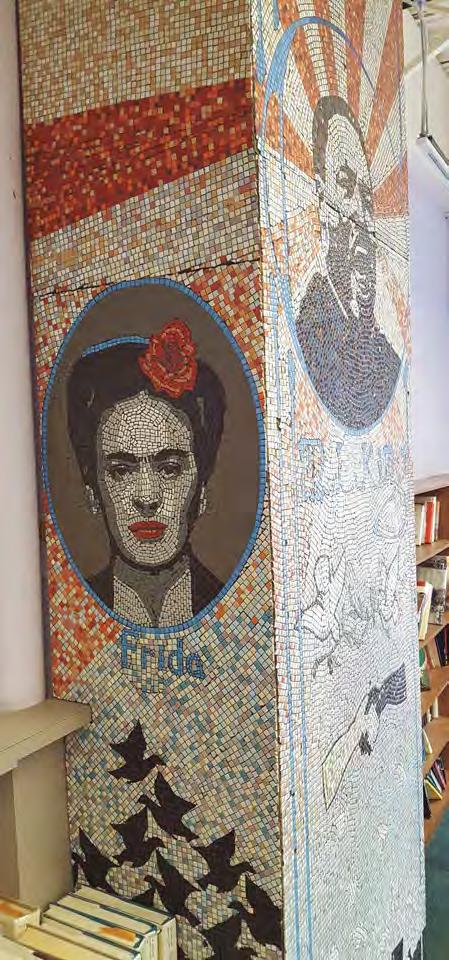

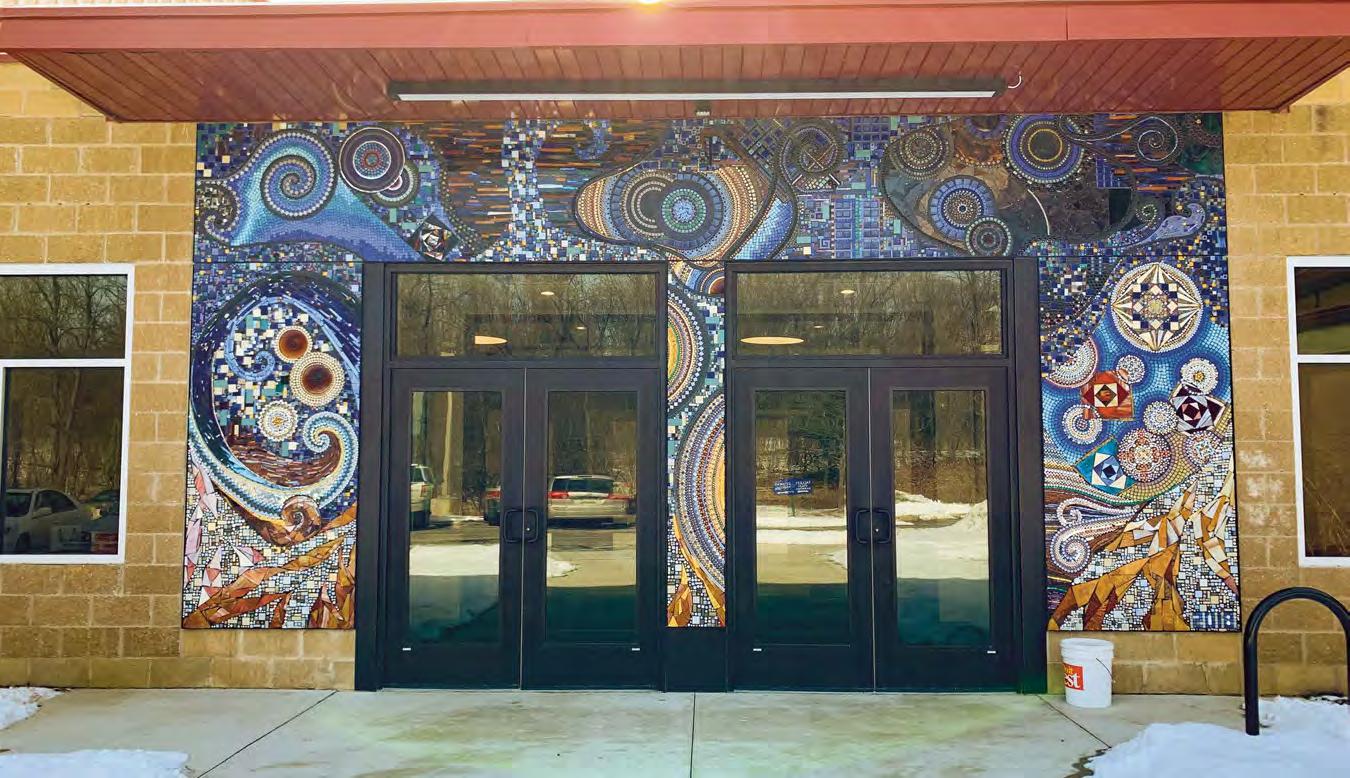
beauty of the student’s work, creates an absolutely different mood. People even move through the hallways differently.”
—Art teacher, Elena Efimova
“The
Informed and inspired by what they have seen in Italy, including visiting the famed Orsoni glass-making factory where they observe glass blowing and glass cutting by hand, the students begin working on the class mosaic upon their return home in April.
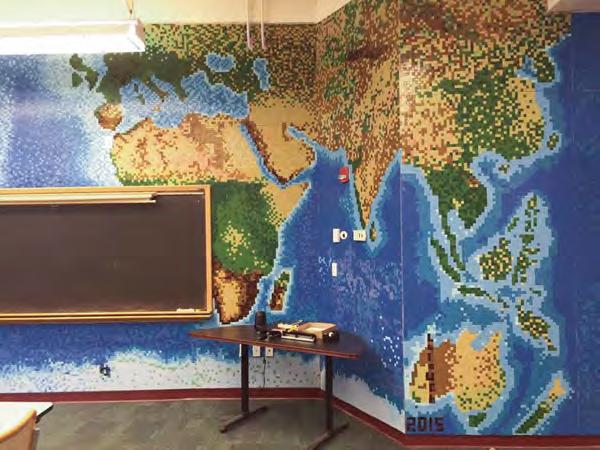


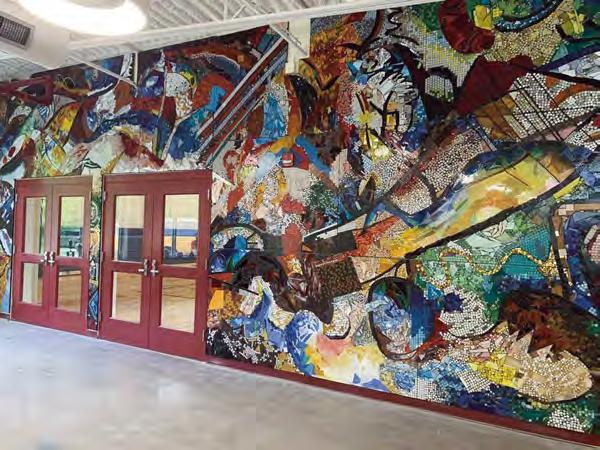
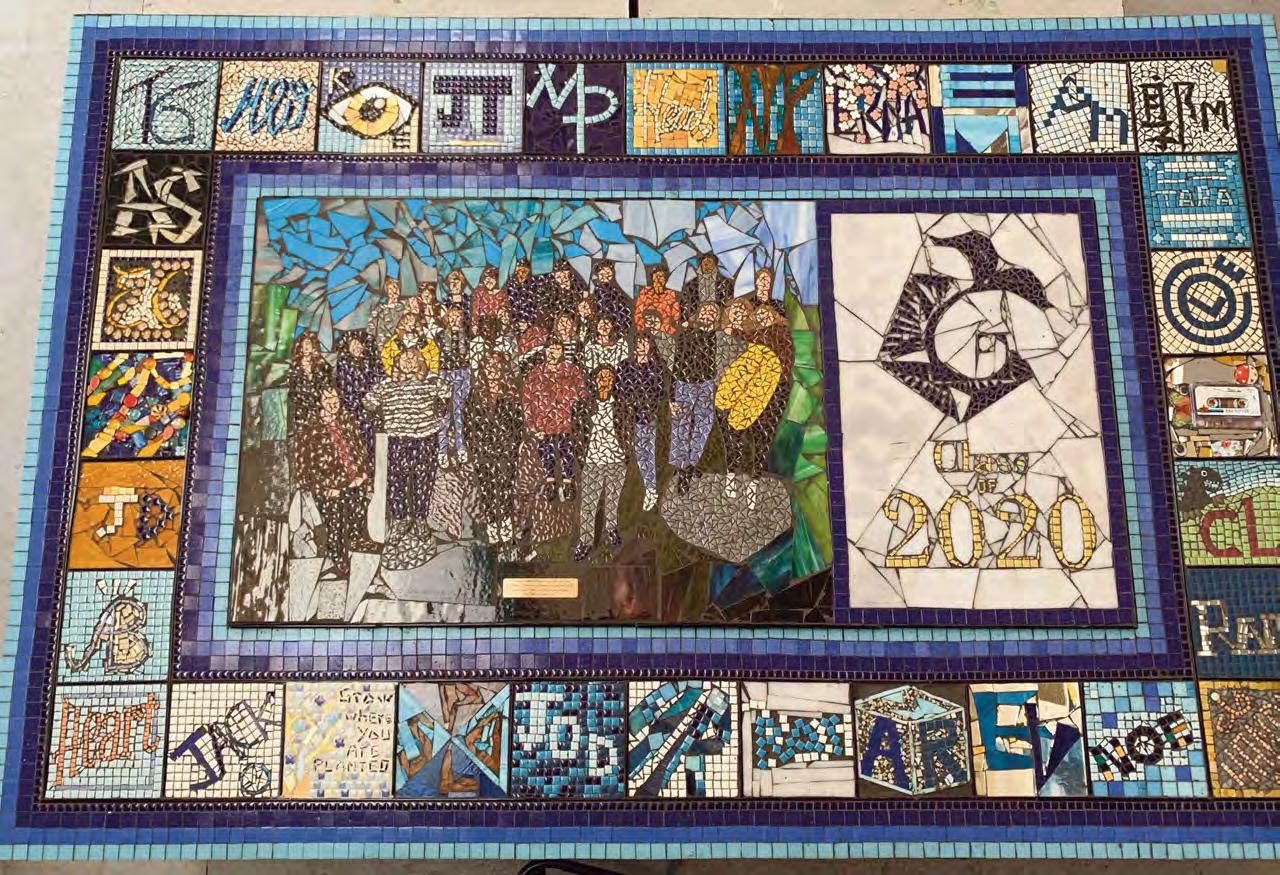
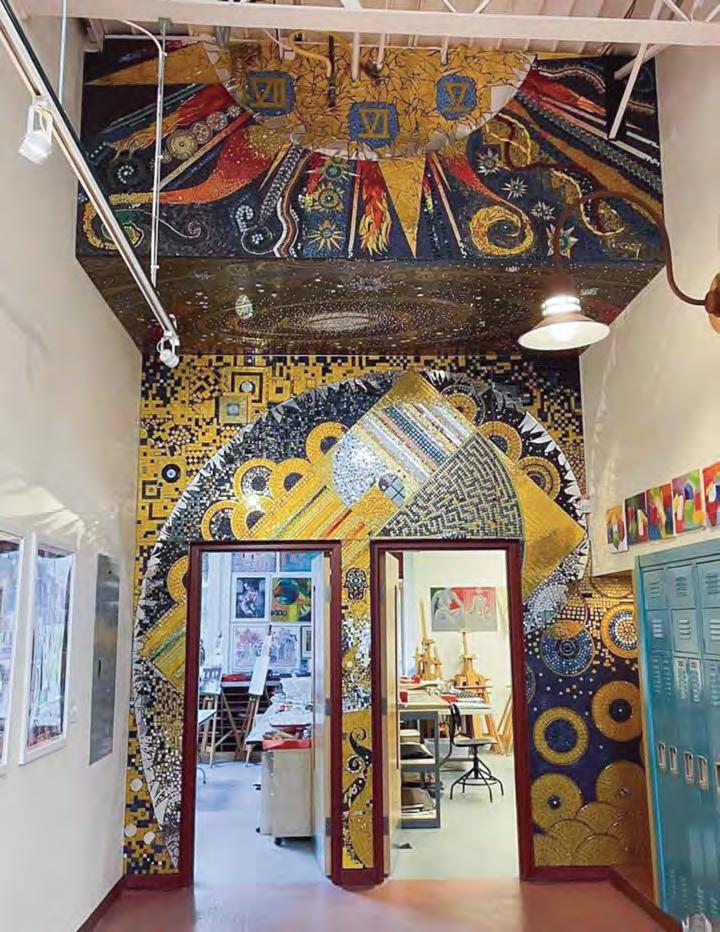
world. “You have to try to get everybody on board about a design. Yyou’ve got a deadline. It’s very realistic, very real world.”
“The mosaics are one more aspect of the art program (at the school),” says Amrine. “I think a continual thread is collaborative, studio. It’s really a beautiful example of ‘the whole is greater than the sum of the parts.’ Because it’s all little tiny pieces that can be beautiful in their own way, but they don’t mean anything, and they don’t create an image until they all are assembled together in this very studio-like atmosphere. I think there’s something to that, the collaboration. Students develop the options, and there is an opportunity for spontaneity because although you have a general plan, you can be spontaneous in a big group like that. You are making your mark, but it’s in the service of a greater whole. Kind of like jazz, reflect your little portion from being inspired by somebody else’s, and looking and observing. But also, being able to talk about what you’re doing. Being social, kind of like some of the old quilting bees must have been, where you’re really working on something much greater than yourself. With those quilting pieces—unless it was a crazy quilt—there was usually a pretty set pattern. Same with the mosaics. There’s a template, there’s a drawing, but it really goes its own way, in real time, which has a little bit of a musical element to it.”
The mosaics are much more than visual art projects. They also serve “…the connections we are trying to make across different subjects,“ says Amrine. “Where does this bring something alive that’s in physics or in history of art or in, straight up botany? Where is it bringing something alive in a new way? Because, of course, that’s part of the point. I guess you could call these mosaics an art project, but they are also an ecology project because we are looking to see where’s balance. And where does this influence that? Someone who can draw the Fibonacci sequence beautifully maybe inspires someone else to look outside and see the pattern in nature or discover that musical composition is actually based on the same proportions. That’s the kind of thinking that we’re trying to stimulate. It’s not just subject, close the book, next subject—but where do they influence each other?”
Sometimes, as was the case in the spring of 2022, at first there was no clear consensus, many good ideas were proposed and there was a great deal of discussion. Eventually, Efimova asked Capraro to synthesize and refine the various images that the students had proposed, and he brought back, “A glorious, glorious sketch and students loved it,” says Efimova. It became the template for the final product.
“I said, ‘Margot, I have an idea. We have to take the students to Italy.’ And she said, ‘Yes, we do.’ We made a presentation to the faculty college and the board, and it was approved and it was wonderful. In 2001, in February and March, we took the first class to Venice, and we stayed in the guest house of the Waldorf school on the mainland, not on the island of Venice. We just took a bus to Florence, just day trips without staying overnight. The next year was 2002. In September of 2001, 9/11 happened and all schools, and the University of Michigan, everybody canceled international trips, but our school, again by a miracle, was approved to go. And in the spring of 2002 we made it so that our time in Venice and Florence got an equal amount of time. The next year one student said, ‘I can’t imagine going to Italy and not seeing the Colosseum.’ So, we made the trip [consist of] Venice, Florence, and Rome. And that’s how it has stayed since then. We have had very strong support from our administration, and now it is a tradition.
Amrine says, “The trip, and then this studio mosaic project brings together many, many different threads from what they’ve studied.” Informed and inspired by what they have seen in Italy, including visiting the famed Orsoni glass-making factory where they observe glass blowing and glass cutting by hand, the students begin working on the class mosaic upon their return home in April, often incorporating some glass they have brought back from Italy.
The entire process, from start to finish, is highly collaborative. Usually, Efimova, relying on her training in architecture, selects the location and suggests the theme, keeping in mind the practical constraints of the project, as well as her extensive knowledge of the class, having worked with them throughout high school and often even in their lower school years. Sometimes, as with the Kandinsky, she proposes the image, but the rest of the faculty and the seniors either respond enthusiastically or another suggestion is debated and modified. Students have to find a way to both say what they want to say and also listen to what everybody else has to say. Occasionally, as with the Fibonacci spiral or the large map of the world for the history room, it’s a student who comes up with the final idea. “It’s a great hidden lesson for students, working together as a group,” says Capraro, who has worked in the commercial art
The pandemic created a special challenge. The Italy trip was cancelled in 2020 and the school closed for in-person learning in the spring. But Efimova remembered that, “One of the students, as his personal project, had made a mosaic copy of the class photograph that was taken at the beginning of the school year. I asked the student to donate this, he agreed, and it became the centerpiece of their class gift. We made the border with the initials of each student. Each student received a small square and they came in the summer, two at a time, and made their own initials.”
Recently, another previous class gift also played an important pandemic-healing role. The class of 2018’s mosaic frames the entrance to the school’s new addition. It’s a freeform, almost improvised-appearing, yet beautifully balanced work, mostly in warm, welcoming shades of blue. Amrine recalls that in December 2021,” We were able to have (the annual) choir concert outside. It was the first choir concert we had had since Covid. The parents were there and other children, and alumni came, and the students sang with that mosaic as their backdrop. Elena said, ‘It’s almost as if it was made for this moment.’”
The first mosaics and Italy trips began before the children who are in school now in 2022-2023, were even born. “Everybody who comes to our school, they know about it,” says Efimova. “They know that it’s kind of part of the curriculum. Yes, it’s part of the curriculum, but only in our school.” The Ann Arbor Steiner School is the only Waldorf School in the world with these traditions, which helps to make it a very special place to learn, indeed.
The entire process, from start to finish, is highly collaborative… Students have to find a way to both say what they want to say and also listen to what everybody else has to say.
It’s Taco the squirrel’s birthday, and all of his little animal friends are planning a big surprise for him—they’re going to make him a birthday cake! The only problem with their plan is that none of them know how to make a cake. So, as this sassy crew of critters is known to do, they set out to learn all they can about birthday cakes and how to make one, with spectacularly disastrous and delightful results.
Visiting the city from her home in the suburbs, an African American girl sees how a few packets of seeds, some helping hands, and hard work transform an empty lot in a housing project into a magical place where vegetables grow and family gathers. It’s the magic of nature in the heart of the city! Bernette Ford’s autobiographical story is a loving glimpse at a girl, her siblings, and her uncle, and their shared passion for farming. L’l Sissy’s fascination with measurement, comparison, and estimation introduces children to STEM concepts. And the progress of Uncle John’s garden introduces readers to the life cycle of plants.

 By Joanna Ho Illustrated by Dung Ho
By Joanna Ho Illustrated by Dung Ho


A young boy comes to recognize his own power and ability to change the future. When a friend at school creates a hurtful drawing, the boy turns to his family for comfort. He realizes that his eyes rise to the skies and speak to the stars, shine like sunlit rays, and glimpse trails of light from those who came before—in fact, his eyes are like his father’s, his agong’s, and his little brother’s, and they are visionary. Inspired by the men in his family, he recognizes his own power and strength from within. This extraordinary picture book redefines what it means to be truly you.
 By J. Elle
By J. Elle
Kyana Turner has just found out the family secret--she’s a witch! This means mandatory lessons every Saturday at Park Row Magick Academy, the magic school hidden in the back of her local beauty shop. Learning spells, discovering charms and potion recipes, and getting a wand made to match her hair’s curl pattern, Kyana feels like she’s a part of something really special. The hardest part will be keeping her magic a secret from non-Magick folks, including her BFF, Nae.

But when the school loses funding, the students must either pay a hefty tuition at the academy across town or have their magic stripped . . . permanently. Determined not to let that happen, Kyana comes up with a plan to win a huge cash prize in a baking competition. After all, she’s learned how to make the best desserts from her memaw. But as Kyana struggles to keep up with magic and regular school, prepare for the competition, and keep her magic secret, she wonders if it’s possible to save her friendships, too. And what will she do when, in the first round of competition, a forbidden dollop of magic whisks into her cupcakes?


Celeste is the talk of the town when she moves to Montana from Montreal, but the only friend she makes is Vivvy, the heir to the town’s founder and a social pariah. Inspired by a passion-fueled school incident, they begin writing a love-story fanfic between the popular guy and the school stoner, one that gradually reveals Celeste’s past. While her bond with Vivvy makes Celeste feel safe and alive again, Vivvy keeps prodding Celeste to turn fantasy into reality. When they finally try, one drunken night on a dark mountainside, Celeste is the one who ends up kissing golden boy Joss. And Joss ends up dead. Celeste doesn’t remember the end of that night and can’t be sure she didn’t deliver the killing blow. Could she still be that scared of getting close to a boy? Secrets are hard to keep in a small town, and even Vivvy seems to suspect her. Exploring the winding passages of the cave where Joss died, Celeste learns he had his own dark secrets, as does Vivvy. The town isn’t as innocent as it appears.
You may purchase these books at shopcrazywisdom.com by either visiting the website or scanning the QR code (right).
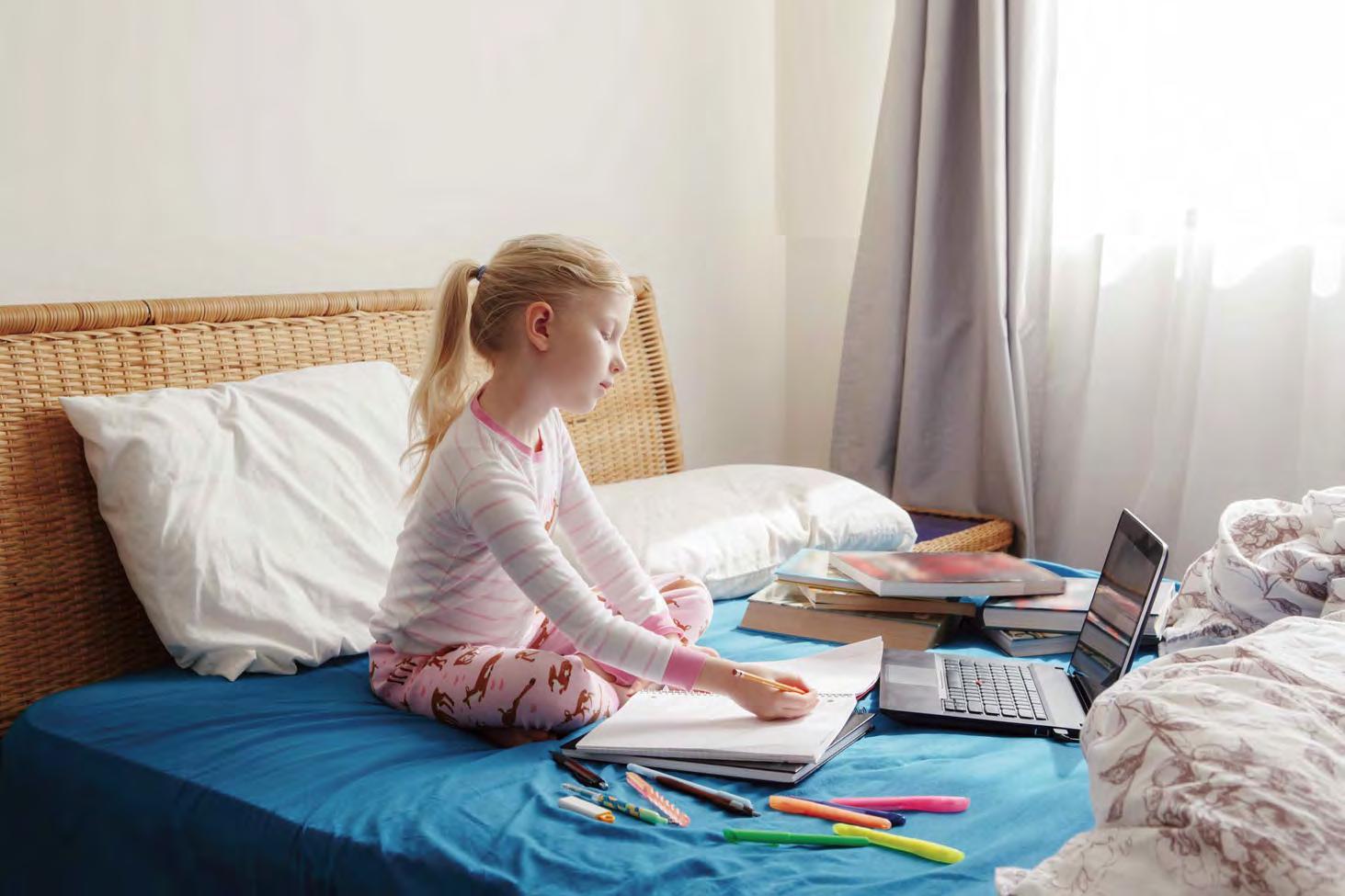 By Tammy Renner
By Tammy Renner
Unschooling is a term coined in the 1970s by John Holt whose books Learning All the Time and Teach Your Own (among others), have empowered parents for decades to homeschool their children in a liberating way. Rethinking the definition of education, schooling “outside the box,” is as unique as every parent and child. It is apparent to those who observe young children that learning does indeed happen in every moment, thus children are naturally their own best teachers. Unschoolers see the community as their school. Children learn with parents, neighbors, family, friends, librarians, educators, community members, books, media, backyards, parks, museums, and through unique opportunities to travel. With freedom and choice about learning, the children are happy, and equally important, so are the adults.
collected. Others offer services such as gardening and snow shoveling or intern several hours a week with a local small business person learning alongside as many did in the days of apprenticeships.
While some might think that Unschooling is “children running around the house and neighborhood wild all day,” it seldom is. Rather, it is a gift of being— allowing children to be purely themselves, learning in their own time, in ways that bring more joy and success. More recently, unschooling has been called Child-Led-Learning where each child is given the time and opportunity to learn at their own pace, going as fast or slow as they need and/or desire. Some children will learn to read at the age of three, others not until around age ten, yet when they do read, Unschoolers delight in doing so and are often seen carrying several books at a time for their reading delight. A child might read voraciously yet struggle to spell on their own. Spelling and grammar eventually catch up with their reading, when the child’s mind is ready to learn. Forcing spelling and grammar seldom has positive effects and may have the opposite . When the Unschooler is uncomfortable and/or resists a topic, a parent may worry and feel they must persist in educating their child, so they are “at grade level,” fit into society, and meet the family standards. Unschooling parent Katrina Gutleben emphasizes this by wisely saying: "Learning can only happen when a child is interested. If he's not interested, it's like throwing marshmallows at his head and calling it eating ."
Many Unschoolers find that math is gratifying when taught through daily life skills that the child will use far beyond the family home. Cooking provides opportunities to measure and count, creating schedules teaches how to tell time and divide it into various activities, making projects, regardless of the medium, teach additional measuring skills and the wisdom to “measure twice, cut once.” Shopping and creating a budget for household items and those on a child/family wish list begin the teaching of economics. Some Unschoolers create businesses, selling something they’ve created with their own hands, written, grown, or
What about the middle and high school-age student? Three main scenarios are often seen: 1. The Unschooled child desires to attend a school. They spend a few months to a year preparing, motivated to put time into subjects they may not have intrinsically found interesting or were too challenging in prior years. The motivated teen will in most cases quickly brush up on spelling, grammar, math and/or science skills as required by the school in order to attend and take classes at the level of interest. If extra help is needed with this preparation, a tutor can be engaged. 2. The schooled child may need a respite from school and begin Unschooling in the teen years. Unschooling books and websites for teens and their parent(s) specifically talk about how to rectify learning and or personal difficulties experienced by taking a learning sabbatical and the easing into home/community learning. 3. The Unschooled child craves something new and different, yet does not want to attend school in the traditional manner. The solution can be as simple as finding a mentor, tutor, or online/ in person class(es). The teen may create an apprenticeship in their specific area of interest. Some teens create a living situation with family friends or relatives in a different location in order to experience both a different family/cultural structure and study a specialty that is available only in the vicinity of the new living arrangement.
Whether Unschooled or schooled, there are times extra support for a child’s physical health, mental health, and/or educational interventions will transform the dark clouds and stigma that surround these situations into one of empowerment and healing. Unschoolers are wise in knowing “it takes a village to raise a child.” The Michigan Alliance for Families provides information, support, and education for parents of children with a wide range of specific needs and is available to parents of children schooled and homeschooled. Particular learning needs with a physical aspect are often supported by insurance and Medicaid.
Michigan’s public schools offer a wide range of assessments and offerings to homeschooled families (this has increased significantly since 2020). The Clonlara School, whose home is in Ann Arbor, offers support and mentoring to Unschooling families and has been a huge contributor lobbying for the legal rights of homeschoolers (clonlara.org).
Rethinking the definition of education, schooling “outside the box,” is as unique as every parent and child.
More recently, unschooling has been called ChildLed-Learning where each child is given the time and opportunity to learn at their own pace, going as fast or slow as they need and/or desire.
If you think homeschooling would be torturous but your child is incredibly unhappy in their current situation, then you might choose Unschooling. With a bit of imagination and research, you can create a wonderful Unschooling learning environment for your child without being the main educator.
If you think homeschooling would be torturous but your child is incredibly unhappy in their current situation, then you might choose Unschooling. With a bit of imagination and research, you can create a wonderful Unschooling learning environment for your child without being the main educator.
For parents who want to unschool their child(ren) yet are concerned about communications and don’t want to continue arguing about learning, know many of these challenges often lessen as the stress of traditional schooling dissipates. Many Unschooling parents keep the NYTimes’s best sellers oldies but goodies How to Talk So Kids/Teens Will Listen and So Kids/Teens Will Talk along with How to Talk So Kids Can Learn by Faber & Mazlish on their table as an ongoing communication resource.
If you are considering Unschooling:
• Give Unschooling a try during the summer, a weekend, a holiday break, or in urgent cases take a bit of time off from school to give it a go.
• Connect with Unschooling groups/families, if you don’t know any Unschoolers, consider a local Facebook group: facebook.com/ HomeschoolersAnnArbor/.
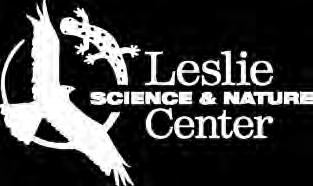



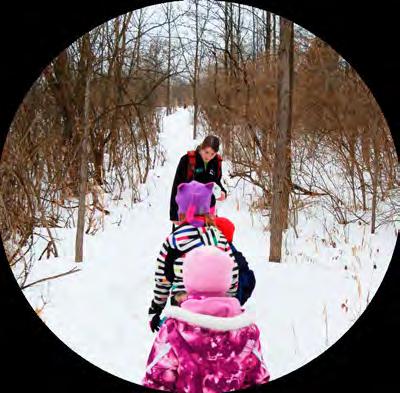
• Read about Unschooling and Child-Led-Learning starting with the Growing without Schooling website: johnholtgws.com/growing-withoutschooling-issue-archive.
• Gather local resources, groups, and people to support you as you get started

• Allow time for you as a parent to have time alone inside and outside the house – if necessary, hire childcare or barter to get this time, it is essential self-care.
• Two parent families pre-schedule regular dates in and out of the house – also essential self-care.
• Know your state’s requirements for homeschooling (Note: Michigan is a low homeschool regulations statehslda.org/legal.)
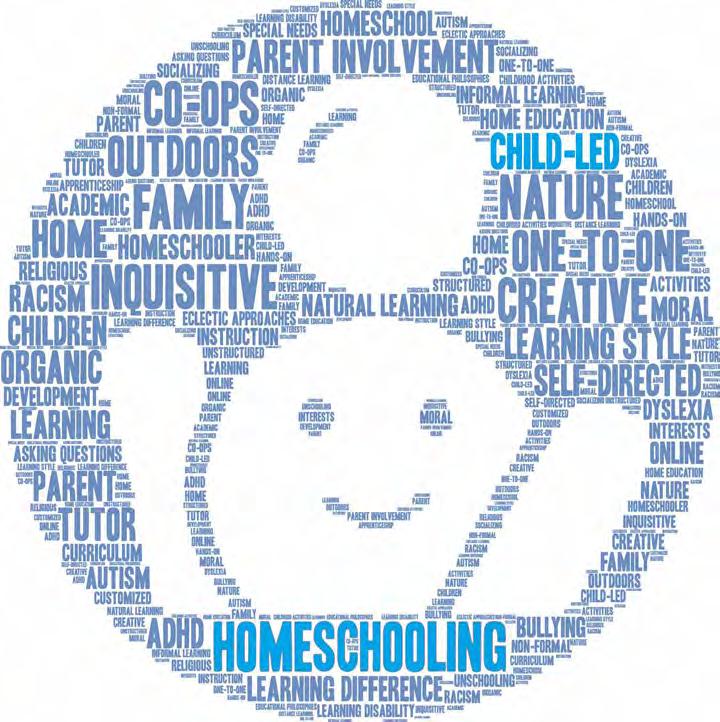
• Delight in your choice, find joy in the little things–including distractions–these are often the best Unschooled moments.

“Trust Children. Nothing could be more simple—or more difficult. Difficult, because to trust children we must trust ourselves—and most of us were taught as children that we could not be trusted,” wrote John Holt in Teach Your Own
Tammy Renner teaches piano lessons, leads BrainBodyBalance classes, is a homeschooling consultant, and enjoys colorful creativity as textile artist and gardener. Her two adult (mostly Unschooled) daughters are beginning their careers as a Clinical Social Worker and an Educational Psychology Researcher. Visit Renner online at https://tammyrenner.wixsite.com/tammyrenner/home.
By Nishi SinghalThe more present we become, the more we increase our capacity for joy. Learning to be present is challenging, irrespective of age. However, integrating mindfulness practices provides youth the tools to better process their feelings.
Here are some great daily presence practices:
• Be a lion! Take a deep breath in through your nose, open your mouth, and roar the air out.
• Place one hand on your heart and the other hand on your belly, close your eyes, and stare into the blackness.

• Pick a color! Look around and find everything you can that is that color.
As kids learn how to function in this world, the best gift we can give them is the space to be, especially when they are feeling anger, grief, or rejection. When we can be completely present with our feelings, it helps children see that there isn’t anything wrong with emotions. When we don’t react personally to their emotion, they will slowly learn that they can remain aware of the emotion on a feeling level. Asking them questions like, “Where is the feeling?” and “What does it feel like?” will help prevent the child’s mind from understanding the emotion or turn it into anxious thinking. The practice of presence in moments of heavy emotions will help kids understand that they are not their thoughts and feelings. Thoughts and feelings, like clouds, are simply passing through us.
The intellectual understanding that we are not our minds and thoughts are transient only emerges in adolescence and adulthood, yet the real-time practices of breathing, allowing heavy emotions to be felt (as opposed to something to hide), movement, and meditation should be integrated at a young age. By doing so, kids will not only know how to cope with hard times but how to better enjoy all moments in life.
• Pet your dog or cuddle a favorite stuffed animal!
Presence is the practice that will carry them through good and hard times.
Steps for acting from a place of presence:
1. Close your eyes.
2. Take some deep breaths. 3. Let thoughts and mental pictures pass by. 4. Allow yourself to relax.
5. Ask your heart, “What do you want to do right now?
6. Wait and listen for a response. 7. Use your mind to take action.
Steps for feeling heavy emotions:
1. Close your eyes.
2. Breathe in and breathe out. 3. Bring your attention to your body.

Emotional resilience is developed over time as kids inevitably experience changes in their external environment. Moving, changes in the family structure, health problems, competition at school and after-school activities all have a role to play in building a strong internal foundation. Presence is the practice that will carry them through good and hard times.
4. Where is the stormy cloud? In your belly? Throat? Head? Legs? 5. Place a pillow or stuffed animal on the spot where you feel the heavy cloud.
6. What does the stormy cloud feel like? Mad? Sad? Hurt? 7. Focus your awareness on the pillow or stuffed animal and keep breathing.


8. Keep going until the stormy cloud has floated away!
Practices after heavy emotions: • What did the stormy cloud feel like? • What happened when it went away? • Do you think it might come back? • Draw a picture of the stormy cloud.
Mindfulness is a lifelong skill and an invaluable resource to cultivate lifelong happiness. As parents, we focus on intellectual and physical growth. Let’s also encourage the mental skills to succeed and smile through life.
Nishi Singhal is the director of the Lively Community Foundation working to improve the mental and emotional well-being of communities. She enjoys writing the Heart & Mind books to spread the message of mindfulness to kids. She can be found at joyparade.co.
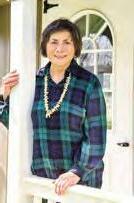

Childbirth Preparation Six-Week Series with Cynthia Gabriel and Toni Auker • Starts Tuesday, January 10 • 5:30 to 8:00 p.m. • This class aims to prepare you for your best birth. We will cover topics including stages of labor, positive team-building communication with providers, informed decision making, coping techniques, and postpartum. $350. For more information email hello@nestandnurture.org or visit nestandnurture.org.
One-Day Intensive Childbirth Preparation Class with Toni Auker and Cynthia Gabriel Saturdays, January 21, February 25, April 1 • 9 a.m. to 5:00 p.m. • This class aims to prepare you for your best birth. We will cover topics including stages of labor, positive team-building communication with providers, informed decision making, coping techniques, and postpartum. $250. For more information email hello@ nestandnurture.org or visit nestandnurture.org.
Prenatal Chestfeeding/Breastfeeding Class with Erica Macleod, IBCLC • Sunday, January 22, Saturday, February 18, Sunday, March 19 • 2 to 4:00 p.m. • This 2-hour comprehensive class enables us to take time to answer all of your feeding questions, and concerns. We will cover information beginning with the prenatal period to feeding in the early weeks. ASL and Queer affirming. $100 per family. For more information email EricaMcleod@gmail.com or visit nestandnurture.org.
Postpartum Wellness with Mary Clipner of Copper Bear Shire • Sunday, February 5 • 1 to 2:30 p.m. • Whether you’re expecting your first child or your fifth, are carrying multiples, or are pregnant after experiencing a loss, the postpartum time is a moment to pause. Learn to honor the cycle and transition of your body during this time of growth. In this online class, you will learn strategies to help you feel nourished, supported and ready for your new adventure. $25. Visit washtenaw. augusoft.net and search “Postpartum” to register. For more information contact Mary at info@copperbearshire.com.
Newborn Care Class with Toni Auker • Saturday, February 18 • 10 a.m. to 1:00 p.m. • In this class we will answer all of your questions about bringing home a newborn. We will talk about how to sooth a crying newborn, bathing, different diapering choices, babywearing, car seat safety, safe sleep, and much more. We will give you several different tools and techniques for each topic and discuss the wide range in normal when it comes to newborns. This class is ideal for expectant parents as well as adoptive and fostering parents. $100. For more information email hello@nestandnurture.org or visit nestandnurture.org.
Birth Options Discovery Night with Cynthia Gabriel and Toni Auker • February 21 • 5:30 to 7:30 p.m. • Come have some veggies and dip while discovering what your birth options are in Washtenaw County and beyond. There’s no one “right way” to give birth! Understanding what your options are helps you make the choices that are right for you. What’s the difference between a hospital midwife and an obstetrician? How do I know if my birth preferences line up with my provider? Can I have a water birth at our local hospital? Do doulas take over the role of partners? And SOOO much more! $25 per family. For more information email hello@nestandnurture.org or visit nestandnurture.org.
Ask-A-Doula Drop-In with Erica Businski, Toni Auker, and Cynthia Gabriel • Wednesdays • 1 to 2:30 p.m. • Stop by on Wednesdays from 1-2:30 to chat with a local doula. They are happy to answer questions about what a doula does, help you explore your local resources, assist you with baby carriers, and more. There is no need to register for this, but you are welcome to contact us through the website with questions about it. It is always possible that Ask a Doula will have to be cancelled due to our doulas being at a birth. We will do our best to update on our Facebook page if we are going to cancel. FREE. For more information email hello@nestandnurture.org or visit nestandnurture.org.
H2W2 - K4K - Happy, Healthy, Wealthy, Wise - Kabbalah for Kids (5th grade and up) • Sundays, January 22, February 26, March 19, April 23 • 1 to 3:00 p.m. • Utilizing movement, multi-sensory input, color, and experiential learning, we build self-esteem of spiritually evolved children (not reinforce feelings of being different, damaged, defective, disordered, dysfunctional). In an ascensional journey through the Tree of Life, we aid in organizational skills, navigating lowvibrational emotions, relationships, setting healthy boundaries. We encourage children in discovering and fostering their authentic selves’ genius, to fulfill their spiritual mission of a healthy, interdependent, functional planet for the “1000 Years of Peace” prophecy. $50/session for 2-hour class, meets one time/month for about a year. For more information contact Karen Greenberg at (734) 4179511, email krngrnbg@gmail.com, or visit clair-ascension.com.
Bingo Night and Soup Potluck at the Rudolf Steiner School of Ann Arbor • Tuesday, February 7 • 5:30 to 7:30 p.m. • Join us for a fun, family-friendly evening of bingo and share some warm soup and warmhearted community! Soup not required to join. FREE. For more information email kbrown@steinerschool.org.
Parenting Arts Support Group with Cynthia Gabriel, Ph.D. and Toni Auker • Thursdays beginning January 12 • 1 to 2:30 p.m. This is a group to nurture and support parents who are primary caregivers of infants during the early days! You are not alone! We hope to create community connections, explore the world of parenting philosophies (What is Attachment Parenting? What is Helicopter Parenting? What kind of parent am I?), talk about how life events intersect with caring for a small human, get support for infant feeding challenges, and so much more! We will have rotating topics each week with plenty of time for sharing and getting to know each other and our babes. Open to new parents with babies up to crawling age. $15 week drop-in; $90/8 weeks; $120/12 weeks. For more information email EricaMcleod@gmail.com or visit nestandnurture.org.
Work and Play Space with Toni Auker, Erica Businki, Erica Macleod, and Cynthia Gabriel • Tuesdays • 1 to 3:00 p.m. and Fridays 10 a.m. to noon • It can be really difficult to find a safe place to let our little ones play away from home. We actually started our play area so our own children could come to work with us. Thanks to some generous donations from community members and The Little Seedling, we now have a beautiful area that is perfect for toddlers and preschoolers. Our space has a variety of seating options, WiFi, and coffee. We will be there working, and we would love to invite you to do the same. Sliding scale $0-10. For more information email hello@nestandnurture.org or visit nestandnurture.org.
Unschooling, Child-Led-Learning with Tammy Renner • Wednesday, January 18 • 7 to 8:30 p.m. • As a follow up to the Unschooling article in this edition of the CWJ, Tammy will share a bit of her journey as an Unschooling parent, followed by a question-and-answer time for adults wanting to know more about Unschooling. FREE. To join use this Zoom Link: https://us02web.zoom.us/j/87972723627 ?pwd=SFZQU3U4QnRicUZkYzUzalE5UTRCZz09 Meeting ID: 879 7272 3627 Passcode: Unschool.
Infant/Pediatric CPR and First Aid with Lorenda Lewis • Sundays, January 22 or March 19 • 10 a.m. to 1:00 p.m. • Nest and Nurture is excited to team up with Lorenda Lewis to offer this class, which include Red Cross Certification for infant/ pediatric CPR and First Aid. Erica is teaching a chestfeeding/breastfeeding class from 2-4 following these classes in 2023. We are offering a $10 discount to anyone that registers for both classes. $120. For more information email hello@ nestandnurture.org or visit nestandnurture.org.
Coffee Hour for Prospective Parents with Kriste Brown • Tuesdays, January 31 and February 28 • 8:45 - 10:30 a.m. Join us at the Rudolf Steiner Lower School (2775 Newport Rd) for warm drinks, sweet treats and good conversation. Meet some members of our community and get a peek inside the most beautiful school in Ann Arbor! For more information contact Kriste Brown at kbrown@steinerschool.org.
Classes with Asian Martial Arts Studio • Ongoing classes • Martial arts classes include Aikido, Kung Fu, Karate, Tai Chi, Wing Chun, and Lion Dance with the goals of developing a truthful knowledge of the fundamental elements of our martial arts traditions and their roots in Asian culture. Call 994-3620; a2amas. com.
A Course in Miracles Study Group on Zoom with Rev. David Bell • Mondays, January 2 through April 24 • 6:45 p.m. to 9:30 p.m.• Exploration of A Course in Miracles. Free, but donations gratefully accepted. For more information visit interfaithspirit.org.
A Course in Miracles Study Group on Zoom with Randall Counts • January 5 through April 27 • 12 to 1:30 p.m. • Exploration of A Course in Miracles. Free, but donations gratefully accepted. For more information visit interfaithspirit.org.

27th Annual Exhibition of Artists in Michigan Prisons with The Prison Creative Arts Project (PCAP) • Tuesday, March 21 through Tuesday, April 4 • Gallery and sales open on March 21 at 5:00 p.m., Celebration Program from 6:30 to 7:30 p.m. Free and open to the public. For more information call (734) 647-6771, email pcapinfo@ umich.edu, or visit prisonarts.org.
12 Step Self-Help Group: Growing Through Life’s Changes and Challenges with Facilitator Larry Gazda • Tuesdays, 7:30 to 8:30 p.m. • A weekly spiritual help and support group at the Lighthouse Center based on the traditional 12 Step Programs applied to spiritual growth and expansion of consciousness. For more information call (734) 808-1335 or email, lhci.financials@gmail.com.
Basic Telepathic Animal Communication with Judy Liu Ramsey • January 7 and 8 • 9 a.m. to 5 p.m. • Rediscover your natural telepathic communication skills with stepby-step instruction in a supportive environment. Learn how to connect with animals the way they communicate with each other through fun, gentle exercises to open your intuitive senses. Strengthen your heart connection to a deeper understanding of an animal’s perspective. Join us for this amazing class. $150 per person/$75 for repeating students. For more information contact Judy Ramsey, by email at info@judyramsey.net or visit https://JudyRamsey.net.
Canine Massage with Irene’s Myomassology Institute • January 8 and March 12 • 9 a.m. to 1:00 p.m. • Bring a friendly dog and blanket or mat. Whether your pet is suffering from arthritis, recovering from surgery, or experiencing anxiety, this class will teach you techniques to help quiet your pet’s problems. You will thoroughly learn dog anatomy and how it relates and differs from the human body. A basic complete massage sequence will be taught with special emphasis on the hips. Behavioral control, acupressure points, and common trigger points will also be covered. $88. For more information call (248) 350-1400, email contact@irenes. edu, or visit irenes.edu.
Aromatherapy with Irene’s Myomassology Institute • January 14 and 15 and April 1 and 2 • 9:30 a.m. to 5:30 p.m. • This class will explore the different aromas and therapeutic properties of essential oils. We will additionally discuss how oils are processed and how to ensure the oil quality. You will learn a variety of methods to use essential oils in your practice including mixing essential oils with massage lubricant, diffusers, steam showers, bath salts, and space clearing. Students will create an aromatherapy blend to use in class and take home. Bring a notebook,
washcloth, and hand towel for class. $352 ($22 per hour). For more information call (248) 350-1400, email contact@irenes.edu, or visit irenes.edu.
Textile Artist Carole Harris at the INAI Gallery • February 1 to May 21 • 9 a.m. to 6:00 p.m. • Enjoy textile artworks by artist Carole Harris, a Detroit based artist, who draws inspiration for her work from walls and aging structures that remind us of the impermanence and the beauty of that which has lived for a long time. FREE. For more information contact the Weber Center at (517) 266-4000.
Lunch and Learn with Janet Wright, OP, Nancyann Turner, OP, Kathleen Voss, OP and Barb Cervenka, OP • April 11 • 12:15 to 1:00 p.m. • Four of our artists, each working in a different medium, share what’s at the heart of creating art. Where do ideas come from? What are the challenges? What are their favorite creations? And other questions we may have. Event is free (lunch is available for $5.00). For more information contact the Weber Center at (517) 266-4000.
Sunday Spoon Carving with Deanne Bednar • February 26 • 10 a.m. to 5:00 p.m. • Enjoy a day of hands-on learning at Strawbale Studio, on beautiful, wooded land. We will be using several tools (Sloyd and hook knives, hatchet, shaving horse, and draw shave) and safe techniques to make a wooden spreader knife or chopsticks, and a spoon to take home. For beginners and intermediate learners. A skill for a lifetime! $50 if paid one month in advance or $60 thereafter. For more information contact Deanne Bednar (248) 496-4088 email ecoartdb@ gmail.com or visit strawbalestudio.org.
Wreath-Making and The Craft of Cording with Deanne Bednar • Saturday, February 18 • 1 to 5:00 p.m. • Enjoy a hands-on day in the Strawbale Studio by the woodstove, creating wreaths from foraged vines, seed pods, and such! Also learn the skill of cording … making a twine also from locally foraged plants! We will forage outside for things to add. Take your creations home to enjoy. Ah, connection to nature and relaxing renewal-time. $25 if paid one month in advance, $35 thereafter. For more information contact Deanne Bednar (248) 496-4088 email ecoartdb@gmail.com or visit strawbalestudio.org.

D.O.V.E. DIVINE ORIGINAL VIBRATION EMBODIMENT System Practitioner Training with Karen Greenberg • Fridays, January 13, 20, 27 OR February 3,10, 24 OR March 3,10, 17 OR April 14, 21, 28 • 10:30 a.m. to 2:30 p.m.• After studying D.O.V.E. System manual, learning to identify and repattern client’s limiting beliefs, thoughts, attitudes, and patterns, and assisting client in expressing any commensurate low-vibrational emotions, and instituting new behaviors. Through the Tree of Life, learn to Kabbalistically balance client’s energy via art, movement, music, toning, sound, aromatherapy, gemstones, sacred symbols, connecting with G-D, Archangels, Angels, Masters of Light, trees, powerful Archetypes, and more. $777 (for any group of three dates listed) + materials fee. For more information call Karen Greenberg at (734) 417-9511, email krngrnbg@gmail.com or visit clair-ascension.com.
Wellness Series - Beauty Loves Movement with Katie Westgate at the Rudolph Steiner School • January 14 • 2 to 4:00 p.m. • Expand your toolkit of techniques for self-guided relaxation, connection, and becoming your own best wellness advocate. In this fun and unique class, you will learn techniques for vibrant, healthy skin through self-massage, breath work, facial exercise, light yoga, meditation and the why’s of the importance of these techniques. FREE. For more information contact Kriste Brown at kbrown@steinerschool.org.
If you are interested in obtaining some biographical information about the teachers, lecturers, and workshop leaders whose classes, talks, and events are listed in this calendar, please look in the section that follows the calendar, which is called “Teachers, Lecturers, Workshop Leaders, and The Centers” and which starts on page 101.
Wreath-Making and The Craft of Cording with Deanne Bednar • Saturday, February 18 • 1 to 5:00 p.m. • See Art and Craft

World Peace Chanting Service with Zen Buddhist Temple • Monday January 23 through Sunday, January 30 • 6:30 a.m. every day, 7 p.m. on Monday, Tuesday, Wednesday, and Friday • See Buddhism
Postpartum Wellness with Mary Clipner of Copper Bear Shire • Sunday, February 5 • 1 to 2:30 p.m. • See Childbirth
GYROKINESIS® Method (Online) with Angela Hawkins • Mondays, January 9 through March 27, No class January 16 • 4 to 5 p.m. • See Exercise and fitness
Winter Labyrinth Walk with Rob MeyerKukan • Saturday, January 21• 1 to 2 p.m. • See Meditation
Mamas Smart Money Group with Cynthia Gabriel • Thursdays, January 26, February 16, and March 23 • 6 to 7:30 p.m. • See Prosperity and Abundance
Reiki Self-Treatment for Long Covid with Dona Duke • Saturday, January 14 • Noon to 1:30 p.m. • See Reiki
Shamanic Tools: Making Ceramic Rattles with Eli Zemper • Saturday, February 25 • 1 to 4 p.m. • See Shamanism Care and Feeding of Empaths with Charise Jacobs via Zoom • Thursday, January 5 • 6 to 8 p.m. • See Spiritual Development

ReBoot Yourself with Master Wasentha Young • Thursdays, February 2 through February 16 • 11:30 a.m. to 12:30 p.m. • Feeling like you could use some self-care? Learn energy cleansing, basic stretches, relaxing mindful meditation and selfacupressure techniques that will revitalize and improve your sense of well-being. $60 class fee. For more information contact Peaceful Dragon School at info@ peacefuldragonschool.com, call (734) 741-0695 or visit peacefuldragonschool. com.
Jewel Heart Readers with various Jewel Heart Instructors • Mondays, January 9, February 13, March 13, April 10 • 7 to 8:30 p.m. • Enjoy lively discussion on monthly Buddhist-related book selections with our community. All are welcome. FREE but donations welcome. For the month’s book selection and participation information, send an email message to programs@jewelheart.org or call Jewel Heart at (734) 994-3387. For more information, visit the Jewel Heart website at jewelheart.org.
Jewel Heart Virtual Sunday Talks: Ancient Wisdom, Modern Times with Demo Rinpoche • Sundays, January 1 to April 30 with no discussion on February 26. • 11:00 a.m. • Join Demo Rinpoche for weekly Sunday morning public talks on a variety of topics that are suitable for newcomers and long-timers alike, followed by a facilitated group discussion based on the morning talk. On the first Sunday of the month, Rinpoche presents the Jataka Tales, stories from the Buddha’s previous lives. Talk from 11 a.m. to 12 p.m. Moderated discussion of the presenter’s talk: starting at 12:15 p.m. FREE but donations welcome. To register, visit jewelheart. org/free-weekly-virtual-programs. For more information, visit the Jewel Heart website jewelheart.org, call Jewel Heart at (734) 994-3387 or send an email message to programs@jewelheart.org.
Practical Buddhism by Gelek Rimpoche • Tuesdays, January 10 to April 25 • 7 to 8:30 p.m. • “Practical Buddhism” offers video recordings of earlier teachings by Gelek Rimpoche as an opportunity for some to revisit and as an introduction for others. A panel discussion with Jewel Heart Instructors follows each session. FREE but donations welcome. To register, visit jewelheart.orgfree-weekly-virtualprograms. For more information, visit the Jewel Heart website jewelheart.org, call Jewel Heart at (734) 994-3387 or send an email message to programs@ jewelheart.org.
Living Enlightenment: Guidelines from Five of the Greatest Dalai Lamas with Glenn Mullin • Wednesdays, January 11 to February 8 • 7 to 8:30 p.m. • In this series of talks, Glenn Mullin will offer important highlights from the lives and teachings of five of the greatest of the early Dalai Lamas, drawing from the life stories and mystical songs and poems of the 1st, 2nd, 3rd, 5th and 7th Dalai Lamas. $100 Jewel Heart Members/$125 Non-Members. Pay What You Can - No one is turned away. To register, go to the Jewel Heart website at jewelheart.org. For more information, call Jewel Heart at (734) 994-3387 or send an email message to programs@jewelheart.org.
The Bodhisattva’s Way of Life with Demo Rinpoche • Thursdays, January 19 to April 13 • 7 to 8:00 p.m. • Shantideva’s Bodhisattva’s Way of Life is among the most beloved and inspiring works in the Mahayana Buddhist tradition. In it, Shantideva gives detailed instructions on the benefits and methods of living in accordance with the bodhisattva ideals of unselfishly helping others. Members $95 / $120 NonMembers. Pay what you can - no is one turned away. To register, visit jewelheart. org/free-weekly-virtual-programs. For more information, visit the Jewel Heart website jewelheart.org, call Jewel Heart at (734) 994-3387 or send an email message to programs@jewelheart.org.


Regardless of religious beliefs, readers will likely recognize the word sabbath and what it stands for. In Ruth Haley Barton’s book Work and Rest: From Sabbath to Sabbatical and Back Again the sabbath and its significance. While her text comes from a place of religious belonging, the book can be just as easily applied to the lives of those unconnected to any particular religion or belief system. Barton introduces the benefits of practicing the concept as psychologically beneficial. She addresses the idea as one woven into Christian traditions while also considering the value to all individuals for health, sanity, and contentedness.
The concept of keeping the sabbath may seem daunting in an on-the-go society faced with the high “demands of relationships, family, work, school, church, childcare, shopping, health, appearance, housework, meals, bill payments, commuting, accidents, interruptions, illnesses, and countless other things eating up our time.” However, Barton notes throughout the text that allowing ourselves to live a busy lifestyle, never unplugging and clocking out, will lead to unfavorable consequences such as burnout, high blood pressure, and becoming unable to forgive, pray, and enjoy life.
Barton built chapters based on main concepts such as Discovering Sabbath in Community, The Power of Unplugging, More Than a Vacation, and Setting Boundaries. Each one fuels the narrative, explaining the concept and practice of sabbath to readers and further defining the importance and how to incorporate it into their lives.
While part one focuses on sabbath, part two is titled Sabbatical. This half of the book is designed to inform readers about what happens when taking one day and observing sabbath on the seventh day, which is insufficient. Barton begins by illustrating how she came about her first sabbatical—a time in her life when she faced a financial crisis and tough decisions as the leader of an organization she founded and led. Her verbiage is intentional as she explains to readers how exhausted and battered, she felt during this time. The harsh realities of life, such as caring for aging and sick parents and their eventual passing, prevented her from taking sabbatical. However, she uses this story to lead into her explainer of simply moving forward with taking sabbatical out of necessity. “I am telling you this to alert you to the fact that sabbatical never comes easy; it will always need to be fought for.” As an added benefit to readers, she includes a sabbath worksheet in the appendix so readers can prepare for and plan their practice.



Within part one, Barton provides insights about the origin of the sabbath and discusses how to gradually progress into a lifestyle that incorporates this practice. As a concept that runs deeper than a lifestyle suggestion, she describes sabbath as a practice in which the work has already been done for us—a space of rest, tranquility, peace, and happiness is already carved out, and all we must do is enter and participate. However, she warns that the ease of practicing sabbath doesn’t happen overnight as “we might experience the discomfort of discovering how addicted we are to human striving and hard work.” However, sabbath is intended for cleansing, restoration, reflection, and freedom. By observing sabbath, Barton says we learn to break patterns of resistance—“bondage to patterns of relentless productivity, never-enough consumerism, the constant stimulation of push notifications and connectivity that exacerbates stress, anxiety, and bitter controversies.”
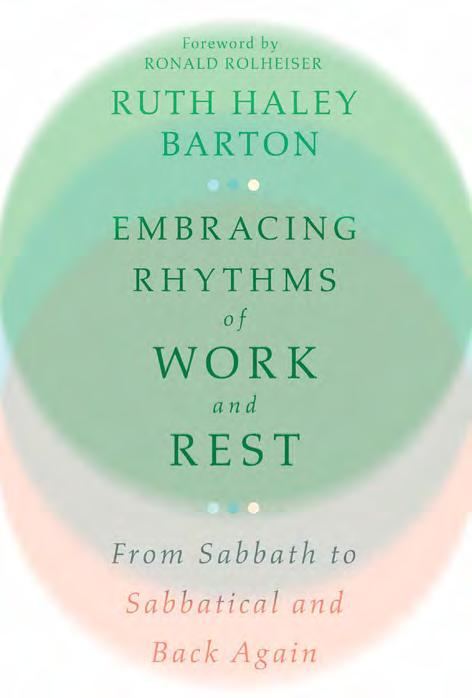
The concept of keeping the sabbath may seem daunting in an on-the-go society faced with the high “demands of relationships, family, work, school, church, childcare, shopping, health, appearance, housework, meals, bill payments, commuting, accidents, interruptions, illnesses, and countless other things eating up our time.
The text sufficiently sheds light on the need for a shared understanding of the concept of sabbatical. As such, Barton provides insights on facing the contradictory nature of the practice, even going as far as to acknowledge the lack of “resources to support and guide these longer seasons of rest and renewal.” Finally, she gives a brief synopsis of a book she found particularly helpful during this time, Sabbatical Journey by Henri Nouwen, describing how it benefited her.
Barton is keenly aware of the challenge of embedding sabbatical in secular settings, such as vocations that don’t allow for such a thing. She mentions the changes in corporate America as they now see “the benefit of giving executive leaders extended time away for a change of pace, new experiences that help them think new thoughts, an opportunity to assess where they are in their career, etc.” Nonetheless, she finds it essential to “claim the biblical nature of sabbatical as a deeply spiritual concept.”
Additionally, Barton posits that observing one day of rest opens the lines of communication with God. Reverting to her Christian-based approach to sabbath, she provides ample evidence for how the practice can deepen if we trust in God as both strength and provider rather than relying on what we can secure through constant striving.
Each chapter begins with a relevant quote or Biblical verse, such as the quote by Adele Calhoun in chapter two, which says, “If you aren’t resting, you are a slave to something.” These provide solid examples and reiteration of sabbath and its meaning and importance. Further, at the rear of each chapter is a page that is a tool for readers. For example, the headline says, “What your soul wants to say to God,” and the text within the page outlines questions to ask and reflect on after reading the chapter.
Barton guides the reader planning for an extended sabbatical, establishing goals, and creating a space for hopes and dreams, including getting rest and replenishment, finding delight in simple things, and caring for and strengthening the body. Given the intentional nature of sabbatical—“a season of a different kind of intentionality toward rest and very personal needs, hopes, and desires that will be addressed specifically and concretely in one’s sabbatical plan.” And while the concept remains the same, Barton reassures readers that a plan will be unique to each person, tailored to personality types, needs, desires, what is going on in each life, and what God intends for each person.
An epilogue wraps the book up, summarizing human beings’ need for rest—rest for the mind, “a reprieve from the intensity of our thoughts and emotions, and replenishment of all that gets taken from us in our engagement with a very demanding world.” The closing arguments for sabbath and sabbatical are sure to resonate with most, if not all, readers, as life’s hustle and bustle are vibrant everywhere we turn. Each reader experiences pressures, whether from society, family, careers, or so much more. The book is a welcome invitation to practice something seemingly beneficial to everyone, regardless of beliefs or religious belonging.
The Longevity Practice of White Tara with Demo Rinpoche • January 21 • 10 a.m. to 1:00 p.m. Join Demo Rinpoche for this workshop that will focus on the longevity qualities of White Tara, which aims to remove obstacles to our life and to extend it. Healing is also an important quality of White Tara. Through her color, White Tara signals the qualities of purity, absence of obstacles, and the activities of pacifying. During the Covid pandemic, many in Jewel Heart used the White Tara practice for healing and preventing illness. Members $60 / $75 NonMembers. Pay what you can - no is one turned away. To register, visit jewelheart. org/free-weekly-virtual-programs. For more information, visit the Jewel Heart website jewelheart.org, call Jewel Heart at (734) 994-3387 or send an email message to programs@jewelheart.org.
Four Noble Truths with Joe Palms and Figen Lacin • Mondays, January 23, 30, February 6, 13, 27, March 6, 13, 20 • 7 to 8:30 p.m. • This course introduces Buddha’s revolutionary message that suffering can come to an end through one’s own efforts. Following Gelek Rimpoche’s transcript Four Noble Truths, participants rely on readings, discussion and meditation. $60 Jewel Heart non-members / Free for Jewel Heart members. Pay what you can - no is one turned away. To register, visit jewelheart.org/free-weekly-virtual-programs. For more information, visit the Jewel Heart website jewelheart.org, call Jewel Heart at (734) 994-3387 or send an email message to programs@jewelheart.org.
World Peace Chanting Service with Zen Buddhist Temple • Monday January 23 through Sunday, January 30 • 6:30 a.m. every day, 7:00 p.m. on Monday, Tuesday, Wednesday, and Friday • A week-long kido chanting and purification service for repentance, peace of the world and happiness for all beings. FREE. For more information email annarborzentemple@gmail.com or call (734) 761-6520.
Ryaku Fusatsu–Full Moon Ceremony with Rev. Marta Dabis • Sundays, February 5, March 5, and April 2 • 11 a.m. to 12:30 p.m. • Traditional Japanese Soto Zen Full Moon Ceremonies in the tradition of the San Francisco Zen Center, in English. The program starts with 40 minutes of silent meditation and concludes with informal conversation. FREE, but donations are appreciated. Everyone is welcome. You can come for any portion of the program. For more information contact Marta at (248) 202-3102, email jissojizen@gmail.com, visit jissojizen. org, or find us on MeetUp!
The Buddhist Scientific Centrist View: According to Nagarjuna’s, Buddhapalita, and Je Tsongkhapa with Robert A. F. Thurman • Saturday, March 11 • 10 a.m. to 1:00 p.m. • The Buddhist Inner Science Centrist View of Nagarjuna, as interpreted by Buddhapalita and further clarified by Je Tsongkhapa, states that the ultimate truth, emptiness, is totally compatible with conventional reality: nothing exists intrinsically from its own side, yet is in perfect harmony with the conventional truth, that everything is dependently originated. This undermines the root of all suffering, the fundamental ignorance that grasps at an intrinsically existing self, while at the same time allowing for the infallible unfolding of cause and effect. Meditation on this Middle Way—between nihilism and eternalism—overcomes all forms of ego-grasping and opens the door to liberation and enlightenment. Members $75 / $90 Non-Members. Pay what you can - no is one turned away. To register, visit jewelheart.org/free-weekly-virtual-programs. For more information, visit the Jewel Heart website jewelheart.org, call Jewel Heart at (734) 994-3387 or send an email message to programs@jewelheart.org.
Foundation of All Perfections: Guru Devotion (Applied Meditation Technology Series) • Saturday, April 1 • 9 a.m. to 12:00 p.m. • The Foundation of All Perfections introduces the stages of the spiritual path, from the role of the guru to a practical introduction to Vajrayana, offering an introduction to Tibetan Buddhist principles and practices through instruction, guided meditation, and discussion. $30 Jewel Heart member / $45 Non-member. Pay what you can - no is one turned away. To register, visit jewelheart.org, call Jewel Heart at (734) 9943387 or send an email message to programs@jewelheart.org.
Searching for Self with Venerable Thubten Chodron • Wednesdays, April 5, 12, 19, and 26 • 7 to 8:30 p.m. • In this series of talks, Venerable Chodron will explore emptiness, one of the most central teachings in Buddhism, drawing from the seventh and newest volume of her Library of Wisdom and Compassion series with the Dalai Lama. “Searching for the Self” leads us to delve deeply into the topic of the ultimate nature of reality, presenting it from a variety of approaches while focusing on identifying our erroneous views and directing us to the actual mode of existence of all persons and phenomena. Engaging in this investigation will challenge our deepest-held beliefs and uproot false ways of viewing ourselves and the world that are so habitual we don’t even notice them. Members $65 / $80 Non-Members. Pay what you can - no is one turned away. To register, visit jewelheart.org, call Jewel Heart at (734) 994-3387 or send an email message to programs@jewelheart.org.
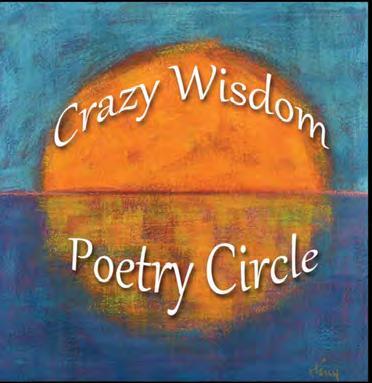
Hosted by Edward Morin, David Jibson, and Lissa Perrin

Second and Fourth Wednesday of each month, 7-9 p.m.


All sessions are virtual and accessible through Zoom. Email cwpoetrycircle@gmail.com for Zoom link.
Second Wednesdays, 7-9 p.m.: Poetry Workshop. All writers welcome to share and discuss their poetry and short fiction. Sign-up for new participants begins 6:45 p.m.

Fourth Wednesdays, 7-9 p.m.: Featured Reader(s) for 50 minutes. Open Mic reading for 1 hour. All writers welcome to share their own or other favorite poetry. Sign-up begins at 6:45 p.m.
February 22 – Linda K. Sienkiewicz is the author of an award-winning novel, In the Context of Love, a children’s picture book, and five poetry chapbooks—the latest being Sleepwalker. Her poems have appeared in Prairie Schooner, Rattle, and The McGuffin. She holds an MFA from The University of Southern Maine. LindaKSienkiewicz.com.
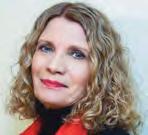
February 22 – Hiram Larew is an accomplished food scientist whose poems find in twigs, leaves, seeds, and the night sky surprising wisdom and cause for gratitude. His poems have appeared in Rhino, Ars Poetica, Innisfree, and six collections including the forthcoming Patchy Way from CyberWit Press. www.HiramLarewPoetry.com and www. PoetryXHunger.com.
March 22 – Linda Nemec Foster is author of twelve poetry collections including The Blue Divide and The Lake Michigan Mermaid (a Michigan Notable Book). Bone Country is her forthcoming collection of prose poems and flash fiction. Linda was the first Poet Laureate of Grand Rapids and founder of the Contemporary Writers Series at Aquinas College.
April 26 – Dan Bellm (Berkeley, CA) has published five books of poems, including Counting (2023), Deep Well (2017), and Practice (2008). His recent translations include Central American Book of the Dead, by Balam Rodrigo (2023), Speaking in Song, by Pura López Colomé (2017), and The Song of the Dead, by Pierre Reverdy (2016).

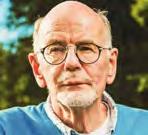
https://cwcircle.poetry.blog/

Crazy Wisdom's E-Blast Service is a great way to showcase yourself, your business and your services!
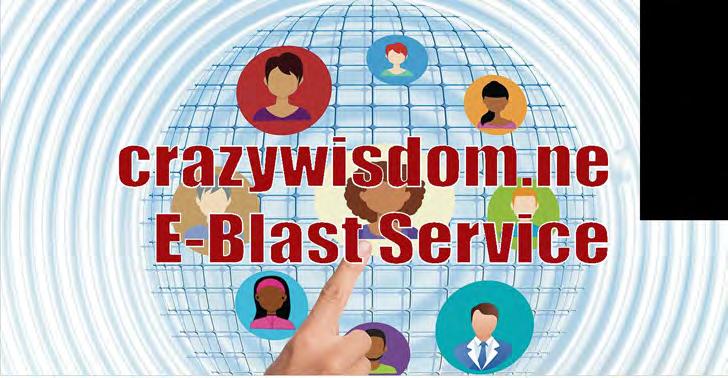
This service i s a cost effective method of reaching a targeted audience without the need for investment in costly hardware and mail related so ftware!

Send out a listing of your upcoming classes, workshops, and events.
This is a great way to reach the more than 8000+ people who are currently subscribed to receive our E-Blasts.
Affordable pricing starting at $99.00 for any one email!
For all requirements and to pay visit www.crazywisdom.net
Click on "Crazy Wisdom's Email Service" in the left-side menu.
E-Blast Service ads must be mail-ready (see website) and emailed to Carol. Questions? Contact Carol at carol@crazywisdom.net

Meditation and Discussion with Lama Nancy Burks • Wednesdays • 7 to 8:00 p.m. • The meeting includes group practice and discussion meaningful to students at every level. The content of each meeting will be informed by the interests of the participants, and may include a Dharma talk, meditation, Q and A, and/or book discussion. Participants are encouraged to share their questions, reactions, and experiences with the group. Join in person or on zoom. Enter through back door, 614 Miner Street, annarborktc.org. FREE. For more information contact Pat at (734) 678-7549, email aaktc@yahoo.com or visit annarborktc.org.
Sitting Meditation Lama Nancy Burks • Saturdays • 10:30 to 11:20 a.m. • Every Saturday morning, please join us for silent sitting meditation. We start with a few brief instructions, then do two 20-minute sessions of sitting with 10 minutes of walking meditation in between. Sit on a cushion or in a chair and stay awhile afterward for informal discussion if you wish. Held at Bethlehem United Church of Christ. karunabuddhistcenter.org. FREE. For more information contact Caitlyn at (708) 307-5169, email Cdbuchanan325@gmail.com or visit https:// karunabuddhistcenter.org.
Cacao Ceremony with Victoria Schon • January 8, February 5, March 11, and April 2 and 30 • 4 to 6:00 p.m. • Victoria facilitates a small cacao ceremony circle of 10 people. It’s a tranquil setting to connect with this beautiful plant medicine and make heartcentered connections. Ceremonial Cacao’s greatest lessons teach us self-love. The sacred plant medicine is celebrated in the backdrop of soft waves and beats of sacred sound. $45. For more information visit victoriaschon.com.
New Moon Gathering with Yoga Nidra and Sacred Sound • January 21, February 20, and April 20 • 7 to 8:30 p.m. • Join Victoria Schon and Courtney Fitzpatrick for a unique offering to celebrate and gather under the New Moon. Courtney will offer her original Yoga Nidra meditation while Victoria offers waves of sacred sound and silence. $40. For more information visit victoriaschon.com.
Vernal Equinox Celebration with Victoria Schon • Tuesday, March 21 • 6:30 to 8:30 p.m. • Join in for the celebration of the Vernal Equinox and welcome Spring! Courtney and Victoria will be offering a celebration to honor the re-awakening of our hemisphere as many generations before us, recognizing the orderly intelligence of nature. We’ll focus on rebirth after the dark winter, new beginnings, fertility, green, growth and light using the natural world as our guide and honing into the astute observation skills of our ancestors. Our celebration will include a Vernal Equinox Ceremony, a warming spring tea, gentle movement, and Sacred Sound. $59. For more information visit victoriaschon.com.
IRemembering Wholeness—Darshan with The Mother Channeled by Barbara Brodsky • January 8, February 5, March 5, April 2, May 14 • 2 to 4:00 p.m. • A mother is one who gives birth to, supports, and cherishes, and then releases out into the universe, with love, always ready to hold and support. Zoom allows everyone to hear my words. I speak to individuals, often what I say is applicable to many in the group. I will be offering from my own understanding the personal and the group messages that can most support the program participants. Suggested donation. For more information email om@deepspring.org, call (724) 477-5848, or visit deepspring.org.
Evenings with Aaron Channeled by Barbara Brodsky • January 11, February 8, March 8, April 19 • 7 to 9:00 p.m. • Evenings with Aaron meets once a month. All are welcome. Aaron will often address a present world issue and how we can best support the resolution of this issue from a place of loving awareness. He reminds us that whatever appears in our lives comes as a teacher. We are here to learn and practice dynamic compassion, that is, to actively live in the world while always connected to our spiritual centers. Suggested donation. For more information email om@deepspring.org, call (724) 477-5848, or visit deepspring.org
Childbirth Preparation Six-Week Series with Cynthia Gabriel and Toni Auker • Starts Tuesday, January 10 • 5:30 to 8:00 p.m. • This class aims to prepare you for your best birth. We will cover topics including stages of labor, positive team-building communication with providers, informed decision making, coping techniques, and postpartum. $350. For more information email hello@nestandnurture.org or visit nestandnurture.org.
One-Day Intensive Childbirth Preparation Class with Toni Auker and Cynthia Gabriel • Saturdays, January 21, February 25, April 1 • 9 a.m. to 5:00 p.m. •This class aims to prepare you for your best birth. We will cover topics including stages of labor, positive team-building communication with providers, informed decision making, coping techniques, and postpartum. $250. For more information email hello@ nestandnurture.org or visit nestandnurture.org.
Prenatal Chestfeeding/Breastfeeding Class with Erica Macleod, IBCLC • Sunday, January 22, Saturday, February 18, Sunday, March 19 • 2 to 4:00 p.m. • This 2-hour comprehensive class enables us to take time to answer all of your feeding questions, and concerns. We will cover information beginning with the prenatal period to feeding in the early weeks. ASL and Queer affirming. $100 per family. For more information email EricaMcleod@gmail.com or visit nestandnurture.org.
Postpartum Wellness with Mary Clipner of Copper Bear Shire • Sunday, February 5 • 1 to 2:30 p.m. • Whether you’re expecting your first child or your fifth, are carrying multiples, or are pregnant after experiencing a loss, the postpartum time is a moment to pause. Learn to honor the cycle and transition of your body during this time of growth. In this online class, you will learn strategies to help you feel nourished, supported and ready for your new adventure. $25. Visit washtenaw. augusoft.net and search “Postpartum” to register. For more information contact Mary at info@copperbearshire.com.
— Edith SitwellNewborn Care Class with Toni Auker • Saturday, February 18 • 10 a.m. to 1:00 p.m. • In this class we will answer all of your questions about bringing home a newborn. We will talk about how to sooth a crying newborn, bathing, different diapering choices, babywearing, car seat safety, safe sleep, and much more. We will give you several different tools and techniques for each topic and discuss the wide range in normal when it comes to newborns. This class is ideal for expectant parents as well as adoptive and fostering parents. $100. For more information email hello@nestandnurture.org or visit nestandnurture.org.
Birth Options Discovery Night with Cynthia Gabriel and Toni Auker • February 21 • 5:30 to 7:30 p.m. • Come have some veggies and dip while discovering what your birth options are in Washtenaw County and beyond. There’s no one “right way” to give birth! Understanding what your options are helps you make the choices that are right for you. What’s the difference between a hospital midwife and an obstetrician? How do I know if my birth preferences line up with my provider? Can I have a water birth at our local hospital? Do doulas take over the role of partners? And SOOO much more! $25 per family. For more information email hello@nestandnurture.org or visit nestandnurture.org.
Ask-A-Doula Drop-In with Erica Businski, Toni Auker, and Cynthia Gabriel • Wednesdays • 1 to 2:30 p.m. • Stop by on Wednesdays from 1-2:30 to chat with a local doula.
Winter is the time for comfort, for good food and warmth, for the touch of a friendly hand and for a talk beside the fire: it is the time for home.
is a psychotherapist in Ann Arbor who is dedicated to empowering clients to grow, become more accepting of themselves, and move toward authenticity. Hugh has a special interest in meditation and has been practicing zazen for 20 years. He offers a free meditation group to clients past and present. He believes that connecting with ourselves, contacting our innate wisdom and humanity on the path of healing is much needed individually and collectively. Hugh has also explored and studied the healing potential of plant medicines and psychedelics, and in January 2023 plans on offering Ketamine Assisted Psychotherapy for current clients for whom this modality would be a good fit. Learn more about Hugh's psychotherapy practice at integrated-counselinga2.com.
They are happy to answer questions about what a doula does, help you explore your local resources, assist you with baby carriers, and more. There is no need to register for this, but you are welcome to contact us through the website with questions about it. It is always possible that Ask a Doula will have to be cancelled due to our doulas being at a birth. We will do our best to update on our Facebook page if we are going to cancel. FREE. For more information email hello@nestandnurture.org or visit nestandnurture.org.
H2W2 - K4K - Happy, Healthy, Wealthy, Wise - Kabbalah for Kids (5th grade and up) • Sundays, January 22, February 26, March 19, April 23 • 1 to 3:00 p.m. • Utilizing movement, multi-sensory input, color, and experiential learning, we build self-esteem of spiritually evolved children (not reinforce feelings of being different, damaged, defective, disordered, dysfunctional). In an ascensional journey through the Tree of Life, we aid in organizational skills, navigating lowvibrational emotions, relationships, setting healthy boundaries. We encourage children in discovering and fostering their authentic selves’ genius, to fulfill their spiritual mission of a healthy, interdependent, functional planet for the “1000 Years of Peace” prophecy. $50/session for 2-hour class, meets one time/month for about a year. For more information contact Karen Greenberg at (734) 4179511, email krngrnbg@gmail.com, or visit clair-ascension.com.
Bingo Night and Soup Potluck at the Rudolf Steiner School of Ann Arbor • Tuesday, February 7 • 5:30 to 7:30 p.m. • Join us for a fun, family-friendly evening of bingo and share some warm soup and warmhearted community! Soup not required to join. FREE. For more information email kbrown@steinerschool.org
Death Cafe on Zoom with Rev Annie Kopko • Tuesdays, January 3, February 7, March 7, April 4 • 6:30 to 8:00 p.m. • Join us for a discussion of Death and Dying. FREE, but donations gratefully accepted. For more information visit interfaithspirit.org.
Ann Arbor Death Café via Zoom with Rachel Briggs • Saturdays, January 21, February 18, March 18, and April 15 • 10:30 a.m. to Noon • Please join us for a frank discussion on all things life and death. We meet via zoom the third Saturday of each month. Everyone is welcome. Learn more about worldwide Death Cafes at deathcafe. com. FREE. For more information email rachelabriggs@gmail.com
End-of-Life Doula Training Course with The Dying Year • Fridays, January 27 to February 24 • 2 to 3:30 p.m. • Our online zoom training is dynamic, personal, deeply moving, and comprehensive, and meets the National End-of-life Doula Alliance (NEDA) Core Competencies. Through class time and the prep work, you will be prepared to earn your Proficiency Badge through NEDA. A 90-page Study Guide accompanies the class. $725. For more information email thedyingyear@gmail.com.
Bowls and Harp Sound Bath with Rob Meyer-Kukan and Celia van den Bogert • Saturday, January 7 • 7 to 8:30 p.m. • Join Rob Meyer-Kukan and Celia van den Bogert for this special event celebrating the sound of harp and bowls. Join us as we celebrate the new year with this bliss-filled pairing of instruments creating sacred sound that is like no other. $50. Learn more at facebook.com/ events/451554410450677.
Sound Bath Meditation with Rob Meyer-Kukan • Friday, February 3 • 7 to 8:30 p.m. • A winter sound bath meditation. Rob will play singing bowls, gongs, and more
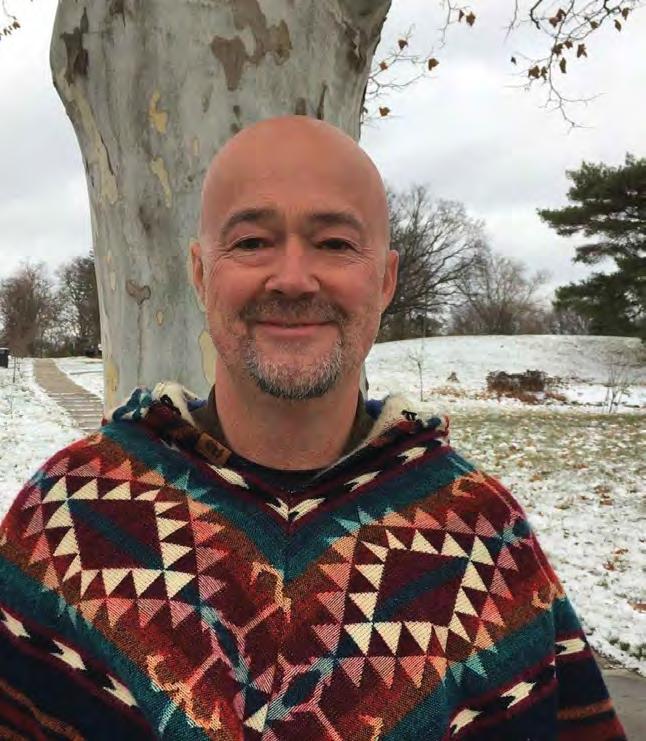
with the intention of washing you with the sounds that bring calming vibrations to reduce stress and ease tension. Yoga mats and one yoga blanket are provided for each attendee. Please bring any additional supports you would like for your comfort. We also have 7 zero gravity chairs available to the first 7 participants who request them at the event. Register by completing this form - https://forms. gle/th36TBAtFhDiUve27. $40. For more information call (248) 962-5475 or visit facebook.com/events/657562139277601.
Cacao and Sound with Rob Meyer-Kukan and Alicia Clark-Teper • Tuesday, February 14 • 7 to 9:00 p.m. • Join Rob Meyer-Kukan of 7 Notes Natural Health and Alicia Clark-Teper of Sacred Lotus Experience for a special Valentine’s Day themed, heart opening cacao ceremony supported by sacred sound. Using ceremonial grade cacao, pure intention, over 40 different instruments (singing bowls, gongs, therapeutic harp, shruti box, and more), Alicia and Rob will create an experience that will immerse you in peace and tranquility. Please bring a mat and any additional supports you would like for your comfort. A limited supply of yoga blankets will be provided. Current public health safety protocols will be observed. Please use the practice of personal accountability, as far as health goes prior to the event. Visit https://forms.gle/28A7CjajFTT97ryk6 to register. $50. Rob Meyer-Kukan, (248) 962-5475, or visit facebook.com/ events/1098077247400429.
Heightening Your Vibration: Alchemy (2-day class) with Karen Greenberg • Sundays, March 12 and March 19 • 8:45 a.m. to 12:45 p.m. • Some people have become depressed with the Covid-19 isolation, variants, and aftermath. Learn a myriad of tools and techniques, to change your vibration from a lower to a higher vibration, and to sustain it—including, but not limited to, sacred letters, powerful Archetypes, sacred oils, affirmations, visualization, meditation, prayers that you compose, gratitude, breathing, drumming, movement, music, Holy Geometry, traditions, toning Names of G-D, Archangels, and Angels. $200 total for both days. For more information contact Karen Greenberg at (734) 417-9511, email krngrnbg@gmail.com, or visit clair-ascension.com.
Sound Bath and Gallery Reading with Rob Meyer-Kukan and Rev. Dr. Ryan MehmandoostGauthier • Friday, April 7 • 7 to 8:30 p.m. • Join Sound Therapist, Rob Meyer-Kukan and Psychic/Medium, Rev. Dr. Ryan Mehmandoost-Gauthier for this time of sound bath meditation including a gallery reading. In addition to the soothing sounds of singing bowls, gongs and more, played by Rob, Ryan will share messages from loved ones, Higher Selves, Spirit Guides, Master Teachers, Angels, and more. Yoga mats and one yoga blanket are provided for each attendee. Please bring any additional supports you would like for your comfort. We also have 7 zero gravity chairs available to the first 7 participants who request them at the event. Register by completing this form - https://forms.gle/ UbBX6hBtf15Piivr9. $50. For more information call (248) 962-5475 or visit facebook.com/events/935501740744849.
Teacher Appreciation Day with Rob Meyer-Kukan and Alicia Clark-Teper • Sunday, April 30 • 9 a.m. to 4:00 p.m. • In celebration of Teacher Appreciation Week and National Teacher Day, we invite you to join us for a day to rejuvenate, relax, and restore. Open to all Teachers and others working in education, this offering is brought to you FREE of charge to give back to the community. Please complete the form found here - https://forms.gle/XXYcTN4ah6edZrpy5. FREE. For more information call (248) 962-5475 or visit facebook.com/events/1330459981058821.
The Powers Of… Unified with The Field with Shellie Powers • First Thursday of the month • 8 to 10:00 p.m. • Third Tuesdays • 9 to 11a.m. • Unified with The Field’ explores various ways to connect to the field. For more details visit http://powers365. com/events $99.00/session. For more information email info@thepowersof. com.
Universal Sphere (R) Practitioner Certification with Shellie Powers • February 25 and 26
OR March 28 and 29 • Gain immediate access to the unified field and increase your frequency/vibration so to attract higher vibrational solutions into your reality. See website for more details powers365.com/events. $397.00. For more information email info@thepowersof.com.
Five Animal Frolics with Master Wasentha Young • Mondays, January 9 through 23 • 5:30 to 6:30 p.m. • As observed in nature the Five Animal Frolics cultivates the strength, flexibility, balance, and stamina of five animals. They are the Monkey, Tiger, Bear, Deer, and Crane. Join Master Wasentha Young and explore the playful and beneficial movements, imagery, and stretching of these five animals. In-person only, limited to ten students. $60. For more information or to register, contact Peaceful Dragon School at info@peacefuldragonschool.com, call (734) 7410695, or visit peacefuldragonschool.com.
GYROKINESIS® Method (Online) with Angela Hawkins • Mondays, January 9 through March 27, No class January 16 • 4 to 5:00 p.m. • The GYROKINESIS® Method focuses on increasing range of motion and strength in a fluid, circular way. Our bodies are not linear and should move in all of the ways they can to maintain mobility. This method was inspired by whole body, efficient and graceful movements like yoga, dance, swimming and tai chi. Gyrokinesis® exercise is done using a stool or a chair and a mat for floor work. It is adaptable for all skill and comfort levels and includes rhythmic, flowing movement sequences. $99 or FREE for ages 65+ with WCC Emeritus Scholarship. Visit wccnet.edu and search “Emeritus” to learn more. Visit washtenaw.augusoft.net and search “Gyrokinesis” to register. Contact reachrootmovement@gmail.com with questions.

Mushroom Growing Workshop with Deanne Bednar • Saturday, April 8 • 1 to 5:00 p.m. • Enjoy a fun(gi) day of hands-on learning at Strawbale Studio! We will tour the various mushroom gardens (shiitake, wine cap, lions mane and oyster) then harvest an oak tree and inoculate shiitake logs. Take home a 12” inoculated log at the end of the day to explore the fruiting process. Online handouts included. Growing our own food medicine! $40 if paid one month in advance or $50
thereafter. For more information contact Deanne Bednar (248) 496-4088 email ecoartdb@gmail.com or visit strawbalestudio.org.
Astrology for Healing Webinar Series with Sy Ali • Saturday, January 14, 21, and 28 • 11 a.m. to Noon • There are many ways to approach health and healing using astrology. In this introductory online class, you will learn the basics of astrology and how to use it for self-reflection and healing purposes. $49 or FREE for ages 65+ with WCC Emeritus Scholarship—visit wccnet.edu and search “Emeritus” to learn more. Visit washtenaw.augusoft.net and search “Astrology” to register. Contact Sy at aali5@wccnet.edu with questions.
Creation Through Synchronicity Healing Workshop with Anthony Two Feathers • January 5 and 19, February 2 and 16, March 2, 16, and 30 • 6 to 9:00 p.m. • Workshop will include an explanation of chakras and the four “clairs,” guided meditation, unlocking your “super powers” (spiritual gifts), tuning forks on heart, third eye and crown chakras Reiki to each person’s crown chakra, extraction healing, introspective work through oracle card deck, Native American Flute Ceremony, heart, third-eye, and crown chakra sound bowls. For more information contact Angela Christensen at (419) 824-4079, or email angelasangels4@aol.com.
Healing Through the Akashic Records Practitioner Certification with Shellie Powers • January 28 and 29 OR April 5, 12, 19, 26 • Transform your relationship with wounding life experiences to experience the perfection of your soul. Practitioner certification with Linda Howe’s Center for Akashic Studies 12-hour class, see website for various times offered. $500. For more information email info@thepowersof.com or visit powers365.com/events.
Focused Mind Meditation with John Friedlander • Sundays, January 1, February 12, March 5, April 2 • 9 a.m. to Noon • Development of sustained focused meditation makes it easy to develop a whole new magnitude of psychic skill and healing ability, as well as a whole new level of mental clarity and spiritual openness. $15. For more information contact Violeta Viviano by email at mvaviviano@gmail.com, call (734) 476-1513, or visit psychicpsychology.com.
Psychic Psychology Women’s Group with John Friedlander and Gloria Hemsher Choudury • Tuesdays, January 3, February 7, March 7, April 4 • 7 to 8 p.m. • For Women Only:
Meditations concentrating on women’s issues relative to biological energies as well as that of the aura. $10. For more information contact Violeta Viviano by email at mvaviviano@gmail.com, call (734) 476-1513, or visit psychicpsychology.com.


Winter Intensive 2023 Webinar/Teleconference with John Friedlander • Thursday, February 2 through Sunday, February 5 • Thursday and Friday 7 to 9 p.m. • Saturday and Sunday 10 a.m. to Noon and 2 to 4p.m. • New material introduced with continued develop.m.ent of advanced and core techniques seeking a natural sense of skills in practical everyday life. Prerequisite Level 1 Psychic Develop.m.ent class, CD set, or permission of instructor. $275. For more information contact Violeta Viviano by email at mvaviviano@gmail.com, call (734) 476-1513, or visit psychicpsychology.com.
Spring Intensive 2023 Webinar/Teleconference • April dates TBD • New material introduced with continued develop.m.ent of advance and core techniques seeking a natural sense of skills in a practical everyday life. Prerequisite Level 1 Psychic Develop.m.ent class, CD set of permission or instructor. $275. For more information contact Gilbert Choudury at gchoud@yahoo.com or visit psychicpsychology.org.
Lunch and Learn with Melissa Anderson • Tuesday, January 10 • 12:15 to 1:00 p.m. • Melissa Anderson explores how Eastern Philosophy shaped its medicine and how different perspectives of the same disease, create opportunity for different outcomes. Event is free, Lunch is available for $5.00. For more information contact the Weber Center at (517) 266-4000.


Brand New Beginning Kabbalah: Kabbalah Miracles with Karen Greenberg • January 25, February 15, March 22, April 19 • 9:15 to 11:15 a.m. OR 7 to 9:00 p.m. • This lifechanging journey is an ordered, systematic approach to develop and balance all the important areas of life. Rather than utilizing so much energy RESISTING (exercise, meditation, sleep, eating and/or drinking healthily), we utilize that liberated energy for CREATING, which puts us on a similar vibration as our Creator. We become empowered to join with G-D and become co-creative, proactive manifesters of our dreams, desires, and goals, open to MIRACLES, and fulfilling our destinies. Monthly Course Rate - $150/person; Monthly SemiPrivate (2 people) Rate - $180/person; Monthly Private (1 person) Rate - $150/ hour (based on time utilized) For more information contact Karen Greenberg at (734) 417-9511, email krngrnbg@gmail.com, or visit clair-ascension.com.

Kabbalah for Couples with Karen Greenberg • Sundays, January 22, February 26, March 19, April 23 • 3 to 5 p.m. • Has social distancing amplified distance between you and your partner? K4C is for good relationships that both parties are willing to work on to make their relationship even better, physically, emotionally, mentally, financially, spiritually, and energetically. This two-hour session (not one hour), once a month, for about a year, is not couples therapy; it can help you get your relationship to the place that you always wanted it to be but did not know how. $274 for 2-hour session. For more information contact Karen Greenberg at (734) 417-9511, email krngrnbg@gmail.com, or visit clair-ascension.com.
Transform Your Personal Life—Master Class with Susan McGraw • 2-part program • January 24 and 31 • 7 to 9 p.m. • In this 2-part virtual Master Class on zoom, you will learn techniques to access your own connection to Divine Inspiration. Through this connection, you will gain insights into your true life purpose and mission, clarify your lifestyle goals, and unlock barriers to living the life you have always wanted. By listening for the clues from Spirit, you will be free to experience a more fulfilling, rewarding, and joy-filled life. $39. For more information contact Susan McGraw at (734) 415-4006, Susan@DivineInspirationAtWork.com, or visit DivineInspirationAtWork.com/classes.

On January 1, 2023, The Crazy Wisdom Community Journal will be availble on our website: crazywisdomjournal.com.



Free Massage Class with Irene’s Myomassology Institute • Fridays, January 13 and March 31• 7 to 9 p.m. • You can relax and have some fun at Irene’s free massage class! This is an excellent opportunity for those interested in massage as a hobby or an introduction to massage as a career possibility. During this free two-hour class, you will have the opportunity to learn basic techniques while both giving and receiving massage. We invite you to bring a friend to exchange massage or come alone and we will pair you up with a friendly partner! FREE. For more information call (248) 350-1400, email contact@irenes.edu, or visit irenes.edu.
White Tara Guided Healing Meditation with various Jewel Heart Instructors • Sundays, January 1 to April 30 with no event on February 26 • 9:30 to 10:35 a.m. • Tara is the mother goddess of Tibetan Buddhism, known for her quick and compassionate activity. White Tara is particularly associated with healing and long life. These guided meditations use visualization techniques to overcome physical, mental and emotional suffering. Free / Donations welcome. For more information, and to register, visit the Jewel Heart website at jewelheart.org, call Jewel Heart at (734) 994-3387, or send an email message to programs@jewelheart.org.

The Mindful Meditation Path to Live in Ease with Bilha Birman Rivlin and Ken Morley • Wednesdays, January 4, 11, 18, 25, and February 1 and 8 • 10 to 11:30 a.m. • During our six-session of “Mindful Meditation Path to Live in Ease”, we will explore what ‘living in ease’ truly means to us. We will search into the qualities in us that hold the power to move us toward living our life in ease. We will look at the intention and goal of our mindful practice, become aware of what we do, and how we act to fulfill our goals. $65. For more information contact Bilha at ybrivlin@att.net or call (734) 330-9376. Visit https://washtenaw.augusoft.net and search “Mindful Meditation Path to Live in Ease.”
How to Do a Daily Practice: Refuge and Bodhimind (Applied Meditation Technology Series) with Jewel Heart Instructors • Saturday, January 7 • 10 to 11:30 a.m. • With so many meditation topics available, knowing how to begin a personal daily practice can be confusing. This is the first of three workshops offering clear guidance for a complete Tibetan Buddhist daily practice, combining prayer, visualization and mantras, as well as concentrated and analytical meditations. $15 Jewel Heart member / $20 Non-member. Pay what you can - no is one turned away. To register, visit jewelheart.org, call Jewel Heart at (734) 994-3387 or send an email message to programs@jewelheart.org.
JissoJi Zen Ann Arbor Meditation—Half-day Sitting with Rev. Marta Dabis • Sundays, January 8, February 12, March 12, April 9 • 8:15 a.m. to 1:00 p.m. • Join us for several periods of sitting meditation in the lineage of Shrunyu Suzuki of the San Francisco Zen Center, starting from 8:20 a.m., followed by dharma talk at 11a.m. Donations are appreciated. Everyone is welcome. Come for any portion of the program. Contact Marta at (248) 202-3102, email jissojizen@gmail.com, or visit jissojizen.org, and find us on MeetUp!
Healing and Compassion Meditations with Hartmut Sagolla • Mondays, January 9 through April with no events on January 2, February 20, and 27 • Noon to 1:00 p.m. • Hartmut Sagolla leads a 30–40-minute guided meditation on a Buddhist theme followed by discussion. Meditations are centered around healing oneself and others and developing compassion. They include concentrated meditation, visualization, and contemplative meditations. Free / Donations welcome. For more information, and to register, visit the Jewel Heart website at jewelheart.org, call Jewel Heart at (734) 994-3387, or send an email message to programs@jewelheart.org.
Open Meditation and Discussion of techniques and sharing experiences with Larry Gazda • Wednesdays, January 11, February 8, March 8 • 7:30 to 8:30 p.m. • An Open Meditation for beginners to advanced meditators. Following a group meditation, we are open to discussing techniques and sharing and/or helping with meditation experiences. By donation. For more information call (734) 808-1335.

Introductory Zen Meditation Course with Zen Buddhist Temple Ordained Dharma Teachers • Thursdays, January 12, February 16, and March 23 • 6:30 to 8:30 p.m. • Five-week course. The viewpoint of Zen is that life lived fully in each moment is the end and purpose in itself and not as the means for something else. Held in the Temple’s meditation hall, the course includes simple stretching exercises, work with the breath, meditation postures, concentration, and mindfulness practice. Cost is $160/$120 unwaged. For more information contact the Zen Buddhist Temple, zenbuddhisttemple@gmail.com, or call (734) 761-6520.
Day of Mindfulness Meditation ~ Cultivating Heart – Finding Courage with Esther Kennedy, OP • Saturday, January 14 • 10 a.m. to 2:30 p.m. • Each day we hear and read stories that break our heart. Poet, Stanley Kunitz asks, In the face of crisis there are always moments of grace as insight and wisdom dawn. A community gathered in meditation is grace itself, offered in love to our world. $35 includes lunch. For more information contact the Weber Center at (517) 266-4000.
Myriad of Meditations with Karen Greenberg • Sundays, January 15, 22, 29, February 5, 12, 26, and March 5 • 10 a.m. to 12:30 p.m. • This is a seven-class series. Meditation is an essential component to spiritual evolution. Learn a myriad of
meditation techniques, to discover which resonate for you (possibly dissolving years of resistance to mediation). Learn meditations with fire, water, air, earth, with the Four Worlds, with different breathing, with Holy Geometry, sacred letters, powerful Archetypes, spiritual beings, qualities of G-D, with movement, music, toning, colors, scents, gemstones, and trees, including several guided meditations through the Tree of Life. $25 per class. For more information contact Karen Greenberg at (734) 417-9511, email krngrnbg@gmail.com, or visit clair-ascension.com.
Awakening and Living Awake—Grounding the Earth in Unconditional Love via Zoom with Barbara Brodsky, Aaron, and John Orr • Tuesdays, January 17 and 31, February 14 and 28, March 14 and 28, April 11 and 25 • 6 to 9:00 p.m. • Waking up! We are all already awake, but most people have forgotten this truth. It was necessary that we arrive sleeping; now it is vital we awaken. We chase that elusive awakeness, forgetting who we are. We practice on both levels, the ultimate one (where everything is connected, awake and present), and the relative level where we move through awakening as a gradual process. Suggested donation. For more information call (734) 477-5848, email om@deepspring.org or visit deepspring.org.
Overnight Introductory Meditation Course with Ordained Dharma Teachers • January 20 and 21, OR March 24 and 25 • 7 p.m. Friday Through Noon on Saturday • The viewpoint of Zen is that life lived fully in each moment is the end and purpose in itself, and not the means for something else. Held in the Temple’s meditation hall, the course includes simple stretching exercises, work with the breath, meditation postures, concentration, and mindfulness practice. This format is primarily intended for out-of-towners, but local people who cannot attend the Thursday evening course, or who prefer the overnight retreat, are also welcome. Cost is $160/$120 students or unwaged and includes accommodation and a vegetarian breakfast. For more information contact the Zen Buddhist Temple, zenbuddhisttemple@gmail.com, or call (734) 761-6520.
Peace Generator on Zoom with Interfaith Center for Spiritual Growth • Fridays, January 20, February 17, March 17, and April 21 • 7 to 9:00 p.m. • Join the circle of silence of inner and outer harmony. Stay for a few minutes or for the entire time to create world peace. Free, but donations gratefully accepted. For more information visit interfaithspirit.org.
Winter Labyrinth Walk with Rob Meyer-Kukan • Saturday, January 21• 1 to 2:00 p.m. • Join Veriditas trained Labyrinth Facilitator, Rob Meyer-Kukan at Webster United Church of Christ, in Dexter, Michigan for a winter labyrinth walk. This event is offered as a donation-based event to support the work of Webster UCC. Parking for this event can be found along Farrell Road or on the lawn near to the barn. To assist with planning, please pre-register for the event by completing this form - https://forms.gle/AqXtyQCwvgN19HEy7. For more information contact Rob Meyer-Kukan, 248-962-5475, or visit facebook.com/ events/642610257355982.
Upon stepping into the Living Grateful Behavioral Health Services’ soothingly sun-drenched office, you find yourself met with an array of beautifully assorted plants as if they have been waiting for you. Owner Bill Mure explains, “They create a sense of the peace and calm I feel.” He goes on to say, “I also use them as a metaphor for your healing. I tell my clients ‘In session is where we plant the seed of growth. Out in the world is where the seeds go to be nurtured. When you grow a garden, you have to water it, tend to it, and nurture it. Sometimes we must trim off the pieces that no longer serve us, so we can facilitate more growth.” Bill goes on to detail how his two-part method aids in the therapy with his clients. “The planting of the seeds represents changing thoughts and perspectives. Nurturing is part of our own growth and healing, as well. If we don’t nurture ourselves, we don’t grow nearly as good as we can be. But we must do it with patience—we don’t eat the fruit the day we plant the seed.” Mure often uses the statement, “You can’t just go to therapy, you have to work therapy.”
Bill Mure, a Jackson local and devoted father known for his Grateful Dead T-Shirts and Birkenstocks, also displays various artwork and promotes full-body wellness. He received his Bachelor of Social Work from Ferris State University, and along with being fully licensed, he is also a Certified Advanced Alcohol and Drug Counselor (CAADC). Mure began his career as a social worker in 1995 and worked as a counselor for the Jackson County Youth Center for 12 years. In 2007 he began working in the CMH arena as a Community Social Worker and received his Master’s in 2017 from Spring Arbor University. He worked as a therapist at Henry Ford Allegiance Substance Abuse Clinic in 2018 and transferred to the Emergency Room Mental Health Clinician during the beginning of the pandemic. He began a mental health division at a local family medical practice before he opened his doors in 2021 to Living Grateful Behavioral Health Services.

Kristina Warner: Has opening your own clinic always been your goal?
Bill Mure: No, but as my philosophies developed, it became clear that having the opportunity for a practice that I could devote to my belief system would allow my clients the most benefit.
Kristina Warner: What is your overall focus with your clients?
Bill Mure: I think it’s my belief in healing the soul versus just learning coping skills and challenging perspectives. My angle is figuring out what is hurting and what is healing the soul. If you don’t heal what’s hurting you, you are going to bleed on those that didn’t cut you.
Kristina Warner: How has your background in substance abuse benefited your focus?
Bill Mure: Addiction is a symptom of a deeper hurt that needs healing. It is important for the soul to feel fulfilled. If we are empty, it is because we lost so much of our soul.
Introduction to Mindfulness with Libby Robinson • Saturday, January 28 • 2 to 4:30 p.m.
• The class will begin with definitions of mindfulness and a summary of the research on the benefits of cultivating it. Basic principles and several practices for cultivating mindfulness will be taught and opportunities for discussion and questions will be offered. It will close with information on the MindfulnessBased Stress Reduction class which begins the following week. FREE. For more information email libbyrobinson7@gmail.com or visit libbyrobinsonmindfulness. com.
Virtual Mindfulness-Based Stress Reduction with Libby Robinson • Saturdays, February 4, 11, 18, 25, March 4, 11, 18, 25, and April 1 • 2 to 4:30 p.m. • MBSR is the mindfulness class developed by Jon Kabat-Zinn which has been extensively researched and found helpful in coping with stress, pain, depression, anxiety, and chronic unhappiness, starting the current wave of interest in mindfulness as a strategy for coping with a wide-range of human problems. The class focuses on practicing mindfulness (compassionate present moment awareness) in and between classes. Meeting weekly, participants learn through guided meditations, discussions, daily mindfulness practices, and a half-day retreat. $300
KW: How does the soul become lost, and can it be reformed?

BM: The soul may get lost through our response to trauma and other experiences. When exposed to abuses or painful events, you lose a piece of your soul and it gets replaced with a “brick” which eventually builds a wall over time. The more pieces of your soul that get replaced with these “bricks,” the higher the wall is built, like a jigsaw puzzle. Everyone’s wall is built differently, which is why responses to traumatic events can vary from person to person. Finding and healing those “bricks” allows the lost pieces of the soul to rebuild.
KW: How does the process of finding the “bricks” work?
BM: During session and through conversation, I can identify the clues of where there could be triggers due to any level of emotional pain. I can work from that energy and get a sense of where the client is sitting with a lot of issues. I take a very gentle approach because I don’t want to open some wounds too quickly. Once some of the “bricks” are taken down, the empty space that remains must be filled. These are the places that the seeds of growth, that need to be nurtured, can be planted. I take this opportunity to help clients find their strength through empowerment and teach them to fan their flame, filling that space with positivity and self-love. I believe in the importance of living life intentionally and alignment with the flow of our own existence to bring contentment and peace.
KW: How do you handle situations where the client is dealing with multiple negative life experiences, abuses, or traumas that cause soul loss?
BM: A lot of the “bricks” are connected to one another—similar to the game Jenga. You don’t want to bulldoze the whole wall down at once. Instead, you need to deal with some wounds simultaneously to get to the deeper, more buried “bricks.”
Bill Mure and Living Grateful are located in the Commonwealth Commerce Center at 209 East Washington Avenue, Suite 180-B, in Jackson, MI. Mure can be reached at (517) 7487075 or email him at bill.livinggrateful@gmail. com.
(scholarships available); includes recordings of guided meditations, handouts, and the retreat. For more information email libbyrobinson7@gmail.com or visit libbyrobinsonmindfulness.com
Days of Mindfulness with Emily Adama for Mental Health Professionals and Clergy • Saturday, February 4 • 10 a.m. to 4:00 p.m. • Educators Immersed in nature, we will spiral through guided walking meditation, seated meditation, body scanning, mindful movement and sensory meditation. This retreat is informed by the Mindfulness-Based Stress Reduction (MBSR) program and follows many of its practices and teachings. This is a secular practice open to all, appropriate for beginner and seasoned meditators alike. $35 fee. For more information contact Emily Adama at hello@earthwellretreat.com, or call (989) 442-6779. To register visit earthwellretreat.com.
How to Do a Daily Practice: Seven Limbs (Applied Meditation Technology Series) with Jewel Heart Instructors • Saturday, February 4 • 10 to 11:30 a.m. • With so many meditation topics available, knowing how to begin a personal daily practice can be confusing. This is the second of three workshops offering clear guidance

for a complete Tibetan Buddhist daily practice, combining prayer, visualization and mantras, as well as concentrated and analytical meditations. $15 Jewel Heart member / $20 Non-member. Pay what you can - no is one turned away. To register, visit jewelheart.org, call Jewel Heart at (734) 994-3387 or send an email message to programs@jewelheart.org.
Path to the Awakened Heart: The Yoga Sutras of Pantanjali with Robert Jacobs • Thursdays, February 9 and 23, March 9 and 23, April 6 and 20 • 7 to 8:30 p.m. • The Yoga Sutras of Patanjali is an ancient text that is a guidebook for walking the spiritual path. The course considers the Sutras from the point of view of Tantric Yoga, particularly the North Indian school of Kashmir Shaivism. Along with studying the text, we will practice tantric forms of meditation to help us understand the Sutras, focusing on mantra, the breath, visualizations, the opening of the central channel, and the chakras. Suggested donation. For more information call (734) 477-5848, email om@deepspring.org or visit deepspring.org.
Day of Mindfulness Meditation ~ Acting from Deep Knowing with Esther Kennedy, OP • Saturday, February 11 • 10 a.m. to 2:30 p.m. • Waking up now is as good a time as any. Teachers remind us, nothing happens next, This is It. John Kabat-Zinn comments that meditation may be the only intentional, systematic human activity, which at bottom is about not trying to improve yourself or get anywhere else, but simply to realize where you already are. Waking up..simply for the sake of waking up and letting go of trying! $35 includes lunch. For more information contact the Weber Center at (517) 266-4000.
Meditation Getaway with Rob Meyer-Kukan • Saturday, February 18 or April 15 • 9 a.m. to 5 p.m. • You are invited to join Rob at 7 Notes Natural Health for a chance to get away and meditate. This day long retreat will be your oasis of peace and calm, a chance to connect to nature, to spirit, to your higher self. Walking/hiking meditation opens our day at one of Ann Arbor’s many local parks. We continue with various forms of meditation, yoga nidra, journal writing, breath work, sound and aroma experience, and more. Ample time for sharing and reflection will be provided. $125. For more information contact Rob Meyer-Kukan at (248) 9625475 or visit facebook.com/events/3462262873993362.
One-Day Zen Meditation Retreat with Ordained Dharma Teachers • Saturday, February 25 OR Sunday, March 12 • 9 a.m. to 5:00 p.m. • Sitting and walking meditation, simple manual work, vegetarian meals, and rest – an interval of deepening, of slowing down, silence, and mindfulness. $60.For more information call Zen Buddhist Temple at (734) 761-6520, email annarborzentemple@gmail.com. Register at https://forms.gle/EfprF84sEAk8LvNu9.
ReFresh Your Mind and Body with Master Wasentha Young • Thursdays, March 2 through March 16 • 11:30 to 12:30 p.m. • Take a break and refresh your mind and body with basic stand, moving and sitting mindful meditation. (Hybrid class. In-person limit 10, Zoom unlimited). $60. For more information or to register, contact Peaceful Dragon School at info@peacefuldragonschool.com, call (734) 741-0695, or visit peacefuldragonschool.com.
How to Do a Daily Practice: Mantras and Dedication (Applied Meditation Technology Series) with Jewel Heart Instructors • Saturday, March 4 • 10 to 11:30 a.m. • With so many meditation topics available, knowing how to begin a personal daily practice can be confusing. This is the second of three workshops offering clear guidance for a complete Tibetan Buddhist daily practice, combining prayer, visualization and mantras, as well as concentrated and analytical meditations. $15 Jewel Heart member / $20 Non-member. Pay what you can - no is one turned away. To register, visit jewelheart.org, call Jewel Heart at (734) 994-3387 or send an email message to programs@jewelheart.org.
A Day of Mindfulness Meditation ~ Relieving Suffering with Esther Kennedy, OP • Saturday, March 11 • 10:30 a.m. to 2:30 p.m. • It comes quite naturally to aspire to bring tenderness and care into situations of suffering. Yet, one might ask who are these ‘others’? As you look around your world see if there is anyone you dislike, detest, anyone you fear or just plain resent. Notice any habitual response that rises when you see, hear, think of this person. With patience and tenderness examine your behavior and open to unfolding and transforming awareness. $35.00 lunch included. For more information contact the Weber Center at (517) 266-4000.

Spring Equinox Ritual Celebration with Esther Kennedy, OP • Sunday, March 19 • 3:30 to 4:40 p.m. • At the edge of spring we gather to welcome new growth rising within the dark soil of Earth; and rising within your heart and soul. Bless us with a poem, a prayer, or a treat to share. FREE. For more information contact the Weber Center at (517) 266-4000.

Daylong Meditation Retreat with Carol Blotter • Saturday, March 25 • 9 a.m. to 4 p.m. • A quiet day in a wooded natural setting for sitting and walking meditation. Instruction available. A short talk given for contemplation. Donation only for Michigan Friends Center. For more information call (734) 475-0942 or email cb.meditate@gmail.com.

A Day of Mindfulness Meditation ~ Cultivating Mindfulness with Esther Kennedy, OP • Saturday, April 15 • 10 a.m. to 2:30 p.m. • Why do we practice? What value does meditation have? The effort to pursue meditation is a commitment not written in stone but perhaps found in the heart. There is an eagerness in many of us to become aware of what we sense is closed, fearful or shut down in us; what is out of balance manifested in our reactivity; and what is the deeper truth of our experience hidden within. We may simply desire to more fully realize who we are and to live in the growing freedom of that awareness. $35 includes lunch. For more information contact the Weber Center at (517) 266-4000.

Weekly Silent Meditation via Zoom with Celeste Zygmont • Sundays and Tuesdays • Sundays 11 a.m. to Noon • Tuesday 9 to 9:30 a.m. • We will have a brief period of chanting, then mute ourselves, and begin silent vipassana meditation. After the time is finished a bell will ring and meditators can go on with their day. There will be time to stay and chat or discuss questions. Suggested donation. For more information call (734) 477-5848, email om@deepspring.org or visit deepspring. org.
Consciously Embracing Elderhood • Saturday, February 25 • 10 a.m. to 6:00 p.m. •A oneday workshop for men 65 and older. Led by Michael Andes, MSW, 80, and Jim Wilton, MSW, 84. $95. Could be a precursor to an on-going group. To register or for more information email mduncanandes@gmail.com.
Dances of Universal Peace on Zoom with Judy Lee Nur-un-nisa Trautman • Fridays, January 6, February 3, March 3, April 7 • 7 to 8:30 p.m. • Meditation and dance leadership for at home dancing or meditation. Inspiration is from diverse faith traditions. FREE, donations accepted. For more information call Judy Lee Nur-un-nisa Trautman at (419) 283-5937, email jltrautman@sbcglobal.net, or visit https://sites.google. com/view/a2-toledodup/home.
Beth Barbeau, CPM, LM, retired in May from delivering babies after many decades. She went to her first birth at age 16, over 43 years ago! She will be continuing with consulting and teaching, just not up in the night now.
Beth is a mom, midwife, teacher, and owner of Indigo Forest. A long-time member of the Ann Arbor community, Beth brings her naturopathic expertise and common sense approach to her mission of “Healthy Births, Healthy Lives” to families locally and on-line. Learn more online at indigoforest.com.
Aristotle’s Categories: Contraction and Expansion with Claudia Fontana • Wednesdays, January 11, 18, 25, and February 1 • 5:30 to 6:45 p.m. • In the realm of language Aristotle brought focus, structure, and logic into a sentence - a process of contraction which is an intellectual capacity. Let us explore a path out of intellectual confinement to an experience of expansion supported by the practice of Eurythmy. Eurythmy is an art of movement which brings life to the very sounds of language through gesture - also called visible speech. $100 fee. For more information contact Claudia Fontana at fontaneum@gmail.com.
Singing for Comfort on Zoom with Interfaith Center for Spiritual Growth •Thursdays, January 12, February 9, March 9, and April 13 • 7 to 8:30 p.m. • Singing for comfort. Free, but donations gratefully accepted. For more information visit interfaithspirit.org.
Sacred Sound Journey with Victoria Schon • January 13 and 26, February 12 or 26, March 17 and 26, April 7 and 23 • 4 to 6:30 p.m. OR 6 to 7:30 p.m. • Victoria offers a deeply restorative Sacred Sound Journey of crystal singing bowls, Tibetan singing bowls, gongs, drumming and other sacred sound instruments as she begins with guided meditation and relaxation techniques to expand your ability to find equilibrium and harmony, thus opening a portal of creativity and connection during her sacred sound journey. $40. For more information visit victoriaschon.com.
Sound Bath: Crystal Bowls Concert with John Steinbauer and Julia Taylor • Friday, January 20, February 17, March 17 • 7 to 8:30 p.m. • Crystal Bowls concert with music and Reiki Healing Energies $20. For more info call (734) 808-1335 or email lhci. financials@gmail.com.
Parenting Arts Support Group with Cynthia Gabriel, Ph.D. and Toni Auker • Thursdays beginning January 12 • 1 to 2:30 p.m. • This is a group to nurture and support parents who are primary caregivers of infants during the early days! You are not alone! We hope to create community connections, explore the world of parenting philosophies (What is Attachment Parenting? What is Helicopter Parenting? What kind of parent am I?), talk about how life events intersect with caring for a small human, get support for infant feeding challenges, and so much more! We will have rotating topics each week with plenty of time for sharing and getting to know each other and our babes. Open to new parents with babies up to crawling age. $15 week drop-in; $90/8 weeks; $120/12 weeks. For more information email EricaMcleod@gmail.com or visit nestandnurture.org.
Work and Play Space with Toni Auker, Erica Businki, Erica Macleod, and Cynthia Gabriel • Tuesdays • 1 to 3:00 p.m. and Fridays 10 to Noon • It can be really difficult to find a safe place to let our little ones play away from home. We actually started our play area so our own children could come to work with us. Thanks to some generous donations from community members and The Little Seedling, we now have a beautiful area that is perfect for toddlers and preschoolers. Our space has a variety of seating options, WiFi, and coffee. We will be there working, and we would love to invite you to do the same. Sliding scale $0-10. For more information email hello@nestandnurture.org or visit nestandnurture.org.
Unschooling, Child-Led-Learning with Tammy Renner • Wednesday, January 18 • 7 to 8:30 p.m. • As a follow up to the Unschooling article in this edition of the CWJ, Tammy will share a bit of her journey as an Unschooling parent, followed by a question-and-answer time for adults wanting to know more about Unschooling. FREE. To join use this Zoom Link: https://us02web.zoom.us/j/87972723627
?pwd=SFZQU3U4QnRicUZkYzUzalE5UTRCZz09 Meeting ID: 879 7272 3627
Passcode: Unschool.
Infant/Pediatric CPR and First Aid with Lorenda Lewis • Sundays, January 22 or March 19 • 10 a.m. to 1:00 p.m. • Nest and Nurture is excited to team up with Lorenda Lewis to offer this class, which include Red Cross Certification for infant/pediatric CPR and First Aid. Erica is teaching a chestfeeding/breastfeeding class from 2-4 following these classes in 2023. We are offering a $10 discount to anyone that registers for both classes. $120. For more information email hello@ nestandnurture.org or visit nestandnurture.org.
Coffee Hour for Prospective Parents with Kriste Brown • Tuesdays, January 31 and February 28 • 8:45 - 10:30 a.m. • Join us at the Rudolf Steiner Lower School (2775 Newport Rd) for warm drinks, sweet treats and good conversation. Meet some members of our community and get a peek inside the most beautiful school in Ann Arbor! For more information contact Kriste Brown at kbrown@ steinerschool.org.
Healthy Boundaries with Karen Greenberg • Sunday, January 29 • 1 to 5:30 p.m. • Learn how to define “Healthy Boundaries” for and with yourself, and how to set and enforce them (without caving in), and how to respect others’ boundaries, in all kinds of personal and professional relationships and situations. Role play is a chief learning tool in the work. $77. For more information contact Karen Greenberg at (734) 417-9511, email krngrnbg@gmail.com, or visit clairascension.com.
Lunch and Learn with Brad McCuller, Sheila Wathen, and Ashley Concord • Tuesday, March 7 • 12:15 to 1:00 p.m. • Wonder what cool things your phone can do? Interested in blogs and podcasts? Get lost in Social Media? Our ADS technology coworkers will share tips and answer questions in all these areas. You won’t want to miss this Lunch and Learn! Event is free (lunch is available for $5.00). For more information contact the Weber Center at (517) 266-4000.
Mamas Smart Money Group with Cynthia Gabriel • Thursdays, January 26, February 16, and March 23 • 6 to 7:30 p.m. • A fun, supportive group of folks who identify as “mothers” who want to make financial goals and stick to them! This is a great place to think about 529 plans, starting a new budget, setting up retirement accounts, living on one salary, asking for a raise! Bring your own wine! Snacks provided. $0-20 sliding scale donation. For more information email hello@ nestandnurture.org or visit nestandnurture.org.
Abundance and Prosperity with Karen Greenberg • Sundays, February 5 and February 12 • 1 to 4:00 p.m. • Identify and work through limiting beliefs, lack mentality, scarcity fears, low-vibrational emotions of shame and guilt, feelings of unworthiness, self-sabotage, procrastination, and imbalances of giving/ receiving that have contributed to your current state of affairs regarding cash flow, money management, and prosperity (your birthright). Define your dreams, set attainable goals, employ visualizations, affirmations, tithing, essential oils, the law of attraction, spiritual beings–30 steps–doing your best so G-D and the universe can do the rest! $99 for both days. For more information contact Karen Greenberg at (734) 417-9511, email krngrnbg@gmail.com, or visit clairascension.com.
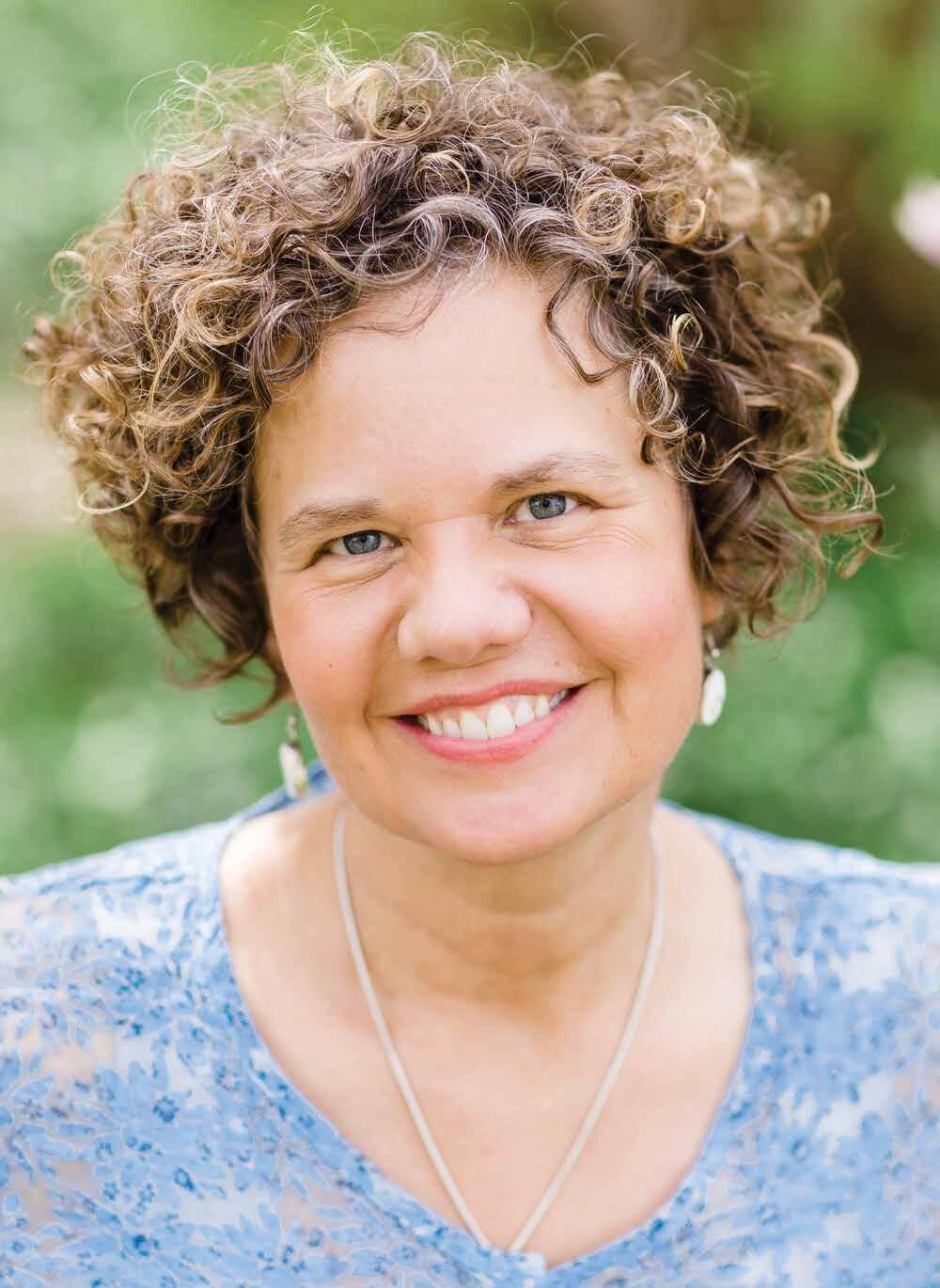
Seth Kopald is a Level 3, Certified Internal Family Systems (IFS) Practitioner with a PhD in Organization Management with a specialization in leadership and a Masters in Education. Seth's doctoral research was focused on creating safe climates in which people can share their voice, and he has been committed to this work with people and their parts ever since. He works with individuals and couples to help them gain a more centered life with better communication and authentic relationships. He specializes in Self-led Parenting, Spirituality, and Parts Art. Seth created and facilitates the IFS Self-led Parenting Facebook page, and hosts free monthly Self-led Parenting Q & A zoom calls with a worldwide attendance. If you are interested in learning more about Seth and his work, visit sethkopald.com.
Reiki Pop-Up events at Ann Arbor Chiropractic and Wellness Center with Dona M. Duke • Sundays, January 8,16,22, 29 • 12 to 4:00 p.m. • 30-minute Reiki sessions at Pop-Up events. We specialize in assisting with anxiety, fatigue, stress, pandemic fatigue, Long Covid to help restore functioning balance and overall wellbeing. $40 for 30-minute session. For more information visit annarborreiki.com. To schedule an appointment email donamduke@gmail.com.
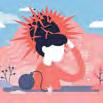
Reiki Self-Treatment for Long Covid with Dona Duke • Saturday, January 14 • Noon to 1:30 p.m. • This class will teach you a sequence of specific hand positions for self-treatment of long Covid symptoms. Self-care is an important component of long-term healing. Using hand positions, we will cover the nervous system, brain, lungs, and organs, with emphasis on the kidneys. Anyone can learn to self-treat with Reiki to help balance and restore on multiple levels. When we balance, we begin to shift into rest and recovery mode and the body can then restore itself. Very simple. Profoundly effective. $29 or FREE for ages 65+ with WCC Emeritus Scholarship - visit wccnet.edu and search “Emeritus” to learn more. Visit washtenaw.augusoft.net and search for “Reiki” to register. Contact donamduke@gmail.com with questions.

First Degree Reiki Training with Suzy Wienckowski • Saturday, April 22 • 10 a.m. to 5 p.m. and Sunday, April 23 • 10 a.m. to 1:00 p.m. • Reiki is a gentle, hands-on healing practice that promotes balance and harmony on all levels: Body, Mind and Spirit. Reiki is easily learned by all and after initiation by a Reiki Master, healing energy flows effortlessly through your hands. The First Degree class includes the history of Reiki, hands-on treatment form for yourself and others, and four individual initiations. Certificate awarded. $150. For more information contact Suzy Wienckowski at (734) 476-7958 or email SuzyReiki@aol.com.

Customized Raw Vegan Detox Retreat in Florida with Ellen Livingston • Various dates available January through June • There are opportunities to attend occasional
Uncover, Empower, and Rejoice in the Experience of being Human: Understanding, Voice, Power, Gender, & Love
Co-leaders: Christi Bemister, PsyD, LP & Marcia Haarer, LMSW Online via Zoom
Series of six weekly two-hour sessions: September 9, 16, 23 & October 7, 14 & 21, 12:30-2:00 PM Eastern


Learn to Sit with Another Person’s Deep Distress: flight, fight, freeze, collapse, and more
Co-leaders: Christi Bemister, PsyD, LP & Marcia Haarer, LMSW Online via Zoom • One day workshop Saturday, November 12, 2022, 11:00 am – 5:00 pm, Eastern
formally planned group retreat offerings, or to come at other flexible times on your own schedule, either for full retreat services or as an independent nightly guest at our in-home raw vegan retreat sanctuary. Yet another option, which we would like to highlight and encourage, is to recruit your own group of up to four people, decide the focus your group desires, and receive significant referral discounts! Starting at $80/night. For more information contact Ellen Livingston at (734) 645-3217, email ellen@ellenlivingston.com, or visit EllenLivingston. com.
Healing and the Ever-Healed Workshop via Zoom with Barbara Brodsky, Aaron, The Mother, Tavis Taylor, and John Orr • January 21 Through January 28 • 10 a.m. to 2:00 p.m. and 3:30 to 6:00 p.m. • For many centuries we have been in a transitional phase of human consciousness. Right now, we’re at a tipping point, preparing to shift into what will come next. Another focus will be Covid as a virus, and its effects on humans and our world. We will spend time with the virus, learning about it in the world and in the self, and will have a journey that Aaron or another being leads to release, independently in the week or as part of the beginning of the larger healing circle with spirit. Suggested donation. For more information email om@ deepspring.org, call (724) 477-5848, or visit deepspring.org.
Insight Meditation Retreat for all levels with Carol Blotter • March 3 through March 5 • 7:00 p.m. • Meditation teaches us to see life as a constantly changing process. As we work with this practice, we begin to realize how our beliefs, opinions, points of view, and our paradigms impact every part of our lives. They color our reactions and cause stress and discomfort. Meditation shows us how to accept all aspects of life with less stress and increasing harmony. A balanced awareness grows, grounded in the present moment, leading to a calm stillness and a growing understanding of the nature of life. The simple and profound meditation techniques of insight, mindfulness, awareness and Loving-Kindness are presented in this retreat with teachings that are nonsectarian and draw on a wide variety of contemplative traditions. Single: $225; Double: $175 Commuter: $100, includes meals and snacks. For more information contact the Weber Center at (517) 266-4000.
The Paschal Mystery of Christ: A Holy Week Retreat with Edward Ruane • April 2 to 6 • 6:30 p.m. • Centering on the events that compose the Paschal Mystery of Christ¸ this journey guides participants to enter more profoundly into the Sacred Triduum. Single: $425 Double: $325 Commuter: $225, includes all meals and snacks. For more information contact the Weber Center at (517) 266-4000.
Mini Wellness Retreats at The Yoga Room with Christy DeBurton • Ongoing • When you haven’t got the time (or budget) for a full weekend retreat but just need a little ‘me-time,’ choose from a variety of 3-hour Mini Retreats at The Yoga Room to relax and renew. Watch for details for scheduled mini retreats in newsletter or grab up to 3 friends and schedule your own mini retreat! Note: proof of Covid vaccination and booster required. Contact for pricing. Christy, info@ christydeburton.com, christydeburton.com.
Basic Journeying: The Art of Shamanism for Practical and Visionary Purposes in Daily Life with Judy Liu Ramsey via Zoom • January 21 and 22 OR April 22 and 23 • 9 a.m. to 3:00 p.m. • The shamanic journey is an easy and powerful tool we can use to access spiritual information. In this class you will begin to develop a relationship with a compassionate spirit or power animal who wants to help you at this time in your life. Learn techniques to help you develop a self-directed practice of empowerment, allowing you to move safely, intentionally through the world in a balanced way. This class is a prerequisite to ongoing and more advanced shamanic studies. $160 per person/$75 for repeat students. For more information email info@judyramsey.net, or visit https://JudyRamsey.net.

Medicine For the Earth/Healing with Spiritual Light via Zoom with Judy Liu Ramsey • March 11-12 and 25-26 • 9 a.m. to 4:00 p.m. • Explore the depth of your own inner light and its connection with All That Is. Learn how to transform the energy behind toxic thoughts and achieve balance in yourself and harmony in your world. You will connect with nature, spirit allies, and the elements to learn how to transform and heal yourself, your community and your environment. Suggested reading: Medicine for the Earth: How to Transform Personal and Environmental Toxins by Sandra Ingerman. Journeying skills not necessary. All levels and traditions are welcome. $375 per person/$125 for repeating students. $160 per person/$75 for repeat students. For more information email info@judyramsey.net or visit https://JudyRamsey.net.
Zoom Shamanic Journeying Circle with Judy Liu Ramsey • Thursdays, January 5 and 19, February 2 and 16, March 2 and 16, and April 6 and 20 • 7 to 8:30 p.m. • Join us for shamanic journeying with a focus on healing yourself, your community and the world. Each session will have an intention to journey on, revealing your own inner wisdom combined with group sharing. Experience the incredible beauty and revelation of journeying within a group setting that supports your path. Knowledge of shamanic journeying required. Registration is required. $25 per session or $40 per month. For more information email info@judyramsey.net or visit https://JudyRamsey.net.
Creating Sacred Protected Space: Shamanic Personal Safety Via Zoom • Saturday, February 4 • 9 a.m. to 4:00 p.m. • Learn techniques for energy hygiene when doing shamanic work and why it is so important to have protection energetically. Knowledge of shamanic journeying necessary. Registration required. $80 per person/$40 for repeating students. For more information email info@judyramsey.net or visit https://JudyRamsey.net.

Shamanic Healing for Animals I via Zoom with Judy Liu Ramsey • Wednesdays, February 8, 15, 22, March 1, 8, 15, 22, 29 and April 5 • 7 to 9:00 p.m. • Working with animals of all species, explore unique perspectives for animal healing that draw upon core shamanic practices. Students will develop a toolkit of techniques within a supportive, interactive, and experiential learning framework of instruction from a professional animal communicator who also practices shamanism. Prerequisite: shamanic journeying. Knowledge of telepathic animal communication not necessary. $360 per person/$125 for repeating students. For more information email info@judyramsey.net or visit https://JudyRamsey.net.
If you are interested in obtaining some biographical information about the teachers, lecturers, and workshop leaders whose classes, talks, and events are listed in this Calendar, please look in the section that follows the Calendar, which is called “Teachers, Lecturers, Workshop Leaders, and The Centers” and which starts on page 101.

• 1 to 4:00 p.m. • A hands-on experience in making your own ceramic rattles from an expert clay artist, Eli Zemper from Curiouser Clay. Shamans’ tools are respected as helping spirits. Create something special to use in your spiritual practice or for a gift. Participants will make 2 rattles with option to purchase additional materials. Tools made will be consecrated in ceremony before firing. $70 per person. Additional rattles $20 each. For more information email info@judyramsey.net or visit https://JudyRamsey.net.

•
Interfaith Sunday Service on Zoom with Interfaith Center for Spiritual Growth • January 1 through April 30 • 10:45 a.m. to 12:15 p.m. • Join us as we explore our spiritual nature and how it connects to all aspects of our human lives. Free, but donations gratefully accepted. For more information visit interfaithspirit.org.
Sufi Chanting Meditation and Discussion on Zoom with Imam Kamau Ayubbi • Tuesdays, January 3 through April 25 • 7 to 8 :00 p.m. • An exploration of Sufism. $5-10 per class. For more information visit interfaithspirit.org.
Care and Feeding of Empaths with Charise Jacobs via Zoom • Thursday, January 5 • 6 to 8:00 p.m. • Join Charise, an Empath herself, for a virtual class all about being an Empath and what that means for your life and relationships. In this class you’ll learn to protect yourself from the energy of unwanted people or places and you’ll learn tools for guarding yourself against being emotionally and spiritually overwhelmed by the energies around you. $40. For more information contact Madeleine Doucet, Event Coordinator, (248) 548-3830, bostontearoomevents@ gmail.com, or visit bostontearoom.com.
Understanding Your Clair Senses with Charise Jacobs via Zoom • Sunday, January 8 • 1 to 3:00 p.m. • The Clair senses are inner, intuitive receptors that correspond with our five physical senses. Everyone has access to these Clair senses and can learn to use them more effectively for greater success in every area of life. In this course Charise will discuss each of the Clair senses and the ways in which they can be used to access intuition. $40. For more information contact Madeleine Doucet, Event Coordinator, (248) 548-3830, bostontearoomevents@gmail.com, or visit bostontearoom.com.
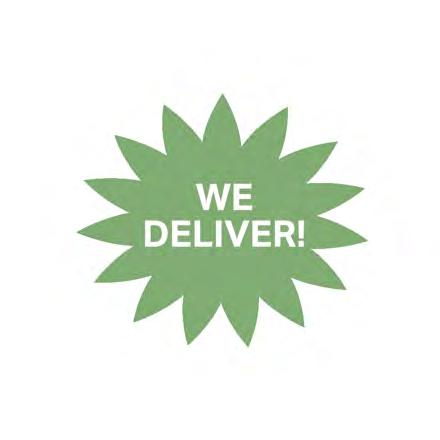
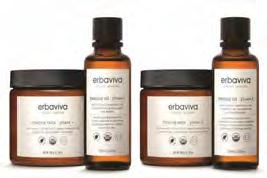

MONTHLY Midrash Study with Karen Greenberg

• January 8, February 19, March 26, and April 9 • 9:30 a.m. to 12:30 p.m. • The written version of the Old Testament (Torah) tells a story. What has been passed down orally for thousands of years is the backstory and various mystical, hidden meanings. It is rich, colorful, detailed, and compiles interesting data like who ascended to Heaven alive, who was so righteous that their deceased bodies never decomposed, the seven things that we are not permitted to know in human form. $180 per month for the monthly study (one 3-hour session per month); $180 per month for the bi-monthly study (two 1½-hour sessions per month); $180 per month for the weekly study (approximately three 1-hour sessions per month). For more information contact Karen Greenberg at (734) 417-9511, email krngrnbg@gmail.com, or visit clairascension.com.
Level One Akashic Record Practitioner Certification with the Linda Howe Center for Akashic Studies and Shellie Powers

• January 9 through 11 OR February 6 through 8 OR March 10 and 11 OR April 15,22,29 • Become a Certified Practitioner of the Akashic Records. See website for details powers365.com/events $360. For more information email info@thepowersof.com.
Zen Meditation, Noon service, and Lunch with Rev. Marta Dabis • Sundays, January 15, 22, 29, February 5, 19, 26, March 5, 19, 26, and April 2, 16, 23, 30 • 11 a.m. • Join us for a period of sitting meditation in the lineage of Shrunyu Suzuki of the San Francisco Zen Center, starting from 11:00a.m., followed by Noon service and informal check-in. Donations are appreciated. Everyone is welcome. You may choose to come for any portion of the program. Contact Marta at (248) 2023102, email jissojizen@gmail.com, or visit jissojizen.org, and find us on MeetUp!
Introduction to Mediumship with Charise Jacobs via Zoom • Thursday, January 19 • 6 to 8:00 p.m. • Are you curious about connecting with loved ones who have passed on but uncertain about how to start? Join Charise, a Medium with over 15 years of professional experience, for a class all about contacting the other side in a safe and practical way. This class will teach you how to open your intuition to spirit communication while keeping yourself energetically protected. $40. For more information contact Madeleine Doucet, Event Coordinator, (248) 548-3830, bostontearoomevents@gmail.com, or visit bostontearoom.com.
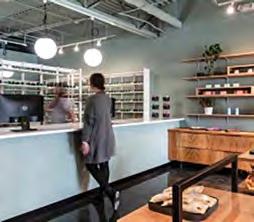
Let This Be the Time: Reflections on the Spirituality of Aging with Janet Schaeffler • Thursday, January 19 • 9 a.m. to 3:30 p.m. • If we don’t listen to the world’s stereotypes, myths and jokes about getting older, our lives are filled with possibilities, growth, depth and joy, particularly in the things that matter. The spirituality of these years enables us to be maturing persons of integrity, living in wholeness and holiness, touching the world with gifts that are so needed. Our time together will explore ways to grow in wisdom and grace, deepening the uniqueness of who we are, enjoying the precious moments we have been given, and continuing to develop our relationship with God and the many loved and loving people in our lives. $45 includes lunch. For more information contact the Weber Center at (517) 266-4000.
Akashic Records Advanced Practitioner Certification with Shellie Powers • January 21 and 22, or March 18 and 19 • Level Two: Become an Advanced Certified Practitioner with Linda Howe’s Center for Akashic Studies. 9-hour class. Please see website for more details. $430. For more information visit powers365.com/events, call (734) 926-5378, or email info@thepowersof.com.
Connecting with Archangels: Parts 1 through 4 with Karen Greenberg • Sundays, January 22 and 29, and February 5 and 12 • 5:30 to 9:30 p.m. • Become acquainted with the various Archangels represented in the Sephirot (Spheres) in the Tree of Life. Learn who the Archangels are, what they each do, how to create a sacred, protected space, on whom to call for particular assistance, and how to safely call upon them. Connect – Ask Questions – Often Receive Helpful Information and Guidance. $777 for all four parts. For more information contact Karen Greenberg at (734) 417-9511, email krngrnbg@gmail.com, or visit clair-ascension.com
Virtual Tao of Thomas Aquinas: Fierce Wisdom for Hard Times with Matthew Fox • January 26 • 7 to 8:30 p.m. • Thomas Aquinas was a fierce proponent of science and religion working in tandem. As he tells us, “a mistake about creation results in a mistake about God.” His teachings on revelation and nature; on finding “original goodness” (his words) and love of God in everyday things; on the priority of conscience; on “the common good”; on compassion--”the fire that Jesus came to set on the earth”--and justice; on non-dualism, all put him out front in today’s quest for an ecological and cosmological and post-patriarchal vision. We will explore many of these rich teachings and more in our discussion of “The Tao of St. Thomas: Fierce Wisdom for Hard Times.” Cost: $20. For more information contact the Weber Center (517) 266-4000.
Coming Through: A Group Mediumship Event with Charise Jacobs and Kelly Santi • Tuesday, February 14 • 6 to 8:00 p.m. • Sometimes referred to as a seance, we prefer to think of the Coming Through events as an opportunity to get in touch your spirit guides, who are most often loved ones who have passed away. During this event, two of our very gifted and experienced Psychic Mediums, will spend time with each participant relaying any messages they may have for you from the other side. We have been hosting this event for nearly 20 years. $75. For more information contact Madeleine Doucet, Event Coordinator, (248) 548-3830, bostontearoomevents@gmail.com, or visit bostontearoom.com.
The Valued Self: An Overview with Bronwen ‘Wildflower’ Gates, Ph.D. • Saturday, February 18 • 9:30 a.m. to 12:30 p.m. • Valuing Self begins with self-acceptance and progresses through self-worth, self-esteem, self-love, self-confidence, selfrespect, and reaches completion as self-realization. It is a progression that will repeat on short and long timelines. This interactive workshop offers a framework for this journey. $99. For more information call (734) 330-8099, email bronwild@gmail.com, or visit BronwenGates.com
The Evolution of Consciousness in God’s Creation: A Virtual Event with Diarmuid O’Murchu • Saturday, February 18 • 9:30 a.m. to 3:30 p.m. • This one-day event will highlight the changing nature of consciousness in our contemporary world, and its impact on faith and spirituality for the 21st century. $45. For more information contact the Weber Center at (517) 266-4000.
Connecting with Various G-D Names/Aspects: Heavenly Travel with Karen Greenberg • Sundays, February 26, March 5,12, and 19 • 5 to 9:30 p.m. • Learn how to create a sacred, protected space to astral travel safely to the planets associated with the Sephirot (Spheres) in the Tree of Life, to become more deeply acquainted with different aspects of G-D. Learn how to connect to the energy of different aspects of G-D, and the special qualities that they represent. You may receive invaluable messages and/or answers to compelling questions. $777. For more information contact Karen Greenberg at (734) 417-9511, email krngrnbg@gmail.com, or visit clair-ascension.com.
Rites of Passage: Hindu, Christian, Muslim, Native American with Susan VanBaalen • Thursdays, March 9, 16, and 23 • 1:30 to 3:30 p.m. • This program will introduce the similarities and differences of the rites of passage and spiritual journeys of Hindus, Christian, Muslims and Native Americans. The program will help participants recognize the universality of a life-long journey of searching for God-ness and goodness as it is expressed across time, geography and religious traditions. Participants will understand and appreciate the sacred rites of acceptance and growth in oneness with God that emerges from experiences of retreat from the world whether in the form of Hajj, Vision Quest, Holy Land Pilgrimage or Wandering Asceticism. We will explore rites related to initiation, penitence, mature acceptance of responsibility for self and the universe, grieving, suffering and death. $45. For more information contact the Weber Center at (517) 266-4000.
ST101: Qigong Meditation Basics 1 Online with Steven Sy • Saturday to Sunday, March 25 and 26, and April 1 and 2 • 9:30 a.m. to 4:30 p.m. • Qigong Meditation Basics 1 is a set of meditations designed to release inner tension, increase self-acceptance, open the heart, detoxify negative emotions, balance one’s inner energy, and rejuvenate the body. These meditations are combined with soft physical body movements (qigong) to promote health and well-being. No Prerequisites. $195. For more information contact (517) 295-3477, steven@spiritualtao.com, or visit spiritualtaoworkshops.com.

Cultivating a Personal Relationship with G-D with Karen Greenberg • Sundays, April 23 and 30 • 6:30 to 9:30 p.m. • Create a Sacred Space in which to compose and ask questions of your Higher Power. Decipher if you are receiving “Yes,” “No,” or “Essay” answers in your head, body, or spirit. Ask G-D how you can serve (working through resistance to trusting and surrendering to G-D); express gratitude, awe, and allow yourself to be comforted and healed by G-D). Compose prayers, feeling close to G-D, as though G-D were a close friend: HE/ SHE IS! $90. For more information contact Karen Greenberg at (734) 417-9511, email krngrnbg@gmail.com, or visit clair-ascension.com.
Claiming Your Indigenous Self: An Apprenticeship Program with Bronwen ‘Wildflower’ Gates, Ph.D. • Date and time by arrangement • In this program you are apprenticing with your indigenous self, that self that is at home in the universe. My role is to help you identify and use skillfully the power of your choice. There are many different points of entry into this program depending on what calls you and your chosen level of participation. For more information contact Bronwen Gates at (734) 330-8099, email bronwild@gmail.com, or visit BronwenGates.com.
Earth Plaster and Sculpting with Deanne Bednar • Saturday and Sunday, January 7 and 8 • 9:30 a.m. to 5:00 p.m. • Learn the joy of natural earthen plasters that can be used in a variety of applications to beautify and naturalize your existing dwellings, future natural strawbale home or Earth Oven project! Tour natural buildings then identify, test, mix, and apply natural local soil to create simple or artistic expressions. Bring a bag lunch. Limited to 12 participants. Supper, overnight accommodations, and breakfast just $20 extra. For more information contact Deanne Bednar (248) 496-4088 email ecoartdb@gmail.com or visit strawbalestudio.org.
Round Pole Construction Basics with Deanne Bednar • Saturday and Sunday, January 14 and 15 • 9:30 a.m. to 5:00 p.m. • Learn principles and hands-on basics of round pole framing for small structures. Tour thatched roofs and round pole structures
on site, harvest wood, use hand tools ~ making a small team project using various notches plus a mallet to take home. Bring a bag lunch. Limited to 12 participants. Lots of fun, practical, and beautiful. $100 if prepaid two weeks in advance, or $120 thereafter. For more information contact Deanne Bednar (248) 496-4088 email ecoartdb@gmail.com or visit strawbalestudio.org.
Thatched Roof Workshop with Deanne Bednar • Saturday, January 21 (+ optional 22) • 9:30 a.m. to 5:00 p.m. • Explore this beautiful, ecological, and long-lasting roof system using local Phragmite reed grass. Tour three thatched roof buildings on-site. Demo and hands-on thatching on a small frame and thatching video. Collect reed with us on Sunday at near-by field (optional). Deanne learned basic techniques from a Danish Master Thatcher and has thatched five small buildings. Includes online handouts. 12 student limit. Bring a bag lunch. Supper, overnight, and breakfast available for $20. $55 if prepaid two weeks in advance or $70 thereafter. For more information contact Deanne Bednar (248) 496-4088 email ecoartdb@gmail.com or visit strawbalestudio.org.
Fire! Rocket Stoves and Earth Oven with Deanne Bednar • Saturday and Sunday, January 28 and 29 • 9:30 a.m. to 5:00 p.m. • Create useful heat efficiently from local materials. Fee Includes a copy of the new edition of The Rocket Mass Heater Book. Tour buildings and stoves on site, Hands-on: mockup of Rocket Stove combustion unit, model of an Earth Oven and mix cob and finish plaster. Info on principles and code. Includes online handouts. Bring a bag lunch. Limit 12 students. Some overnight accommodations available for $20. $125 for both days if prepaid two weeks in advance or $150 thereafter. One day only $80/$90 with RSVP. Supper, overnight and breakfast just $20 extra. For more information contact Deanne Bednar (248) 496-4088 email ecoartdb@gmail.com or visit strawbalestudio.org.
April Worktrade/Sustainable Skills Program with Deanne Bednar • April 1 through April 30 • 9 a.m. to 5:00 p.m. • Enjoy an enriching month of living on-site at Strawbale Studio on lovely wooded rural land with natural buildings while contributing to the grounds and program. Help 20 hours a week (garden, grounds, maintenance/repairs, office) in exchange for room, board, and sustainable skill-building classes: mushroom log inoculation, Rocket Stove cooker build, cording, lashing, spoon carving, tool sharpening, earth oven pizza, and foraging! Strawbalestudio.org for details. For more information contact Deanne Bednar (248) 496-4088 email ecoartdb@gmail.com or visit strawbalestudio.org.
Rocket Stove Outdoor Cooker with Deanne Bednar • Saturday, April 29 • 1 p.m. to 5 p.m. followed by supper • Enjoy a day on the land at Strawbale Studio! Tour the Rocket Mass Heater and Earth Oven on-site, then experience the hands-on building and lighting of a Rocket Stove outdoor cooker. This is a very useful, do-able project! Stay on for a vegetarian stew cooked on our “new stove”! $40 one month in advance or $50 thereafter. For more information contact Deanne Bednar (248) 496-4088 email ecoartdb@gmail.com or visit strawbalestudio.org.
Sculpting With Earth with Deanne Bednar • Saturday, March 11 • 1 p.m. to 5:00 p.m. • This hands-on workshop is perfect for artists, homeowners, or anyone who would like to learn the techniques of using local subsoil to sculpt. Learn how to identify, locally source, test, and mix subsoil that can be used to make artwork, practical projects, earth ovens, and more! Take home your projects and an understanding of this delightful local resource: Earth! $35 one month in advance or $45 thereafter.
Strawbale Studio Learning Tour • Saturdays, February 18, March 11, April 8 and 29 • 10 a.m. to Noon • See the enchanting buildings with thatched and living roofs, earth oven, rocket stove, and rumford fireplace. Structures include the Strawbale Studio, Hobbit Sauna, and Middle Earth house. On lovely rural land just one hour North of Detroit. Questions invited. Each tour has a workshop scheduled for the afterNoon that you might also want to register for and attend! $20
DAYOFRENEWAL23. For more information visit earthwellretreat.com.
And don’t think the garden loses its ecstasy in winter. It’s quiet, but the roots are down there riotous.— Rumi
6,000 copies of The Crazy Wisdom Community Journal are distributed to more than 235 locations in the Ann Arbor area, including Crazy Wisdom Bookstore, Castle Remedies at the Parkway Center, Kerrytown, Schuler Books, the Zen Temple, Sweetwaters, Pharmacy Solutions, Michigan Union, the Better Health Store, North Campus Commons, U-M, EMU, WCC, Arbor Farms, the Center for Sacred Living, Complete Chiropractic, the Lighthouse Center, Jewel Heart, Tsogyelgar, York, Argus Farm Stop, Michigan Theater, Seva, Booksweet, Clark Pharmacy, and the Weber Center.
We also distribute to the offices of dozens of doctors, holistic health care providers and therapists.
If you'd like us to bring copies of The CW Community Journal to your office, studio or center, please call us at 734-665-2757 or email: bill@crazywisdom.net.
Stop Sabotaging Your Self-Care with Cristy Deburton • Self-Paced • This compact but powerful self-paced course is the accountability partner you need to power through obstacles and overcome beliefs that hold you back from creating the life you want and deserve. It will help you gain insight into yourself and see your way out of your self-sabotaging habits; teach you tools to cultivate greater awareness of your self-care needs; and guide you in exploring the healing qualities of nature, movement, nutrition, sleep, gratitude, self-compassion and more. $79 introductory pricing for a limited time. For more information contact Christy at info@christydeburton.com or visit christydeburton.com.
Meet the Mind-Body Connection (Webinar) with Robin Goldberg • Wednesday, March 29 • 6 to 8:00 p.m. • Discover how our thoughts, beliefs and emotions can affect our muscles, bones and organs. As you explore these inner lines of communication, you will also learn relaxation techniques that draw inspiration from healing modalities, like yoga and reflexology. These simple stress-relieving tools can enable you to reconnect with your inner sources of strength, joy and well-being. $25 or FREE for ages 65+ with WCC Emeritus Scholarship - visit wccnet.edu and search “Emeritus” to learn more. Visit washtenaw.augusoft.net and search “40489” to register. Contact robinlily@outlook.com with questions.
Tai Chi for Beginners with Master Wasentha Young • Mondays, January 9 through April 13
• 10 to 11:15 a.m. or Thursdays 6 to 7:15 p.m. • T’ai Chi, often characterized as a moving meditation, is a series of postures linked together in a continuous, fluid manner. As a practice, it integrates the mind and body, promotes relaxation, as well increases balance. Register for one class and you can attend both sessions – whatever your schedule allows – at no extra cost! Hybrid class taught inperson (limit 10) and on Zoom (your choice). $195.
ST101: Qigong Meditation Basics 1 Online with Steven Sy • Saturday to Sunday, March 25 and 26, and April 1 and 2 • 9:30 a.m. to 4:30 p.m. • Qigong Meditation Basics 1 is a set of meditations designed to release inner tension, increase self-acceptance, open the heart, detoxify negative emotions, balance one’s inner energy, and rejuvenate the body. These meditations are combined with soft physical body movements (qigong) to promote health and well-being. No Prerequisites. $195. For more information contact (517) 295-3477, steven@spiritualtao.com, or visit spiritualtaoworkshops.com.
Chen Tai Chi Chuan with Joe Walters • Every Monday, Thursday, and Saturday • Monday and Thursday 4 to 5 p.m., Saturday 3 to 4:00 p.m. • Instruction in Chen Tai Chi Chuan, a unique art emphasizing inner stillness and relaxation developed through disciplined whole-body integration and refined awareness. FREE. annarbortaichi@gmail.com, annarbortaichi.com.
Yang and Chen - Qigong and Tai Chi Karla Groesbeck • Monday through Friday • 1-hour classes • Various times • Yang and Chen - Qigong and Tai Chi - Beginneradvanced. Solo, two-person, weapons. Outside, inside and zoom. Yang Long Form 108, Chen Laojia Yilu, Xinjia Yilu. Various qigong sets and Zhan Zhuang. Staff, Bang, Ruler, Tuishou, Push Hands. Low fee, free for seniors. For more information call (734) 276-3059, info@taichilove.com, or visit TaiChiLove.com
Tarot I: Introductory Course with Charise Jacobs • Saturdays, January 21, 28, February 4, 11 • 4 to 6:00 p.m. • Are you looking for a robust introductory class about Tarot? This is the class for you! Tarot I is an introductory-level Tarot course presented for those coming from either a left- or right-brain perspective. Join Charise as she shares her decades of reading experience. Learn the traditional meanings of each card as well as how to use this fascinating tool to tap into your own psychic gifts. Please note: This class will be hosted on the video platform, Zoom. $150. For more information contact Madeleine Doucet, Event Coordinator at (248) 548-3830, email bostontearoomevents@gmail.com, or visit bostontearoom.com.
Staged Reading of Lee’s Grand Tiki with Neighborhood Theater Group • Friday, March 3 through Sunday, March 5 • 7:30 p.m. • Sunday at 2 p.m. • When Leo needs twenty grand to save the family business, he does the only thing he can, turn to his former criminal associate Eddie “The Fish” Cohen. But Eddie has his own plans for the Grand Tiki, and if Leo, his sister Pheenie, and bartender and aspiring luchador Manny “El Chupa-cobra” Santini can’t get the money back, all while dodging Leo’s P.O., it’s all going to go up in smoke. An original play written by Greg Pizzino and directed by Meg McNamee. FREE. For more information visit https://ntgypsi.org.
Lunch and Learn with Kellyjo Gilmore
• Tuesday, February 7 • 12:15 to 1:00 p.m. • Tecumseh Center for the Arts Director Kelly Jo Gilmore will be presenting information on the theater’s 42nd season including upcoming shows in February 2023-June 2023. In addition, she will be discussing the new Music Park that is being installed on theater property spring 2023. Event is free (lunch is available for $5.00). For more information contact the Weber Center at (517) 266-4000.
Prose, Poetry, and Potpourri with John MacNaughton • Thursday, April 27 • 1:30 to 2:30 p.m. • John MacNaughton will headline the program with the story of his career as Creative Director of the Croswell Opera House, actor, author, graphic artist and more. Enjoy prose, poetry, music and song presented by a variety of talented friends and neighbors. Feel free to bring your own creations. FREE. For more information contact the Weber Center at (517) 266-4000.
ReVillaging for Modern Mothers: a day-long retreat with Miriam Dowd-Eller and Emily Adama • Sunday, January 15 or Sunday, April 16 • 9:30 a.m. to 4:30 p.m. • This retreat is for mothers of all ages and stages looking to fill their cup with self-connection, community-building, and normalizing the challenges of motherhood. Through Yoga, Movement, Story, Stillness and Song, these day-long retreats in nature (with an optional overnight add-on) will explore different themes in this season retreat. $45 For more information contact Miriam.EarthWell@gmail.com.
Plan with Christy DeBurton • Self-Paced • Creating Your Perimenopause Plan combines science and personal experience, so you feel like you’re going on a self-guided journey with a knowledgeable friend. In this e-Guide Christy shares everything she learned during her own perimenopause journey, and then helps you create a plan to support your body—proactively—through nutrition, supplements, exercise, stress relief and more. $59 introductory pricing for a limited time. For more information contact Christy at info@christydeburton.com or visit christydeburton.com.
Winternship at Strawbale Studio Deanne Bednar
• January 5 through February 5 • 9 a.m. to 5:00 p.m. • Unique and comprehensive 1-month on-site program at Strawbale Studio on rural wooded land 1 hour north of Detroit. Experience the basics of thatching, reed collection, earth plastering and sculpting, round pole framing and rocket stove construction. Fireside lectures include site and house design, foundations, code information and more. Also learn sustainable skills such as fermenting and whittling! $950/$850* Intern or $475/$425* Intern/Work trade * one month in advance. For more information contact Deanne Bednar at (248) 496-4088, email ecoartdb@gmail.com, or visit strawbalestudio.org.
“Transition to a Job You Love” Master Class with Susan McGraw • Tuesdays, February 21 and 28 • 7 to 9:00 p.m. • In this 2-part virtual master class on Zoom, you will learn how to access divine inspiration to co-create your new future. By listening to the insights you gain, you will design a personal career profile, detailing the elements of your ideal environment, and develop a short and long-range transition plan. In partnership with Spirit, you will learn to follow the clues, watch for the miraculous synchronicities, and land a new opportunity that matches your desires. $39. For more information contact Susan McGraw (734) 415-4006, email Susan@DivineInspirationAtWork.com, or visit DivineInspirationAtWork.com/classes.

The Divine Feminist dives deeply into an age-old notion of misalignment within people and the universe. Author Ceryn Rowntree examines the imbalance she believes to be prominent between the Goddess and that which holds a feminine energy and the patriarchal forces that seem to reign.

Gleaning off her personal experience, she doles out common ground, eliminating readers’ potential fear of judgment. The introductory chapter provides readers with her backstory and explains how she came to Divine Feminism. Her story will likely resonate with many readers, even if only in part. Familiar woes include overworking, feeling drained, people-pleasing tendencies, and feelings of “notenoughness.” In her 267-page text published in 2021, Rowntree invites readers to follow suit and turn inward, focusing on reconnection with self and finding a place of balance and contentment.
Throughout the text, readers learn what imbalances Rowntree believes exist, their implications, and how these imbalances affect daily life. The theme is consistent throughout, positing that the sacred balance of life can be re-aligned. However, she deems the energies of masculinity and feminity equally necessary. Her intent is not to overthrow the patriarchy, but to lift Goddess and patriarchy on equal pedestals to work in collaboration with, rather than against each other.
Information in each chapter is as much insight as it is a call to action, highlighting the elemental energies aligned with the text and coaxing readers to connect and work with the elements to create a space for transformation. The first element is synergy, in which Rowntree expresses the importance of acknowledging the existence of binaries and dualities designed to separate and restrict human beings. To bridge the gap, she suggests contemplating the notion that “we—all of us—are the cake, so much greater than the sum of our parts.” Bringing up the rear of each chapter are exercises and prompts, in which Rowntree suggests meditation, rituals, and journal prompts that correlate with the chapter. Activities pertaining to synergy include sitting “outdoors under the light of both the Sun and the Moon” and noticing how it feels as these energies soak into the body.
Following synergy, key concepts include courage, discernment, empathy, faith, responsibility, pleasure, allowing, boundaries, connection, wildness, beauty, and grounding. Each element introduced is followed by a discussion on how it relates to the journey toward wholeness. Each element circles back to turning inward, becoming in tune with ourselves, and developing an inner knowledge and awareness of what we need to do. While the process can seem intimidating, Rowntree’s voice is present throughout the book, which appears to breed confidence—confidence in her readers’ ability to obtain self-empowerment, achieve a healthy flow between doing and being, and cultivate wisdom through feeling and logic.
Seemingly a call for human awakening, much like she did herself, Rowntree urges readers to “build a deeper connection with the Earth and with our most primal selves.” Deepening the connection between written text and an understanding and awareness of their meaning, The Divine Feminist is equipped with invocations. Additionally, an additional materials list indicates a web link where readers can hear the invocation in full, along with short stories.
Rowntree utilizes sincere but loving guidance to steer readers down the appropriate path to transformation. By addressing limiting beliefs, such as love vs. fear or soul vs. ego, she invites a healthy discussion that introduces new
points of view. Her theories are based on optimism but are not so embedded in positivity that they are unrealistic. The ideas presented are rooted in the belief that the oversimplified paths of love vs. fear and soul vs. ego are limiting and lead to self-criticism and second-guessing ourselves. As a way to reclaim our power and stay on a realistic path of discovery, the text is based on the belief that love and fear can go hand in hand—that we should work with the inevitable pain and challenges we might face rather than against them. She points out that stepping out of the box in search of the “big, expansive truths our souls want us to follow” could trigger fear, uncomfortable feelings, and even persecution; however, she explains how to carry on and why she believes we should.
“For the longest time, that fear of listening to anything but the positive voice kept me from making some seriously powerful choices… and at times from making any choice at all.” Rowntree’s admission opens the floor for selfreflection as this trial is likely a familiar concept for many readers. She puts the struggle in simple terms—”as a spectrum of expansion and restriction”—while acknowledging its complexity. In doing so, she conveys the relevance of the individual’s journey, where there are no absolute rights or wrongs, “only ever the choice to keep moving, growing, and expanding in the best way we know how.”
Rowntree ’s voice is present throughout the book, which appears to breed confidence confidence in her readers’ ability to obtain self-empowerment, achieve a healthy flow between doing and being, and cultivate wisdom through feeling and logic.




Equal parts playbook, workbook, guide, and testimony, The Divine Feminist is not rooted in any religion despite using words such as sacred, soul, and spirit. Rowntree says that the concept of the sacred whole “isn’t linked to religion, or about any sort of spiritual belief system;” instead, “this is about finding meaning in life.” As such, people from all walks of life, belief systems, and backgrounds can utilize the concepts held in the text. Some readers will relate the information to their beliefs, “allowing us to feel somehow connected to whatever it is that we consider greater than ourselves, be that God, Goddess, Nature, or the Marvel Comics.” Others’ meaning in life is rooted in improving the world, leaving a legacy, supporting a cause, being a shining light for others, making every day count, or something else.
Rowntree invites readers to define their meaning and embrace those things within their lives, asking them to reclaim the fundamental principles of connection, balance, and flow required to live in a place of wholeness. In closing, Rowntree quotes from an episode of Buffy the Vampire Slayer—fitting, given its context.
“I hate this. I hate being here. I hate that you have to be here. I hate that there’s evil and that I was chosen to fight it. I wish a whole lot of the time that I hadn’t been. I know a lot of you wish I hadn’t been either. This isn’t about wishes. This is about choices…
Overall, this book is a forthright account of Rowntree’s personal view about the dualities inflicted on femininity by society and how we can overthrow them to get back to a place of inner peace and wholeness. A step-by-step playbook to reclaim the principles of connection, balance, and flow that are the foundation of life, Rowntree challenges how we’ve been taught to feel, think, and act in this life. While her diction is fierce and many truths a harsh reality, the prose is beautiful and invokes a sense of magic-infused inspiration and hope.
• Featured Reader on January 25 – Thomas Lynch’s most recent of twelve books are The Depositions—New and Selected Essays (W.W. Norton, 2020) and Bone Rosary—New and Selected Poems (David R. Godine, 2021). He is finishing a novel which he fears might finish him. He keeps homes in Michigan and West Clare, Ireland.
• Featured Reader on February 22 – Linda K. Sienkiewicz is the author of an award-winning novel, In the Context of Love, a children’s picture book, and five poetry chapbooks—the latest being Sleepwalker. Her poems have appeared in Prairie Schooner, Rattle, and The McGuffin. She holds an MFA from The University of Southern Maine. LindaKSienkiewicz.com.



“Become a Spiritual Entrepreneur” Master Class with Susan McGraw • Tuesday, March 21 and 28 • 7 to 9:00 p.m. • In this 2-part Master Class, you will identify the elements of “spiritual entrepreneurship” and explore ways to blend spiritual practices with traditional business approaches. You will learn techniques to call on Divine Inspiration to build and expand your business. By partnering with Spirit and taking “inspired action,” you will experience a more fulfilling and rewarding business. $39. For more information contact Susan McGraw (734) 415-4006, email Susan@DivineInspirationAtWork.com, or visit DivineInspirationAtWork. com/classes.
Zoom writing workshop series with Tarianne DeYonker • Thursdays, February 2,9,16 and 23 • 9:30 a.m. to 11:30 a.m. • Cozy Corners is a pick-me-up for this mid-winter time and the rituals around your creative writing. In this workshop series we can explore those corners of your creative imagination that have been waiting to be invited to the page! Why not come and write with us? This series is suitable for beginning and experienced writers. The workshop will be offered on Zoom only so writers will need a computer, camera, and a microphone to join. Cost: $80. Registration is necessary through Weber Center. For more information contact the Weber Center at (517) 266-4000.
Hoping to Thaw: A hybrid writing workshop—in person or by Zoom with Tarianne DeYonker • Saturday, March 11 • 1 to 4:00 p.m. • Whether just beginning to write or starting to write again after a length of time, it’s important to exercise your creative “muscles” for writing. This afterNoon will give writers a chance not only to write but to read their just-written work and receive feedback on its strengths. The workshop is appropriate for beginning and experienced writers. You may join in person at Weber Center or by zoom. A zoom link will be sent closer to the workshop date. Cost: $35 Registration is necessary through Weber Center. For more information contact the Weber Center at (517) 266-4000.
Sit. Stop. Write. Zen and Poetry with Dmitry Berenson • Sundays, January 22, February 26, March 26, April 23 • 1:15 p.m. to 3:00 p.m. • Like a plant that grows out of bare ground, to express ourselves in poetry we must start from an empty place. We’ll do a little meditation and reading from Zen and other sources to help us touch that place and then spring out to write our own poetry. Find your seat; find your voice. Donations are appreciated. For more information email jissojizen@gmail. com, or call (248) 202-3102, or visit jissojizen.org.
Crazy Wisdom Poetry Series with Edward Morin, David Jibson, and Lissa Perrin • Wednesdays, January 11 and 25, February 8 and 22, March 8 and 22, April 12 and 26 • 7 to 9:00 p.m. • Second Wednesdays, Poetry Workshop. All writers welcome to share and discuss their poetry and short fiction. Sign-up for new participants begins 6:45 p.m. Fourth Wednesdays, Featured Reader(s) for 50 minutes. Open Mic reading for one hour. All writers welcome to share their own or other favorite poetry. Signup begins at 6:45 p.m. All sessions are virtual and accessible through Zoom. Email cwpoetrycircle@gmail.com for Zoom link. For more information contact Edward Morin (734) 668-7523, email eacmorso@sbcglobal.net or visit https:// cwcircle.poetry.blog.
• Featured Reader on February 22 – Hiram Larew is an accomplished food scientist whose poems find in twigs, leaves, seeds, and the night sky surprising wisdom and cause for gratitude. His poems have appeared in Rhino, Ars Poetica, Innisfree, and six collections including the forthcoming Patchy Way from CyberWit Press. HiramLarewPoetry.com and PoetryXHunger.com.
• Featured Reader on March 22 – Linda Nemec Foster is author of twelve poetry collections including The Blue Divide and The Lake Michigan Mermaid (a Michigan Notable Book). Bone Country is her forthcoming collection of prose poems and flash fiction. Linda was the first Poet Laureate of Grand Rapids and founder of the Contemporary Writers Series at Aquinas College.
• Featured Reader on April 26 – Dan Bellm (Berkeley, CA) has published five books of poems, including Counting (2023), Deep Well (2017), and Practice (2008). His recent translations include Central American Book of the Dead, by Balam Rodrigo (2023), Speaking in Song, by Pura López Colomé (2017), and The Song of the Dead, by Pierre Reverdy (2016).
Yoga and Wellness Virtual and In-Person Classes with Christy DeBurton • Ongoing •Inperson and virtual yoga and wellness courses: Hatha, Vinyasa, Yin, Yoga for HSPs, Perimenopause, Self-Care and more. Check website for details or contact Christ for more information at info@christydeburton.com or visit christydeburton.com.
Sivananda Yoga with David Black • Beginning Tuesday, February 7 OR Beginning Tuesday, March 21 • 6:30 p.m. to 8:00 p.m. • Six-week courses for beginning and experienced students learn traditional yoga postures (hatha yoga) with an emphasis on relaxation, concentration, and working with the breath. The instructors were trained by the Sivananda Yoga Organization and combine that experience with meditation training. Classes fill up quickly, so early registration is necessary. $60. For more information contact the Zen Buddhist Temple at (734) 761-6520, email annarborzentemple@gmail.com. Register at https:// forms.gle/EfprF84sEAk8LvNu9.
Yoga and Sound with Rob Meyer-Kukan and Paul Barr • Sunday, March 19 • 6:00 to 7:30 p.m. • Join Sound Healer, Rob Meyer-Kukan and Yoga Instructor, Paul Barr for this seasonal series of Yoga + Sound at 7 Notes Natural Health. Paul will lead a mindful yoga practice that focuses on themes tied to each of the seasons. Rob will support with gentle sounds of singing bowls, gongs, and more. An extended time of savasana will allow you to deeply rest into the new season while being immersed in sacred sound. $40. For more information call (248) 962-5475 or visit facebook.com/events/477866034321889/477866047655221.
Gentle Online Yoga in the Iyengar Style with Elizabeth Brauer • Fridays, January 13 through March 31 • No class February 24 or March 10 • 10 to 11:30 a.m. • This class is geared to anyone with decreased mobility, but participants at any level will benefit from joining. Iyengar style yoga uses equip.m.ent to help participants manage the poses safely and effectively. Together we will practice yoga poses and study our breath. For this class, you will need at a minimum a yoga mat, a 10-foot yoga strap, 2 yoga blocks, and 3 thick blankets. A small plastic stool, a few more blankets, a round bolster and a second yoga mat may also be useful. $249 or FREE for ages 65+ with WCC Emeritus Scholarship - visit wccnet.edu and search “Emeritus” to learn more. Visit washtenaw.augusoft.net and search “gentle” to register. Contact ebrauer@wccnet.edu with questions.
Compassionate Yoga with Mary Seibert • Wednesdays • 4:15 to 5:30 p.m. • Kripalu yoga is great for beginners and seasoned students. Classes are gentle and slower paced. Emphasis is on mindfulness, breath, postures, strength and balance. Sliding scale fee. For more information call (734) 323-2520, email compassionateyoga@outlook.com, or visit compassionateyoga.info.


Iyengar Yoga with David Rosenberg • Mondays, Thursdays, Saturdays • January 9 through March 23 • Mondays 6 to 7:30 p.m. • Thursdays 7 to 8:30 p.m. • Saturdays 10 to 11:30 a.m. • Experience invigorating yoga postures using the methods of BKS Iyengar to strengthen the body, create a feeling of well-being, reduce stress, and release tension through physical activity and meditation. The instructor emphasizes the use of props and individualized instruction so students of varying experience, age, flexibility, and strength can participate together. Ten classes for $129. For more information contact David Rosenberg at (734) 646-4195 or visit aarecedonline.com.

Emily Adama has 15 years of experience as a meditation practitioner, 10 years as a mindfulness meditation teacher, and is passionate about sharing the benefits of meditation and mindfulness practice with others.
Sy Ali is a lifelong learning instructor and student affairs coordinator at Washtenaw Community College.
Melissa Anderson is a Licensed Acupuncturist and Herbalist.
The Ann Arbor Karma Thegsum Choling was founded in 1978 by Ven. Khenpo Karthar Rinpoche, former abbot of Karma Triyana Dharmachakra, seat of HH 17th Karmapa in North America.
Toni Auker is a mother of three, birth doula, and a baby wearing expert.
Deanne Bednar trained with Cob Cottage Company and with the MA Social Ecology, and has been coordinator/instructor at Strawbale Studio teaching enchanting designs, thatched and living roofs, round pole, earth plasters, rocket stoves, foraging since 2003. She illustrated The Hand-Sculpted House, Cobbers Companion & Natural Plaster Book
Dave Bell is the senior minister of Interfaith.
Boston Tea Room is a woman-owned business in Ferndale whose mission is to provide tools and services to help people explore their own spiritual path and support them on the journey.
David Black is a certified Sivananda Yoga Instructor.
Carol Blotter’s meditation practice draws from dual roots in the Quaker and Buddhist traditions. She has been teaching insight meditation since 1999 and has led more than 70 retreats across the United States and has taught over 80 classes in meditation to spiritual seekers, schools, universities, and medical groups. She is the guiding teacher of the Chelsea Meditation Group.
Liz Brauer is an experienced yoga instructor and lifelong learning teacher at Washtenaw Community College.
Rachel Briggs is a trained End of Life Doula. She supports the dying and their families as they plan and navigate the end of life. Rachel also provides grief support and resources after sudden or traumatic death.
Barbara Brodsky is the founder and guiding teacher for Deep Spring Center for Meditation and Spiritual Inquiry and a channel for Aaron. Rooted in the Buddhist and Quaker traditions her teaching reflects this balance.
Mary Clipner of Copper Bear Shire is a birth doula and WCC lifelong learning instructor in Ypsilanti, Michigan.
Randall Counts is a long-time student of A Course in Miracles.
The Crazy Wisdom Poetry Circle is an Ann Arbor based writers group working in conjunction with The Crazy Wisdom Community Journal

Reverend Marta Dabis is a boardcertified hospital chaplain and ordained Zen priest in the San Francisco Zen Center Suzuki/ Katagiri lineage.
Christy DeBurton, RYT, is a Holistic Yoga and Wellness Educator with nearly 25 years of experience. She helps people feel better inside and out through Yoga, Meditation, Wellness Retreats, Self-Care Courses, Perimenopause Guidance, HSP Empowerment, and more.
Deep Spring Center focuses on how we can live with more wisdom and compassion. Their primary work includes meditation and spiritual inquiry.
Tarianne DeYonker, OP, MSW, is an AWA affiliate and workshop leader.
Dona M. Duke has been in the health and wellness industry over 15 years. Dona is a Certified Reiki Master Teacher and nationally certified Acupuncture Detoxification Specialist.
The Dying Year provides training, mentoring, and consulting that spans the end-of life continuum to individuals, families, groups, and professionals alike.
EarthWell Retreat Center and Nature Sanctuary aims to provide equitable access to personal and group retreat experiences that promote harmony with nature, self, and others.
Claudia Fontana saw a Eurythmy performance when still a teenager. Unbeknownst to her at the time, that performance was the gate to her destiny path. Soon thereafter she studied Eurythmy in Vienna and subsequently spent fourteen years as a performer with the Dornach, London, and Stuttgart Eurythmeum ensembles. She has taught in the United States, Europe, Thailand, Malaysia, and China, and resides in Ann Arbor where she performs and teaches.
Rev. Matthew Fox, PhD, is an author, theologian, and activist Episcopal priest, and has been calling people of spirit and conscience into the Creation Spirituality lineage for over 50 years. His 39 books,
The background information listed here pertains specifically to individuals and centers whose classes, workshops, and events are listed in this current issue of the Crazy Wisdom Calendar. If you are a holistic/ spiritual/psychological growth practitioner in the area, but don’t regularly lead classes or workshops, you can still be listed for free in our online Holistic Resource Guide. List your practice and add your logo, photo, and even a short video. To claim your listing, please visit AnnArborHolistic.com.

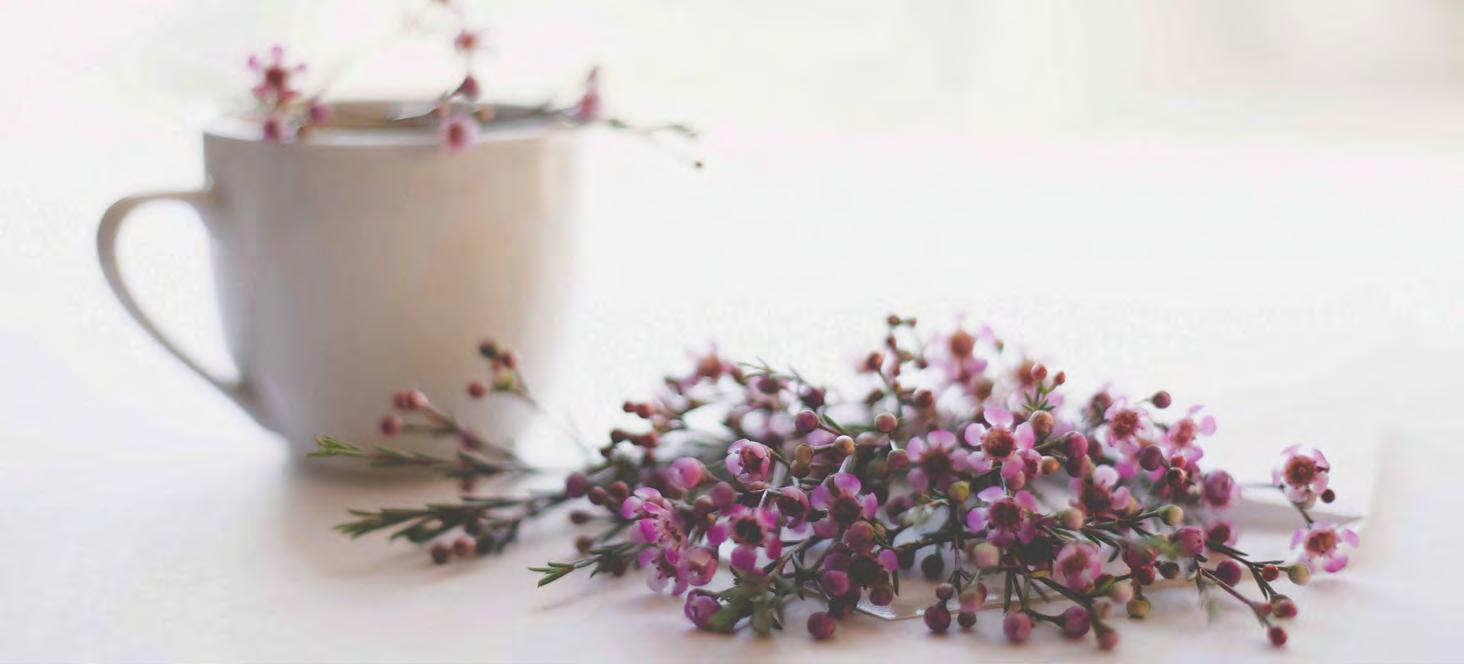
 By Christy DeBurton
By Christy DeBurton
What comes to mind when you think of the term ‘self-care?’ Many people think self-care involves a lot of time or money. Others believe that self-care is selfish. These ideas are completely false. Simply put, self-care is essential for you to be the best version of yourself. It isn’t about getting weekly massages or taking candle-lit bubble baths (though these can be part of it if you choose). It isn’t about neglecting your responsibilities or ignoring the needs of others. The real essence of self-care is being true to who you are, so you are living the life that you want to live, and not the life other people want you to live. It’s about making choices from a place of love and connection rather than guilt and obligation. But that love has to start with loving yourself first— and not all of us are so good at doing that—so we end up sabotaging our self-care. A while back, I went on my own self-care journey, examining the obstacles that were getting in the way of taking better care of myself. Here are some things I learned along the way.
Give yourself permission to take time for self-care. Let’s face it, no one else will. We all want someone else to say to us, “You’ve been working so hard. You’ve been under a lot of stress. Why don’t you take the day off and just relax?”
we’re feeling and what we need. Getting into the habit of asking myself these two questions has made a huge difference in my life, and I am confident it can in yours, too. I encourage you to write these questions on some sticky notes and put them in places where you’ll see them—like on your bathroom mirror, work desk, or car dashboard—throughout the day. Then, every time you see them, take a moment to pause and ask yourself how you’re feeling and what you need to do to take care of yourself. The trick is that you need to pause long enough to really ‘hear’ the answers, and then go do what you need—without apology!
We all want someone else to say to us, “You’ve been working so hard. You’ve been under a lot of stress. Why don’t you take the day off and just relax?” Most likely, this is never going to happen.
I had to work at it for quite a while to get to the point where I felt comfortable making time for self-care every day, so let me be the first to say it won’t be easy. You’ll most likely get resistance from those close to you who have certain expectations. But those who truly love you and want what is best for you will understand. And those who give you a hard time? You might want to examine why you want people like that in your life.
Many people think self-care involves a lot of time or money. Others believe that self-care is selfish. These ideas are completely false.
Most likely, this is never going to happen. Even if you do have someone like this in your life, ultimately you have to be the one who gives yourself permission to take time for self-care. So why do we have such a hard time doing this? Because we’ve been raised in a society that tells us we always need to be more, do more, and have more. Because we’ve been raised in families that pass down conscious and subconscious beliefs that we are not worthy, that we don’t deserve what we really desire, and that we need to take care of other people’s needs before our own. Take a moment to examine this in your own life. Do you feel obligated by certain people to do things that you really don’t want to do? Do you tell yourself you don’t have time for self-care because you just don’t feel like you deserve to take time for yourself? Or are you worried about what other people will think if you do? What kinds of messages are you telling yourself about your worthiness as a human being? Examining those conscious and subconscious beliefs is the first step. Once you’ve done that, try putting into practice either or both of these helpful techniques:
“Who says so?” Any time you catch yourself thinking that you don’t have time to relax or do yoga or some other form of self-care because you have to check off one more thing on your never-ending to-do list, question that ‘voice in your head’ by asking yourself, “Who says so?” I guarantee you will be amazed at what other voices besides your own (maybe it’s the voice of perfection, or guilt, or your mother!) you are listening to. Is listening to those voices in your best interest? What if you listened to your own voice instead? Once you’ve asked yourself this question, or separately on their own, you could ask the following two questions.
“How do I feel right now?” and “What do I need to do to take care of myself?” In my work with clients, I have come to realize that most people are not good at checking in with themselves to see how they’re feeling throughout the day. We can’t take better care of ourselves unless we take the time to contemplate how
Because I benefited so greatly from taking my own self-care journey and learning to implement techniques like the ones above, I created a compact but powerful online course, Stop Sabotaging Your Self-Care, to help others who are ready to make self-care a priority. In this course I guide you on a journey of self-discovery to examine the obstacles that stand in the way of you taking better care of yourself and teach you tools like the ones above to help you cultivate greater awareness around your self-care needs. I’ve included thought-provoking exercises, journal prompts, weekly meditation and yoga practices, and more. You can find out more about this course at yogaroomannarbor.com/online-courses-self-care.
Finally, because I found it helpful to have some supportive people tell me that I did, in fact, deserve to make time for my own self-care, let me pass that support on to you. The world needs your gifts. But you will only be able to shine if you take good care of yourself first. It doesn’t have to be anything elaborate: even taking a 15 minute walk every day can make a world of difference. I promise if you do, you will feel so much better and those around you will also receive the benefits of your new-found sense of well-being, too. You absolutely deserve it, so give yourself some time for self-care today.
I had to work at it for quite a while to get to the point where I felt comfortable making time for self-care every day, so let me be the first to say it won’t be easy.
Christy DeBurton is a Holistic Yoga and Wellness Educator with 25 years of experience. She helps people feel better inside and out through yoga, meditation, wellness retreats, online courses, and more. She can be reached at info@christydeburton.com.


lectures, retreats, and innovative education models have ignited an international movement to awaken people to be mystics and prophets, contemplative activists, who honor and defend the earth and work for justice. Seeking to establish a new pedagogy for learning spirituality that was grounded in an effort to reawaken the West to its own mystical traditions in such figures as Hildegard of Bingen, Meister Eckhart, and the mysticism of Thomas Aquinas, as well as interacting with contemporary scientists who are also mystics, Fox founded the University of Creation Spirituality.
Cynthia Gabriel, Ph.D. is a mother of three, and a birth doula. She researches birth cross-culturally and has written two books, Natural Hospital Birth: The Best of Both Worlds and Fourth Trimester Companion about birth and postpartum.
Larry Gazda is a long-time meditator and Kriya yogi who has extended experience as a psychiatric nurse with 12 Step Programs for addiction and spiritual growth.
Irene’s Myomassology Institute is the oldest and largest massage school in the Midwest. Founded by Irene Gauthier in 1987, our nationally accredited school continues to set high standards for massage education. Our graduates are prepared to begin their new career with a multitude of skills to best help their clients.
Robert Jacobs has practiced meditation and yoga for 45 years. He lived and studied with two spiritual masters from the Indian yoga tradition in ashrams for over 18 years, learning the essential scriptures of the Indian tradition in conjunction with his practices.
Jewel Heart is dedicated to the preservation of Tibetan Buddhism and to bringing the practice of this rich tradition within the context of contemporary life to everyone. Programs for all levels of interest.
Jewel Heart Instructors are senior students who consult a course syllabus, clarify written material, lead meditations, facilitate discussions, pose thought-provoking questions, and encourage everyone to participate.
Karuna Buddhist Center provides the Buddha’s teachings in a way that is accessible in modern America while maintaining the integrity of authentic lineage.
Sister Esther Kennedy, OP a Dominican Sister of Adrian, Michigan, is a retreat leader and spiritual director. She conducts a monthly Day of Mindfulness at Weber Center.
Annie Kopko is one of the ministerial staff at Interfaith
Figen Lacin, PhD, works as an engineer with a clean air focus. She appreciates connecting with people from different traditions and backgrounds in the search for the truth and reality of our existence.
Christy DeBurton is a Holistic Yoga and Wellness Educator with 25 years of experience. She helps people feel better inside and out through yoga, meditation, wellness retreats, online courses, and more. She can be reached at info@ christydeburton.com.
Charise Jacobs has been studying all things Metaphysical since the age of 13. Charise is an expert in tarot, mediumship, tea leaves, and more. Charise teaches classes and mentors in tarot, crystals, and intuitive development.
Bronwen Wildflower Gates, Ph.D, ethnobotanist and shaman, brings forth women’s wisdom ways to help people access multidimensional transformative healing and to remember our ancestry as magical; cocreator with Faerie of the Faerie Flowers Essences and maker of Bronwen’s Healing Balms.
Robin Goldberg guides people toward compassionate self-care to expand the horizons of healing. As a Certified Reflexologist, Registered Yoga Teacher, and Third Degree Reiki Practitioner, she fuses the arts of ancient cultures with contemporary insights into the wisdom of the body, mind, and soul.
Karen Greenberg is a Success-Tracking Train-theTrainer, certified Essence Repatterning and D.O.V.E. Practitioner, dance instructor, physical therapist (formerly teaching at University of Maryland Hospital), as well as being a Personal and Spiritual Growth teacher/author for metaphysical spiritual seekers worldwide.
Karla Groesbeck has a wealth of information in the body movement, meditation, Qigong and martial aspects of Tai Chi, Yang and Chen style with 25 years teaching experience.
Angela Hawkins is a GYROKINESIS® Trainer and Stott Pilates Certified Instructor. She holds a BFA in Dance and owns Reach and Root Movement. She’s worked with diverse populations with a broad range of wellness goals, helping each unique body to move mindfully and joyfully.
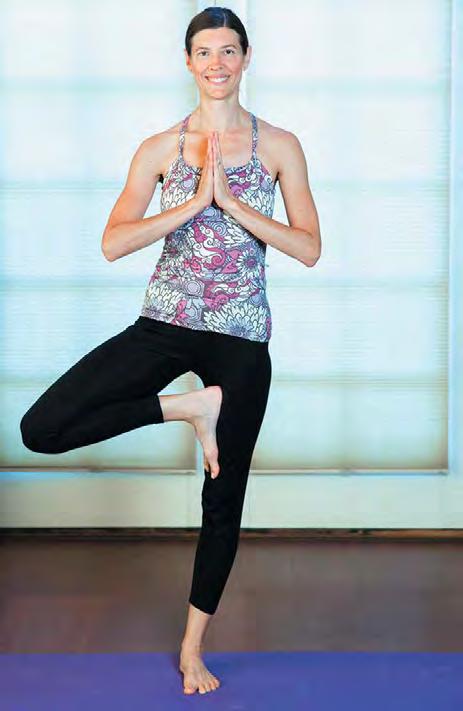
Lighthouse Center, Inc. is an interfaith meditation center and supportive spiritual community offering programs to help seekers expand their consciousness and deepen their spiritual growth.

Ellen Livingston is a wellness mentor and raw vegan retreat facilitator. She is a sought after public speaker and author in the field of holistic natural healing and raw vegan nutrition with over 20 years of personal experience with a raw vegan lifestyle.
Lorenda Lewis is a Red Cross certified teacher.
John MacNaughton will headline the program with the story of his career as Creative Director of the Croswell Opera House, actor, author, graphic artist, and more.
Susan McGraw combines her gifts as a psychic medium with more than 25 years of experience as a Career Coach and Business Consultant to assist clients in aligning divine inspiration with concrete action to transform their personal or professional life.
Erica McLeod is a mother of four young children and an International Board-Certified Lactation Consultant (IBCLC).
Rob Meyer-Kukan began his practice in 2015
as the Healthy Musician Institute, LLC, serving musicians and performing artists with repetitive strain injuries. He is a passionate educator, musician, licensed massage therapist, and sound therapist.
Michigan Friends Center is a not-for-profit organization whose mission is centered on Quaker principles.




The Mother is a discarnate entity channeled through Barbara Brodsky, founder and guiding teacher of Deep Spring Center for Meditation and Spiritual Inquiry. She offers events in spiritual consciousness through the sharing of spiritual energy.
visit www.groveemotionalhealth.com

Lecturers, Workshop Leaders, and the Centers
Glenn Mullin, a long-time friend and student of Gelek Rimpoche studied philosophy, literature, meditation, yoga, and the enlightenment culture under 35 of the greatest living masters of the four schools of Tibetan Buddhism. He is the author of over 20 books on Tibetan Buddhism, founder and director of the Mystical Arts of Tibet, curator of a number of important Tibetan art exhibitions, and leads tours to Nepal and Tibet.
Nest and Nurture is a parenting community center in Ann Arbor.
Diarmuid O’Murchu is a member of the Sacred Heart Missionary Order and a graduate of Trinity College in Dublin, Ireland. He is a retired missionary and social psychologist, with specialization on Adult Faith Development. He has worked on all five continents and currently lives in Dublin, Ireland.
John Orr received Theravada Buddhist ordination and training for a period of eight years while living as a monk in the 1970’s in Thailand and India. He has been teaching meditation and leading retreats around the country since 1980. John is the guiding teacher of the New Hope Sangha, which is a nondenominational community located in Durham, North Carolina that respects the wisdom of various spiritual traditions. He is retired from the faculty of Duke University.
Joe Palms has studied martial arts and meditation for 30 years to reestablish his mind-body connection. He facilitates meditation classes with the intent of helping others train their minds, to benefit themselves and those around them.
Shellie Powers is an Advanced Certified Teacher of the Akashic Records (Linda Howe Center for Akashic Studies), a Certified International Instructor of the Universal Sphere, and a Reiki Master.
When it’s really cold, the snow makes a lovely noise underfoot, and it’s like the air is full of stars.

— Katherine May
Janene Ternes founded Prayer in Motion, LLC, in 2003 in order to provide opportunities for people to grow in their relationship with God. Since then, she has developed and facilitated retreats throughout the Midwest utilizing different forms of prayer. Ternes’ goal is to help others connect more intimately with God, leading to a more loving, peaceful, joyful, and fulfilled life. For more information, visit her website at prayerin-motion.com.
Tammy Renner teaches piano lessons, leads BrainBodyBalance classes, is a homeschooling consultant, and enjoys colorful creativity as textile artist and gardener. Her two adult mostly Unschooled daughters are beginning their careers as a Clinical Social Worker and an Educational Psychology Researcher.
Bilha Birman Rivlin, PhD, is a long-time practitioner of Insight Mindful Meditation (IM) and has been teaching meditation practices and the Buddhist philosophy over a decade. She is part of Still Mountain Buddhist Meditation Center’s Teachers Council. Bilha has been a theatre professional for over 30 years as an actress, director, puppeteer, storyteller, and teacher. She earned her PhD from the Theatre Department at Wayne State University, where she wrote her dissertation on the creative process and the path of transformation.
Libby Robinson is a Certified Teacher of MindfulnessBased Stress Reduction, developed by Jon KabatZinn in the 1970’s and extensively researched. She has presented on mindfulness to many groups, including community members, medical and mental health professionals, associations, and businesses.
generation of incarnate lamas tutored by the great masters in Old Tibet, Rimpoche’s command of western culture allowed him to convey the Tibetan Buddhist tradition with wisdom, kindness, and wit.
Demo Rinpoche is Jewel Heart’s Resident Spiritual Advisor. He studied uninterrupted for almost thirty years at the Drepung Loseling Monastery in India under the supervision of the Dalai Lama and received the highest monastic degree of Geshe Lharampa in 2011. His studies continued at Gyume Tantric College, Sera College of Higher Tibetan Studies, and Union Theological Seminary.
David Rosenberg is a certified Iyengar yoga instructor who has been teaching since 1993. He traveled to Pune, India in 1996 to study from the Iyengars as well as studying from other advanced Iyengar yoga teachers.
Edward Ruane, OP is a Dominican friar who has engaged in a preaching ministry for over 50 years. He has taught preaching as well and served in administration on both the provincial and general levels of Dominican governance.
Neighborhood
Peaceful Dragon School has offered year-round programs in the Tai Chi, Meditation, and Qigong (Energy Work) since 1990.
The Prison Creative Arts Project brings those impacted by the justice system together with the University of Michigan community for artistic collaboration, mutual learning, and growth.
Judy Ramsey’s shamanic practice and animal communication has been helping the Ann Arbor community for over 25 years. A Sandra Ingerman approved instructor, she teaches Sandra Ingerman’s approach to shamanic practice, as well as four levels of Penelope Smith’s animal communication, including interspecies counseling.

Merilynne Rush has trained over 550 end-of-life doulas since 2016. In addition to having been a hospice nurse, she has 40 years of experience caring for families in transition as a home birth midwife and companion care provider.
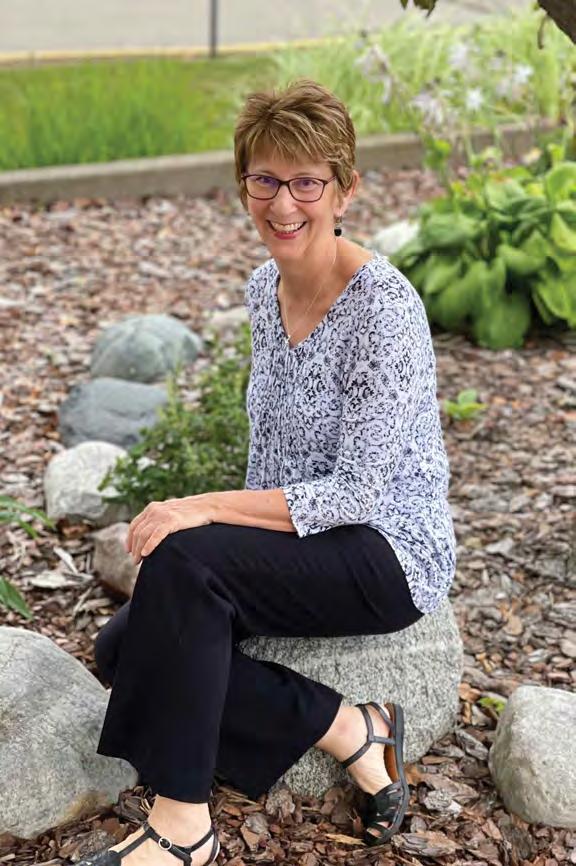
Gelek Rimpoche (1939–2017) was the Founder and Spiritual Director of Jewel Heart. Among the last
Rudolf Steiner School of Ann Arbor is a PreK-12 private school located on two beautiful campuses.
Kelly Santi is a professional psychic medium.
Hartmut Sagolla has been studying Tibetan Buddhism for over 30 years. He lived at the Tibetan Buddhist Society, Melbourne, Australia, before moving to the U.S. Since 2002, he has
served as a Program Director at Jewel Heart. He is a long-time Jewel Heart Instructor and Director of the Bloomfield Hills chapter.
Janet Schaeffler, OP, is the former director of adult faith formation for the archdiocese of Detroit, leads days of reflection/retreats, parish missions, workshops, and facilitates on-line courses. An author of many books and hundreds of articles, she also created and publishes GEMS: a twicemonthly newsletter from an ongoing international best practices study on adult faith formation.
Victoria Schon offers spirit-led Sacred Sound Journeys, Sacred Instrument Training, Cacao Ceremony, Coaching, and Mentoring to guide and support a heart-centered approach to holistic wellbeing.
Mary Seibert, BSN, RYT200 is a certified Kripalu Yoga Teacher with a foundation in Iyengar Yoga. She has taught yoga for more than 20 years. She is also a Holistic Nurse and Healing Touch Practitioner.
John Steinbauer has been performing crystal bowl concerts for over a decade, bringing relaxing and healing sound therapy to many. He is also a Reiki III Master.
Steven Sy began Tai Chi in 1996. In 2007, he started learning Master Mantak Chia’s system of qigong and meditation, which has about 1000 instructors worldwide. He is currently a Senior Instructor Level 2.
Julia Taylor is a Reiki practitioner and a yoga instructor.
Robert A.F. Thurman is a talented popularizer of the Buddha’s teachings, the first Westerner Tibetan Buddhist monk ordained by His Holiness the Dalai Lama, and a longtime close friend of Gelek Rimpoche. He served as the Jey Tsong Khapa Professor of Indo-Tibetan Buddhist Studies in the Department of Religion at Columbia University for 30 years, until his retirement in 2020.
Judy Lee Trautman is a certified leader of Dances of Universal Peace and ordained to lead Universal Worship by the Sufi Ruhaniat International. She is sometimes assisted by mentored leader Elizabeth Rand and Drake (Moses) Meadow.
Anthony Two Feathers is a Reiki Master, Cosmoganist, Healing Crystal Templatist, Quantum Touch Therapy Healer, Inspirational Speaker, and Native American Flutist.
Verapose Yoga and Meditation House hosts in-person group events.


Joe Walters is a 28-year practitioner of Chen Tai Chi Chuan
Washtenaw Community College strives to make a positive difference in people’s lives through accessible and excellent educational programs and services.
Wasentha Young is a Master of T’ai Chi and Qigong and a practitioner since 1968. She has received formal instruction in Buddhist, Taoist, and mindfulness meditation; holds certificates in Acupressure, Five Element Practice, and Wellness Counseling in Mind/Body Consciousness; and has a master’s degree in Transpersonal Studies.
Suzy Wienckowski has over 40 years of experience in the healing arts. Reiki has been the focus of her work since 1993. Her training includes study with two Masters initiated by Hawayo Takata and with Hiroshi Doi, a member of the original Usui Reiki Ryoho Gakkai in Japan. Suzy teaches the traditional Usui System of Reiki Healing and is a member of The Reiki Alliance.
Susan Van Baalen is an Adrian Dominican Sister committed to life-long learning for herself and others. She is grateful for the opportunity to share her gifts of study and teaching with those who are interested in understanding the Oneness within the religions of the world. She holds advanced degrees in Theology and Ministry and has taught in elementary, secondary, undergraduate, and graduate schools in Michigan, Illinois, and Florida.
Celia van den Bogert started studying the harp before entering the 8th grade at Roxboro Middle School in Cleveland Heights, OH. Following her experiences playing piano and flute, this new adventure would open up a world of new sound possibilities.
Eli Zemper is a clay artist who encourages people to play and experiment with this resilient medium. She provides relaxed, supportive instruction and excellent materials management that allows participants to expand into what they are making and focus on their creativity.
Celeste Zygmont has been involved with Deep Spring Center for nearly three decades. She was an early editor of the DSC newsletter. She took part in the teacher training program and in the Venture Fourth and Dharma Path programs, and also served on the DSC Board of Directors. She currently facilitates the Sunday and Tuesday online meditations and teaches the Dharma in service to all beings.
— Pietro Aretino
On the morning of Thursday, March 23, 2023, the very first babies will be born with Pluto in the sign of Aquarius ushering in an astrologically brand-new generation. Pluto will remain in Aquarius until June 11 when it retrogrades back into the previous sign of Capricorn a couple more times before crossing over into Aquarius permanently on November 19, 2024.
The eldest group of people living right now were born with Pluto in Cancer. Since that time, Pluto has passed through seven more signs, defining seven different generations, each with their own unique identity. Aquarius will be the eighth.

Generations are considered to be groups of people that align with certain periods in history respective of when they were born. We have grouped and labeled different generations irrespective to their astrological placement, so there is some overlap between signs in each of our well-known group names such as The GI Generation, Generation X, or The Millennials, as shown in the table below.
Underwood says a generation doesn’t come into their leadership until that group ages into their 60’s and 70’s. The Pluto in Leo group is in this phase now and largely consists of Baby Boomers. Due to their massive population and the dramatic Leo energy, the Boomers as a group have been watched and studied on a grand scale since their youth. Leo has a strong connection to children. We can see this exhibited in their role as primary caregivers to their grandchildren, something seen much more with them than in previous generations. This brings things back around by making up for what many missed as parents. I believe this group is helping us bring a new level of respect toward the elders of society. The Boomers have enjoyed good health overall which will give them greater longevity than past generations. Their career and educational backgrounds, combined with varied interests, have made them engaged and reliable members of our families and communities. I believe there is still much wisdom from this generation yet to be seen.
The last group of children in the United States born with Pluto in Aquarius began in April of 1777. These initial Pluto in Aquarius babies came approximately nine months following the birth of a new country—America.


Aquarians are futurists and this previous generation was birthed by people who were shaping a new nation into something substantial right before their very eyes. These kids grew up as the US Flag was created, the Constitution drafted, and the first US President elected.
A few years ago, I saw generational expert, author, and PBS documentarian Chuck Underwood speak on the topic of generations. He insists that we don’t pre-name generations because members are not actually a part of that generation until they age out of school. He says that each generation is shaped by their “core values.” These would be what the group comes to value based on what they experienced growing up. For example, Generation X was the first to experience dual-career parents on a large scale as well as divorce. This group aligns primarily with Pluto in Libra, the sign of balance and relationships. This reflects Gen X’s desire as adults to have lasting partnerships and be present in their own children’s lives.
When these babies entered their prime leadership years in their 60’s the term “Manifest Destiny” was coined and contested. Supporters thought it meant the destiny of Americans was to expand across North America. Unspoiled land preserved by Indian tribes began to be completely transformed as Americans spread across the U.S. both south toward the Gulf waters and west to the Pacific Ocean. The babies that made it to age one hundred would have seen a full 38 states added to their new country.
A primary significator of Aquarius is technology. One of these Aquarian generation babies born in 1791 was Englishman Charles Babbage who first came up with the concept of the digital programmable computer. An actual computer was some time in coming, but this generation did see modern inventions such as the first telegraph, the first “mechanical” reaper: a horsedrawn machine capable of harvesting wheat, and the completion of the transcontinental railroad.
The last group of children in the United States born with Pluto in Aquarius began in April of 1777. These initial Pluto in Aquarius babies came approximately nine months following the birth of a new country—America.

This previous Aquarius generation in the United States was birthed from rebels who initiated the creation of a brand-new country, in this case, where it did not exist before. How might this parallel what is happening today?

The new Aquarian children are arriving post-pandemic. (I sincerely hope we resist the urge to call them the pandemic generation or the Covid babies). Speaking of labels—this generation will shun them as well as any other attempted definition. What happens in our country and world over the next 10 to 18 years will set the tone for this group.
As a generational energy, the Aquarians will bring us into the future with the potential for a quantum leap. (“Quantum Generation” anyone?) Without a doubt this group will be the one to rebel against the status quo, think outside the box, and come up with far-out ideas—anything from unique ways to dress, style their hair, or live. Generation Aquarius kids will likely want nothing more than to detach from restrictions and anything that prevents their freedom. They will step out of the group and their humanitarian efforts will be toward the collective.
This rebellious nature might be seen as a threat to the established structures that we, of previous generations, have built our worlds around. Timing is everything and I believe this next wave of kids are coming at the exact right moment to help move us along in our evolution. They will arrive without attachment to outgrown systems, an indication that the systems are no longer needed. Einstein was an Aquarius, and we can expect advancements and inventions in science, medicine, and technology to occur with this group beginning when they are children and continuing well into adulthood The sign of Aquarius rules astrology and these kids will have an innate sense of the cosmos and their place in it. These are the children that will grow up on earth, but they aren’t going to be restricted to it.
In the book Children of the Fifth World by PMH Atwater, she gives all the generations one word. Gen X are “Survivors,” Millennials are “Fixers”, and she calls this new Aquarian generation “Connectors.” In addition to all the Aquarian qualities already mentioned, she says this generation can expect to see less government controls and more individual responsibility and there will be an “overall awareness of the coming Age of Enlightenment.”
Generation Aquarius is at the opposite end of the spectrum from the Leo generation (Baby Boomers) and this polarity can tell us something about the nature of this group. Where Leo shines. Aquarius rebels. Where Leo is creative,

Generation Aquarius is at the opposite end of the spectrum from the Leo generation (Baby Boomers) and this polarity can tell us something about the nature of this group. Where Leo shines. Aquarius rebels. Where Leo is creative, Aquarius is genius. And where Leo loves attention, Aquarius is all too pleased to say “No.”
Aquarius is genius. And where Leo loves attention, Aquarius is all too pleased to say “No.” Leo wants to be admired. Aquarius doesn’t care whose watching, but they will most definitely be watched because they will be so different.
The path that we have walked up until this point will not be the one followed by this new Aquarian generation. Similar to those born in the late 1770s, they are arriving at a time that is historically quite unique. Like all generations, theirs will be a shared experience of witnessing the next series of shifts, changes, and events in our world as children and growing into adulthood having been shaped by them. This Aquarian Generation will come into their leadership in the year 2083 bringing those values from their childhood forward. I can imagine at that point our world will look 180 degrees different from where we are today. Will we finally live like The Jetsons? Or perhaps our lives will be like nothing we have ever dreamed.
Catherine Carlson is an astrologer who offers consultations for adults and children. She is an Ann Arbor native who enjoys living locally with her family. She can be reached at catherine-carlson.com or catenka@mac.com.
The Crazy Wisdom Journal provides an amazing platform for us to reach our community in a way that digital media and other technologies simply cannot. As a newly-opened Cannabis Microbusiness, we were very fortunate to have the platform like this to connect with health-conscious Ann Arborites who value local, natural products.
—Eric Parkhurst, Winewood Organics
Advertising, for over 20 years, in The Crazy Wisdom Journal has been a resource that keeps my business, Peaceful Dragon School, connected with a community of those looking for self-care and wellness methods that will augment their more traditional health support.
—Wasentha Young, Peaceful Dragon School
I so appreciate the resources that The Crazy Wisdom Journal provides for our community and am always delighted to learn about something new in almost every issue. I have really enjoyed working with you and the editing team to help develop an ad that best represents me. The clients that come to me via my presence in The Crazy Wisdom Journal are always a good fit and a joy to work with. We are so fortunate to have the journal in our community. I would be more than happy to be a referral for anyone that might be considering advertising in the journal.
Rachel Egherman,The Celebrated HeartThe Crazy Wisdom Journal is such a blessing to the area's holistic community! It's the one place you can go to find out about places, events, products, and practitioners of alternative and metaphysical pursuits in the Ann Arbor area. I especially love their in-depth articles, which allow for a real experience of whoever is the focus. Even the ads are a great exploration of the community's offerings. Many people have told us they've seen our ads and articles about us in the CWJ. We are grateful to be a part of such an important publication!
—Amy Garber, Enlightened Soul Center & ShopAdvertise in The Crazy Wisdom Community Journal and reach over 25,000 loyal readers in southeastern Michigan interested in a healthy, holistic, and conscious lifestyle!


Adrian Dominican Sisters (Weber Center) 31
Angel Whispers Spiritual Spa & Boutique 15
Ann Arbor Holistic Directory 107
Ann Arbor Pharmacy 29, 96
Ann Arbor School of Massge 3
Arcana Press 17
Ashes in Art Glass 29
Bgreen, Inc. 4, 95
Beth’s Bodywork / Beth Dulka 89
Bio Energy Medical Center 90
Castle Remedies 18
Ceremonies by Sabra 2
Chérie Ann McMullen 2
Christi Bemister, PsyD, LP 94
Crazy Wisdom Poetry Circle 85
Crysterra Wellness 4
CWJournal.com 26
CW Distribution 98
Deep Spring Center 8
Denise Held 1
Divine Sanctuary 4
DNA Sales 2100 101
Dr. Raymond Kong / Acupuncturist 1
Dynamic Points Acupuncture / Henry Buchtel 1, 95
Elizabeth Sullivan / Ayurvedic Astrology 47


Embracing Stillness 3

Enlightened Soul Center 15
EOS Portal Interior Back Cover
Eve Wilson 4, 8
Evenstar’s Chalice 54
Fran Cowan Adler 3
Ginger Chase Massages 1
Grove Emotional Health Collaborative 103
Guided Hands Energy Healing/ Rev. Cathy DeLauter 2

Humane Society of Huron Valley / Tiny Lions 18
Indigo Forest 13
Interfaith Center for Spiritual Growth 92
Jennifer Carson / Artist & Author 39
Jennifer Lee Stein / Life is Current 2
Joobwear 18
Joyful Spirits Reiki 3
Judy Ramsey / Heart to Heart Animal Communication 80
Kate Roos, MAAT, ATR 2
Kellie Mox 2
Krasnick Regenerative Medicine 8
K. West Skin Body Spirit 8
Leslie Science & Nature Center 79
Life Empowerment Coaching/ Maria Sylvester 33 Living Grateful/Bill Mure 2
Lovely Monkey Tattoo 43
Madaras Design Studio 57
Matthaei Botanical Gardens 71
McLaren Wealth 18
Melisa Schuster, LMSW 1
Michelle Camilleri 3
Michigan Collaborative for Mindfulness in Education 79
Michigan Merinos / Happy Goat Lucky Ewe Farm 4
Monica Turenne / Four Paws Veterinary 9
Neighborhood Theatre Group 4, 95
Nia Spongberg, ACC,CPC 2, 15
NITE - Naturopathic Institute Interior Front Cover
Northern Sky and Beyond/ Alice Davinich 1
Pauline Loewenhardt 1
Peaceful Dragon School 13
Rob Meyer-Kukan, LMT / 7 Notes Natural Health 1
Ronora Lodge & Retret Center 47
Roos Roast 41
Rudolph Steiner Schools 73
Ruth Wilson 59
Sacred Sexuality with Leslie Blackburn 4
Shop Crazy Wisdom 21
Sing! Ann Arbor 89
Sole to Soul Healing 55
Spiritual Healing with Lucia 2
Stefanie Cohen, MA, RSMT / Moving Stories 4
Steiner Health 29
Stephen Rassi / Chrysalis Facilitation and Counseling 3

Susan McGraw / Divine Inspiration at Work 17
Suzy Wienckowski / Reiki 3





The Celebrated Heart / Rachel Egherman 13
This Breath / Jackie Miller 1
Transitions LLC / Linda Bender 3
Triple Crane Monastery 17
Unity Vibrations Kombucha 61
Victoria Schon 33
Winewood Organics 65
